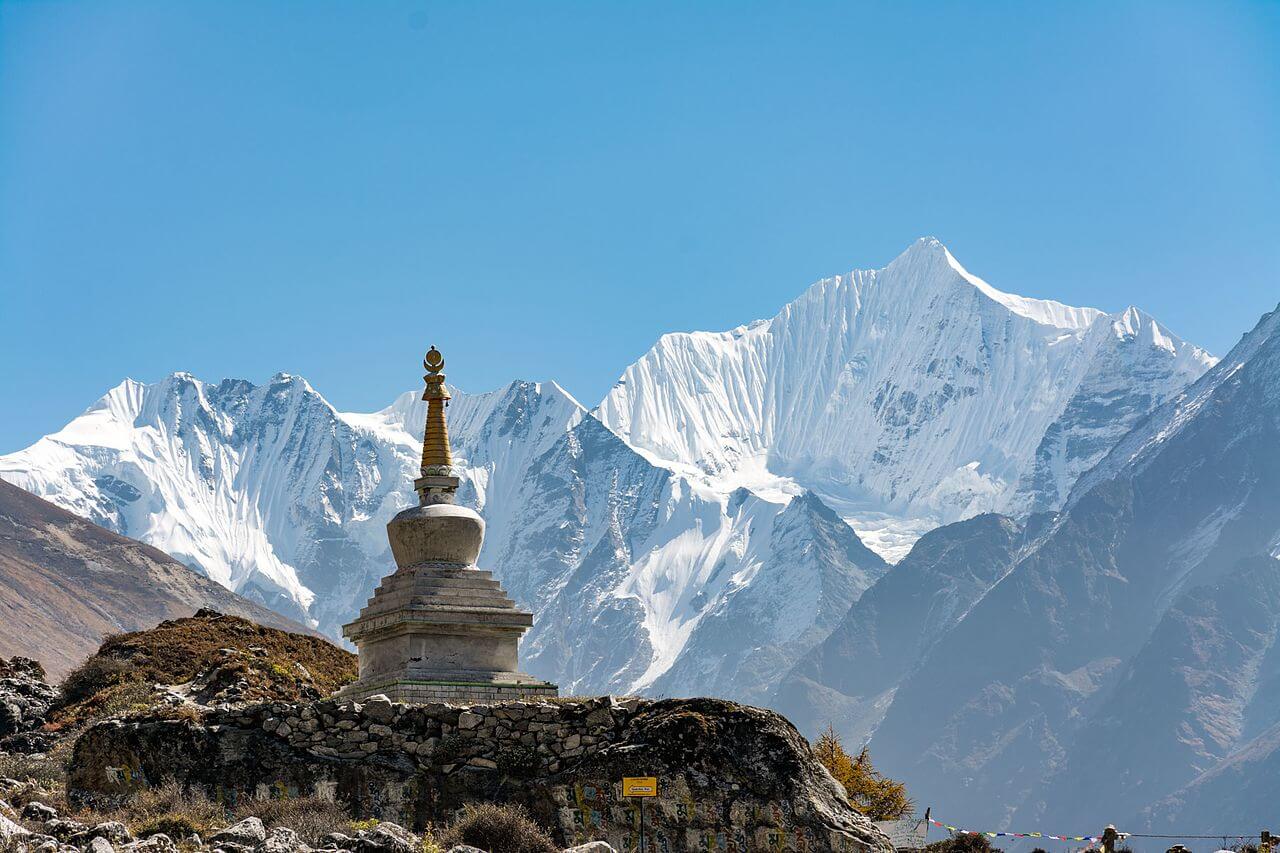

Langtang Valley Trek
Langtang Valley is a classic trekking destination, located only 61.8km away from aerial distance, north of Kathmandu.
Although the Langtang Valley Trek is relatively short, accessible, and cheap, the trails are quieter with less number of trekkers compared to other classic trekking destinations in Nepal .
The trek is ideal for both experienced trekkers as well as novice travel enthusiasts. This trek provides an incredible opportunity to traverse through beautiful Tamang villages, diverse landscapes, eye-catching waterfalls, high Himalayan valleys, monasteries, and densely forested areas.
The mountain trails to Langtang also offers you a spectacular sight of the glaciers and mountains including Langtang Lirung, Ganesh Himal, Jugal Himal, Dorje Lakpa, and Ganja La Pass.
Protected as Langtang National Park , it is home to an abundance of exotic animals and birds. On a lucky day, you may spot plenty of wild animals including red panda, langur, musk deer, snow leopards, Himalayan tahr along with birds like Himalayan monal, white-winged redstart, and the snow Patridge.
Before the catastrophic earthquake in 2015, Langtang used to be one of the most commercial trekking destinations in Nepal. The region was severely affected and damaged by the earthquake. Some of the villages in the region were destroyed and buried under the rubble. However, after massive reconstruction and renovation efforts, the area is now open for the trekkers.
Table of Content
Langtang Valley Trek Facts
Highlights of langtang valley trek.
- Langtang Valley is a relatively short and accessible trekking destination with a fantastic Himalayan experience.
- Relish the beautiful spectacles of Langtang Lirung, Ganesh Himal, Manaslu, and Jugal Himal.
- Breathtaking climb to the vantage point of Tserko Ri at the elevation of 5033m.
- Explore the beautiful Tamang villages and get a more in-depth insight into their cultures and heritages.
- Opportunity to witness rare animals like the red panda, snow leopard, langur, and musk deer.
- Explore the ancient monastery of Kyanjin Gompa.
Getting There and Away
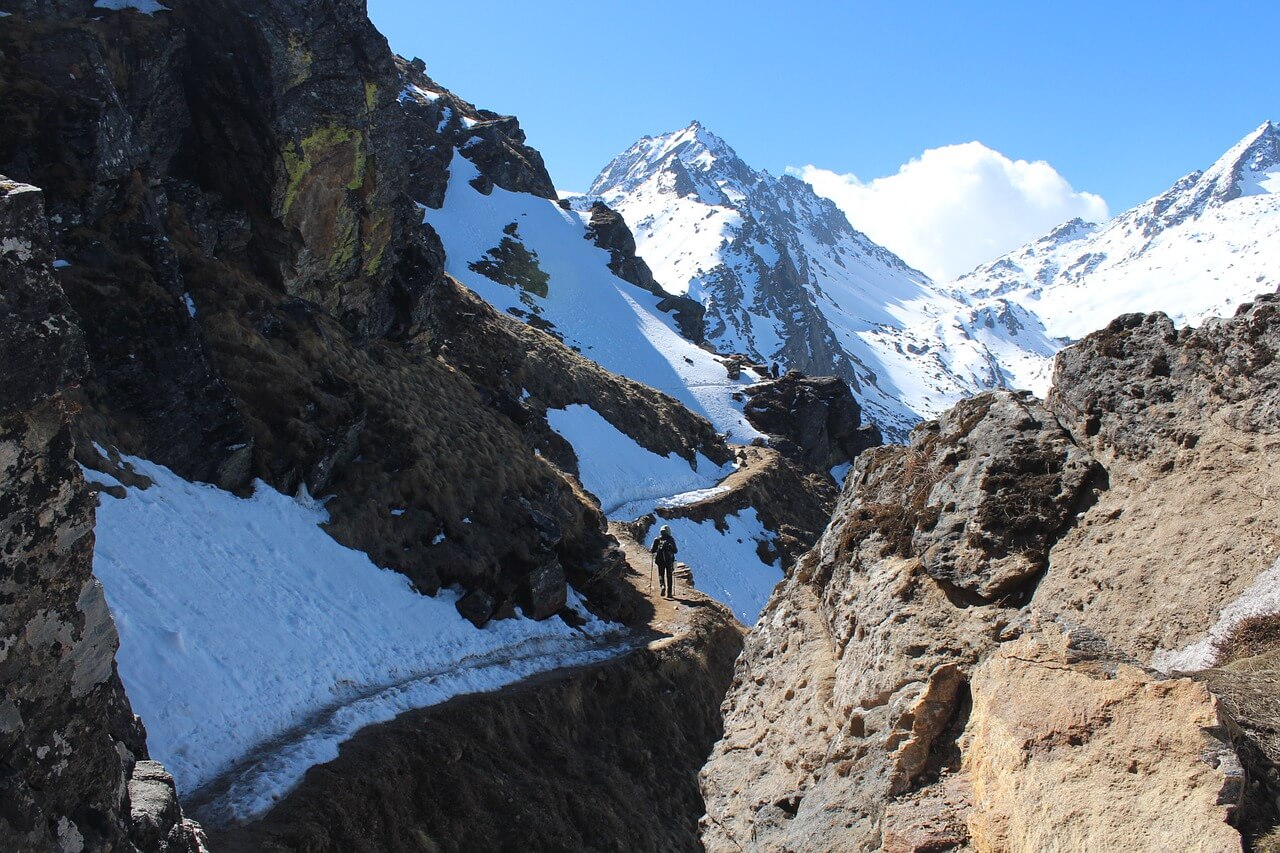
Start of the Trek
Your journey to Langtang Valley Trek begins with a 7-hour drive from Kathmandu to Syabrubesi. The drive from Kathmandu to Syabrubesi covers the total distance of 122km. Although reasonably short in distance, there is still no luxury transportation services available for this region. You can drive to Syabrubesi either by local bus or local/private jeep.
The local bus departs from Machhapokhari every morning from 7 to 9 AM. The bus fare may cost you from $6 to $8 depending upon the different transportation companies. The main discomfort while driving on a local bus is congested seats and too many passengers.
The local jeep will cost about $8 to $10 per person on a sharing basis. You can take these jeeps from Machhapokhari as well. They depart every morning from 6:30 to 9 AM.
If you’re willing to hire a private jeep, it’ll cost you around $150 for a group of 6-7 travelers.
The road condition you travel along reveals its pathetic and rough forms. The highway from Kathmandu to Trishuli Bazaar is good with a narrow winding road. However, once you drive further from Trishuli Bazaar, the road becomes rough and bumpy. Along the way, you come to experience some dreadful landslides.
End of the Trek
Since both starting point and endpoint of Langtang Valley Trek is at Syabrubesi, you’ll be retracing the route backward from Syabrubesi to Kathmandu at the end of the trek.
You’ll have similar transportation options while traveling from Syabrubesi to Kathmandu.
Outline Itinerary of Langtang Valley Trek – 8 Days
Lantang valley trek detailed 8 days itinerary, day 1: drive from kathmandu (1,400m) to syabru besi (1,550m) – 7 to 8 hours.
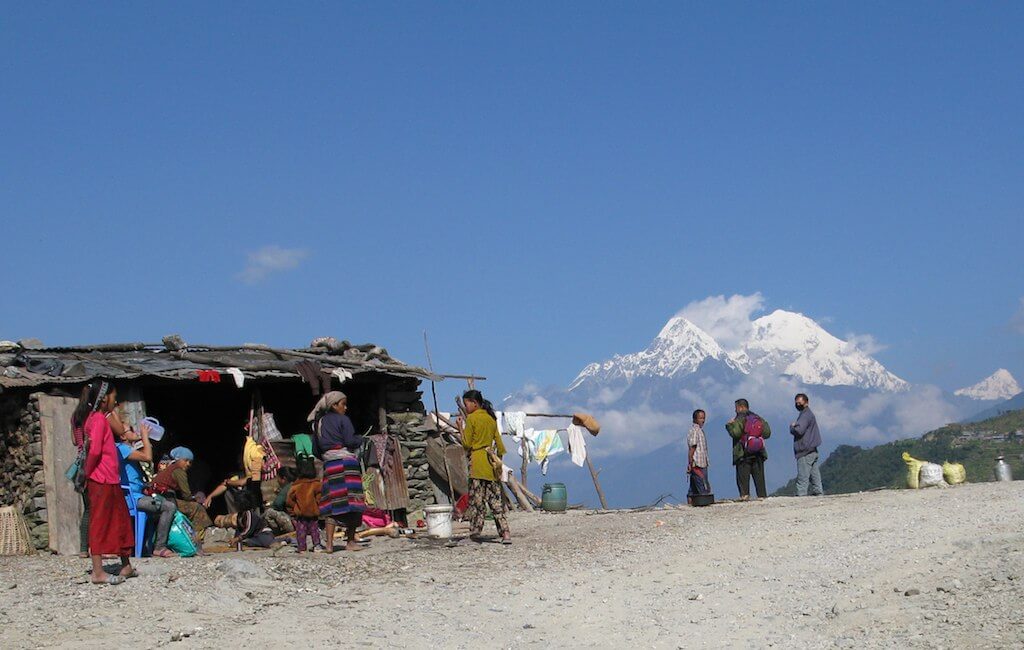
The adventure of Langtang Valley Trek begins with a 7-hour drive from Kathmandu to Syabru Besi. You can either take a local bus from Macchapokhari or hire a jeep to Syabru Besi.
As soon as the bus departs from Kathmandu, the road climbs over the ridge offering majestic views of Ganesh Himal, Manaslu, and Annapurna. The condition of the highway is extremely rocky and rough with tons of potholes and small ditches.
You’ll be driving alongside the Trishuli river for most of the day. Driving past the bustling town of Trisuli, the road leads towards Dhunche, the administrative center of Rasuwa District. Make sure to keep your TIMS card and National Park Permit in an easily accessible place as you’ll need to show them at the Park Gate right before Dhunche. After driving for another hour downhill from the town of Dhunche, you’ll reach Syabru Besi.
Day 2: Trek from Syabru Besi (1,550m) to Lama Hotel (2,380m) – 6 to 7 hours
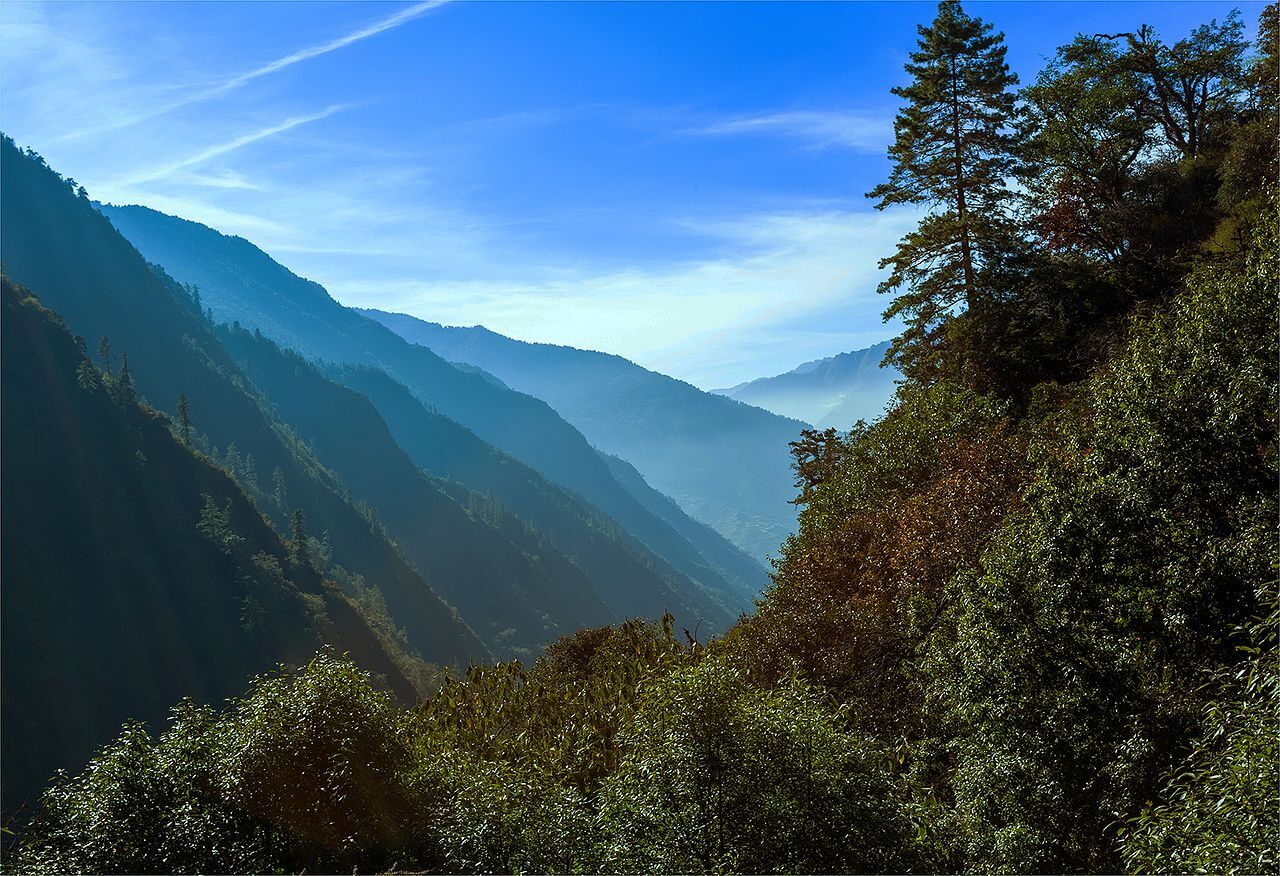
You’ll start the trek from Syabru Besi by crossing the bridge over the Ying Yang River. The trail ascends and descends simultaneously through the dense sub-tropical forest alongside Langtang Khola.
As the trek continues, oak and rhododendron trees dominate the surroundings. While walking in the woods, make sure to watch out for the langur monkeys. The trail goes steep and slightly strenuous through the forest up to Lama Hotel.
Day 3: Trek from Lama Hotel (2,380m) to Mundu (3,430m) via Langtang Village – 6 to 7 hours
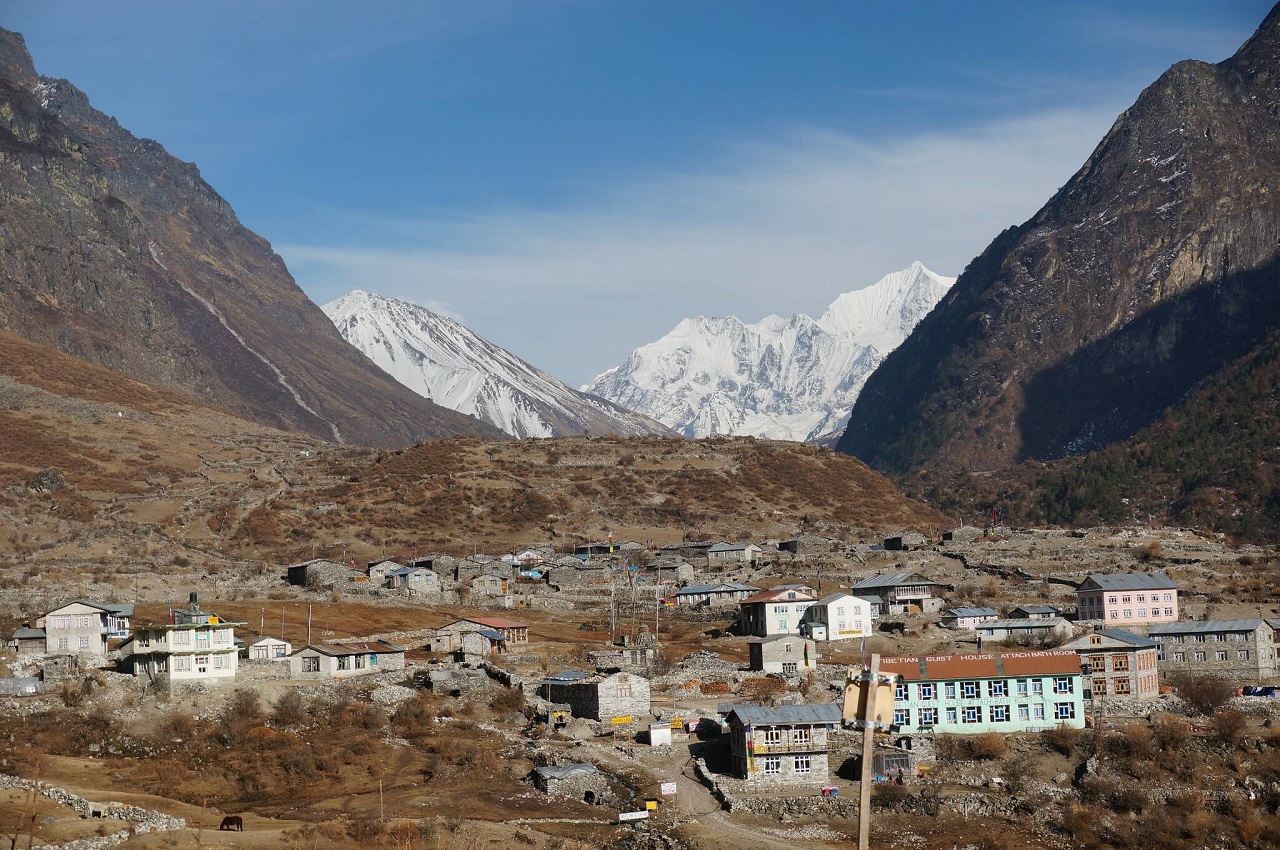
On this day, the forest trail continues through plenty of waterfalls and occasional glimpses of Langtang Lirung. At Ghoda Tabela, the path emerges out of the woodlands into the lush green meadow. The snow-capped peaks of the Langtang range begin to appear on either side of the valley.
The trail further continues to a gentle uphill, passing a few temporary settlements towards Langtang village. Before the 2015 earthquake, Langtang village was once a bustling settlement with plenty of teahouses and lodges. A massive rock field surrounds the entire valley. Mundu village is only half an hour away from Langtang village.
Day 4: Trek from Mundu (3,430m) to Kyanjin Gompa (3,870m) – 3 hours
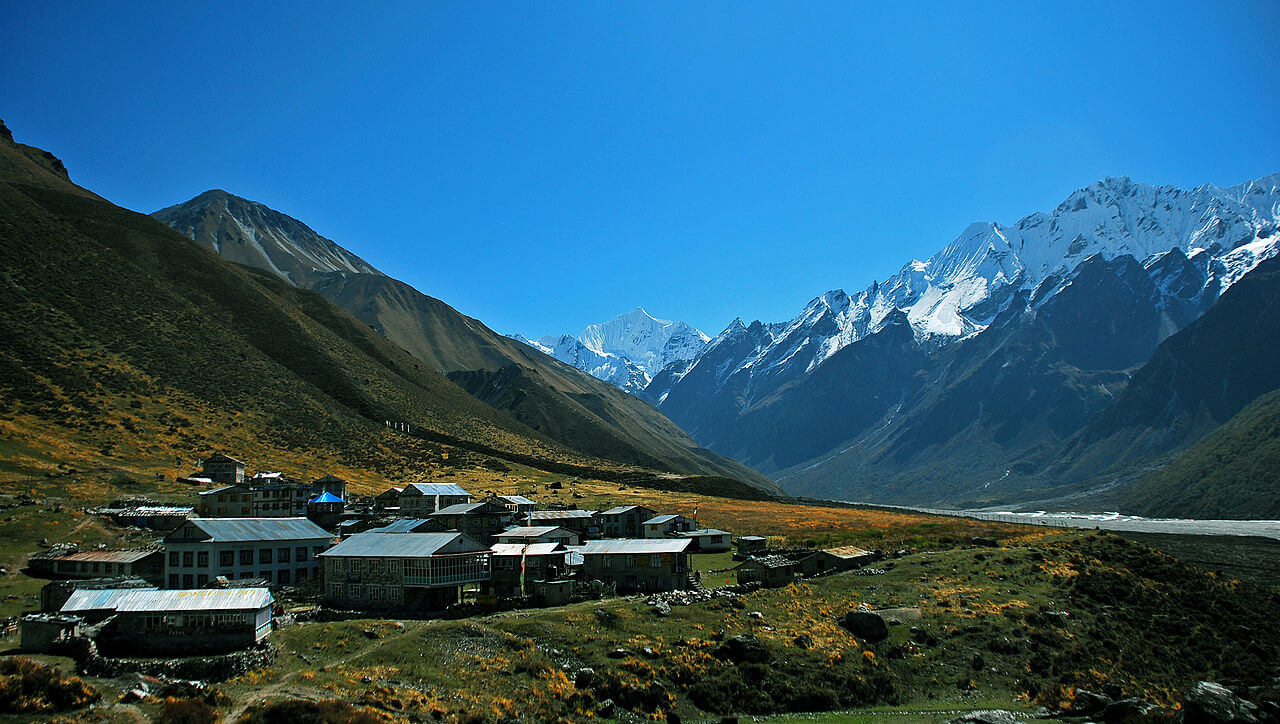
Today, the trail continues gradually passing water mills, chortens, prayer flags, and sacred mounds of rocks with carved inscriptions. The route heads upwards to a yak pasture where the sight becomes more extensive with the mountain views.
As you cross over some moraines and small streams, you’ll reach Kyanjin Gompa. Since this is the shortest day of the trek, you’ll arrive at Kyanjin Gompa by lunchtime. So, if you do not want to spend the day resting, we recommend you head towards Langshisha Kharka for incredible views.
Day 5: Excursion to Tserko Ri (5,000m) – 5 to 6 hours
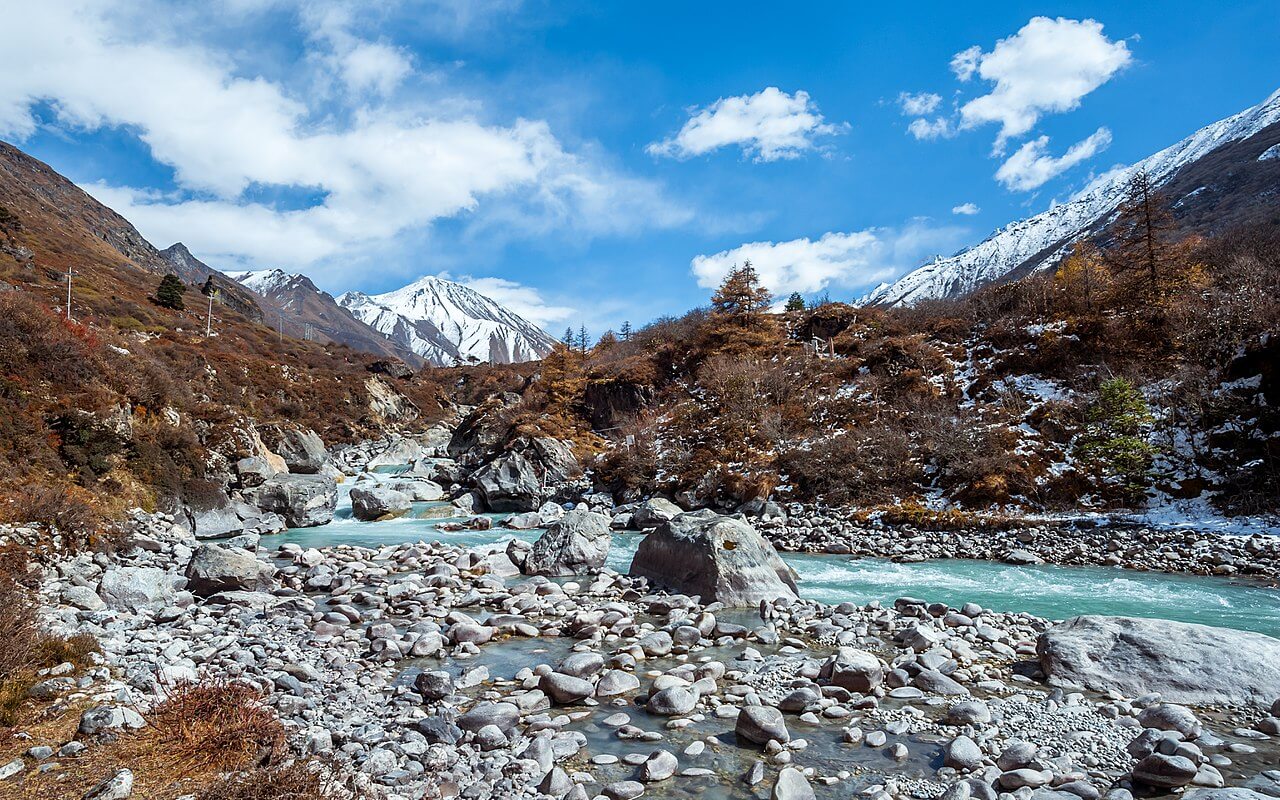
Hike up to the vantage point at Tserko Ri to relish the incredible sights of the mountains, glaciers, and the Langtang valley. Tserko Ri marks the highest elevation point of the trek at 5,000m above sea level.
Since you’ll return to Kyanjin Gompa by the afternoon, you can also explore the ancient monastery of the village. Additionally, you can also visit the cheese factory and glacier.
Day 6: Trek from Kyanjin Gompa (3,870m) to Lama Hotel (2,380m) – 6 to 7 hours
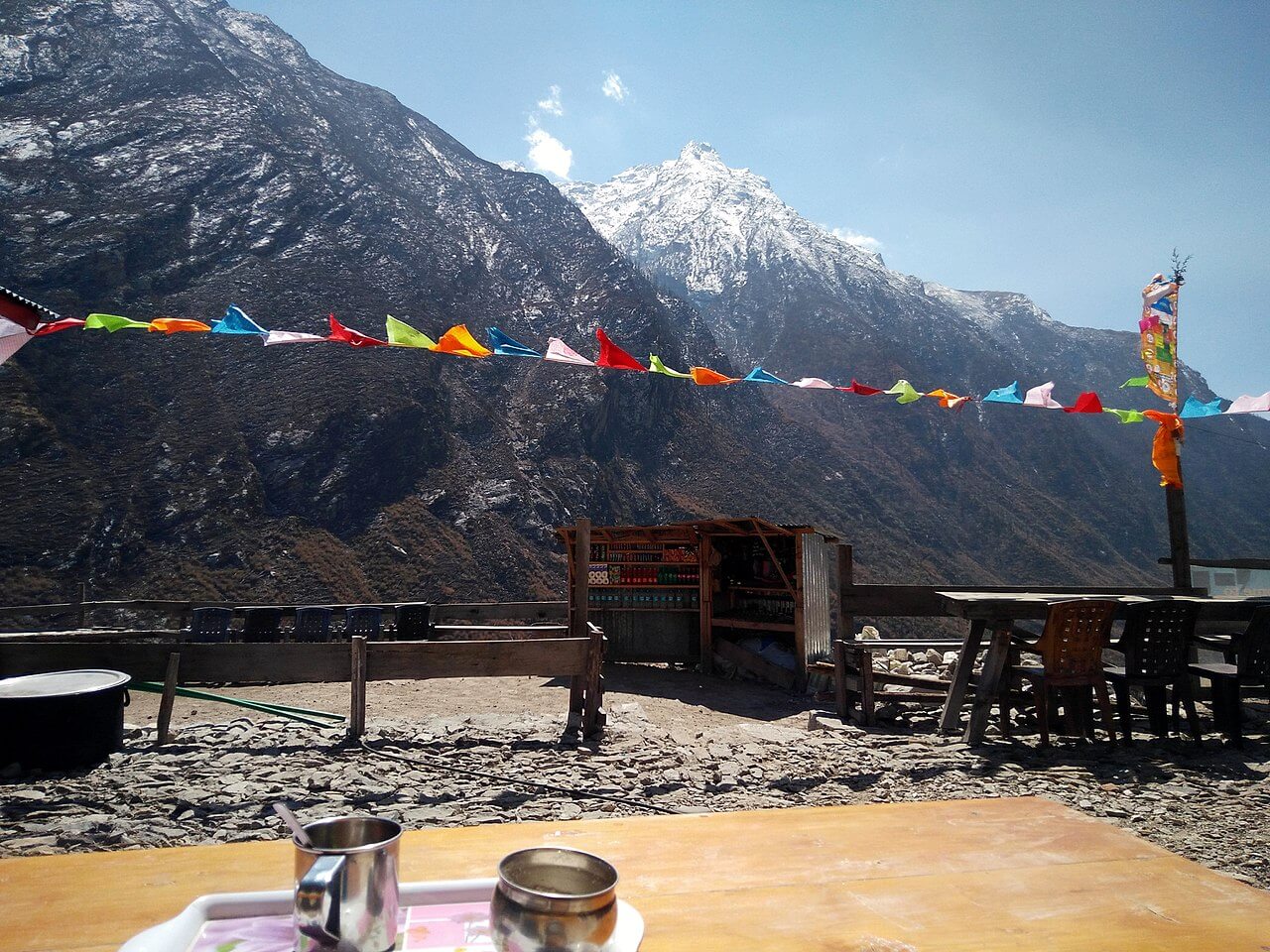
On this day, you retrace the route from Kyanjin Gompa back to Lama Hotel. The way follows back alongside the Langtang River through Mundu village to Ghoda Tabela. The trail is mostly downhill throughout the day. Upon reaching Ghoda Tabela, you’ll continue descending on a steep downhill to Lama Hotel.
Day 7: Trek from Lama Hotel (2,380m) to Syabru Besi (1,550m) – 6 to 7 hours
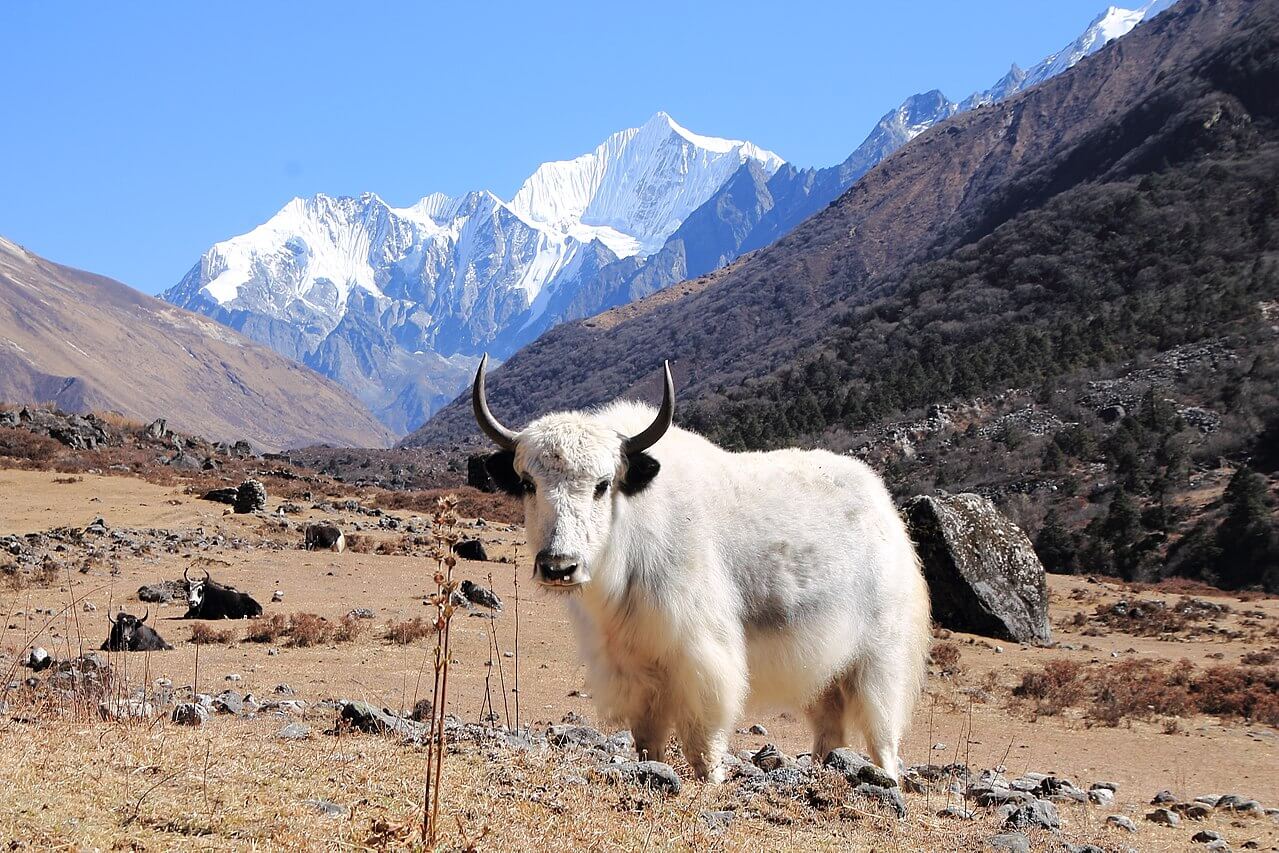
Two different trails lead to Syabru Besi. You can either retrace the route enjoying the forest from Lama Hotel or you can take a detour from Rimche via Sherpa Gaun to Syabru Besi.
The detour from Rimche takes much longer to arrive at Syabru Besi, but this spectacular route is worth the time.
Day 8: Drive from Syabru Besi (1,550m) to Kathmandu (1,400m) – 8 to 10 hours
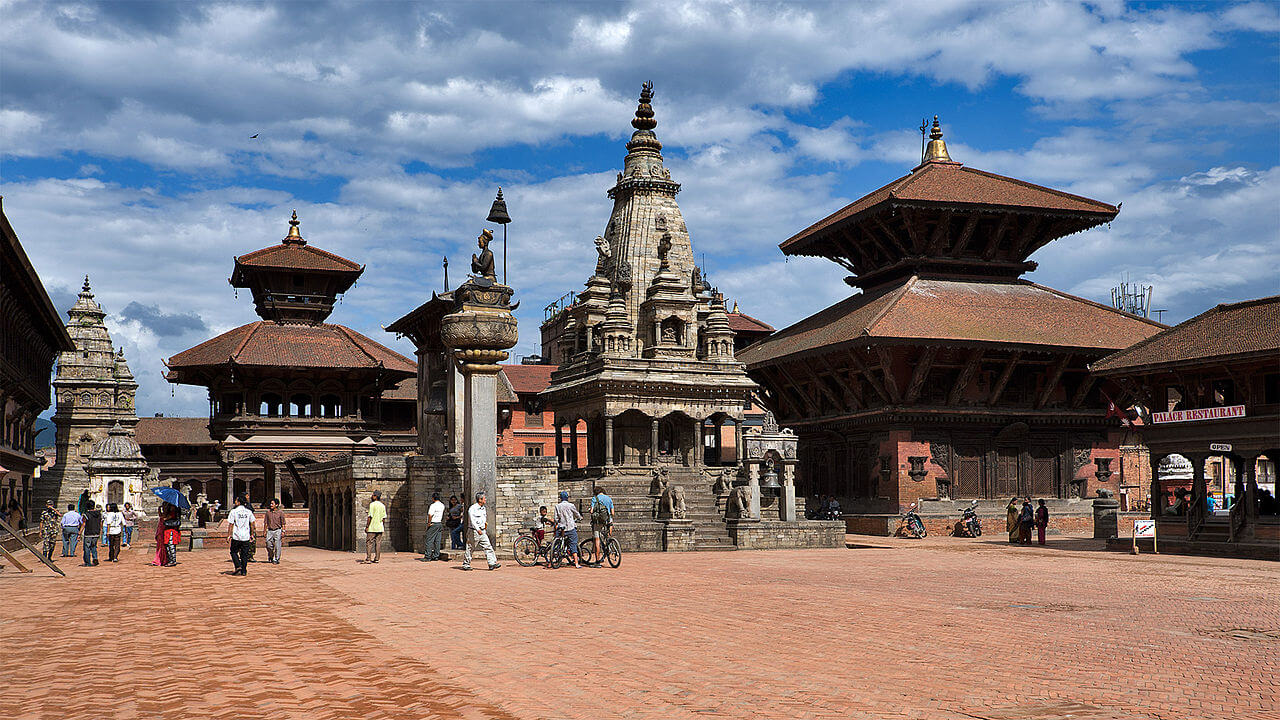
On the final day, you drive back from Syabru Besi to Kathmandu. If you’re early, you can catch a local bus from here. Otherwise, you can also take a local jeep for a slightly convenient experience. It takes about 7-8 hours to drive from Syabru Besi to Kathmandu.
Langtang Valley and Gosainkunda Extension
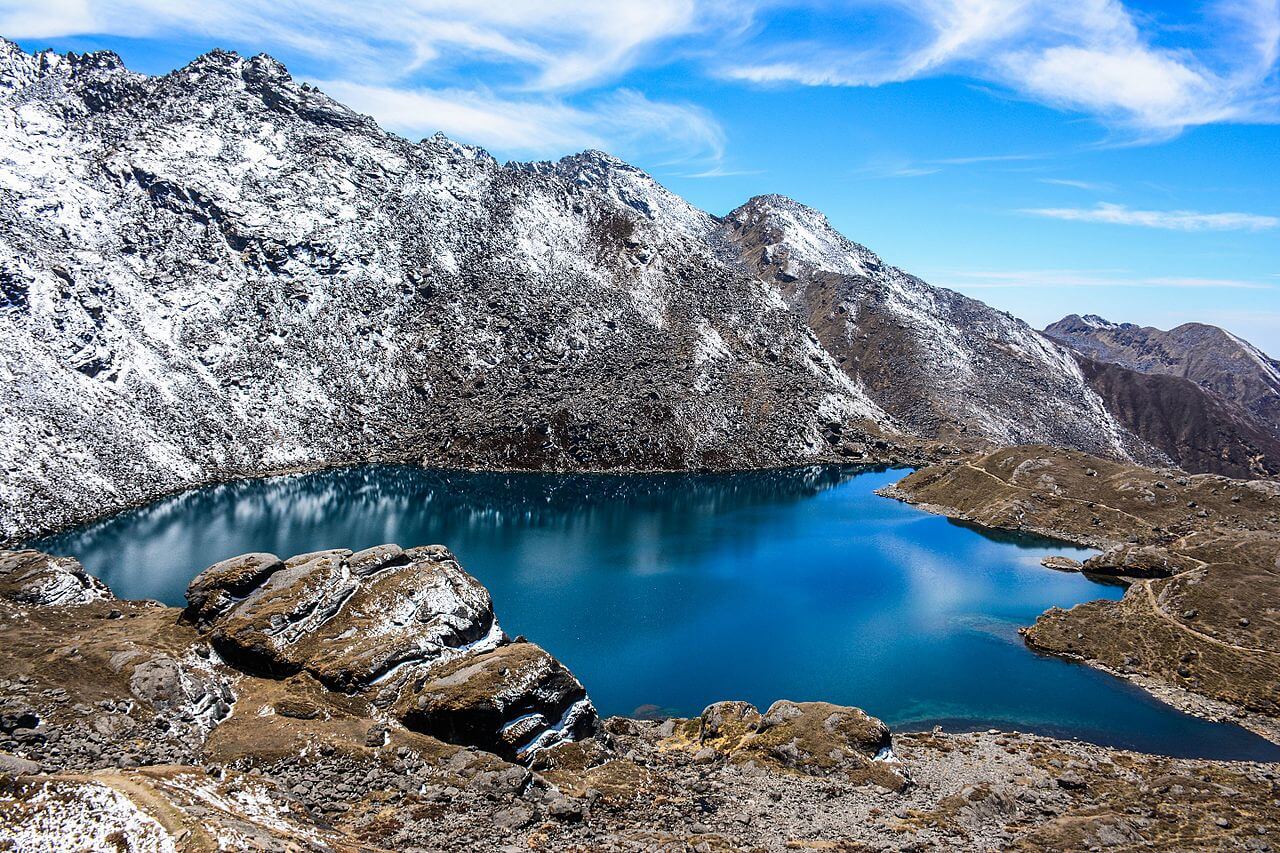
If time permits, you can combine the Langtang Valley Trek with Gosainkunda. The trek offers remote trails with spectacular views of the mountains at Langtang and high Himalayan lake at Gosainkunda.
Gosainkunda, a holy glacial lake at an elevation of 4,380m, is a shrine of Hindus. The diverse landscapes, lush green forest, terraced fields, hills, and scenic mountain views make Gosainkunda one of the most stunning trekking destinations in Nepal.
Langtang Valley Trek with Gosainkunda Extension begins with a drive from Kathmandu to Syabru Besi and then follows through the Langtang Valley. The trail to Gosainkunda connects from Thulo Syapru while retracing the route back from Langtang Trek. The path is quite steep from Thulo Syabru to Sing Gompa and up to the pristine lake of Gosainkunda.
Best Time to Travel in Langtang Region
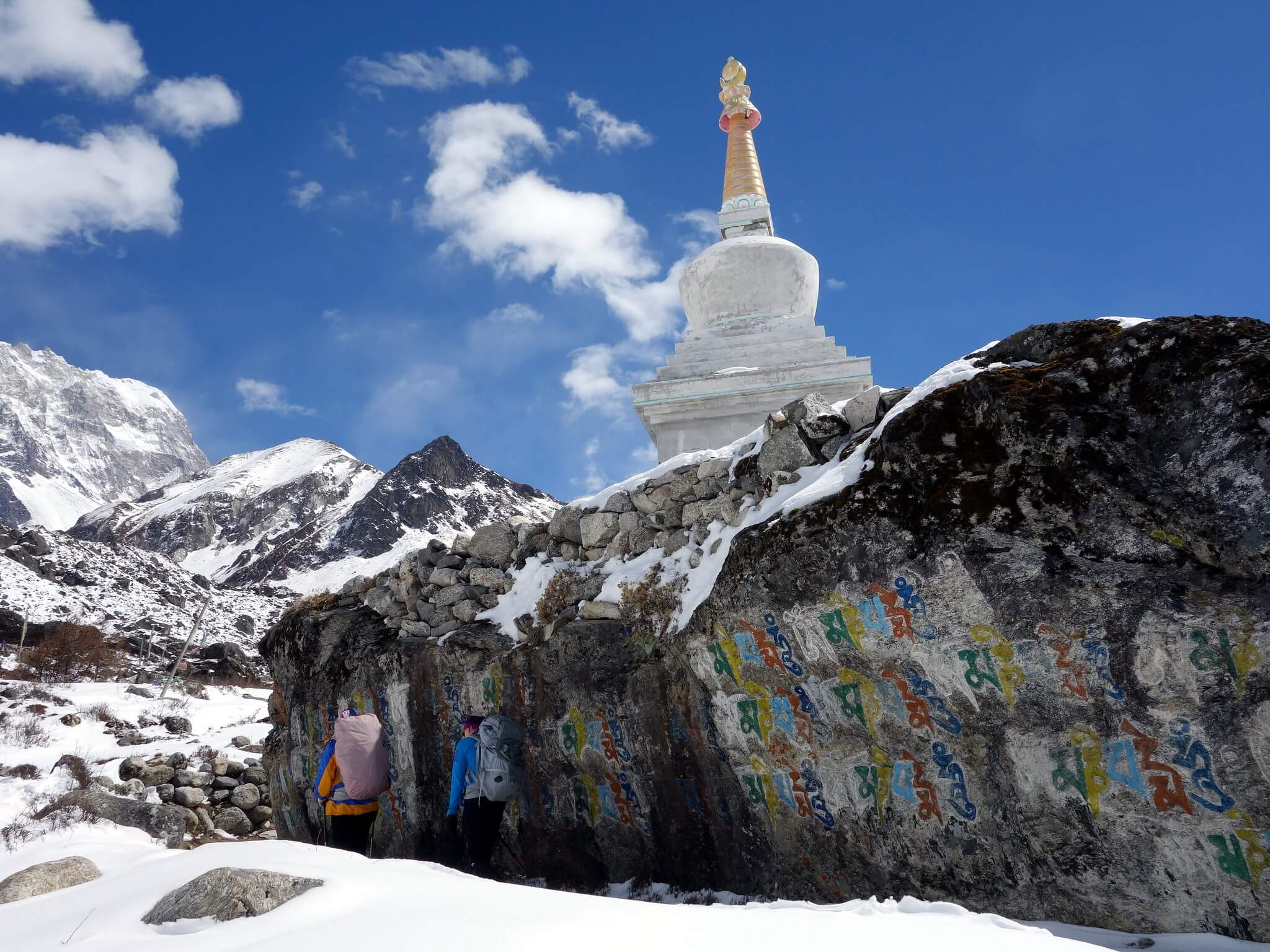
Trekking to Langtang Valley is possible throughout the year. However, Spring season (March to May) right after the cold winter and in Autumn season (September to November) right after the soaking monsoon are two most popular periods to visit the Langtang region.
In most of the days during the Autumn, the temperature remains moderate with a crystal clear sky. This means the temperature during this time of the year is perfect for walking. Also, you get to witness the incredible scenery of the Himalayas throughout the trek. However, the only drawback to trek at this time of the year is the crowded trails.
During the spring season, the temperature is slightly warmer during the day, and the sky looks hazy at times. This means the view may not be as exceptional as the Autumn.
Winter brings cold and harsh weather, especially at the higher elevations. Thick snow covers the trails making it hard to walk during winter. However, the skies are unclouded and reward magnificent sights. If you’re planning to trek to Langtang Valley during the winter, make sure to pack warm clothes and high-quality sleeping bags.
Monsoon is the least favorable time to go trekking in Langtang. The temperature is far too unstable with wet and slippery trails. Since dense forests dominate this region, the risk of leeches increases extensively. Trekking in monsoon demands proper preparation and packing.
Here’s a table indicating the details of average temperature and rainfall of different places en-route to Langtang Valley Trek:
How Difficult is Langtang Valley Trek?
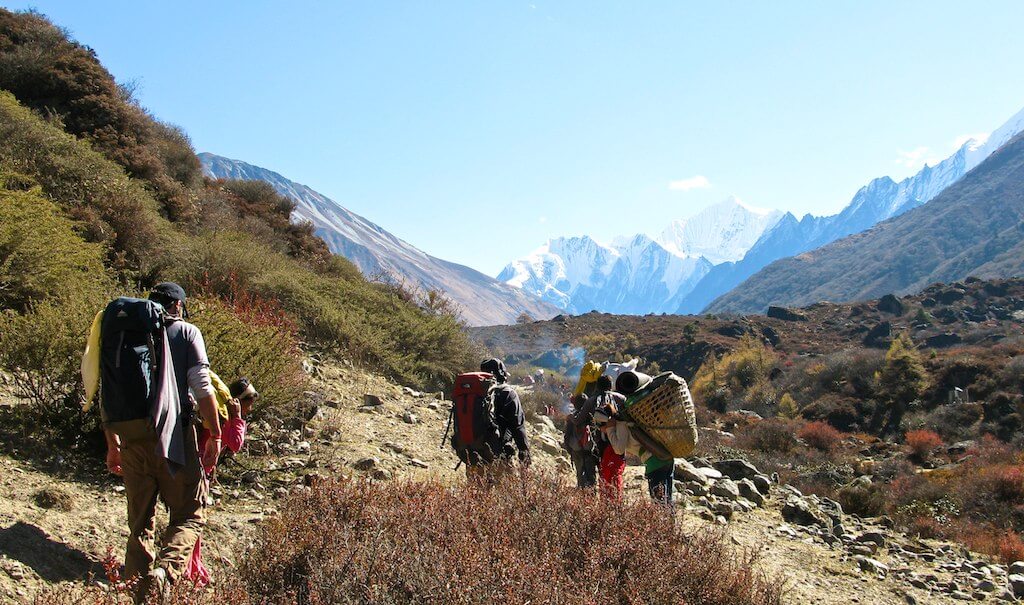
Langtang Valley Trek is a short and moderate trek that does not require any technical skills or previous trekking experience. You can complete the entire trek in 8 to 10 days, walking 5 to 7 hours per day.
The most challenging section of Langtang Trek is the hike from Kyanjin Gompa to Tserko Ri. The trail to Tserko Ri is mostly steep uphill on the rocky Himalayan terrain. However, on most days, the path is easy and comfortable with a pleasant walk.
The highest elevation point in Langtang Valley Trek is 5,000m above sea level. Therefore, Acute Mountain Sickness (AMS) is one of the significant threats while trekking in Langtang. You are required to take all the necessary precautions while traveling in such high elevation. Insist on drinking plenty of water, and be aware of the symptoms of AMS.
The weather in the Himalayas is always unpredictable, especially in the upper reaches. Therefore, it is essential to pack all the necessary equipment while trekking in Langtang Valley. If you’re planning to trek during monsoon season, stay cautious on the trail. There are plenty of landslide-prone areas en-route to Langtang Valley.
While this trek may be relatively easy for experienced trekkers, it does demand a certain level of physical fitness and attitude. One proper way to keep yourself fit for the trek is to engage in cardio-oriented exercises.
What Permits are Requied for Langtang Valley Trek?
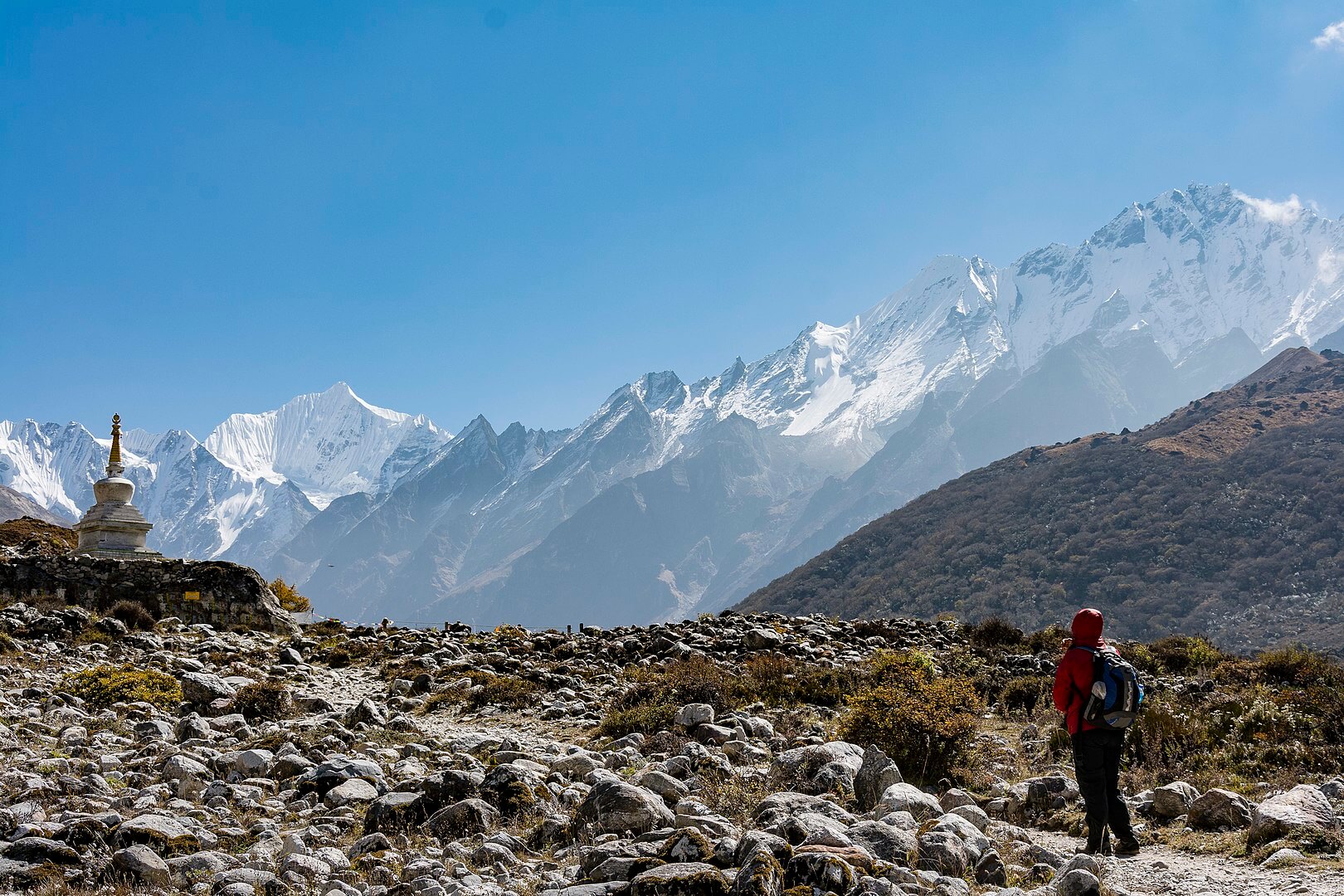
You only require two different permits — TIMS Card (Trekking Information Management System) and Langtang National Park Entry Permit, while trekking to Langtang Valley.
There are three types of TIMS Card; blue for organized group trekkers, green for individual travelers, and a pink one for SAARC nationals. You can acquire TIMS Card from Nepal Tourism Board (NTB) or Trekkers Agencies’ Association of Nepal (TAAN) Secretariat in Kathmandu.
Since you’ll be trekking through the Langtang National Park also need an exclusive National Park Permit to enter the area. The permit is available in Nepal Tourism Board in Kathmandu, or you can also get them from the entry gate at Dhunche.
While issuing a TIMS Card, you’ll require your passport, four passport size photos, insurance details, and contact details of someone in Nepal.
Here’s the price of the permits required for Langtang Valley Trek:
Insurance for the Trek
Having travel insurance is an excellent idea if you’re planning to trek to Langtang Valley. While trekking in such high elevations, you may come across unexpected situations. Therefore, it is essential to get travel insurance for Langtang Trek.
Make sure to choose a policy that covers emergency helicopter evacuation, medical costs, natural disasters, theft, and losses. While several companies provide travel insurance, we advise you to get it from World Nomads. The best thing about World Nomads is that you can claim, buy, or extend the policy anytime online from anywhere — even while traveling.
Guided VS Independent
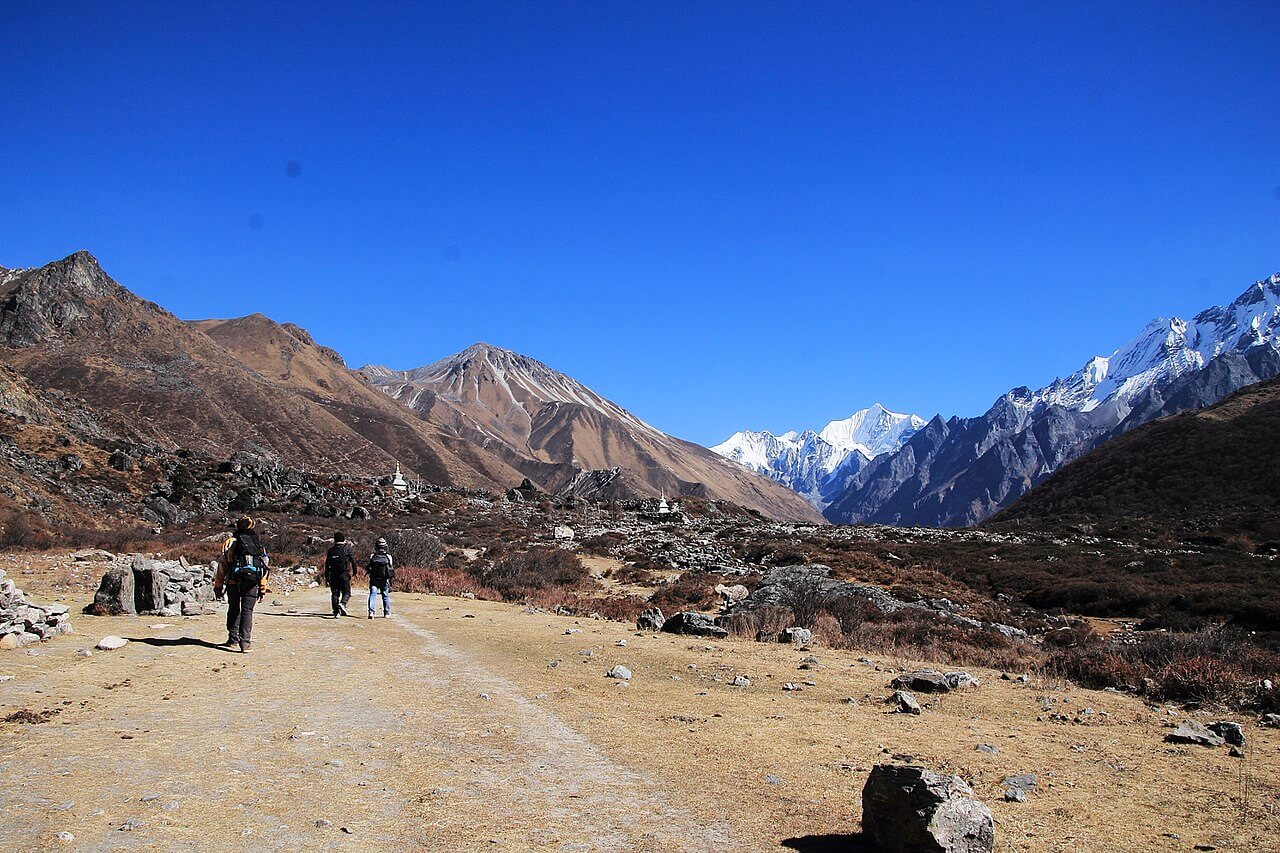
Since Langtang Valley Trek is a moderate walk, you can do it both independently or with a guide. If you’re planning a solo adventure and have prior trekking experience, this trek is an excellent choice for you. The route does not disperse into other trails, and occasional signposts mark the entire trail. Therefore, the risk of taking the wrong path is very minimal.
Altitude is the primary threat while trekking to Langtang Valley. Stay aware and precautious regarding this factor.
Trekking independently is relatively cheaper than hiring a guide, but you need to deal with hassles of transportation, teahouses, food and permit. It is always handy to have an experienced guide at high altitude treks. The guide will assist you throughout the trek and will make sure of your safety.
An experienced guide will also know about the place, culture, people, and the mountains. You’ll also get more in-depth information about the valley if you hire an experienced guide.
Accommodation and Food
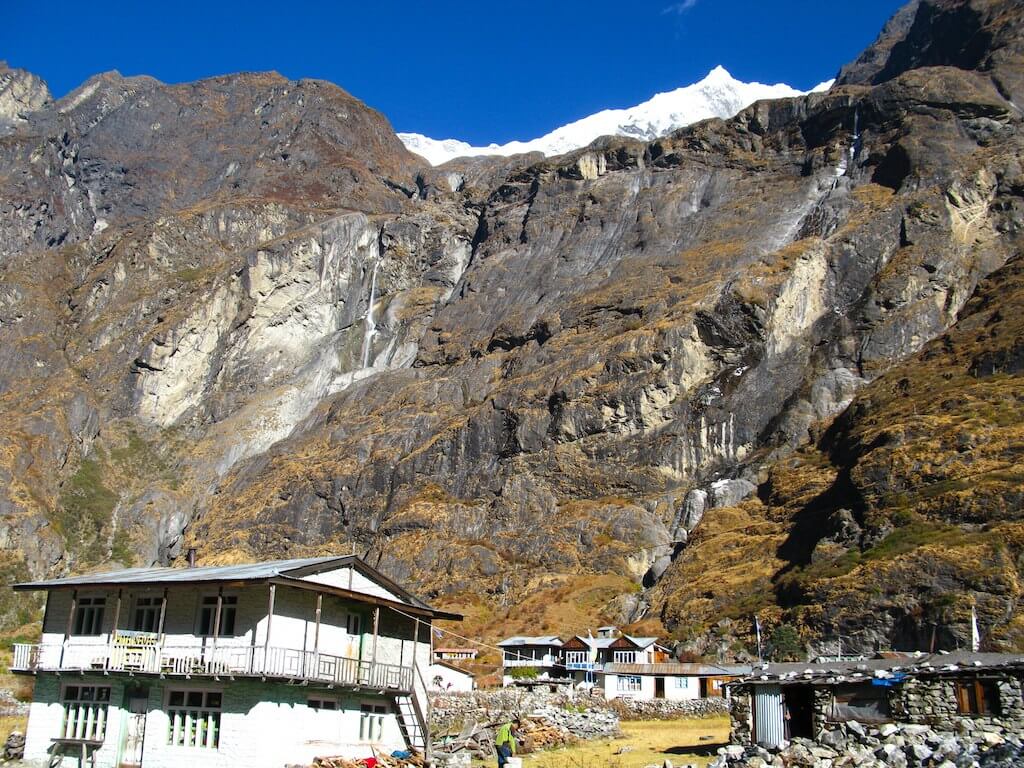
On Langtang Valley Trek, you will mostly stay at the teahouses, which provide rooms, food, and basic amenities like wifi, hot shower, and charging facilities. On the lower reaches of Langtang Valley Trek, you will get high standard rooms with attached bathrooms. These teahouses will offer standard services but may charge you higher than normal rates. Some of the teahouses provide device charging facilities at free of cost.
As you get higher on the trail, teahouses provide only essential services with twin shared rooms. The rooms have two single beds, a thin mattress, a pair of bedsheets, and a cushion. The toilets are usually on a sharing basis without the facility of running water. You’ll have to pay the additional amount for a hot shower, wifi, and charging facilities.
These teahouses also have their restaurant, serving meals to the guests. The choices in the menu are limited, but portions of the food will be quite substantial and filling. Generally, the menu offers Dal Bhat, chowmein, omelet, fried potatoes, pancakes, Tibetan bread, and soups. The non-veg items include yak meat, canned fish, and chicken.
Langtang Valley Trek Cost
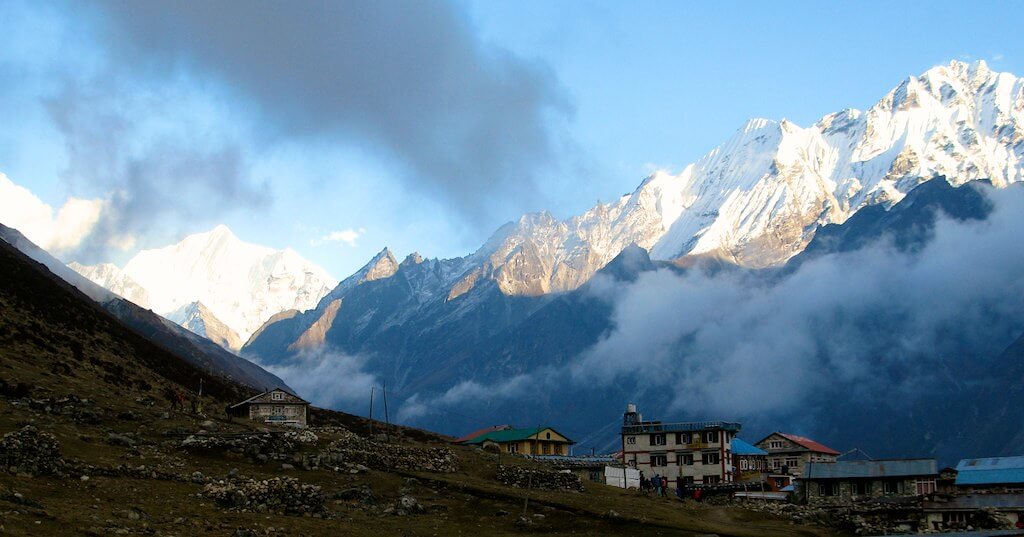
The plenty of factors like trek duration, transportation, type of trek, and season determine the cost of the trek. On average, the total cost of 8-day Langtang Valley Trek can be around US$ 300-400.
You’ll require TIMS Card and Langtang National Park Entry Permits to trek to Langtang Valley. For individual trekkers, the cost of the TIMS Card is US$ 18 while for group trekkers, it is US$ 9 her head. Additionally, the National Park Entry Permit costs US$ 27 per person.
The charge of the teahouses depends on season. Generally, the rooms in Langtang will cost approximately US$ 5 to 10 per night with an additional US$ 4 to 6 per meal.
A local bus from Kathmandu to Syabru Besi will cost about US$ 6-8 per person at par various transport companies. You can also take a local jeep that will cost you around US$ 8-10. Additionally, you can also hire a private jeep for $150 for a group of 6 to 7 people.
If you hire a licensed guide, they will charge you US$ 22 to 25 per day. If you hire a porter, it’ll cost you approximately US$ 15 to 18 per day. If you want to hire a porter-guide, they’ll charge you US$ 18 to 20 per day.
Packing List for Langtang Valley Trek
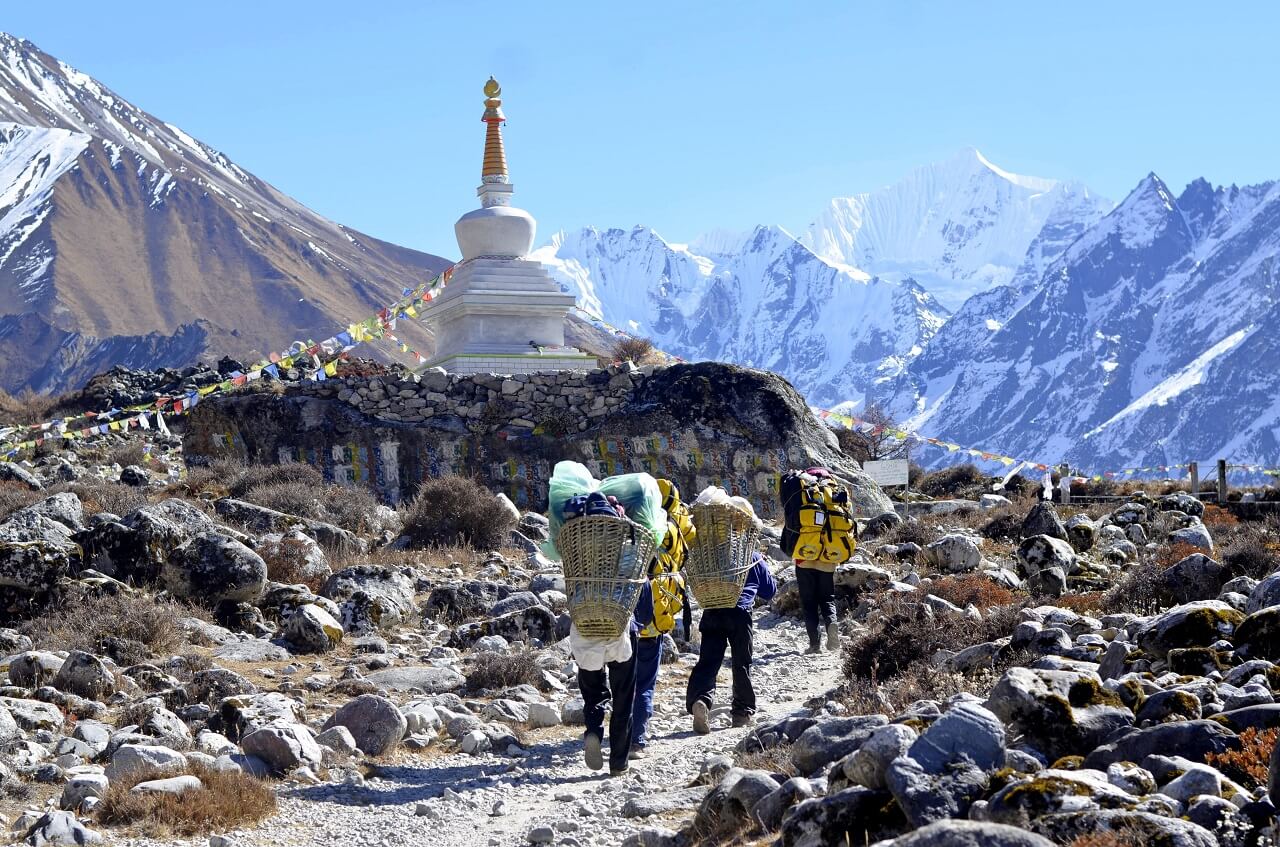
- Duffel Bags
- Trekking Shirt: Pack at least 5 to 7 shirts balancing both long and short.
- Trekking Trousers: Carry a minimum of 2 trekking trousers with a couple of shorts.
- Base Layer: Pack a couple of wool base layers to stay protected from the cold in the upper reaches of the trek.
- Insulation Layer: We recommend you pack a high-quality fleece jacket.
- Outer Layer: Carry a warm and waterproof jacket for extreme weather.
- Waterproof Shell Jacket: Pack a pair of waterproof jackets for wet weather.
- Breathable Underwear: Minimum 5 to 6 pairs of breathable underwear.
- Hiking Boots: Invest in high-quality waterproof hiking boots. Make sure the boot is lightweight and comfortable.
- Trainers/Sandals: It is handy to carry a pair of trainers or sandals.
- Hiking Socks: You should carry 4-6 pairs of breathable hiking socks.
- Thermal Socks: A pair of thermal socks to keep your feet protected from the cold in the higher altitudes.
Head Wears:
- Sun Protection Hat: Carry a protection hat to protect your face from the harsh sun.
- Beanie: An absolute must to keep yourself warm, especially during the evening and night.
- Buff/Neck Gaiter: This small piece of gear comes in handy to protect your neck from the cold winds and also helps you stay protected from the dust.
- Inner Gloves: Pack light inner gloves as they can be useful when the temperature is moderate.
- Outer Gloves: You’ll be wearing them in the upper reaches of the trek. Outer gloves need to be insulated, warm, and waterproof.
Sleeping Bags:
Sleeping bags are the most crucial gears while trekking in the Langtang region. With basic rooms and sleeping facilities, you can never rely on the teahouses for warm, decent blankets.
Therefore, we advise you to invest in a high-quality, 4-season sleeping bag while trekking in Langtang.
Important Accessories:
- Trekking Poles
- Water Bottle
- Basic Medical Kits
- UV Protection Sunglasses
- Water Purification Tablets
- Hand Sanitizers
- Sunscreen/Lip Balm
- Trekking Towels
- Portable Chargers
Network Information
Both Ncell and NTC networks do not work in the Langtang Valley. Once you depart from Kathmandu, NTC services are not available, and Ncell works only up to Lama Hotel. Sky Network is the most preferred telecommunication service in the Langtang Valley. Sky Network works throughout the entire trek, from the lower reaches up to the higher elevations.
Remember, phone services may not be consistent throughout the entire region. Due to the inconsistency of networks, the mobile internet will also be unstable. However, most of the teahouses do provide WiFi facilities, but it might cost you a few extra bucks.
The majority of the teahouses in Langtang have landline phones. In case of emergencies, landline phones are the best way to connect with your emergency contacts.
Useful Tips for Langtang Valley Trekking
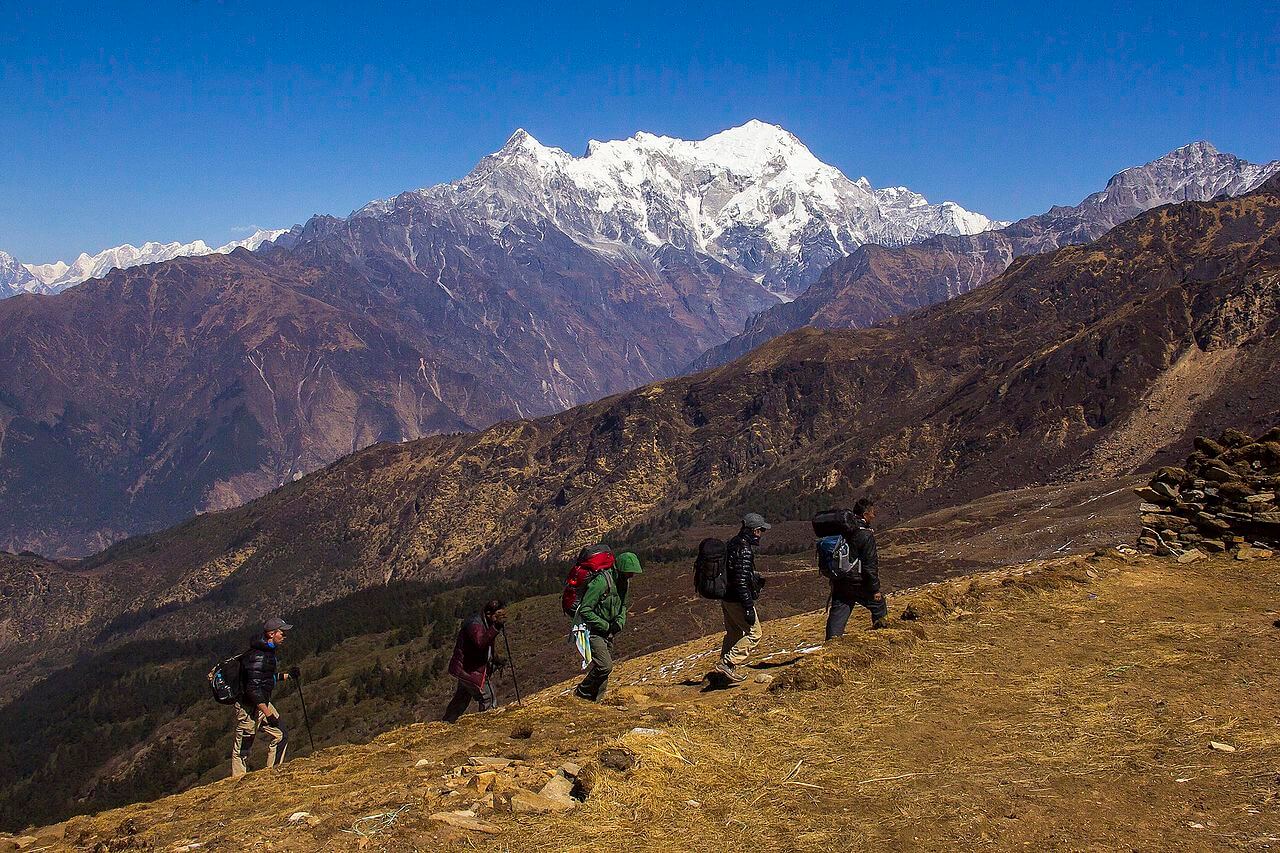
- While trekking in the upper reaches of Langtang Valley, you’re in a constant threat of suffering from acute mountain sickness (AMS). It is crucial to drink more water and take all the necessary precautions to protect yourself from altitude sickness.
- Packing the right equipment is essential while trekking to Langtang Valley. If you do not wish to buy all the expensive trekking gears, we advise you to rent them in Kathmandu.
- Although Langtang Valley Trek is a relatively moderate trek, it requires a certain level of physical fitness. We suggest you engaging in cardio-oriented activities like cycling, swimming and running, a month before the trek.
- It is not advisable to buy bottled waters as they pollute the trekking trail. We highly recommend you to fill up the water at the teahouses and use water purifiers to treat the water.
- Invest in high-quality hiking boots. If you’re planning to trek to Langtang Valley during monsoon or winter, buy waterproof boots that have sturdy soles.
- Before you go for trekking to Langtang Valley, get proper travel insurance that covers both medical costs and helicopter evacuation.
- Carry enough cash on the trek. ATMs are not available on the trail.
Accommodation in Kathmandu
Recommended travel agencies for langtang valley trek.
- Himalayas on Foot
- Magical Nepal
- Mosaic Adventure
- Nepal Eco Adventure
Recommended Books and Guidebooks
- A Trekking Guide to Langtang
- Lonely Planet Nepal (Travel Guide)
- The Rough Guide to Nepal
- Trekking in Langtang, Helambu & Gosainkund
- Climate Change and the Extreme Events in the Himalayas
- High Adventure
- The Snow Leopard
1. Is it possible to do the Langtang Valley Trek solo/independently?
Langtang Valley Trek is a short and moderate walk in the Himalayas of Nepal. It is possible to do solo as well as in a group. The trail does not diverge in multiple routes and it occasionally marks the signposts. So, the trekkers do not stray off the path.
2. How likely am I to suffer from Acute Mountain Sickness in Langtang Valley Trek?
Keep in mind, Langtang Valley Trek exceeds the elevation of 3000m above sea level. Once you cross the height of 3000m, the possibility of suffering from altitude sickness becomes higher. Therefore, it is crucial to drink more water and take the necessary precautions to stay safe from AMS.
3. What type of accommodation can I expect in Langtang Trek?
In the lower region of Langtang, there are plenty of high standard lodges and teahouses that provide quality services. However, these teahouses are relatively expensive than the common one.
In the upper reaches of the trek, the teahouses offer rooms in sharing basis and other basic facilities.
4. Is it safe to drink water in Langtang Valley Trek?
No, it is not safe to drink water directly from local streams or taps while trekking in the Langtang region. Bottled water is quite expensive on the trail. It is advisable to carry your bottle and fill the water in the teahouses. Carry water purifiers or SteriPen purifiers to treat the water before drinking.
5. Do I need travel insurance before trekking to Langtang Valley?
While travel insurance is not mandatory, it is highly advisable to have one in high altitude treks. Even though Langtang Valley is a short and moderate, trekking in such high elevation is risky. Therefore, it is advisable to have proper travel insurance that covers all the necessary costs.
Langtang Valley Trek is a short and moderate trek in the Himalayas of Nepal. Easily accessible from Kathmandu, this trek is an excellent opportunity that rewards trekkers with authentic experience and warm hospitality.
Langtang Trek is an ideal choice for people who are looking to escape the massive crowd of Everest and Annapurna. It offers a diverse landscape, unique culture, beautiful scenery, and panoramic mountain spectacles.
Langtang Valley is also a perfect adventure destination to discover rare wildlife and plants. Carrying a decent camera is highly advisable as this trek offers plenty of opportunities to capture picture-perfect photographs.
Similar Posts
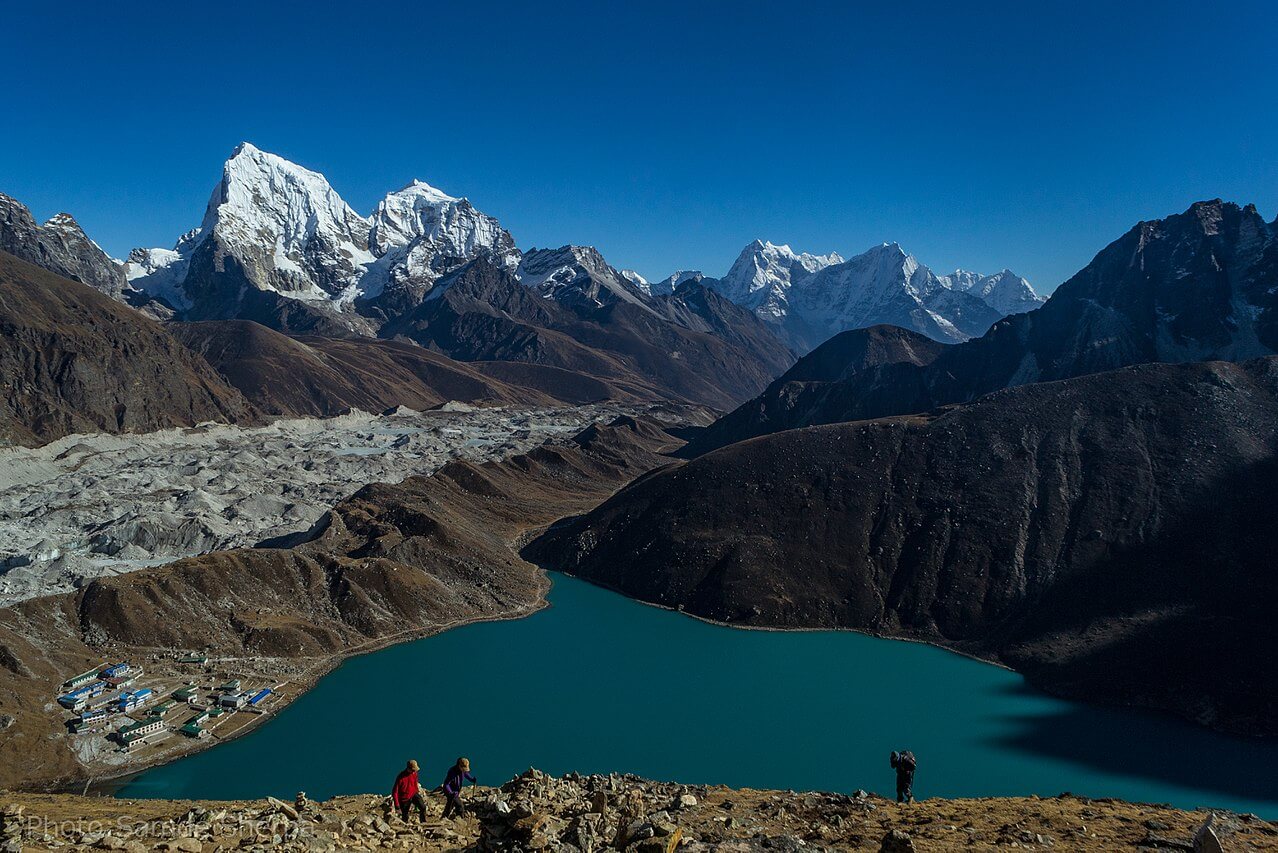
Gokyo Ri Trek
Gokyo Ri Trek, the best alternative trail to the Everest Base Camp Trek, offers exceptional views of the Himalayan peaks along with lakes and glaciers. Gokyo Ri Trek is a moderate trek in the high Himalayas of the Everest region. Instead of traveling to the more commercial Everest Trek, trekkers often choose this itinerary to…
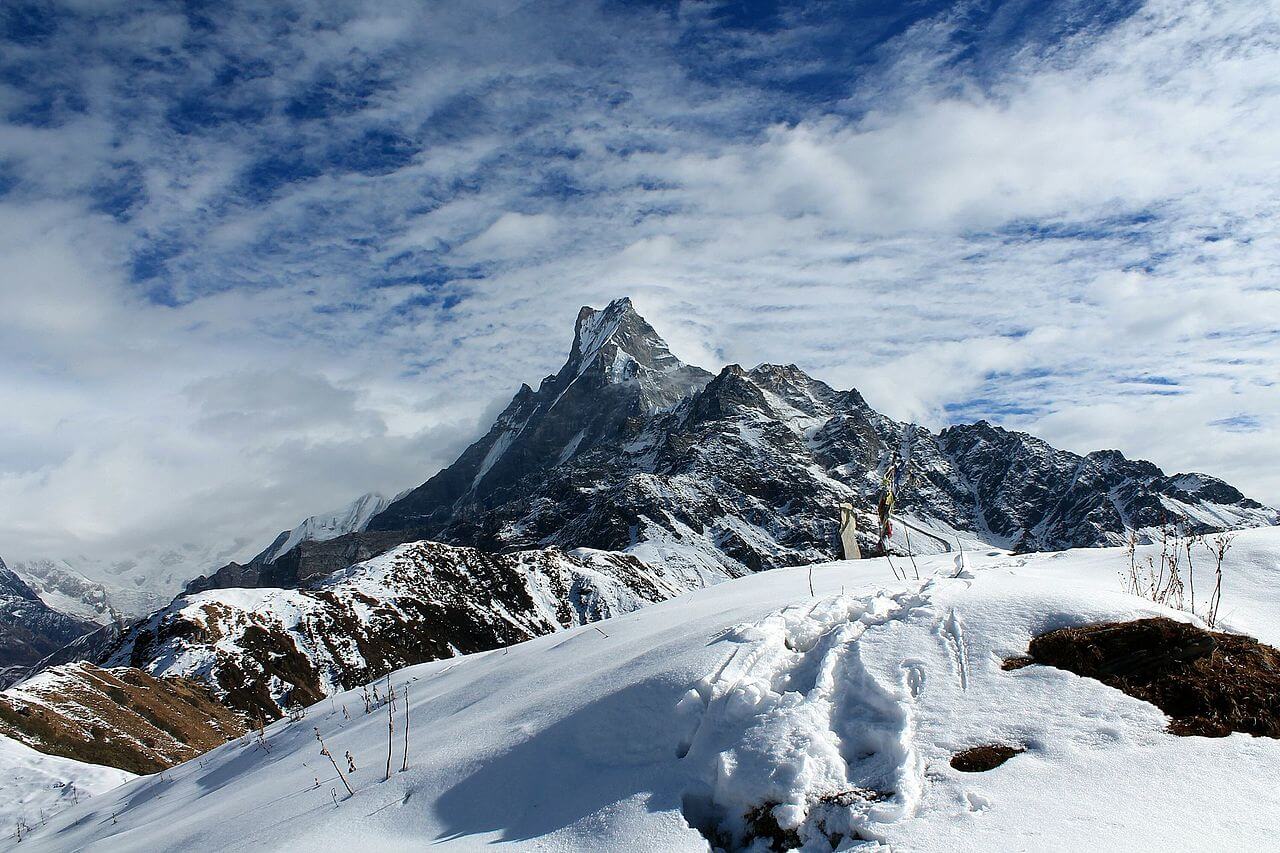
Mardi Himal Trek
Mardi Himal Trek is a hidden gem for the dedicated trekkers and backpackers. Located eastwards of the classic Annapurna Base Camp, this trekking route is yet to witness a large crowd like other commercial treks in Nepal though it officially opened for all in 2012. The richly diverse terrains of Mardi Himal takes you across…
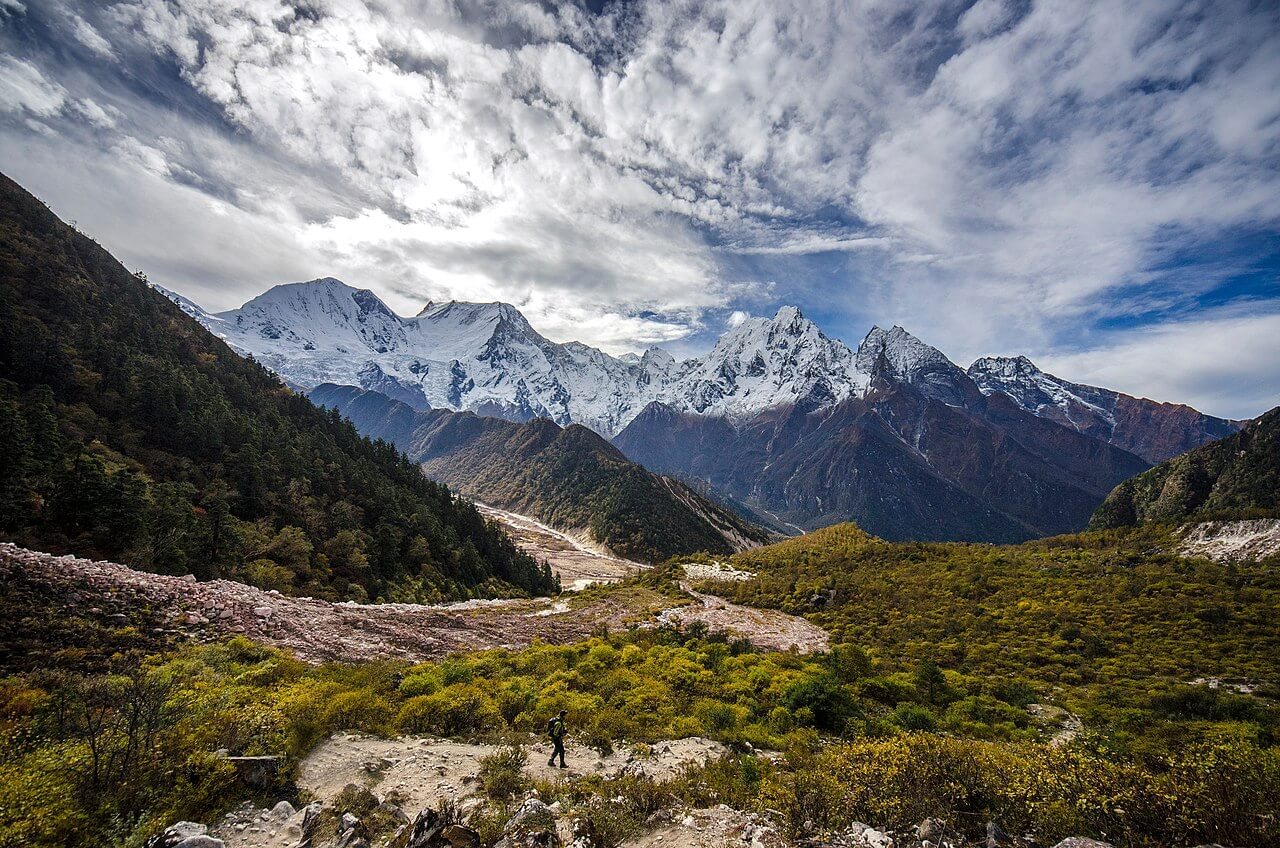
Manaslu Circuit Trek
Manaslu Circuit Trek stands less beaten and secluded compared to treks like Everest or Annapurna, but it is equally as impressive as other classic treks. Manaslu Circuit Trek is the most beautiful as well as demanding treks in Nepal. Trekking in Manaslu is a delightful experience with a blend of adventure, scenery, culture, lifestyle, and…

- Why Do you Choose with Us?
- Everest Trekking Routes
- Legal Document
- Term & Condition
- Ghorepani Poon Hill Trek 4 Days
- Ghorepani Poon Hill Trek
- Annapurna Base Camp Trek 5 Days
- Annapurna Base Camp Trek 7 Days
- Annapurna Base Camp Short Trek
- Annapurna Base Camp Trek
- Annapurna Base Camp Trek 10 Days
- Annapurna Base Camp Trek Solo
- Annapurna Circuit Trek
- Mardi Himal Trek 5 Days
- Mardi Himal Trek
- Khopra Ridge Trek
- Annapurna Tilicho Lake Trek
- Jomsom Muktinath Trek
- Australian Camp Hike
- Dhampush Sarangkot Trek
- Ghale Gaun Trek
- Budget Annapurna Base Camp Trek
- Nar Phu Valley Short Trek
- Nar Phu Valley Trek
- Langtang Trek 7 Days
- Langtang Valley Trek
- Langtang Gosaikunda Trek
- Langtang Tamang Heritage Trek
- Langtang Valley Solo Trek
- Langtang Ganja la Pass Trek
- Helambu Circuit Trek
- Shivapuri Nagarkot Trek
- 12 Days Manaslu Circuit Trek
- Manaslu Circuit Trek
- Short Manaslu Circuit Trek
- Manaslu Circuit Trek Solo
- Manaslu Tsum Valley Trek
- Everest view Trek 7 Days
- Everest Base Camp Trek 10 Days
- Everest Gokyo Lake Trek
- Everest Base Camp Trek
- Everest Base Camp Trek 12 Days
- Everest Cho la Pass Trek
- Everest Three Passes Trek
- Everest Base Camp Trek 14 Days
- Everest Base Camp Trek Budget
- Everest Base Camp Helicopter Tour
- Phaplu to Everest Base Camp Trek
- Upper Mustang Trek
- Upper Mustang Jeep Tour
- Kanchenjunga Base Camp Trek
- Ruby Valley Trek
- Rara Lake Trek
- Lower Dolpo Trek
- Upper Dolpo Trek
- Manaslu Annapurna Circuit Trek
- Arun Valley Trek
- Chepang Hill trek
- Dhaulagiri Round Trek
- Ganesh Himal Trek
- Guerrilla Trek
- Makalu Base Camp Trek
- Manaslu Rupina La Pass Trek
- Rolwaling Tashi Lapcha Pass Trek
- Sherpeni Col Pass Trek
- Kathmandu valley Sightseeing
- Pokhara Day Tour
- Kathmandu Chitwan Tour
- Kathmandu Chitwan Lumbini Tour
- Kathmandu Pokhara Bandipur Tour
- Kathmandu Nagarkot Dhulikhel Tour
- Annapurna Base Camp Helicopter Tour
- Pokhara Muktinath overland tour
- Bungee Jumping in Nepal
- Dhorpatan Hunting Tour
- Family Tour in Nepal
- Helicopter Tour in Nepal
- Mountain Flight in Nepal
- Island Peak Climbing
- Chhukung to Island Peak Climbing
- Lobuche Peak Climbing
- Dingboche Lobuche Peak Climbing
- Mera Peak Climbing
- Chulu West Peak Climbing
- Chulu East Peak Climbing
- Tent Peak Climbing
- Nayakang Peak Climbing
- Amadablam Expedition
- Pokalde Peak Climbing
- Tourist Visa for Nepal
- Trekking Equipment List
- Jeep Scorpio Rental Service in Nepal
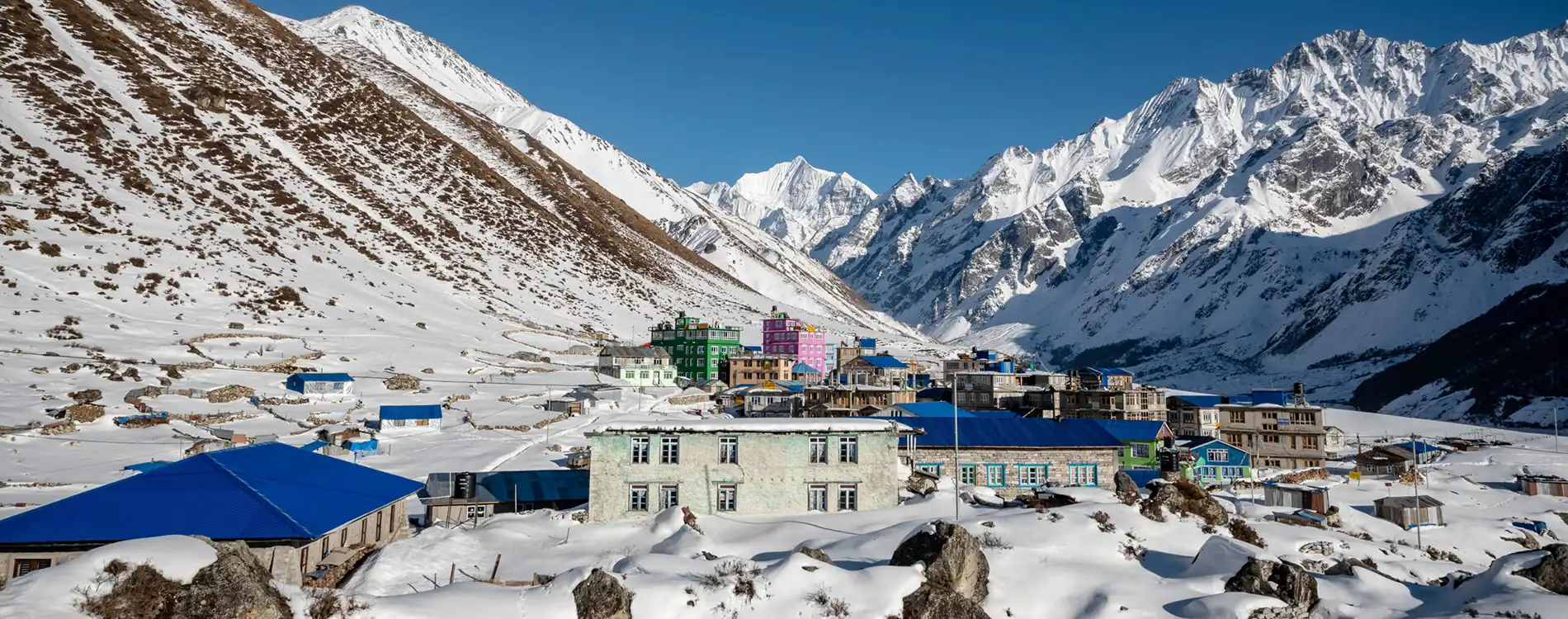
- [30+ booked]
- Share the trip
Langtang Valley trek is the most delightful Trekking in Nepal with rich culture, traditions, and riches. It is the perfect trek for those who want to trek this off-the-beaten-track. The trek offers excellent adjustment and a diverse range of landscapes during the trek. This zone is renowned for its beautiful forest with mesmerizing views of the mountain. The beautiful trekking zone passes through a dense forest of oak and pine which offers you the chance to see wildlife up close. The trek is budget-friendly and time-friendly too which is a superb introduction to trekking places in Nepal. A journey of reasonably moderate effort through a scenically dramatic alpine region and this trek is the most beautiful in Nepal.
Among the trekking destinations of Nepal, this trekking destination is one of the nearest destinations to Kathmandu Valley. It is an excellent choice for hikers who do not have enough time but are willing to experience and see the mesmerizing views of the mountain. This is one of the most pleasant trek experiences in Nepal which is a splendid trek through small villages. Trekking in this beautiful land is the most remarkable trekking destination in Nepal. The route is dominated additionally by Tamang people and most of the people are influenced by Tibetan Buddhism.
Getting to Know Langtang Valley
Langtang Valley, located north of Kathmandu, is a hidden gem in the Langtang National Park. The trek takes you through picturesque villages, lush forests, and high-altitude landscapes, providing a glimpse into the traditional Tamang and Tibetan cultures. As you ascend higher, you’ll be rewarded with panoramic views of snow-capped peaks, including Langtang Lirung and Ganesh Himal. The serene beauty of Langtang Valley is unmatched, making it a popular choice for trekkers seeking a less crowded and more authentic Himalayan experience.
The Best Time to Trek
The best time to embark on the Langtang Valley trek is during the autumn (October-November) and spring (April-May) seasons. These months offer clear skies, moderate temperatures, and blooming rhododendrons, enhancing the overall trekking experience. Avoid the monsoon season (June-September) due to heavy rainfall and slippery trails, which can pose a challenge to even the most experienced trekkers.
Langtang Trekking Itinerary
A typical Langtang Valley trek itinerary spans around 7-11 days, depending on your pace and acclimatization needs. The trek begins in Syabrubesi and follows a gradual ascent through villages like Lama Hotel, Langtang Village, and Kyanjin Gompa. Along the way, you’ll have the opportunity to explore Kyangjin Ri for panoramic mountain views, visit a cheese factory, and interact with the friendly local communities. The trek concludes back in Syabrubesi, where you can reflect on your unforgettable journey through the Langtang Valley.
Must-Visit Highlights
- Kyanjin Gompa: A sacred Buddhist monastery offering spiritual solace amidst the rugged Himalayan terrain.
- Langtang National Park: Home to diverse wildlife, including red pandas, musk deer, and various bird species.
- Tserko Ri: A popular vantage point providing unparalleled views of the Langtang range and surrounding peaks.
- Gosaikunda Lake: A serene alpine lake considered sacred by Hindus and Buddhists, offering a tranquil setting for reflection.
Tips for a Successful Trek
- Pack Wisely: Carry essential trekking gear, including sturdy hiking boots, warm clothing, and a reliable backpack.
- Stay Hydrated: Drink plenty of water to prevent altitude sickness and stay energized throughout the trek.
- Acclimatize Properly: Take rest days to acclimatize to the high altitude and avoid altitude-related illnesses.
- Respect Local Customs: Embrace the culture of the Tamang and Tibetan communities by dressing modestly and seeking permission before photographing locals.
- Support Local Economy: Purchase goods and services from local teahouses and shops to contribute to the livelihood of the communities.
How difficult is the Langtang trek?
The Langtang trek is considered to be a moderate trek, with some challenging sections. It is suitable for trekkers with a moderate level of fitness and some trekking experience.
The Langtang trek involves ascending and descending on rocky and uneven terrain, crossing suspension bridges, and walking through dense forests. The trek also involves some steep uphill climbs, especially during the initial days of the trek. Therefore, it is essential to be physically and mentally prepared for the trek.
The altitude gain on the Langtang trek is gradual, and the highest point reached is Kyanjin Ri (4,773m/15,658ft). However, altitude sickness can be a concern for some trekkers, so it is important to take adequate acclimatization days and follow a proper itinerary.
Overall, the Langtang trek is a moderately challenging trek that requires some level of physical fitness, trekking experience, and mental preparation. With proper preparation and guidance, it is a highly rewarding and achievable trek for most trekkers.
Authentic Food and Accommodation
The Langtang Valley Trek offers a variety of authentic Nepali food and accommodation options for trekkers.
Food: Along the trail, you will find teahouses and lodges that offer a range of Nepali and Tibetan dishes, such as Dal Bhat (rice and lentils), momos (dumplings), thukpa (noodle soup), and tsampa porridge (made from roasted barley flour). You can also find some Western dishes, such as pasta and pizza, but it is recommended to try the local cuisine for a more authentic experience. It is important to note that the further up the trail you go, the more limited the food options become.
Accommodation: Accommodation options along the Langtang trek range from basic teahouses to more luxurious lodges. Teahouses provide basic facilities, such as a bed, a shared bathroom, and a communal dining area. Some teahouses offer hot showers for an extra cost. Lodges, on the other hand, offer more comfortable facilities, such as private rooms, en-suite bathrooms, and sometimes even Wi-Fi. It is important to note that the further up the trail you go, the more basic the accommodation becomes, and you may need to share a room with other trekkers.
The alternative route of Langtang Trek
In addition to the classic Langtang Valley Trek, there are a few alternative routes that you can take to explore the Langtang region.
- Langtang Gosainkunda Trek : This trek combines the Langtang Valley Trek with the sacred lake of Gosainkunda, a popular pilgrimage site for Hindus and Buddhists. The trek takes you through the beautiful alpine forests, pastures, and traditional villages of the Langtang region, before ascending to the glacial lake of Gosainkunda. The trek offers stunning views of the Langtang range and the Himalayas.
- Tamang Heritage Trail : This trek takes you through the culturally rich Tamang community, where you can experience its unique traditions, cuisine, and lifestyle. The trek takes you through scenic landscapes, including lush green forests, terraced fields, and hot springs, and offers stunning views of the Langtang range and the Ganesh Himal.
- Helambu Trek : This trek takes you through the culturally rich Sherpa and Tamang villages of the Helambu region, where you can experience their unique culture and hospitality. The trek takes you through scenic landscapes, including lush green forests, terraced fields, and waterfalls, and offers stunning views of the Langtang range and the Himalayas.
Relatate Picture Gallery

Trip Itinerary
Outline itinerary.
- Day 01: Arrival in Kathmandu transfer to hotel
- Day 02: Drive to Syabrubesi (1,550m) 7-8 hours
- Day 03: Trekking to Lama Hotel (2,380m) 6 hours
- Day 04 Trekking to Mundu (3543m) 6-7 hours
- Day 05: Trekking to Kyangjin Gompa (3,870m) 4-5 hours
- Day 06: Rest day in Tserko Ri (5000m) 7-8 hours
- Day 07: Trekking to Lama Hotel 6-7 hours
- Day 08: Trekking to Syabrubesi 4-5 hours
- Day 09: Drive to Kathmandu
- Day 10: Final International departure
Details Itinerary
Cost details, cost includes.
- Airport / Hotel / Airport pick up and Drop by private car/van/bus.
- Kathmandu to Syabrubesi and Syabrubesi to Kathmandu by Express Bus
- You’re Meal During the Trekking are (8 Breakfast, 8 Lunch, and 7 Dinner with a cup of tea or coffee)
- All Trekking Permit (Langtang National Permit) and Trekkers’ Information Management System (TIMS) Permit.
- Accommodation in Trekking: All accommodations in lodge/tea houses during the treks.
- Trekking Guide: An experienced, helpful, friendly, and English-speaking Trekking Guide. His well-paid salary, meals, accommodation insurance, etc.
- Trekking Porter : porters (1 porter for 2 people). for Solo Trekker No Porter
- After the successful trip, Everest Trekking Routes will Provide an Adventure Certificate.
- Arrangement of Emergency Helicopter service which will be paid for by your Travel insurance company.
- All government taxes and service charges.
Cost Excludes
- All Meals & Hotel in Kathmandu (If you need we arrange you)
- Private Jeep
- personal expenses (bar bills, beer, coke, a bottle of water, hot water, pot size of tea or coffee, phone call, laundry service, Helicopter rescue, Electronic device recharge such as Mobile, Camera, Private, etc.)
- Tips for guide, porters, and driver.

What is the Langtang Valley Trek?
The Langtang Valley Trek is a popular trekking route in Nepal, known for its stunning scenery, diverse landscapes, and rich cultural experiences. It takes you through the Langtang National Park, offering views of snow-capped peaks, lush forests, and traditional Tamang villages.
How long does the Langtang Valley Trek take?
The Langtang Valley Trek typically takes about 7 to 8 to 11 days to complete, depending on your starting point, pace, and side trips taken along the way.
What is the best time to do the Langtang Valley Trek?
The best time to do the Langtang Valley Trek is during the spring (March to June) and autumn (September to December) seasons when the weather is generally clear and the views are spectacular. However, it is possible to trek in other seasons as well, with appropriate gear and preparation.
Do I need a guide or porter for the Langtang Valley Trek?
While it’s not mandatory to hire a guide or porter for the Langtang Valley Trek, it’s highly recommended, especially for those unfamiliar with the area or trekking in Nepal. Guides can provide valuable information about the route, and local culture, and ensure safety, while porters can help carry your gear, making the trek more enjoyable.
What permits do I need for the Langtang Valley Trek?
You’ll need two permits for the Langtang Valley Trek: the Langtang National Park Entry Permit and the TIMS (Trekkers’ Information Management System) card. These permits can be obtained in Kathmandu or at the entry point of the Langtang National Park.
What is the difficulty level of the Langtang Valley Trek?
The Langtang Valley Trek is considered moderate in terms of difficulty. The trail involves both ascent and descent, and some sections may be steep or rocky. However, it’s suitable for most trekkers with a reasonable level of fitness and preparation.
What should I pack for the Langtang Valley Trek?
Essential items to pack for the Langtang Valley Trek include appropriate clothing (layers for varying temperatures), sturdy hiking boots, a sleeping bag, trekking poles, sunscreen, sunglasses, a first aid kit, water purification tablets, and snacks.
Is it safe to drink water during the Langtang Valley Trek?
It’s recommended to treat or purify all water sources encountered during the Langtang Valley Trek to avoid waterborne illnesses. This can be done using water purification tablets, a portable water filter, or by boiling water for at least three minutes.
Are there teahouses or lodges along the Langtang Valley Trek?
Yes, there are plenty of teahouses and lodges along the Langtang Valley Trek route, providing accommodation and meals for trekkers. These establishments offer basic amenities such as beds, blankets, and meals like dal bhat (rice and lentils), noodles, and tea.
Are there any altitude-related concerns on the Langtang Valley Trek?
Altitude sickness can be a concern on the Langtang Valley Trek, especially as you ascend to higher elevations. It’s important to acclimatize properly by taking rest days, staying hydrated, and ascending gradually. If symptoms of altitude sickness such as headache, nausea, or dizziness occur, it’s crucial to descend to a lower elevation immediately.
Join Upcoming Trips 2024
Latest customer reviews.

Hong kong, May 15, 2024
Excellent langtang goshaikunda lake trekking experience.
I had been joined the Everest Trekking Routes Ltd of ( Langtang Goshaikunda Lake Trek for 14 days ) on 2024/4/22, during the whole journey, my guide ( Mr Sandesh ) he always take care of me, and always cover of me, he willing always detailed explanations for the geography,culture,wild animals, special high attitude plants………and some of the interests stories during on trekking, that all is my first time to heard it !!!!
And he is a very very professional trekking guide, he always keep to trekking in front of me, and keep the road safe don’t be get lost, sometimes when the horse and donkey or wild animals are crossing on the trek, he will made a quick decision to keep you safe, otherwise that would made danger.
My guide ( Mr Sandesh) always solves all the problems for me, once I am tire can walk very slowly so I can’t on time arrived at the hotel which were full booking already, so he quickly arranged the other hotels for me, at last luckily he made it !!!!! so I don’t need to keep walk far to the other hotels and can take a rest at the nearest one, that’s he always keep arrange for me !!!
At last day on trekking, I got sick and had a fever feel so cool and uncomfortable, he bring me a bottle of hot water and some fever medicine, after a rest day, I feel better and got the energy again !!! and finnished the trekking at the end back to Kathmandu.
On the other hand, my porter (Mr Michael ) he is also helpful and friendly, he always treks at my back during the whole journey and cover for me to keep me safe, (Michael) is a young man, he is very funny and always keep smiling, we always joking and sharing for the Nepal local culture for me, its so glad.
At the end, I finished the trekking and am back to Hong Kong now, and I still to keep contact with them, and will get ready to join the EBC trekking with ( Everest Trekking Routes Ltd ) again, on the coming November.
That is the wonderful trekking experience of my life, I believe that if I hadn’t My guide (Sandesh) & porter (Michael) for the fully support, that I can’t be success the whole trekking, thx both of them!! and thx a lot !!!
我在2024年4月22日加入了Everest Trekking Routes有限公司的Langtang Goshaikunda湖14天徒步旅行。在整个旅程中,我的导游Sandesh先生一直照顾着我,时刻关心我,他总是愿意详细解释地理、文化、野生动物、特殊的高海拔植物等等,并分享了一些有趣的故事,这些都是我第一次听到的!
他是一位非常非常专业的徒步导游,他总是走在我前面,确保路线安全,不会迷路。有时候当马、驴或野生动物穿过徒步路线时,他会迅速做出决策来确保你的安全,否则可能会有危险。
我的导游Sandesh先生总是解决我所有的问题。有一次我太累了,步行非常缓慢,以至于无法按时到达已经预订满房间的酒店,所以他迅速为我安排了其他的住宿,幸运的是他成功了!这样我就不需要走得很远去其他的酒店,可以在最近的酒店休息,他总是为我安排一切!
在最后一天的徒步旅行中,我生病了,发烧感觉很不舒服,他给我带来了一瓶热水和一些退烧药。经过一天的休息,我感觉好多了,重新恢复了精力!最终完成了徒步旅行,回到了加德满都。
另外,我的搬运工Michael先生也非常乐于助人和友好,整个旅程中一直跟在我后面,保护我安全。Michael是一个年轻人,他非常幽默,总是面带微笑,我们经常开玩笑,分享尼泊尔的本地文化,这让我感到非常愉快。
最后,我完成了徒步旅行,现在回到了香港,我还与他们保持联系,并准备在11月再次与Everest Trekking Routes有限公司一起参加珠穆朗玛峰大本营的徒步旅行。
这是我一生中非常美妙的徒步旅行经历,我相信如果没有我的导游Sandesh和搬运工Michael的全力支持,我无法成功完成整个徒步旅行。非常感谢他们!非常感谢!
Source by: TripAdvisor

Ong Zhi Ziong
Singapore, may 7, 2024, annapurna circuit trek 2024.
Just did the Annapurna Circuit Trek . It was tiring but rewarding! The trek included Ice Lake, Tilicho Lake , and Thorong La Pass. The scenery changes with every passing town, making it an ever-changing journey. Towards the destinations, the scenery becomes out of this world with the whole mountains in your face that you can only enjoy in the Himalayan range. During this time, our guide Sukra and porter Madan have been friendly, patient, and helpful.
When I suffered from altitude sickness, Sukra swiftly brought me down and gave me garlic soup. He regularly communicates what to expect the next day in terms of intensity and things to expect. He regularly checks on our conditions and adjusts rests and pace accordingly. And he was delightful to talk to when we were resting in the lodges.
Madan carries quite a bit of our load, including water. Even if he’s carrying a heavy load, in “dangerous” sections, Madan follows and makes sure no one is lagging. (Don’t misunderstand. Porters should go ahead of the group as they carry really heavy loads but on some instances when the group is supposed to keep together, he acts as a sweeper)
Source by: Tripadvisor

Zhao Weijie
Hongkong , may 5, 2024, annapurna circuit + tilicho april 2024.

Miriam Anna
Deutsch, january 3, 2024, 7 days langtang trek.
My father and I pursued the 7-day Langtang trek from Shyphrubesi to the top of Kyanjin Ri. Our guide Bale was very well informed about the nature and the trekking conditions. He and our porter Aita were very friendly and we loved their humor. They made our trekking experience a blast. We will come back to Nepal for another trek with Bale & Aita. Further, the company „Everest trekking routes “ led by Rabin is very trustworthy and organized our trekking tour extremely well.

Genevieve Peck Jing
Singapore, january 3, 2024, 5 days mardi himal trek.
Our guide and porter (Som & Sandesh) were really friendly and fun to be with during the entire trek. It made the hike more endurable and enjoyable. They were also helpful during the entire hike, checking in on us etc. The early 5 am morning hike up to the viewpoint was not the easiest as it was steps for close to 2 hours but our guide was patient and told us slowly, one step at a time which was comforting to hear. But the view at the top was really worth it.
One small note though was that we signed up for 5 day Mardi Himal trek but based on our fitness level (realizing we hike quite fast and relatively experienced), our guide decided to compress it to 4 day hike (after day 1 of the hike) which we only realized through our conversations with him. Would have appreciated him informing us. Not much major impact as the guide booked a hotel for us in Pokhara on the last day anyway. We now gained an extra day in the city! It is also a good thing for us now to explore more things but sad to leave the mountains earlier!
3-4 day hike is manageable for most people with average fitness level. We hiked about an average 6-7 hours for first 2 days with it stretching to about 8-9 hours on the last day at an average speed for relatively experienced hikers. 5 days will be recommended for those who want to take it really slow.
Otherwise, great experience with our guide and porter and the tour company. Thank you!

Patrick Peh
Singapore, december 7, 2023, ebc trekking with family.
We did a 12 days EBC trek with our guide Dhansingh Gurung (his whatsapp number is +977-984-34512310 on 17 Nov to 29 Nov 2023. We would like to thanks Dhansingh for making this trip possible because we are a family of 2 adults and 3 children, aged between 14-16 years old. Dhansingh had make our trekking more pleasant and easier by encouraging and taking care of the younger trekkers. I strongly recommended those people who intends to bring their younger family members to engage Dhansingh as your guide. Prior to the trip, many people discouraged me from bringing the young ones to trek 12 days to EBC! But I did not adhere to their advises and carry on the plan. Dhansingh and his team were to professional and attentive to our needs, even on the first day of arrival to Kathumuda. I reckon that there is no regrets to bring the young ones to explore the truly nature of Nepal during the 12 days EBC trek. Please contact Dhansingh if you have any questions and doubts about travelling with young family members to EBC.
Sources by: Tripadvisor

Charlotte Elizabeth Sara
New zealand, december 4, 2023, 17 day everest 3 pass trek.
I just finished the 17-day Everest 3 Pass Trek with Sushil from Everest Trekking Routes. Since day one of speaking with Rabin, all of my questions were answered & everything was properly explained. Sushil was very knowledgeable & a great guide throughout the 17 days. I loved that every single day had the most amazing views of the surrounding mountains. I highly recommend speaking with Rabin & booking your trip through Everest Trekking Routes, & I will use them again in the future. Thanks, Rabin & Sushil.
Sources by: Trip Advisor

Patibut Preeyawongsakul
Bankok, thailand, november 25, 2023, annapurna base camp trek with rabin gurung.
If you feel it please skip to the last line. My name is Patibut Preeyawongsakul. I have been trekking since 2012. I do either individual trekking or going with a mountain guide. I was with Rabin on Annapurna Trekking in Dec 2015. Not only on the mountains but also roaming around in the city. I was with him for totally 15 days. By 4 years of my trekking around Asia (and a little hiking in the US), Rabin is the best mountain guide so far. Rabin knows how to take care of any kind of trekkers from slow ladies to teenagers. Luckily we didn’t need his first aid kit which he always carries it in his backpack. He’s expert in almost mountains’ information in Nepal (including sometimes Tibet). He can calculate the trip’s timing very precisely. We could change the itinerary on the way we walk without affecting flight schedule (we had one more day on the base camp last time.) Though, His skill still not matches his humbleness and hospitality. I had been seriously discussing with him for 6 months with nothing guarantee I’d go with him, but he happily helped me decide which route to take. He frankly showed the cost breakdown before we make a final decision. He welcomed us at the airport, and all of my team had his souvenirs on the day we flew back to our home country. If you want a short review, Hire this guy. 10/10 would go with him again.
Email: mailto:[email protected]
Country: Bankok, Thailand

Hongkong China, November 25, 2023
Everest base camp and island peak climbing.
I’m so grateful that I finally finished the trekking, and this must be credited to our professional guide, Rabin! He is so nice! He cared for us so much, and greeted us with his big warming smile during the whole journey! Before this trekking, the highest place I had ever been was only 934 meters, I was so worried about high altitude problem. But In fact, my adaptability was pretty good, cuz Rabin’s trekking plan was so suitable for me that I finally reached EBC and Kala Pattar under the snow and strong winds! When we backed to Island Peak Base Camp after the summit, he brought hot drinks and biscuits and waited for us on the way, that was so sweet and we were really really exhausted and hungry at that time, he just like an angel showed up to us!. It’s a great trekking journey and I really thank Rabin’s guiding and accompanying us! We shared precious moments on this journey!.

Jeff Tucker & Wanida Tucker
Usa, november 25, 2023, manaslu circuit & tsum valley with rabin gurung.
Recently my wife and I visited Nepal for the eighteenth time and enjoyed a wonderful trek, one of the best treks ever, and this was largely due to our guide, Rabin Gurung ( Trekking Guide in Nepal ), with whom we also trekked around Manaslu in 2010.
If you come to Nepal with the idea of doing ‘your own trek’ with a small party, I highly recommend hiring Rabin. Not only does he have many years of experience but he is very honest and humble, so much so that one woman at a very basic lodge on our recent trek, impressed by his honesty, told my wife that “this man is a very good man, honest man, all other guide-man say lie to customers, say them that price is higher than the real price, so they can get more money.”
Rabin is always in good humor and friendly and gets along well with the local people and the porters too. Furthermore, his varied experience from his earlier years as a porter and cook helped to make him a better guide. I can’t remember how many times during our treks, when we stopped at a new or very basic lodge, or even at a tea house for lunch, when the owner’s cooking skills were at most primitive, Rabin tactfully volunteered to move into the kitchen and some amazingly delicious food would come out, made from the most simple ingredients.
Three years ago, in March of 2010, the Manaslu trek was not what it is now. Along the entire trek from Arughat (where we had to start walking), until we reached to Annapurna circuit route , there was at that time only a single lodge with what could be called a ‘menu’, and that was the one and only lodge in Sama village at that time. All other villages either had nothing but dal bhat and perhaps chapatis, or nothing to eat and no lodge at all. We had to camp some places, but when we could, we stayed in the simple lodges that existed and he often improved our diet by cooking foods that the proprietor did not know how to cook, sometimes even such a basic menu item as an omelet, to be rolled up inside a chapati for breakfast.
This year, again in March, we decided to return to the same area, with the desire to explore the newly opened valley of Tsum. This is a lovely, beautiful valley populated by some 4000 Tibetan people, who have lived for nearly a thousand years in that inaccessible ‘hidden valley’, connected by easy passes to Tibet but until not so many decades ago, without any reasonable connection to Nepal through the truly stupendous canyons of the lower section of the valley. Indeed, many inhabitants could not speak any Nepali, only Tibetan, which made it difficult at times. We had a double permit, which if you ever want to see Tsum Valley thoroughly, I highly recommend. Most people try to do a quick one-week detour to Tsum Valley as a kind of bonus side trip on the way around Manaslu. They never know what they have missed. Some of the most interesting villages and friendliest people, and some truly awesome scenery, can be visited in Tsum valley if you have time. One week is too little time to see more than a quick glimpse of the Valley.
I and my wife have been trekking in Nepal for years, myself since 1981, and our trek to Manaslu was the first time we had ever used a guide (because it was required on that trek), despite having visited some very remote areas such as crossing the Trashi Labtsa Pass from Khumbu into Rolwaling with friends in 1982. I had doubts about using a guide, I had seen how so many of them control their clients and take a commission from lodge owners to fill their pockets, I have seen many guides from Kathmandu who knew less about the local people and places than I did. I say this not to boast but as a word of caution: there are all too few honest, humble, helpful, and experienced guides out there, and many of those who are have moved into the higher levels of trekking management and no longer guide. But from the first days, on our 2010 Manaslu trek, we were impressed by the level of experience Rabin has, and also his sensitivity in allowing us to make our own itinerary day by day. He never was angry, never showed irritation, always explained patiently what was going on, and was always in a good mood. We were a group of five at that time, and by the end of the first week, we all agreed that if we returned to Nepal for another trek requiring a guide, we would try to get Rabin again.
This is what we did in March 2013 on our visit to Tsum Valley . Using more porters in order to have tents and extra food, we planned to visit the highest area of the upper end of Tsum Valley and ascend to one of the high passes overlooking Tibet. This year was plagued by poor weather and too much snow in March, however, and we were unable to do that, as were all the people who had set out to trek around Manaslu this March: the deep snow at higher elevations did not allow anyone in the first weeks of March to cross the Larkya La and go around Manaslu. But we had time, and because of the tents and food we had, we also had more options. The tents and food we used in a wonderful visit to the nunnery at Gumalungdang, up a steep side valley surrounded by the huge peaks of Ganesh Himal. We camped there for two nights, as there is no accommodation yet, and enjoyed incredible sunrise views of the nearby Ganesh Himal and also the distant great Peaks of HImalchuli, Ngadi Chuli, and Manaslu.
Tsum Valley is developing rapidly, as is the Manaslu circuit. However, particularly if you are new to Nepal trekking, don’t believe the hype that many agencies will tell you, that the Manaslu trek is the “new Annapurna circuit”. The Annapurna trek, over a period of three decades, developed a huge infrastructure for trekkers, with scores and scores of hotels, often equipped with deluxe menus and services, hot showers, laundry service, spring mattresses, etc. I think it will be some time yet before these things appear on the Manaslu trek, and if you find them in some places, don’t expect them at the next place. Tsum Valley is one step back in development yet.
One problem to watch out for is this: Manaslu Tsum Valley’s popularity and this can be said for Manaslu too, is growing much faster than services can be built–may be large because the road around Annapurna has grown so quickly and has put people off from that once glorious trek. We were there both times in March when there are fewer trekkers than in April or especially during the high season in October and November. In Tsum, as of March 2013, there was only one real lodge with rooms, and that was just a bit beyond Lokhpa at the foot of the valley. The other ‘lodges’ were basically beds in a side room of a local house, the largest such able to sleep ten people but others only four or five. Most villages had only one such place for trekkers to sleep, some villages had no place. When we reached Mu Gompa, in March all but one of the 80 monks were away from the valley for the winter, and furthermore, there was no food available at all. Only because we had our tents and stove and food for going higher up the valley (which we were unable to do because of snow), were we able to stay there e and eat our own food, instead of returning to Nile village the same day. The same goes for Gumbalunddang, where no food was available. if you are going o visit Tsum valley, and perhaps Manaslu too, during the busiest season, think seriously about hiring at least one EXTRA porter and having a tent, stove, and food, in case of accommodation is full! It might be worth it! Also, think of the porters: we saw many groups of two or three with a guide and a single porter carrying an enormous load, who was trailing far behind the others during the day. Many of them were unhappy with the arrangement.
In conclusion, this time with four people in our group, and with several porters and with Rabin as our guide again, we once more enjoyed what all agreed was one of the best treks we’ve ever done in the Himalayas, out of a total number of over thirty now, in Nepal and India. Rabin is an excellent choice for a guide. He is honest and will help you save money instead of trying to find ways to squeeze more for himself, he is fun and funny and friendly and all along the trails, he makes new friends with the people we meet along the way. He is experienced but doesn’t try to tell the customers what to do, he asks what they want to do, and then explains the options. If you are the type of trekker who is truly interested in Nepal, in the places, the culture, and religion and people and villages, and like to understand what is happening around you, hire Rabin as your guide, you won’t be disappointed. Indeed, like us (except for one, the same group that went around Manaslu with Rabin three years earlier), perhaps you will want to return to Nepal and go on another trek with Rabin Gurung!
Email: [email protected]

Jaistin Tamin
Sabah, malaysia, november 25, 2023, everest base camp, island peak, lobuche peak & chulu west peak with rabin gurung.
Sewaktu saya ditugaskan oleh persatuan NOBAT untuk mendapatkan khidmat ‘trekking guide’ bagi ekspedisi NOBAT Himalaya 2013, saya telah menghubungi beberapa ‘trekking agent’ di Kathmandu melalui emel. Saya tertarik dengan laman web Rabin Gurung dan ‘testimonial’ dari beberapa individu yang penat mendapatkan khidmatnya. Rabin memberikan tawaran kos yang paling berpatutan. Dari raut wajahnya saja saya yakin dia adalah orang yang jujur dan’friendly’. Satu kelebihan lain ialah dia boleh berbahasa Malaysia.
Apabila bertemu dengan Rabin buat pertama kalinya di Kathmandu, memang sah bahawa kami telah membuat pilihan yang tepat. Sepanjang trekking, Rabin sangat professional dalam khidmatnya. Beliau flexible dan mudah diajak berunding. Kami tidak lagi menganggapnya sebagai pemandu jalan tetapi sebagai sahabat..kepada sesiapa yang ingin trekking di Himalaya, sila dapatkan khidmat Rabin. Saya percaya anda bakal membuat pilihan yang tepat. Email: [email protected]

Jasen Moore & Helen Kerrandjas
Canada, november 25, 2023.
While Rabin is a very knowledgeable and capable guide it was his kindness, Warm smile, and Constant eagerness to help that made our trip truly memorable. Rabin Gurung quickly earned our trust and friendship and would be an excellent companion on any trek! we would very happily Recommend Rabin to anyone who is making a trip to Nepal. He is is a wonderful person and a good friend.
Email: [email protected] Details Address: 191 Millwood Rd, Upper Toronto, ON M4S 1J6 Canada

Antonia Carol Suning
Sabah malaysia, november 25, 2023, everest base camp & lobuche peak with rabin gurung.
It was such a hard fight to join this trip. Because I had to work hard to find funding for this training. It is the first summit I attended team NOBAT ( No Boundary Adventurers Association Sabah ) to the Himalayas with AMG ( Adventure Mountain Guide Rabin Gurung ), I gained a great experience, which Mr. Rabin Gurung was very friendly and kind as a mountain guide who experience he made this trip so enjoyable, and build a better friendship.
I would like to thank him for giving the best service to us, this is the first time I walk for 21 days hahaha. In every step, he remained faithful to accompany and not leave us, even though there are 2 people in our group who did not succeed, and he sent us back to our high camp Lobuche to support the spirit reaching the summit of Lobuche Peak Climbing .
Nice trip and good services such as tents, food, and stories you tell about your family, it is good, and I enjoyed the trip because you protected me and my team so much.
Keep up the good work you AMG! I am happy to see and to know you! Good luck! * extra bonus able to speak Bahasa Melayu! hehe

Mark Gamboa
Vancouver, british columbia, november 25, 2023, everest base camp trek with suk bahadur gurung.
Searching for the perfect company to embark on the EBC trek was not easy when doing research on who to go with. I happen to have really lucked out by choosing to go with Everest Trekking Routes, because they were great, through and through.
I did the trek in November but started inquiring with them back in February. Rabin is the CEO of the company, and he has helped me in every way possible. He was prompt in answering my questions via email and meticulously arranged the EBC trek , which felt customized to all my needs. In person, he was kind and courteous. And my guide Suk was friendly and helpful throughout the hike. He had brought all the necessary medication for me and asked every day how I was feeling. Suk is also a very good card player and was grateful for his company on the 12-day hike/ Kathmandu City Hike.
I’m sure most of you reading this have gone with some tour company elsewhere in the world, and perhaps you might agree that most of them have treated you as simply a commodity in the assembly line. By going with Everest Trekking Routes, I never felt that. Rabin and Suk took care of me from beginning to end, and I sing all their praises for getting me to Everest Base Camp, which was a major deal for me and my friends and Family. Rabin and Suk became family to me. Thank you for everything, guys!

Singapore, November 25, 2023
Everest base camp and annapurna base camp trek with rabin gurung.
This is my second trip with Rabin and I am already looking forward to a third trip with him soon. That shows how much I value his services, his extensive experiences with the treks, his honesty, and of course, the great supporting staff he have.
I feel safe and well taken care of with Rabin as my guide. He is a man with integrity and deal in a most honest way with us. This is unlike lots of horror stories you read about guides and tea-house owners collaborating to fleece hikers. We pay exactly what we consumed at the tea houses based on the published menu prices, no more and no less. With Rabin, there is no hidden cost.
With more than 20 years of trekking experience, he gave good advises on the route and safety measures to take. For example, he insisted that we started off early on a particular day so that we will reach a section with an ice sheet before the ice started to melt and traversing the ice-sheet becomes dangerous and difficult.
We have a large team of porters and assistant guides to take care of our team of 12 hikers and everyone on Rabin’s team have been extremely helpful and friendly. My teenage son enjoyed playing Uno and sliding down the ABC Trek icy slope with a teenage porter, a fellow hiker who has walking difficulties was supported all the way by assistant guides and porters and our meals were all ordered in advance so the group don’t have to wait long for food to be served.
Sources from: TripAdvisor

Soren Dorfhoff
Denmark, november 25, 2023, island peak, everest base camp and lobuche peak climbing (october 2022).
I have now used Everest Trekking Routes for two trips to Nepal. I can’t put my finger on anything that needs improvement. The initial communication part is spot on. They are quick to respond and I usually my questions answered on the first reply. Both times I have been greeted at the airport by a super polite guide. I’ve felt welcome and gotten all my needs tended to. On my second trip, we could not fly to Lukla, because of bad weather. Instead of waiting for the weather to clear up, they arranged alternative transport to the mountains, to avoid wasting precious days in Kathmandu.
Source: Tripadvisor

Mera Peak Climbing Guided & Trip Operation by Everest Trekking Routes
My brother and I had the pleasure of having Rabin as our guide on the trip to Mera Peak Expedition. Everything was planned to perfection and we had a great time with Rabin, who is friendly, funny, and always helpful. Last but not least, we reached the summit.
Source: TripAdvisor

Tuffy Kin Leung
Gokyo lake — ebc.
My wife and I had an amazing experience with both Dhansingh and Rabin Gurung. We took a 2 weeks trek with them from Lukla — Gokyo Lake — EBC . What a blessing we had them along the way , we will never forget and be grateful and thankful for the unquie, warm , genuine hospitality that we had , plus all the priceless encounters within the nature. Namaste!
Email: [email protected]
Sources from: TripAdvisor

Germany, November 25, 2023
Gokyo lakes with gokyo ri.
The trekking was an extraordinary experience. Breathtaking views of Everest and the surrounding 8000s. Rabin Gurung always made sure we have a nice accommodation, enough for eating and drinking, warm and comfortable. He is a really caring guide. I would do another trip with him right away. He organised everything so that we could totally focus on the hiking.
Source from: TripAdvisor

Australia, November 25, 2023
Manaslu basecamp and circuit and tsum valley.
I have just completed a trek of the Manaslu Circuit and Tsum valley with three other friends. The trip was magnificent, stunning mountain peaks, ancient forest, impressive rivers and waterfalls and interesting villages. During the trip we were very well looked after by our guide, Dhansingh Gurung who gently and efficiently took us through 21 days of trekking over diverse terrain and Sangam (Durga) our porter who was always helpful and cheerful. Both Dhansingh and Durga added considerably to the enjoyment of the experience with their friendliness and local knowledge. If I return to Nepal, I will definitely use our guide and porter again.
Sorce on: TripAdvisor

Mook Kunnapat
Bangkok, thailand, november 25, 2023, annapurna base camp trekking.
ในช่วง 5 ปีที่ผ่านมาได้มีโอกาศไปเดิน Trek ที่เนปาลกับไกด์ Rabin มา 3 ครั้งแล้ว ประทับใจทุกครั้ง ทีมงานลูกหาบดีเรียบร้อยใส่ใจ บริการดี ไว้ใจได้ ราคาสมเหตุสมผล ใครจะไปเนปาลแนะนำเลยครับ!!
I’ve trekked in Nepal with Rabin 3 times in the past 5 years, and it’s been awesome!! Great team, reliable services, and reasonable price. Highly Recommended!!
Source by: TripAdvisor

Manaslu Circuit Trekking
Positive experience liaising with Everest Trekking for our Manaslu Circuit Trek . The guide made adjustments to our plans based on our comfort/fitness level and the weather so that we managed to finish the trail. Our guide helped us secure some last-minute stuff for us like our sleeping bag rentals. Most importantly the hike itself was great as well thanks to our guide for his hospitality and our porter’s hard work. Appreciate the apples cut for us every night during the hike carried by the guide and to the porter for pushing through even though his eyes hurt from the sun glare from the snow. Thank you for this great experience. Everest Trekking liaison: Rabin Gurung Guide: Sushil Gurung Porter: Madan Gurung

Yap Chun Sing
Wonderful experience trekking in manaslu.
Had a wonderful time hiking at the Manaslu area with my tour guide Sushil Gurung and porter Madan Gurung. They helped us with our every need from last minute rental gear like sleeping bags to telling us more about Nepal and being knowledgeable about the area. Both of them are experienced and knowledgeable. Both of them are very observant about how you are coping with the pace and terrain and will change pace to suit your pace.

Liau Gii Hau
Malaysia, november 25, 2023, langtang 8 days tour.
I requested Mr. Rabin Gurung to have a guide/porter before starting my journey, and he sent a very experienced guide Mr. Phul to be my guide/porter. Mr. Phul has more than 25+ years of experience becoming a mountain guide. I had problems during the hike up to the mountain but Mr. Phul always gave me support all the way, he shared the newer things in the jungle with my brother along the trek.

Nutwadee Datchaiyun
ขอบคุณสำหรับการดูแลอย่างดี จาก everest trekking routes pvt. ltd. ราคาถูก.
ขอบคุณสำหรับการดูแลอย่างดี จาก Everest Trekking Routes Pvt. Ltd. ราคาถูก 400USD /คน นอนที่พักสะอาดทุกคืน ห้องน้ำดีมีน้ำอุ่น ข้าวรวมในแพคเกจ 3มื้อ รวมชา/กาแฟ ทุกมื้อ มีporterช่วยแบกกระเป๋า มีไกด์เป็นทุกสิ่งให้จริงๆ บริการรับส่งสนามบินฟรีด้วย
ดูแลตลอดการเดินทางอย่างดีเหมือนเป็นครอบครัวเดียวกัน สามารถปรับตารางการเดินทางตลอดทริปได้ตามใจผู้ไปtrek ใครอยากเดินน้อย ใครอยากเดินมาก ใครอยากพักที่ไหนก็ปรับตารางได้ตามความต้องการ

Related Trips

- Customize Trip

- TripAdvisor Awards 2018/2019/2020/2021/2022
- WhatsApp & Viber +977 9851072590
- Mail Support [email protected]
- You are here:
- Destinations
- Trekking in Nepal
- Langtang Trekking
Langtang Valley Trek
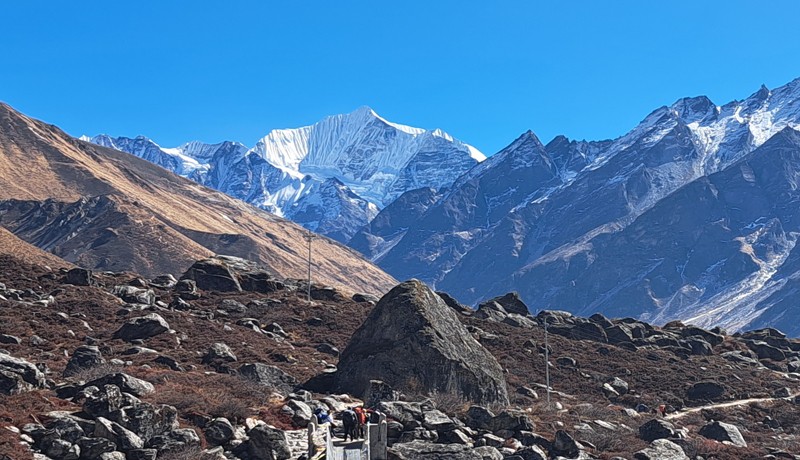
Mt. Gangchhenpo (6387m) View from Mondoo Village-Langtang
- Destination: Nepal
- Trip Difficulty: Moderate
- Group Size: Minimum 02
- Trip Type: Tea House Trek
- Best Season: Feb to June | Aug to Dece
- Trip Start & Ending: Kathmandu
- Accommodation: Tea House
- Transport: As Per Itinerary
- Max Elevation: 3,870m | 12696ft
- Food: Breakfast + Lunch + Dinner
- 360% Mountain view from Kyanjin Ri
- Trek into Langtang National Park with a local experienced trek guide & porter
- Explore indigenous villages & Tibetan cultural heritage
- Trek through the picturesque Langtang Valley
- Visit the sacred Kyanjin Gompa monastery
- Breathtaking views of Langtang Lirung, Ganesh Himal, and neighboring peaks
- Explore charming villages like Syabrubesi, Lama Hotel, and Ghoda Tabela
- Experience the warm hospitality of the mountain communities
- Witness rich biodiversity and rare flora and fauna
- Enjoy delicious local cuisine in comfortable teahouses
- Suitable for both novice and experienced trekkers
- Shorter duration trek for those with limited time
- Immerse yourself in the tranquil surroundings of the Langtang region
About Langtang Valley Trek
Embark on an exhilarating journey to the Langtang Valley with Nepal Spirit Adventure. Our 9-Day Langtang Valley Trek is a captivating adventure that takes you into the heart of the Langtang region, nestled in the majestic Himalayas of Nepal. The trek perfectly blends natural beauty, cultural encounters, and panoramic mountain views. As you trek through the picturesque landscapes, you will witness awe-inspiring snow-capped peaks, lush forests, serene rivers, and charming villages.
During the trip, you will explore the enchanting Langtang Valley, visit the sacred Kyanjin Gompa monastery, and be captivated by the breathtaking views of Langtang Lirung, Ganesh Himal, and other neighboring peaks. The trail will take you through quaint villages like Syabrubesi, Lama Hotel, and Ghoda Tabela, where you can interact with the warm-hearted locals and experience their way of life.
The Langtang Valley Trek is a perfect choice for both novice and experienced trekkers, offering a rewarding experience in a relatively shorter duration. It is an opportunity to rejuvenate your mind, body, and soul in the tranquil surroundings of the Langtang region. Join Nepal Spirit Adventure on this remarkable journey to the Langtang Valley and create memories that will last a lifetime. Let us be your trusted companion as you explore this spectacular region's natural wonders and cultural treasures.
The Langtang Valley Trek Map
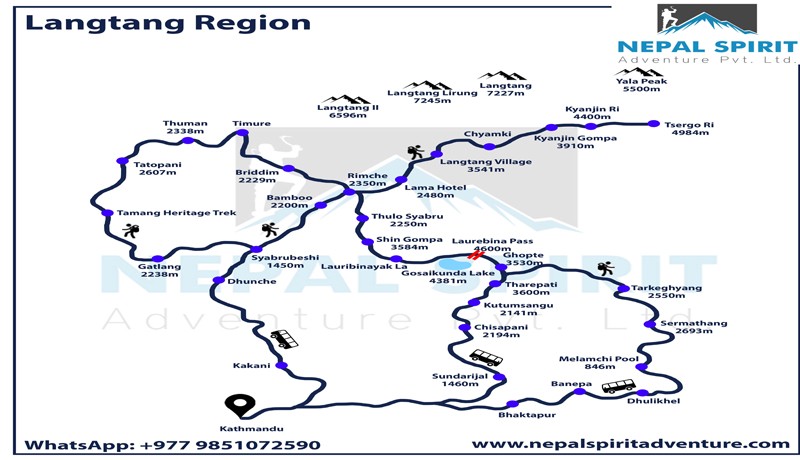
Getting there: Route Overview
The Langtang Valley Trek begins with a scenic drive from Kathmandu to Syabrubesi, a vibrant village at the gateway of the Langtang region. From Syabrubesi, we start our trek, following the trail along the Langtang Khola River. The route takes us through beautiful forests of rhododendrons, bamboo, and pine trees, offering glimpses of diverse wildlife and bird species. As we ascend, we pass through charming villages like Lama Hotel, Ghoda Tabela, and Langtang Village, where we can immerse ourselves in the local culture and interact with friendly people.
Continuing our trek, we reach Kyanjin Gompa, a sacred monastery situated at the base of Langtang Lirung. Here, we can explore the monastery, enjoy panoramic mountain views, and soak in the serene atmosphere. After spending time in Kyanjin Gompa, we retrace our steps back to Syabrubesi, enjoying the scenic landscapes, and bid farewell to the Langtang Valley. Finally, we drive back to Kathmandu, concluding our memorable Langtang Valley Trek.
If you have more time, this trek combines well with the nearby Tamang Heritage Trail , which adds an extra 4-6 days of trekking. There you will learn more about the ethnic Tamang people, who originally came from Tibet.
Alternatively, a trekking route is also available: trek over Gosainkunda Lake Pass back to Kathmandu instead of driving, Gosainkund is a beautiful blue high-altitude lake. It is preferable to trek to Gosainkunda on the return from Langtang rather than on the way, as it requires a fairly steep ascent, and by this point you will be better acclimatized, making the height of the lake (4,380 m.) less of a concern.
If trekking this route without a guide, be especially careful with the altitude—numerous people have been caught out by a dangerous error in a commonly available trekking map that incorrectly lists some altitudes. Double-check all altitudes before setting off.
Meals & Accommodation
The Langtang Valley had been very well set up with plenty of comfortable lodges. While the earthquake and landslide destroyed many in certain towns (most dramatically, in Langtang Village), plenty of other settlements were less affected, and good options are still plentiful.
The standard here is good, with warm blankets, fireplaces, comfortable beds, the occasional hot shower (for an extra fee), and a variety of food. Don’t forget to try the momos in this region, as they are larger and more pastry-like than those commonly found in the capital.
Langtang Trek Route Permits
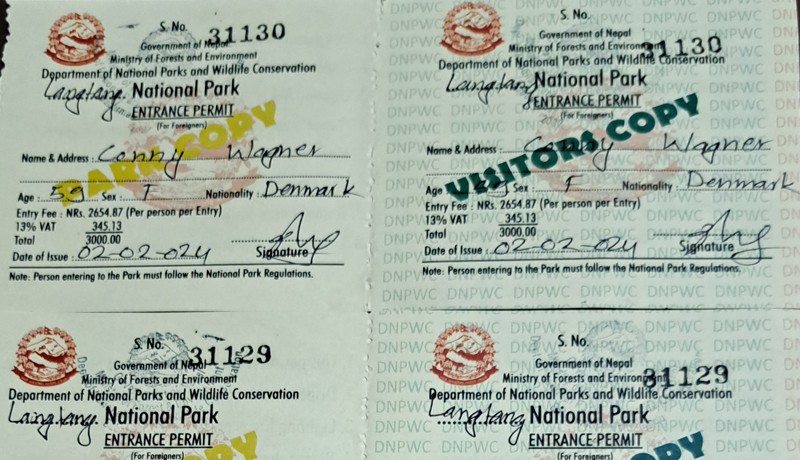
Some Useful Highlights of Langtang Valley Trek
- Easy access from Kathmandu to trek start and end.
- Trek with Langtang's local trek guide and porter.
- Explore the best National Park in Nepal.
- You can see the 260% Mountain View from Kyanjin and Tserku-Ri.
- Visit the ancient Buddhist Monastery, Gompa.
- Book your trek with a Nepal-based trek organizer.
- This trekking trail is best for novices and high-altitude trekkers.
- Trek near the Tibet and Nepal border through an indigenous trail
Langtang Valley Trek Itinerar best for every trekker
We at Nepal Spirit Adventure have designed one of the best day-to-day trek itineraries for every kind of trekker it is customized and can be changed according to travel needs. These day-to-day details of the trek itinerary provide clear information about daily walking hours, and elevation from one camp to another camp with high approximately from sea level and also indicate names of mountains, villages, rivers, and cultural heritage.
Day 1: Approximately 7 hours bus drive to Syabru Besi 1450m Day 2: Trek to Lama Hotel 2480m about 5 hour's walk Day 3: Trek from Lama Hotel to Langtang village 3541m approximately 5 hours Day 4: Approximately 4 hours trekking to Kyanjin Gompa 3910m Day 5: Climb to Tserku Ri 5033m also Kyanjin-Ri Day 6: Kyanjing Gompa to Lama Hotel 6-hour hike Day 7: Trekking from Lama Hotel to Syabru about 5 hour's walk Day 8: Drive to Kathmandu by bus 7 hour's ride
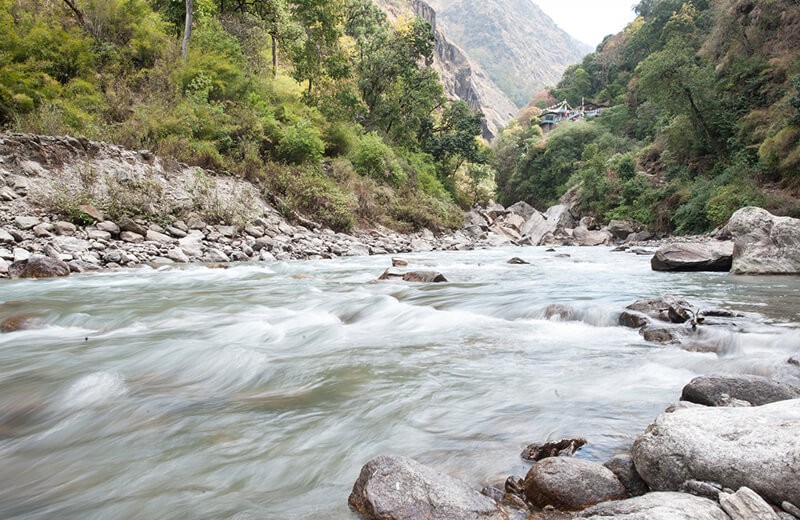
Day 1: Bus drive to Syabru Besi (1,450) 7 hrs
Starting this marvelous trip to Langtang Valley , taking an early morning scenic drive from Kathmandu to Syabru Besi Tamang village around the Rasuwa district of Langtang area, drive leads north passing interesting towns and farm villages, journey continues towards the cooler area above mid-hills leaving behind low land of rice terraces.
On reaching the entrance of Langtang National Park in Dhunche 1,965m, a major town of Langtang area and Rasuwa district , after a short stop drive continue further downhill to our first overnight stop at Syabru Besi village the remote part overnight in lodge.
- Meals: Lunch + Dinner
- Altitude: 1,450 m | 4,757 feet
Day 2: Trek from Syabru to Lama hotel (2,480m) 5hrs
The morning begins with our first-day walk with a climb for a few hours, then on a gradual path through terraced farms and scattered villages, the walk continues reaching a riverside where the trail from Thulo Syabru meets with a few teahouses and lodges after a short rest here walk uphill through serene forested areas of tall rhododendron, oaks, and pines trees entering a river gorge following Trisuli River upstream to Lama Hotel for an overnight stop.
- Meals: Breakfast + Lunch + Dinner
- Altitude: 2,480 m | 8,136 feet
Day 3: Trek to Langtang village (3,541m) 5hrs
After a pleasant morning with the sound of the river flowing, the walk leads into a river gorge within dense woodland passing a few small settlements and farms, the mid-day walk reaches a nice place at Ghoretabla , the name means "Horse-Stable" in Nepali.
After a nice break or lunch stop, an afternoon walk leads to our overnight destination at Langtang village with a few hours of good walk from Ghoretabela to Langtang village, This is a nice moderate size village with Bhotia and Tamang people, the natives of the Langtang region for hundreds of years.
The villages around were completely destroyed by the avalanche due to the huge earthquakes of 25th April & 12th May 2015 and slowly returning back to normal life.
- Meals: B L D
- Altitude: 3,541 m | 11,617 feet
Day 4: Trek to Kyanjin Gompa (3,910m) 4hrs
A short walk today to Kyanjin Gompa of a few hours as the walk enters a wide valley after leaving the tree lines and river gorge, The morning walk follows a short steep hill where tree lines decline for short bushes of azalea (bush rhododendron), juniper, and prickly Burberry bushes, finally walk enters a wide path around the glacial valley with splendid scenery of snowcapped mountains of Dorji Lakpa, Langtang Lirung, Tserko RI, Langshsisa, and Naya Kanga or Ganja la peak .
After a wonderful scenic walk ending at Kyanjin Gompa, a beautiful spot with a wide beautiful valley and close views of Langtang Lirung glacier , ice falls just next to the lodges of Kyanjin. Kyanjin with an old small monastery located on a rocky moraine ridge top, Langtang Valley has huge grazing areas for Yaks, and the place has a Yak Cheese Factory established three decades ago with Swiss assistance.
- Altitude: 3,910 m | 12,828 feet
Day 5: Hike to Tserku Ri (5,033m) 5hrs
A rest day at Kyanjin for people who would like to hike up to the hilltop at Tserku Ri 5,033m high. The climb to Tserku Ri leads to a steep climb offering glorious mountain views of the central Himalayan range.
Afternoon at leisure to enjoy rest with a panorama of Chimsedang Lekh, Kangjal Himal, a ridge of peaks bordering the valley to the south, Naya Kanga 5,844m, super views of great mountains dominating Langtang valley , includes Ganchenpo 6,387m , Dorje Lakpa 6,990m , Pemthang Karpo Ri 6,830m , Langtang Lirung 7,245m and across the northern boundary in Tibet rises the huge massive Shishapangma 8,046 m the last worlds 14th highest mountain.
Day 6: Trek from Kyanjing gompa to Lama hotel 6hrs
After an enjoyable time at Kyanjin Gompa around Langtang Valley, the morning leads to a long walk but much easier on a downhill path most of the way through Langtang village and Ghoretablea, following Langtang Khola enjoying walks back into the cool forest and then back at Lama Hotel for an overnight stop.
Day 7: Trek to Syabru bensi 5hrs
Today is our last day walk of this fabulous trip, leading downhill with a few ups on the same route heading back to Syabu Besi after crossing a suspension bridge, and then reaching the main road head and the village of Syabru Besi for the last overnight stop around Langtang and Rasuwa district.
Day 8: Drive to Kathmandu by bus 7hrs
The morning after last breakfast on the hills of the Langtang area, then taking an exciting drive which leads uphill to Dhunche town, and then on a winding downhill road reaching around warmer areas of Trisuli Bazaar and finally back at Kathmandu, after an awesome time on Langtang Valley trekking , after checking into respective hotels with afternoon free at leisure and join in for farewell group dinner in a nice restaurant around Thamel area overnight in Kathmandu at tourist standard guest house.
Note: Do you prefer to travel by private vehicle? Private vehicle is available as per your requirements just contact us
- Meals: Breakfast + Lunch
- Altitude: 1,315 m | 4,314 feet
Cost Details
What's included.
- Bus transportation from Kathmandu to Syabrubensi to Kathmandu.
- Langtang trek route permit (national park).
- TIMS field securities permit.
- Tea house (lodge-home-stay) along the trek.
- Three times a meals:- Breakfast + Lunch + Dinner.
- Trek equipment:- Sleeping bag, down jacket, duffel bag ( return after the trek).
- Experienced trek guide with his daily wages and insurance.
- One porter (2-trekkers) including his daily wages and insurance.
- General medical-first-aid kit.
What's not Included
- Nepal visa ( you can get after arrival in Nepal).
- Travel insurance & rescue operation.
- Personal trekking equipment.
- Tips for guide and porter.
- Personal drinks: Alcoholic/nonalcoholic drinks- Mineral water, Sprite, Coca-Cola, juice, tea, coffee, beer, whiskey, chocolate biscuits, and more.
- Hotel and food in Kathmandu.
Dates & Prices
Departure note.
Online trip departure dates are guaranteed for group tours, and private treks can be organized as per your chart with expertise for your tailor-made trips
- Group Departure Dates
- Send Enquiry
Useful Information
How we can get a nepal visa.
# You can get a Nepal visa upon arrival at Kathmandu Tribhuwan International Airport. If you are traveling to Nepal by overland service, you can get also a visa for every border between Nepal, India, and China. You can also apply for the online visa service before arriving in Nepal.
Nepal Visa Fees: On-arrival visa fees at entry points
It is our pleasure to provide you with Nepal visa fees which also don't know for all the travel. As per Nepal government rules following cost is for Nepal Visa.
- 15 Days – 30 USD
- 30 Days – 50 USD
- 90 Days – 125 USD
Why Kathmandu hotel is not included in the trek package?
# There are so many hotels available in Kathmandu in different categories, we want to leave Kathmandu hotels open for happy holidays and can book the hotel very easily into offers price. As per your request, we can book the Kathmandu hotel as per your budget.
What kind of health and fitness is required?
# Health and physical fitness is the most important part of travel and participating in trek and hiking. If you do not have previous trekking experience as required, you can start with a morning walking exercise or cycling for weeks or months before/after booking the trip with us.
The highest height gain on this trip is at 3,910m/12,828ft. above sea level, walking through local villages, farmlands, terraces, and the riverside as long as you have energy walking for 5- 6 hours a day, and if you are qualified for the trek but still require moderate health and fitness.
We strongly advise travelers to consult their medical doctor before traveling do a regular check-up and hand the report to us while booking a trip with us.
Can we charge our batteries on electricity?
# We can recharge your batteries and devices with electricity or solar power sources. In Nepal, 220 240 volts 50 MHZ (50 Cycles per Second) power is supplied. Just need to have a (two-pin or 3pin) plug adaptor in case of socket fitting, which you can buy in Kathmandu before the trip since the plugs in Nepal might be different. You might have to pay a small amount of fee/hour for using recharging facilities.
High Altitude Sickness
Altitude sickness often known as acute mountain sickness (A.M.S.) in general may occur when people ascend too quickly normally at altitudes of over 3,000 m. Most people will feel some effects of altitude, shortness of breath, and possibly light-headedness, which is fairly common.
Acute mountain sickness is very different and normally involves a severe headache, sickness, and loss of awareness. In almost every potential case there are enough warning signs to take appropriate action when symptoms of altitude sickness develop, please tell your trekking guide.
He will advise you to deal with your problem. Generally, exertion and dehydration contribute to altitude sickness. So drink at least 3-4 liters of water every day besides tea and coffee which act as diuretics.
Group Size & Departure
All our departure date is guaranteed as per the Langtang Valley Trek departure date. We organize any route of Nepal treks with a fixed departure basis or private trip, the minimum group size would be two and the maximum group size is ten or more on request.
We can also organize a private trip for a solo person with a single supplement cost. Otherwise, join our estimated group departure dates available online market or ask us for your personal suitable flexible dates, and we will open group dates on the same date.
When is the best time for Langtang valley trek?
Trekking in Nepal Himalayas, the main trek season is from September to June when daytime temperatures at most altitudes are generally comfortable for walking, the sky is very clear most of the time, and rain and snow are occasional occurrences.
In the daytime temperatures will vary from 15ºC to 35ºC in the capital city of Nepal- Kathmandu valley to around 15ºC at 3,600m and progressively lower the higher we go. Different seasons offer different advantages for trekking, climbing, and hiking.
Post Monsoon/Autumn: Mid-September to November. These months are the main trekking season in Nepal. Day temperatures in Kathmandu are approximately above 20ºC. Skies are usually clear and days on the trek are sunny and have mild clear mountain views. The night will be colder with temperatures dropping as low as minus 15ºC at the highest altitudes area.
Winter: Last week of December to the end of February. Despite the cooler conditions, this is an ideal time to trek in Nepal. Skies are usually very clear, especially in December and the mountain views are at their best.
Nights will be cold with temperatures down 10ºC to minus 15ºC at the highest altitudes but days are pleasant and sunny. The trekking trails are also much less busy at this time of year. In Kathmandu, maximum daytime temperatures are 23ºC.
Pre-Monsoon/Spring: March to May. During this period, both day and night temperatures will be warmer in general but often a haze will build up in the afternoons. It is very hot in the lowland and temperatures rise to 35ºC in Kathmandu.
Flowers bloom in this season and this is one of the reasons people choose to trek in the spring season. Snow can be expected on any departure, usually at higher altitudes.
Testimonials
Indigenous trek with the best views.
Found trekking was easy and the nearest route from Kathmandu was accessible by any type of vehicle, so there was no need to worry about the flight being canceled, thanks ‘Ram’ your recommendations were perfect, I enjoyed this trip very much in my life, had a great time with indigenous communities families and the best mountain views from Kanjin, I found people and their cultural were very similar with a Tibetan background, seen enough flora/fauna into Langtang National Park, trek guide Bikram & porter Shyam was friendly, every moment Bikram asked me how I’m enjoying the trek and food, he was men made my trip best!! 2024/02/11
Amazing trek Langtang Valley
Thanks, Ram and team of Nepal Spirit Adventure for organizing the best trip, it was an amazing adventure with a wonderful experience. The Mountain View and landscape were spectacular, and the kind indigenous people were friendly with a peaceful cultural heritage similar to the Tibetan ethnic, February is the best and quietest for a walk highly recommend this trail to others with Nepal Spirit Adventure no doubt they are a professional trek company.
Langtang valley trek with Nepal Spirit Adventure
Trekking Langtang trail with Nepal Spirit Adventure. www.Nepalspiritadventure.com
Not many travelers visit Nepal's Himalayan Mountains during the winter season. Esper and I did, and simultaneously avoided large groups of other travelers so that we could experience the quiet, wild mountain landscapes in all their unique beauty. In 3.5 days we went from 1,400 elevation to 3,850 meters on the Langtang trail. The round trip was almost 80 km, and we managed the descent in 2 days at 23 km and 17 km per day. We felt very lucky that the owner of Nepal Spirit Adventure, Ram Thapa Magar came along for the trip—a very nice experience. We are soon up where trees are rare and signs of 21st-century civilization are even rarer. There is no water but ice on the bathroom floor in the morning. The accommodation is Spartan but clean and adequate, and when it's freezing outside, it's freezing inside. Here there are no ringing phones, no humming TV, and Wi-Fi rarely works. The power is obtained from a small solar cell unit on the tin roof. An old car battery keeps the power going after sunset.
The toilet is the hygienic Squatting Pan Toilet, which is a challenge for tired knees. But I quickly mastered the technique of using the ladle in the right hand and washing with the left. And I am sending a thought to India and their total ban on eating with the left hand and all their hand washing with soap before eating. The icy water here in the mountains of Nepal gives an extra twist to the "toilet visit without toilet paper" method. However, what the small teahouses lack in modern facilities, they more than make up for, with sky-high views on all sides.
The 7,234-meter-high mountain, Langtang Lirung, with snow a few thousand meters up, towers high in front of us. We sit and cling our cold hands to a cup of scalding tea and look at the peaks that are only some kilometers away - and relatively close to Tibet and the Chinese border. You are never more than an hour's walk from a simmering kitchen, a warm hearth, and a bed for the night. Altogether it was 5 nights, and in Langtang Village, we also commemorate the earthquake in 2015 at the Memorial Monument. The highest place we stayed was Kyanjin Gompa at 3,870m. At the altitude of 3,500 meters, the air will only contain 66% of the oxygen, it does at sea level. So I had a rough night.
We were combined with the annoyances from burning Yak shit smoke on the fireplace last night and Altitude sickness. But our super guide Ram took good care of us. Suban, our porter carried my backpack with the bulk of our luggage. Interesting that we carry the weight on our hips where they carry the weight on the head and shoulder. They don't use the hip belt at all. The Nepalese cuisine. The typical local food consists of dal bhat, which is rice, lentils, and vegetables. Among the mountain people, it is also common to eat flat bread, roti, noodles, oatmeal, and yak meat. The people here have close cultural ties to Tibet, and the last day we are in the mountains, starts Losar, the Tibetan New Year. So we got breakfast supplemented with special cakes. Losar is also experienced on our last day in Kathmandu after a 7-hour bus ride back.
Experience Langtang Valley Trek
I went on a trek with Nepal Spirit Adventure. I had an awesome time. It was well organized by Ram. My guide was very professional. Although it was difficult at times, Nepal Spirit Adventure's guide was very supportive. The scenery was amazing - Praise God! I would thoroughly recommend Nepal Spirit Adventure - definitely good value for money. You will truly come away enriched for life. 2023/03/13
Wonderful easy short trek
It was a wonderful Langtang valley trek-short-easy and best view holiday, people and lodges were rebuilding well after the 2015 earthquake, still, they need more tourists for local life, the landscape was spectacular, rich flora- fauna, I found similar culture traditional like Tibet, I had best trek guide and porter bus journey was long but had a beautiful time with local people, thanks to Nepal Spirit Adventure for providing great service, your customer service was highly recommended for others, I think this trek must be one of the best papular trek-family holiday destinations in Nepal.
Amazing langtang valley trek
I had a fantastic trek with Nepal spirit adventure, they were a professional trek adventure company, guide tony was the best guide, porter Bhuwan friendly, mountain view was spectacular and had the best 360% panorama from Tserki RI and Kyangin, people were so kind very similar culture traditional Tibet as I was visited 2017 from the same company, I enjoyed much with Langtang national park, the trek was a suite and short can enjoy for all ages people, the bus journey was long but a good time with a local passenger. Everything was super organize thanks ram you are the best manager for trek arrangement and customer service was top can highly recommend this company to others. If you prefer the best and easy trek in Nepal make the Langtang valley trek. trave:2022/03/09
Unbelievable trek with Nepal Spirit Adventure!!
Brilliant time doing the Langtang Valley trek with my wife and 10-year-old daughter and it was unbelievable trek arrangement by Nepal Spirit Adventure Company, our guide was just amazing; he was so great helping us all. Especially our daughter's family-friendly he was so the knowledge and encouraging and so much fun throughout the whole trekking experience. Thanks so much to Ram and the team for all your advice before we come to Nepal. See you again in the future for another Nepal trekking trip.
It was the best thing I have ever done. I'm going to miss all the villages and our awesome guide Chin I'm going to try to bring my best friend up to. Hope can come back soo.

Main Navigation
- Vision-Mission-and Values
- Why Book with Us?
- Legal Documents
- Terms and Conditions
- Why Travel with Team Ram Adventure?
- Welcome To Nepal
- Tour del Nepal
Trekking in Nepal
Tour in nepal.
- Adventurous Activities
- Peak Climbing in Nepal
- Heli Tour in Nepal
Rafting in Nepal
Everest region trekking.
- Everest Base Camp Trek
- Everest Base Camp Trek with Return by Helicopter
- Gokyo Lake Trek
- Everest 3 High Pass Trek
- Everest Base Camp Trek via Salleri
- Gokyo Chola pass Everest base camp Treks
- 6 days Everest View Trek for Family
- Luxury Trek and Heli Tour in Everest Base Camp Trek
- Everest Panorama Point Treks
- Pike Peak Trekking
Annapurna Region Trekking
- Annapurna Base Camp trek
- Ghorepani Poon Hill Sunrise Trek
- 7 Days Annapurna Base Camp Trek
- Ghorepani Poon Hill Trek for Family 9 Days
- Mardi Himal Base camp trek in 8 Days
- Tilicho Lake and Thorung La Pass Trek
- Annapurna Circuit Trek
- Annapurna Sanctuary Trek
- Sikles Village Trek
- Mohare Danda Trek
- Jomsom Muktinath Trek -14 Days
- Dhampus Sarangkot Trek
- Khopra Trek
- Panchase Trekking
- Dhaulagiri Base Camp Trek 18 Days
- Nar Phu Valley Trek - 19 Days
- Khopra Ridge Trek
Langtang Region Trekking
- Langtang Valley and Gosaikunda Trek
- Tamang Heritage Trek
- Langtang, Gosainkunda Pass and Helambu Trek
- Gosainkunda Helambu Trek
- Ganja La Pass Trekking
- Langtang valley Trek
Manaslu Region Trekking
- Standard Manaslu Circuit Trek
- Short Manaslu Circuit Trek
- Manaslu Larke pass Trek
- Tsum valley Trek
Mustang Region Trekking
- Upper Mustang Treks
Dolpo Region Trekking
- Upper Dolpo Trek
- Lower Dolpo Trek
- Lower Dolpo Circuit Trek
Short Trek in Nepal
- Panchase Trek
- Chisapani Nagarkot Sunrise Trek!
- Chisapani Nagarkot Hike
- Culture Tour in Nepal Chitwan, Lumbini, Pokhara
- 2 Night 3 Days family trek to Dhampus Australian Camp!
- 2 Night 3 Days Dhampus Sarangkot Trek
- Kathmandu – Pokhara- Nagarkot Tour
- World Heritage Side Day Tour in Kathmandu valley
- 3-4 hours Mount Everest Heli Tour
- Luxury Trek with Heli Tour to Everest
- Everest Heli Tour
- Nagarkot Sunrise Tour
- Around the Kathmandu day Tour
- Kathmandu Pokhara Chitwan Tour
- Pokhara Tour, 2 Nights 3 Days
- Chandragiri Hill Cable Car Day tour
- Kathmandu Valley Day Tour
- Chitwan National Park Tour
Peak Climbing
- Chulu East Peak Climbing and trek to Thorong La-pass 5416m
- Lobuche Peak Climbing Via EBC
- Mera Peak Climbing
- Naya Kanga Peak Climbing
- Pising Peak Climbing
- Tent Peak Climbing
- Yala peak climbing
- Island Peak Climbing with Everest Base Camp Trek
- Ultra Flight in Nepal
- Kali Gandaki River Rafting
- Nepal Rafting Day Trip
- Nepal Trishuli River Rafting
- Nepal Paragliding
- Zip Flyer in Nepal
- Mountain Flight in Nepal
- Bunge jumping Nepal

Any Question? Email Us
Talk to an expert (Ram Giri)
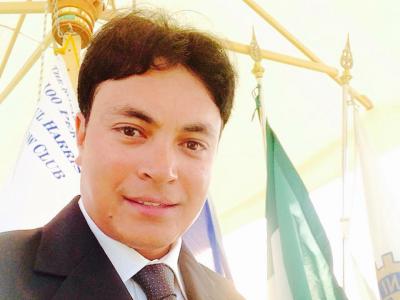
Langtang Valley: A Guide to Trek Permit Costs

4th Apr, 2024
- teamramadventure
Discovering the Langtang Valley: A Guide to Trek Permit Costs
The Langtang Valley Trek, a journey into the heart of the Himalayas, offers trekkers an unparalleled opportunity to explore the stunning landscapes and vibrant cultures of Nepal's Langtang region . Known as "the valley of glaciers," this trek provides a unique blend of natural beauty, from lush forests and tranquil lakes to majestic peaks and ancient monasteries. Before setting off on this adventure, it's essential to understand the permit requirements and costs associated with the Langtang Valley Trek. This friendly guide aims to demystify the Langtang Valley Trek permit cost, ensuring you're well-prepared for your Himalayan adventure.
Table of Contents
Langtang valley trek permit cost: what you need to know.
Unlike some of the more restricted areas in Nepal, the Langtang Valley Trek does not require a Restricted Area Permit. However, trekkers must still obtain a couple of essential permits:
1.Langtang National Park Entry Permit:
- The permit cost for international trekkers is NPR 3,000 per person (approximately $25 USD, depending on the current exchange rate).
- This fee contributes to the conservation efforts within the Langtang National Park, helping to preserve its unique ecosystem and support local communities.
2.TIMS (Trekkers' Information Management System) Card:
- For group trekkers, the TIMS card costs NPR 1,000 per person (about $8 USD).
- For individual trekkers, the TIMS card costs NPR 2,000 per person (about $16 USD).
- The TIMS card is essential for ensuring the safety and regulation of trekkers in Nepal's trekking regions.
These permits are crucial for both your safety and the sustainability of the trekking region. Now, let's address some frequently asked questions related to the Langtang Valley Trek permits.
5 FAQs About Langtang Valley Trek Permits
1. can i obtain the langtang valley trek permits on my own.
Yes, you can obtain both the Langtang National Park Entry Permit and the TIMS Card independently. These permits are available at the Nepal Tourism Board offices in Kathmandu and Pokhara, as well as at certain trailhead entry points.
2. What documents do I need for the permit application?
You'll need to provide a copy of your passport and two passport-sized photos for each permit application. Make sure to carry these items with you when applying for your permits.
3. Is there a discount for children or students on permit costs?
Children under 10 years old do not require a Langtang National Park Entry Permit. However, there are no discounts available for students on the TIMS card or the national park permit.
4. How long does it take to obtain the permits?
If you apply for your permits in Kathmandu or Pokhara, the process is quite fast and can usually be completed in a single day. Just make sure to visit during the office's opening hours.
5. Are the permits checked during the trek?
Yes, your permits will be checked at various checkpoints along the trek. It's essential to carry them with you at all times to avoid any complications.
Preparing for Your Langtang Valley Adventure
Understanding the Langtang Valley Trek permit cost is a vital step in planning your journey to this breathtaking region of Nepal. With your permits secured, you're all set to experience the awe-inspiring beauty of Langtang National Park, from its towering peaks to its warm-hearted communities. Remember, the permits not only facilitate a smooth trekking experience but also contribute to the conservation of this incredible region. So pack your spirit of adventure (and your permits), and get ready for an unforgettable trek in the Langtang Valley.
Recent Posts

Subscribe Our Newsletter
Get the latest news, offers and inspiring travel stories straight to your inbox.
WE ARE ASSOCIATED WITH

© 2011 - 2024 All rights reserved. Team Ram Adventure Pvt.Ltd. Developed By : Xenatech Nepal
We use cookies to improve user experience and analyze website traffic. By clicking Accept Cookies you agree to our website's Privacy Policy and Cookies Policy.
- Climbing & Expeditions
- Tailor made Getaways
- Outbound Holiday
- Ticketing and Reservation
LANGTANG VALLEY TREK
Shortest 8 days itinerary with a focus on comfort, langtang valley trek overview.
Langtang Region
Max. Altitude
Spring/Autumn
Accommodation
Lodges/Teahouses/ Tent
Langtang Valley Trek is a pleasant short trek that brings you to the alpine region of langtang valley on the northern side of Kathmandu. It is only a short distance, yet it passes through rhododendron, bamboo woods, roaring waterfalls and spectacular snow-capped mountains.
The Langtang valley and its surrounding region have been recognized as Nepal’s first Himalayan National Park. In 1971 AD, the Government of Nepal designated the Lantang region as a protected area.
The path leads you to an elevation of 3,800m, and if you want to go higher, you won’t want to miss witnessing the dawn from the Tserko Ri, which is located at 5,033m. The historic monastery of Kyanjin Gompa, located close to Tserko, continues this legacy.
This particular trip unveils you to the Tamangs and the Sherpas Buddhist culture. This journey offers fantastic views of Dorje Lakpa (6,990m), Langtang Ri (6,370m), and Langtang Lirung (7,245m).
Langtang Valley Trek Route
The trail begins in the small town of Syabru Besi. You’ll go through beautiful woodlands to the high alpine meadows and yak pastures around Kyangjin Gompa (a Buddhist monastery). After an optional day walk to the summit of Kyangjin Ri (peak), where the 360-degree views of the Himalayan ranges are stunning, you return down the valley and drive back to Kathmandu.
Trip Highlights
- See snow-capped peaks including Langtang Lirung (7,245m), Langtang Ri (6,370m), Dorje Lakpa (6,990m), Langshisha Ri (6,427m) and Ganchempo (6,387m), which is also called the ‘fluted peak’ for this beautiful symmetrical lines.
- Stay in the charming village of Kyanjin Gompa (3,860m) with its yak cheese factory, one of its kind in the himalayas. If you want to go higher, then day hikes to Kyanjin Ri (4773m) or Tserko Ri (4984m) can be done.
- Get closer to the Tibetan Buddhist culture and the lifestyle of the people in the region and at the end of the journey.
- Enjoy panoramic views across large open valleys while helping people rebuild their lives and livelihoods following the earthquake.
- Take blessings at ancient Buddhist temples like Kyanjing Gompa and Langtang Gompa
- Passing through vibrant villages, jungles and rhododendron forests with the stunning Annapurna range always in sight
- Get first-hand experience of Tibetan Buddhist culture at monasteries and shrines along the way, or by engaging with the local Tamang, Sherpa, or Tibetan people.
- Taste some must-try local dishes such as yak cheese, Tibetan tea (black tea with yak butter) and sea buckthorn juice, to name a few.
- Support local families who had to rebuild their lives and livelihoods after the 2015 earthquake, which hugely impacted Langtang village.
Daily Itinerary
Day 1. drive kathmandu → syabru besi (1,460m) – approx. 7 hours, day 2. trek syabru besi → lama hotel (2,470m) – approx. 8 hours, day 3. trek lama hotel → langtang (3,400m) – approx. 8 hours, day 4. trek langtang → kyanjin (3,870m) – approx. 4 hours, day 5. rest or exploration day, day 6. turn back to lama hotel – approx. 6 hours, day 7. lama hotel → syabru besi – approx. 6 hours, day 8. drive back to kathmandu – approx. 7 hours, food and accommodation at langtang valley trek.
The valley offers comfortable lodging and traditional Nepalese cuisine despite its remote location. In terms of lodging, the Langtang area offers standard accommodation with twin-sharing beds. Each tea house includes a pleasant dining area as well as comfy chambers. During the high season, reservations must be made a week in advance.
Langtang Valley Trek Permit
A TIMS card (US$10) and a Langtang National Park pass (US$34) are required. At Rolwaling Trek , our team will plan for these beforehand. You must obtain your TIMS permission in Kathmandu and your Langtang National Park permit in Dunche if you are organizing the trek on your own.
Best Season For Langtang Valley Trek
Because of the moderate temperature and spectacular mountain scenery, autumn and spring are the best weather for Langtang Valley Trek. Even though the city’s average temperature is just 5 °C, the nights may feel relaxed. In the spring, the average daily temperature in the town is around 15 °C. You may be able to travel in shirts and shorts in lower towns throughout these seasons, but in the evenings and at higher elevations, you will most certainly require a jacket or a fleece.
Langtang Valley Trek Difficulty
Langtang Trekking is a well-known moderate-level hike. This hike is suitable for trekkers with basic physical and mental fitness.
The main challenge is the great altitude and the possibility of obtaining AMS (Altitude Mountain Sickness). Kyanjin Ri, at 4773 meters, is the highest peak of the Langtang Trek. The quantity of oxygen begins to decrease at this height. As you ascend in height, you may get altitude sickness.
To prevent altitude sickness and difficulties throughout the trek, you must be well prepared. Plan various workouts at least a month in advance. While on the walk, be cautious when rising uphill. Avoid overstressing your body by walking slowly. Keep your body hydrated by drinking plenty of water.
Our Travel Expert
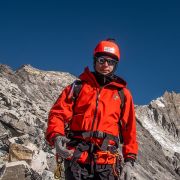
Udaya Gartaula
+9779801026642
Experience during the Trip
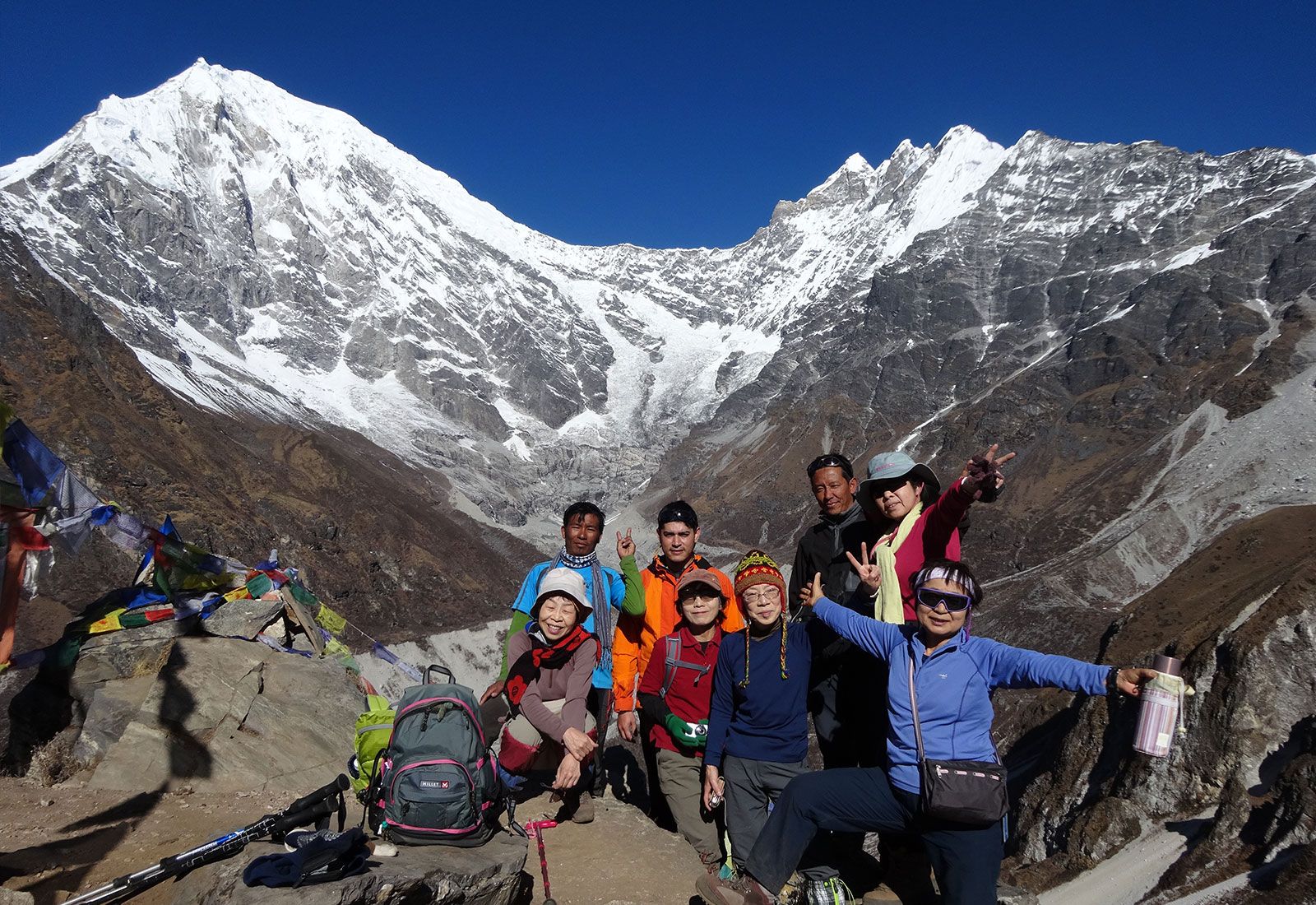
Best Langtang Region Expedition Packages
The Langtang region is famous for some of the best expeditions to the snow-capped peaks that you can view during the Langtang valley trek. Check out some of the expeditions at Langtang region .
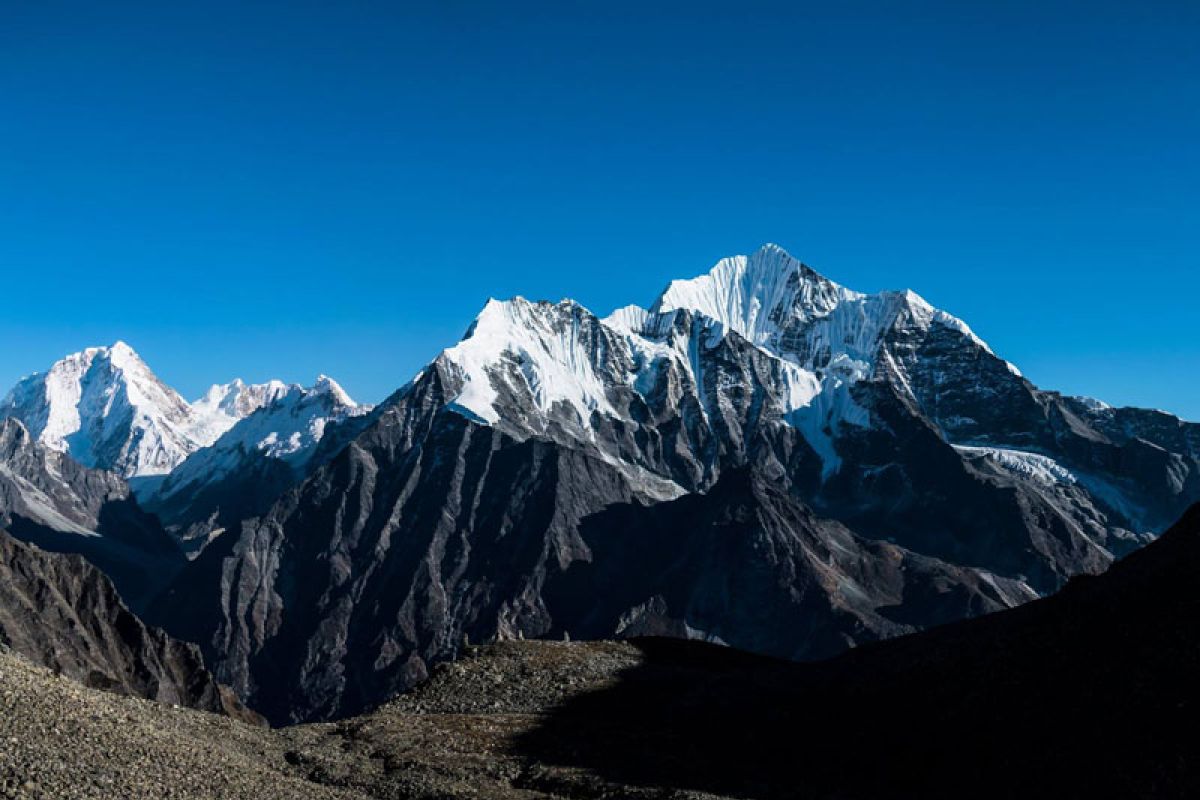
Naya Kanga Peak
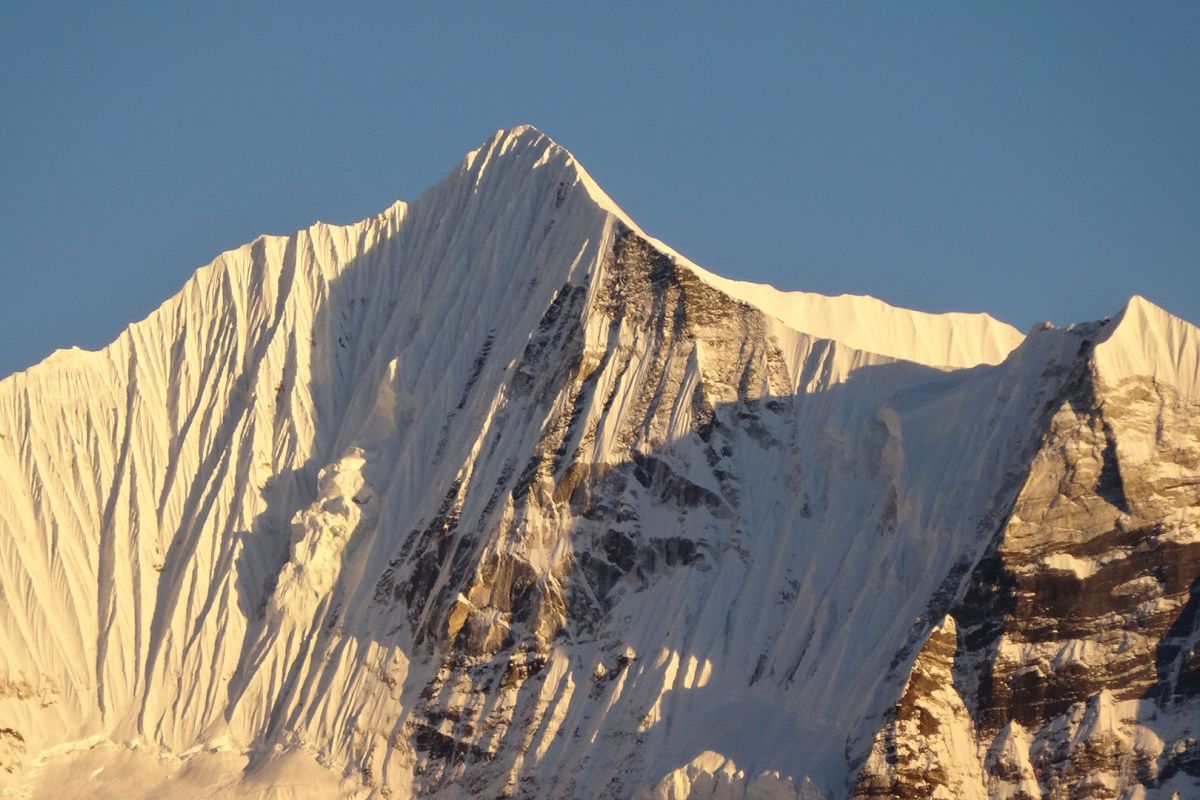
Gangchempo Peak Climbing

Langshisha Ri Peak
Frequently asked questions, where does the langtang valley trek start, how long is the langtang valley trek.
The Langtang Region, on the other hand, has numerous popular treks around the valley that relate to the trekking day depending on the duration of the trek. The Langtang trek from Kathmandu to Kathmandu might take you 6 to 8 days to accomplish. With the Rolwaling trek, the Langtang valley trek is 8 days long.
How hard is the Langtang valley trek?
What is the best time of year to trek langtang valley, how do i prepare for langtang trek, what kinds of accommodation are available during the langtang valley trek, do i require premium gear for the langtang trek, cancellations & refunds.
At Rolwaling Trek, we want our clients to have the best possible experience. That’s why we don’t withhold deposits or have a fixed cancellation policy. We understand that sometimes life puts you in unexpected situations, so if you have to cancel or postpone a trip, there’s no need to worry.
If you need to change plans, please get in touch with us as soon as you can, and we will make the necessary arrangements to amend or cancel your trip. You can contact us at: +977 – 9801026642 .
- Trekking routes can be customised to suit your personal interests, abilities and time constraints.
- If an area does not have good quality accommodation options, we can provide very comfortable camping-style accommodation for the duration of your journey.
- Rolwaling also has a team of cooks who specialise in making Japanese cuisine, using authentic ingredients from Japan.
- A lot of the fresh produce used in our dishes is sourced locally from growers in the trekking region.
Recommended Trekking Packages in Nepal

Everest Base Camp Trek

Kanchanjunga Base Camp Trek

Annapurna Trek (Clockwise Poonhill)

Upper Mustang Trek

Rara Lake Trek

Annapurna Circuit Trek
Contact our travel expert.
We pay special attention to your requirements and craft personalized getaways which showcases unique cultural, adventure and natural experiences of Nepal. We craft bespoke journeys for your expeditions & treks and also ensure you can experience the best that Nepal has to offer even for your shorter trips.
- Quick Inquiry : +9779841480794

- Trekking info »
Langtang Valley Trek Permits

Table of Contents
Introduction.
Obtaining the necessary permits for the Langtang Valley Trek is a crucial step in your preparation. Permits ensure the safety and management of trekkers and contribute to the conservation of the region. This article provides a comprehensive guide to the permits required for the Langtang Valley Trek and how to obtain them.
Required Permits
Two main permits are required for the Langtang Valley Trek: the Trekkers’ Information Management System (TIMS) card and the Langtang National Park Entry Permit.
- TIMS Card: The TIMS card is mandatory for all trekkers in Nepal. It helps in maintaining a record of trekkers for safety purposes and provides support in case of emergencies. There are two types of TIMS cards: the Green TIMS card for independent trekkers and the Blue TIMS card for trekkers joining a group through a registered trekking agency.
- Cost: USD 20 per person for the Green TIMS card, and USD 10 per person for the Blue TIMS card.
- Where to Get: TIMS cards can be obtained from the Nepal Tourism Board offices in Kathmandu and Pokhara. If you are trekking with a guide or through an agency, they will assist you in obtaining the TIMS card.
- Langtang National Park Entry Permit: This permit is required to enter Langtang National Park, which protects the diverse flora, fauna, and cultural heritage of the region.
- Cost: USD 30 per person.
- Where to Get: The Langtang National Park Entry Permit can be obtained from the Nepal Tourism Board offices in Kathmandu and Pokhara or at the entry points to the park, such as in Dhunche or Syabrubesi.
How to Obtain Permits
To obtain the necessary permits for the Langtang Valley Trek, you will need to visit the Nepal Tourism Board office in Kathmandu or Pokhara. The process is straightforward, and the staff is helpful in guiding you through the steps. Here’s what you need to do:
- Visit the Office: Go to the Nepal Tourism Board office during working hours (9:00 AM to 5:00 PM, Monday to Friday). The offices are located in Bhrikutimandap, Kathmandu, and Lakeside, Pokhara.
- Fill Out Forms: Fill out the required forms for the TIMS card and the Langtang National Park Entry Permit. You will need to provide personal information, trekking details, and emergency contact information.
- Provide Documents: Submit a copy of your passport and two passport-sized photos. It’s advisable to carry extra photos for other administrative purposes during your trip.
- Pay the Fees: Pay the permit fees in cash. It’s recommended to have the exact amount in Nepali Rupees to facilitate the process.
- Receive Permits: Once the forms are filled out and the fees are paid, you will receive your TIMS card and Langtang National Park Entry Permit. Keep these permits with you at all times during the trek, as you may need to present them at various checkpoints.
Additional Tips
- Check Validity: Ensure that your permits are valid for the duration of your trek. If you plan to extend your trek, you may need to renew your permits.
- Permits in Syabrubesi: If you were unable to obtain your permits in Kathmandu or Pokhara, you can also get them at the entry points in Syabrubesi or Dhunche. However, it’s recommended to obtain them in advance to avoid delays.
Obtaining the necessary permits is a crucial part of preparing for the Langtang Valley Trek . The TIMS card and Langtang National Park Entry Permit are essential for ensuring your safety and contributing to the conservation of the region. By following the steps outlined in this guide, you can easily obtain the required permits and ensure a smooth start to your trekking adventure. Proper preparation and adherence to regulations will enhance your overall experience and help preserve the beauty and cultural heritage of the Langtang Valley.
We Are Associated With
Find & Follow Us on
© 2011 - 2024 All rights reserved. Life Dream Adventure. Developed By: Xenatech Nepal .
Notice. This site uses cookies to optimize your user experience. By using this site, you are consenting to our use of these cookies. Check out our Privacy Policy and our Cookies Policy.

LANGTANG VALLEY TREK GUIDE

LANGTANG VALLEY TREK

Pin Tweet Share WhatsApp
THE ESSENTIAL GUIDE
In this guide we cover everything you need to know about the Langtang Valley Trek in Nepal. This includes a suggested itinerary, a route map, and a GPX download, as well as practical information about accommodation, costs, what to pack, independent vs. guided treks, and more. Along with this written guide, we also share ‘silent hiking’ films of the trail and a video guide to trekking the Langtang Valley. For detailed trail notes, check out our Langtang Valley Trekking Route Guide .
With lush forests and snow-capped peaks, the chance to reach nearly 5000 m without crossing a high mountain pass, and an opportunity to experience the culture of the Tibetan-speaking Tamang people, there are many things that appeal about a Langtang Valley trek. What’s more, the area is relatively close to Kathmandu, the transport options make it easily accessible, and the trek itself is not too long. Read on to discover more and start planning your own Langtang Valley trek.
TREK OVERVIEW LANGTANG TREK VIDEOS MAP & GPX DOWNLOAD ELEVATION PROFILE & 3D MAP SUGGESTED LANGTANG ITINERARY TREKKING SEASONS GETTING TO LANGTANG VALLEY LANGTANG VALLEY PERMITS TREKKING INDEPENDENTLY TREKKING WITH A GUIDE RECOMMENDED TREK AGENCY ACCOMMODATION ON THE TREK FOOD ON THE LANGTANG TREK SAFE DRINKING WATER WIFI/PHONE SIGNAL/CHARGING LANGTANG TREK COST & BUDGET WHAT TO PACK FOR THE TREK ALTITUDE AWARENESS TRAVEL INSURANCE ADD-ON TREKS GETTING TO NEPAL NEPAL TOURIST VISAS WHERE TO STAY IN KATHMANDU MAPS, GUIDEBOOKS, & APPS
TREK OVERVIEW LANGTANG TREK VIDEOS MAP & GPX DOWNLOAD ELEVATION PROFILE & 3D MAP SUGGESTED ITINERARY TREKKING SEASONS GETTING TO LANGTANG VALLEY LANGTANG VALLEY PERMITS TREKKING INDEPENDENTLY TREKKING WITH A GUIDE RECOMMENDED TREK AGENCY ACCOMMODATION ON THE TREK FOOD ON THE LANGTANG TREK SAFE DRINKING WATER WIFI/PHONE/CHARGING LANGTANG TREK COST WHAT TO PACK FOR THE TREK ALTITUDE AWARENESS TRAVEL INSURANCE ADD-ON TREKS GETTING TO NEPAL NEPAL TOURIST VISAS WHERE TO STAY IN KATHMANDU MAPS, GUIDEBOOKS, & APPS
*Some of the links in this post are affiliate links – if you purchase a product or service via these links, we may earn a small commission at no extra cost to you . This helps offset the cost of running this blog and keeps us travelling so that we can continue to produce great content for you. We greatly appreciate your support!*
LANGTANG VALLEY TREK OVERVIEW
- DISTANCE | 60 – 75 km (depending on day hikes)
- DURATION | 6 – 8 days (+ 2 days travel to/from Kathmandu)
- START/END | Syabrubesi (accessible by public bus (8+ hours) or private jeep (6 – 7 hours) from Kathmandu)
- PERMITS REQUIRED | Langtang National Park Fee 3000 NPR (payable at checkpoint near start of trek), TIMS NOT Required
- TREKKING SEASON | Best Seasons: Mid-March to April, October to Mid-November; Shoulder Seasons: Early-March, May, September, Mid-November to December; Avoid: June to August, January to February
- TREK DIFFICULTY | Moderate
- ELEVATION GAIN/LOSS | +/- 3420 metres (to Kyanjin Gompa only), +/- 5300 metres (including day hikes)
- MAX ALTITUDE | 3865 m at Kyanjin Gompa, 4965 m if trekking to Tsergo Ri
- GUIDE MANDATORY | Debatable: From April 1st 2023, trekking guides became mandatory for all foreign trekkers in Nepal, however the rule isn’t necessarily being enforced on the ground
- ACCOMMODATION | Teahouses/Guesthouses in villages along the trail
- TREK COST | $ 24 – 100 USD per person, per day (budget independent trekker to fully inclusive package)
- ADD-ON TREKS | Gosainkunda , Tamang Heritage Trail, climbing Yala Peak
- RECOMMENDED TREKKING AGENCY | Himalayan Masters , Quote HOGG5 for 5% discount
DISTANCE 60 -75 km
DURATION 6 – 8 days (+ 2 days travel to/from Kathmandu)
START/END Syabrubesi (accessible by public bus (8+ hours) or private jeep (6 – 7 hours) from Kathmandu)
PERMITS REQUIRED Langtang National Park Fee 3000 NPR (payable at checkpoint near start of trek), TIMS NOT Required
TREKKING SEASON Best Seasons Mid-March to April October to Mid-November Shoulder Seasons Early-March, May, September Mid-November to December Avoid June to August January to February
TREK DIFFICULTY Moderate
ELEVATION GAIN/LOSS +/- 3420 metres (to Kyanjin Gompa only) +/- 5300 metres (including day hikes)
MAX ALTITUDE 3880 m at Kyanjin Gompa 4965 m if trekking to Tsergo Ri
GUIDE MANDATORY Debatable: From April 1st 2023, trekking guides became mandatory for all foreign trekkers in Nepal, however the rule isn’t necessarily being enforced on the ground
ACCOMMODATION Teahouses/Guesthouses in villages along the trail
TREK COST $24 – 100 USD per person, per day (budget independent trekker to fully inclusive package)
ADD-ON TREKS Gosainkunda , Tamang Heritage Trail, climbing Yala Peak
OUR RECOMMENDED TREKKING AGENCY Himalayan Masters , Quote HOGG5 for 5% discount
LANGTANG VALLEY FILM & VIDEO GUIDE
Our ambient ‘silent hiking’ style films are perfect for getting a sense of the Langtang Valley trek. Our indepth video guide works well as a companion piece to this written guide and includes much more discussion of our own experience on the trek.
Watch the behind the scenes version of our Langtang Valley trek on Instagram stories
Watch the behind the scenes version of our langtang valley trek on instagram stories .
Langtang Valley Trek Stories
LANGTANG VALLEY TREK MAP & GPX DOWNLOAD
Langtang valley trek //.
MAP & GPX DOWNLOAD
We have created a detailed Langtang Valley trekking map to accompany this guide. The trekking route between Syabrubesi and Kyanjin Gompa, the day hiking routes to Kyanjin Ri and Tsergo Ri, and the stats for each section are all marked on the map. Villages and tea shops are also marked, as well as key sights and practical info such as checkpoints. Guesthouses as per our own trek itinerary are marked, including prices and services, phone numbers, and a copy of the menu. Photos are included with almost every pin. You can use the digital map online, or download it for offline use with a mapping app such as Organic Maps, Maps.me or Gaia GPS. This is very helpful for navigation assistance on the trail and allows you to quickly pinpoint key places and services along the way and calculate distance and elevation differences between destinations. Note that while we’ve tried to be as accurate as possible when recording and mapping the route, changes on the ground are inevitable, and this map should not be solely relied upon for navigation.
LANGTANG VALLEY TREK ELEVATION PROFILE
ELEVATION PROFILE
The image below shows the elevation profile of our own route for the Langtang Valley trek, going via Sherpagaon on the way up, including the day hikes to Kyanjin Ri (4586 m) and Tsergo Ri (4965 m), and ending at the Gosainkunda turn-off on the way down. Elevation is displayed in metres and distance in kilometres.

3D ROUTE MAP
Watch our 3D relief map video of the route to visualise the geography of the Langtang Valley and get a sense of the trek.
LANGTANG VALLEY TREK ITINERARY
In the table below, we have outlined what we feel is an ideal Langtang Valley trek itinerary. This is an 8 day trek starting and ending in Syabrubesi, plus 2 days travel to and from Kathmandu.
Many Langtang Valley trek itineraries offered by trekking agencies, or outlined in other blog posts online, suggest a 6 day trek plus 2 travel days. Although that is certainly possible, when you consider factors like altitude and acclimatisation, day hikes, and alternative routes, we feel an 8 day trekking itinerary is better and will outline the reasons for this below.
The times given for each day are an average and don’t include time for lunch or other significant stops, such as tea/coffee breaks. You may of course be faster or slower than these times, depending on a variety of factors such as your pace, desire to take photos, and interest in things along the way.
If viewing on a mobile device or tablet, scroll to the right to see the full table or flip your screen to landscape mode.
*You could stop earlier at Ghodatabela (~ 3000 m) although the accommodation is more basic, or continue to Langtang if you are already acclimatised (which will save you a day)
** You could continue 30 minutes to Rimche for better views
ALTITUDE AND ACCLIMATISATION
Most Langtang Valley trek itineraries suggest trekking from Syabrubesi to Lama Hotel on Day 1 (1500 m to 2485 m), from Lama Hotel to Langtang or Mundu on Day 2 (2485 m to 3450 m), and then from Langtang or Mundu to Kyanjin Gompa on Day 3 (3450 m to 3865 m). From Kyanjin Gompa, two of the absolute highlights of the Langtang Valley trek are the day hikes to Kyanjin Ri (4586 m) and Tsergo Ri (4965 m) on Days 4 and 5.
If you are already acclimatised (ie. you have been at altitudes of 3500 m + within the previous week), then we don’t see a problem with this itinerary. However, if you are not yet acclimatised, we feel the speed of ascent to 3500 m and above puts hikers at an unnecessary risk of experiencing adverse reactions to altitude.

Ascending too quickly to Langtang village (3450 m) and above can put trekkers at risk of experiencing symptoms of altitude sickness

Everybody reacts to altitude differently. There’s every chance that you may feel fine by the time you reach Langtang or Kyanjin Gompa, but there’s also a chance that you may be suffering from headaches, nausea, fatigue, loss of appetite, or other symptoms of AMS (Acute Mountain Sickness) because the speed of ascent has been too fast for your body to properly acclimatise. At best, if your symptoms are relatively mild, you may feel pretty miserable and too unwell to tackle the day hikes to Kyanjin Ri and/or Tsergo Ri, missing out on some of the best views and experiences on the Langtang Valley trek. And at worst, you could put yourself at risk of developing HAPE or HACE, both life-threatening conditions.
Therefore, we feel that it is more sensible to follow medical advice and aim to sleep no more than 300 – 500 metres higher than the previous day when at altitudes of 2500 m and above . As such, our suggested itinerary includes a night at Thangshyap (3190 m) on Day 2 , before ascending to Langtang at 3450 m on Day 3, and finally Kyangjin Gompa at 3865 m on Day 4. This is the itinerary we followed and I (Kim) suffered almost no symptoms of AMS during the trek, having suffered from AMS at similar altitudes in the past when ascending more rapidly.
DAY HIKES TO KYANJIN RI AND TSERGO RI
Many Langtang Valley trek itineraries include a 2 night stay at Kyanjin Gompa , however we would recommend staying 3 nights instead. This gives you plenty of time to rest and further acclimatise on the day you arrive at Kyanjin Gompa, then do the day hike to Kyanjin Ri the following morning, and the day hike to Tsergo Ri the morning after that.
These two day hikes are absolute highlights of the trek. By planning morning ascents you’ll give yourself the best possibility of clear views, and by spreading them out over two days you will be less rushed and better acclimatised.

Climbing Tsergo Ri in the morning gives you the best chance of having clear mountain views

ALTERNATIVE ROUTES ON THE WAY UP & DOWN THE LANGTANG VALLEY
The Langtang Valley trek is largely an up and down the valley route, following the same trail from Syabrubesi to Kyanjin Gompa and back again. Between Rimche and Kyanjin Gompa there is no way to avoid this, however between Syabrubesi and Rimche there is an option to take an alternative route on the way up and/or down , which we think is far more interesting than simply repeating the same trail.
Most Langtang Valley trek itineraries suggest hiking from Syabrubesi to Lama Hotel on Day 1, and repeating this route in reverse on Day 6. The route follows the Langtang Khola (River), going via Bamboo. However, for a change of scenery and chance to visit more local villages in the region, we’d suggest taking an alternative route from Syabrubesi to Sherpagaon on Day 1.
Instead of climbing gradually up the valley and ending the day with a steep climb to Rimche or Lama Hotel, you’ll start the day with a steep climb up through forest to Khangjim and Surka. From here you’ll follow a gently undulating trail for the rest of the day, working your way around the hillside through attractive forest sections and across open areas with fantastic views. Sherpagaon itself is a lovely village with a mix of guesthouses and local homes, and the views from here are great. The following morning it takes less than 1.5 hours to trek to Rimche (again with fantastic views), where you’ll rejoin the classic Langtang Valley trekking route.

High above the Langtang Valley floor, Sherpagaon (2563 m) has impressive views of the surrounding mountains

Sherpagaon (2563 m) has impressive views of the surrounding mountains from its position high above the Langtang Valley floor
If for whatever reason you would prefer not to trek the alternative route to Sherpagaon on Day 1, we would at least suggest overnighting at Rimche instead of Lama Hotel. The views from Rimche are much better than at Lama Hotel (a riverside location tucked into a narrow valley), plus it’s more interesting to stay at different places on the way up and down the valley.
If combining the Langtang Valley trek with the Tamang Heritage Trail, note that you’ll trek via Sherpagaon anyway.
OUR RECOMMENDED TREKKING AGENCY
We partnered with Himalayan Masters for our Langtang Valley, Gosainkunda, and Everest Three Passes treks, and found them to be professional and committed to a high level of service
To enquire about booking your own trek, get in touch via email at [email protected] and mention the code HOGG5 to get a 5% discount off the cost of your trip
LANGTANG VALLEY TREKKING SEASON
TREKKING SEASON
Like many treks in Nepal , the peak seasons for trekking in the Langtang Valley are Mid-March to April and October to Mid-November . While nothing is guaranteed, as weather patterns are becoming increasingly unpredictable in Nepal and across the world, these months typically offer the best chance of clear skies mixed with warmer temperatures. In autumn, expect less wind and higher temperatures, while in late March and April, blooming rhododendrons and other spring flowers are a beautiful sight at lower elevations.

Clear, sunrise mountain views in late March from the rooftop terrace of the Holyland Guesthouse in Kyanjin Gompa (3865 m)

The shoulder seasons of Early-March and Mid-November to December can be quieter and colder, typically with clear weather, especially in December. In late May and early September there is a higher chance of early or lingering monsoon rains and cloudy skies.
The summer months of June, July, and August coincide with the monsoon season . Trekking during this period means lots of walking in rain, poor visibility with clouds obscuring the surrounding mountains, muddy trails, and leeches. The landscape is lush and green though, and some rare mushrooms and colourful wildflowers can be spotted on the hillsides. Many guesthouses close during this time, although there is usually at least one open in each settlement.
The winter months of January and February are considered too cold by most to trek, and as is the case during the summer monsoon, many guesthouses close for these two months. If you don’t mind cold mornings and evenings, December is a good option for clear skies and sunny days.
HOW TO GET TO/FROM THE LANGTANG VALLEY TREK TRAILHEAD
HOW TO GET TO AND FROM THE TRAILHEAD
Syabrubesi is the trailhead for the Langtang Valley trek , a small town approximately 115 km north of Kathmandu. You can get there by public bus or private jeep and the journey takes around 5.5 – 9 hours depending on your mode of transport. The road is narrow and twisting at points with occasional steep drop-offs, and includes some bumpy sections on rough non-tarmac roads.
BUS FROM KATHMANDU TO SYABRUBESI
Buses from Kathmandu to Syabrubesi depart from Machhapokhari (near the New Bus Park / Gongabu Bus Park) between 6am – 8am every day. They depart from Syabrubesi to Kathmandu between approximately 6am – 7am. Tickets cost 1000 NPR per person, one way. The journey takes around 8 – 9 hours, although it’s possible it can take longer depending on road conditions that day. In Kathmandu, you can arrive early and purchase a ticket on the same day, or head to the bus stop the day before to buy your ticket. In Syabrubesi, you can ask your guesthouse owner to book your seat for the following morning.

A typical bus plying the route between Kathmandu and Syabrubesi

The bus will stop a couple of times during the journey for food and a toilet break. It’s a pretty uncomfortable trip, with no air conditioning, dust and fumes blowing in the windows, and often music blasting through the speakers for hours on end. Drivers can tear along the road at high speed, which can be potentially dangerous and a little scary.
You can get a taxi between Thamel (or elsewhere in Kathmandu) and Machhapokhari for about 500 NPR. If you hail a taxi on the street, be sure to agree the price with your taxi driver at the start. You can also use a taxi app such as Pathao ( iOS / Android ).
PRIVATE JEEP FROM KATHMANDU TO SYABRUBESI
A private jeep from Kathmandu to Syabrubesi costs approximately $170 one way. It can seat up to 7 people plus a guide and driver (with your bags strapped to the roof). The price can be shared between all passengers. The route is the same as by bus, but the journey time is usually significantly less at around 5.5 – 7 hours, depending on the road conditions that day. You will likely stop for lunch and a toilet break along the way, and you have more flexibility to stop for photos, etc, whenever you like.

A private tourist jeep enroute to Syabrubesi
If you are organising your Langtang Valley trek via a trekking agency, they will be able to organise a private jeep for you. Otherwise, you can ask at your hotel or at local travel agencies. A private jeep will pick you up at your accommodation, offering door-to-door service.
It is much more comfortable to travel by private jeep than bus, and safer too.
SEE MORE FROM NEPAL

Everest Base Camp Trek: The Essential Guide

Everest Three Passes Trekking Route Guide

Everest Three Passes Trek: The Essential Guide

Gosainkunda Helambu Trekking Route Guide

Gosainkunda Trek: The Essential Guide

Langtang Valley Trekking Route Guide

Langtang Valley Trek: The Essential Guide

What To Pack For Trekking In Nepal

Upper Mustang Trek: The Essential Guide

Upper Mustang Trek Itinerary: A Day By Day Account

Annapurna Circuit Trek: The Essential Guide

Annapurna Circuit Trek Itinerary: A Day By Day Account

Manaslu Circuit Trek: The Essential Guide

Manaslu Circuit Trek Itinerary: A Day By Day Account
Langtang valley trek permits and fees.
TREKKING PERMITS & FEES
To trek in the Langtang Valley you will need to pay the Langtang National Park entrance fee , which is 3000 NPR (1500 NPR for SAARC nationals, 100 NPR for Nepalis). You can pay it on the way to Syabrubesi, at the NP entrance shortly before Dhunche, where all public and private transport have to make a stop. You need your passport and the fee in cash, in Nepalese rupees (NPR). Be sure to hold onto your receipt as you need to show it at checkpoints along the route.
Formerly, getting a TIMS card was also necessary, but this hasn’t been the case for a couple of years and when we trekked in March 2023, it was not required. Whether this situation will continue, we can’t say, but since 1 April 2023 a TIMS (Trekkers’ Information Management System) card can only be obtained by a representative of a registered trekking agency.
Your bag will be searched at the same checkpoint where your NP permit is issued, and the police will specifically ask if you have a drone with you. These are not permitted, unless you have the relevant permission and documents proving it.
TREKKING THE LANGTANG VALLEY INDEPENDENTLY
TREKKING INDEPENDENTLY
The Langtang Valley is not a restricted area, and as such, a guide (historically) has not been mandatory. However, the Nepal Tourism Board announced on March 9 2023 that as of April 1 2023, all international trekkers in Nepal are required to hire a licenced trekking guide and obtain the TIMS card through an authorised trekking agency registered with the government of Nepal. This abrupt announcement led to much confusion and debate about where such a rule applies, and whether it is being enforced on the ground.
A common interpretation of the rule is that trekking routes where TIMS is not required are exempt from the mandatory guide rule. The Langtang Valley falls under this category (along with treks in the Khumbu region, such as Everest Base Camp or Everest Three Passes).
From our own experience trekking in Nepal in March and April 2023, we can confirm that independent trekkers are still trekking in the Langtang Valley without guides. They are passing through police and national park checkpoints without any problems. However, the situation can of course change, so it’s best to seek out on-the-trail updates from independent trekkers on active Facebook groups, forums, etc.
PROS AND CONS OF INDEPENDENT TREKKING
Assuming the situation stays the same, and hikers continue to be able to trek independently in the Langtang Valley, here are a few thoughts on the pros and cons of independent trekking here.
This is the cheapest way to trek in the Langtang Valley. You won’t have to pay for anything extra beyond your daily food and accommodation costs, permit fee, and transport to/from the trailhead.
You have complete freedom and flexibility. You can choose how long to trek for each day, what route to take and where to stay. If you like somewhere, you can choose to stay an extra day without having to consult anyone else or consider their needs.
It is easier to enjoy a bit of ‘alone time’ on the trail. If you are trekking with a guide or group it can be harder or more awkward to branch out and enjoy walking alone with your thoughts.
You’ll likely have more interaction with locals. If you are trekking with a guide it is common practice for them to deal with everything at your guesthouse and act as a go-between. It’s normal for your guide to take your order, bring out your food, and settle up the bill on your behalf, which means you may have little interaction with the owner or staff yourself. But, you’ll be doing all that by yourself if you trek independently.
With freedom and flexibility comes more responsibility and the need to do more research, preparation and daily planning. You will need to spend time organising things both on and off the trail. You will need to sort out all the logistics like your permit, transport, and accommodation by yourself, and be confident in your route planning and navigation.
You are more vulnerable in an emergency situation or if you get sick. This is especially true if you are trekking solo. You should prepare as best you can with a comprehensive medical kit, emergency contact numbers at the ready, and ideally an emergency communication device like the InReach Explorer .
In peak trekking season you may find it harder to get a room. Many guesthouses prefer bigger groups with organised companies and will give preference to them over independent solo trekkers or those in small groups. Guides with existing local contacts often call ahead to book rooms, something which isn’t as easy for independent trekkers with no personal contacts.
You miss out on all the insights a knowledgeable, English speaking guide can offer. Your understanding of the region, and Nepal in general, is likely to be much broader after spending a week or more in the company of a Nepali guide rather than going it alone.
This is the cheapest way to trek in the Langtang Valley. You won’t have to pay for anything extra beyond your daily food and accommodation costs, permit fee, and transport to/from the trailhead.
You have complete freedom and flexibility. You can choose how long to trek for each day, what route to take and where to stay. If you like somewhere, you can choose to stay an extra day without having to consult anyone else or consider their needs.
It is easier to enjoy a bit of ‘alone time’ on the trail. If you are trekking with a guide or group it can be harder or more awkward to branch out and enjoy walking alone with your thoughts.
TREKKING THE LANGTANG VALLEY WITH A GUIDE (AND PORTER)
TREKKING WITH A GUIDE (AND PORTER)
Many people choose to trek the Langtang Valley with a guide, and often with a porter too. Whether you’re an inexperienced or seasoned trekker, this is a great option. Not only can an experienced guide be invaluable when it comes to your safety, a guide can also enrich your experience on the trail, giving you the opportunity to learn much more about the history, culture, and geography of the land. Hiring a porter to carry your bag will put less strain on your body, making your trek much easier and perhaps allowing you to better enjoy the surroundings. Hiring a guide and/or porter also provides jobs and supports the trekking tourism economy.
If you are trekking the Langtang Valley with a guide you will usually meet them in Kathmandu prior to your trek, travel to the trailhead together, and then return to Kathmandu together at the end. If you’re trekking with a porter, they may also travel with you from Kathmandu, or you may meet them locally at the start of the trek.

A guide can help with many practical things and also provide insight into local culture and customs

A guide can help with many practical things, but also provide insight into local culture and customs
During your trek a guide will stick with you on the trail, suggest the best spots to stop for lunch, and take you to their recommended overnight accommodation. At busy times, they may call ahead and pre-book a room for you. They will act as your go-between at each guesthouse, arranging your room, taking your food orders, and settling the bill. It’s normal for a guide to run through the following day’s itinerary each evening, giving you an overview of the trail, trekking time, and any other relevant information. Your guide will always be around at your guesthouse, but they won’t stick by you constantly. You will have plenty of freedom to hang out in your room or the dining room, read your book, chat with other guests, play cards, etc. Guides sleep and eat in the same guesthouse as you, always in a separate room.
Porters often trek at their own pace, meaning you won’t always be with them on the trail. It’s common for you to pack your porter bag before breakfast and have it ready for them, and for your bag to already be in your room when you arrive at your guesthouse for the evening. In the Langtang Valley, porters will sleep and eat at the same guesthouse as you, again in a separate room.
HOW TO ORGANISE A LANGTANG VALLEY TREKKING GUIDE (AND PORTER)
The easiest way to arrange a trekking guide is via a trekking agency . You can book an inclusive Langtang Valley trekking package which covers your transport, permit, guide (and porter), accommodation costs, and three meals a day. Alternatively, you can pay for a guide (and porter) only, and then pay-as-you-go for your accommodation, food, transport, and permit.
Choosing a trekking agency is often the trickiest part as there are thousands of registered agencies in Nepal and the quality of service can vary greatly between them. Many trekkers will choose a guide or agency based on a trusted recommendation from a friend or fellow trekker, and this is a good approach. An alternative option is to visit a number of trekking agencies in person when you arrive in Thamel (Kathmandu) to get a feel for a company that you like, or to contact agencies online in advance.
Having trekked with three different agencies and three different guides on three visits to Nepal, our best experience has been with Himalayan Masters . We partnered with them for our Langtang Gosainkunda and Everest Three Passes treks, and found them to be professional, committed to a high level of service, and competitively priced.
We really appreciate the fact that Sandip, the agency owner, is super flexible when it comes to itinerary amendments that don’t just follow the norm (eg. including Sherpagaon and Thangshyap). He’s also a problem solver and what we’d call a real ‘go-getter’, a trait that’s highly valuable to his clients, whether he’s retrieving a swallowed bank card from a Thamel ATM in record time or fixing logistical issues when things go wrong last minute at 2am (both real life examples experienced by us or fellow Himalayan Masters clients we met on the trail!).
We’d also highly recommend our Himalayan Masters guide, Govinda Rai, who we spent over a month trekking with in Nepal. He is very professional, taking care of everything you would expect from a guide, but also tailoring his suggestions and advice specifically to his clients, resulting in a more enjoyable trekking experience overall. We quickly came to trust his choices for lunch stops and accommodation as we felt they were always among the best options available. His knowledge of the trail was excellent, and his advice on trekking times for each day (based on our own pace) was spot-on, making it easier for us to plan our itinerary and make on-the-go changes as we saw fit. And on a personal level, we found Govinda to be easy-going, friendly, and an all-round great person to spend time with.

Govinda, o ur Himalayan Masters guide, enjoying a masala tea break at Kyanjin Ri (4586 m)

Govinda, our Himalayan Masters guide, enjoying a masala tea break at Kyanjin Ri (4586 m)
We also met a number of other Himalayan Masters guides while out on the trail, including Dipak who we chatted with lots, as our Langtang Valley trek itinerary coincided for three nights at the same guesthouses. From our interactions with Dipak, and positive feedback shared over dining room chats with his two trekking clients, we’re confident that Himalayan Masters are working with great guides across the board.
To discuss your Langtang Valley trek, get in touch with Himalayan Masters at [email protected] , and you’ll get a 5% discount off your trip cost by using our code HOGG5 .
CHALLENGE YOURSELF ON THE EVEREST THREE PASSES TREK

PLAN YOUR TREK WITH OUR GUIDE

TRAIL NOTES AND OTHER USEFUL INFO
ACCOMMODATION ON THE LANGTANG VALLEY TREK
Accommodation.
Accommodation on the Langtang Valley trek is in the form of guesthouses, also known as teahouses or lodges. These can be found regularly along the trail in local villages (Langtang/Kyanjin Gompa), in guesthouse only settlements (Lama Hotel/Bamboo), and occasionally as stand alone guesthouses such as Riverside (at Gumnachok). In general, the standard of accommodation in the Langtang Valley is quite high, as many of the guesthouses have been newly built following the devastating earthquake of 2015. The main exception is Lama Hotel, where all the guesthouses are old and the facilities are more basic. The guesthouses at Rimche, Gumnachok, and Ghodatabela are also more basic.

There are many guesthouses at Kyanjin Gompa

Guesthouses provide both accommodation and meals, and you are expected to eat dinner and breakfast at the guesthouse you sleep at. Lunch is usually at a different guesthouse along the trail, unless you arrive early at your destination for the day.
Rooms are basic, but comfortable. They usually have two single beds, although some places will have rooms sleeping three, or just one. Beds always have a sheet-covered mattress, a pillow with a pillowcase, and a blanket. We have seen plenty of bedding hanging out to dry which would suggest sheets, pillowcases, and blankets do get washed, however there is no guarantee that they will be freshly laundered for each guest. Personally, we always trek with our own sleeping bag and silk liner, using the blanket over our sleeping bag for extra warmth at higher altitudes.
There is always a light in the room, powered by mains electricity or solar. Often there is a small table, some hooks on the wall, and a bin, and there is almost always a window with curtains. Some guesthouses will have charging sockets in the room, but this is not always the case. There is no heating in guesthouse rooms, only ever in the main dining room.

A better-than-average room in the Langtang Valley, this one at the Holyland Guesthouse, Kyanjin Gompa

TOILETS AND SHOWERS
There are often rooms with attached bathrooms (ensuite) available, but shared bathrooms are also common. If you have an attached bathroom this will usually have a toilet, sink (not always), and shower. Shared bathroom facilities usually consist of separate toilets and shower rooms, with a sink outside, although sometimes there is no dedicated sink and you’ll need to wash your hands/brush your teeth at an outdoor tap.
Toilets may be sit-down or squat style. Toilet paper is never provided , so you’ll need to pack your own and buy more as you go. Do not flush toilet paper down the toilet, always put it in the bin next to the toilet (this may be an old tin can, a cardboard box, a plastic container, or such like.) Sit-down toilets will likely have an automatic flush, although at higher altitudes in cold weather, the pipes can freeze and you may need to flush the toilet using a bucket of water. Squat toilets never have an automatic flush; you always need to flush using the scoop and bucket of water provided.
Showers are generally solar heated, although sometimes a gas shower is available (usually for a fee). If neither are available, guesthouses can provide a bucket of hot water for a fee, which you can use to wash.
DINING ROOM
Every guesthouse has a dining room where you can eat your meals, drink tea, and hang out. There are usually tables and fixed benches around the perimeter of the room, with plenty of movable chairs too. Expect to see a display cabinet of snacks and sundries for sale (eg. chocolate bars, biscuits, Pringles, toilet paper, soft drinks), and often a Buddhist prayer altar, too. The dining room is the only room with a stove, usually lit in the late afternoon/early evening as the sun goes down and it starts to get cold, making it nice and cosy.

A traditional and typical teahouse/guesthouse dining room, complete with stove, this one at the Ganesh View Hotel, Rimche

A typical, traditional teahouse/guesthouse dining room, complete with stove, this one at the Ganesh View Hotel, Rimche
The kitchen is usually pretty cosy too, as most food is cooked over a wood fire stove. In smaller guesthouses, or when it’s not too busy, you might be invited to sit in the kitchen to stay warm (often at breakfast when the dining room is still cold).
COME JOIN US ON INSTAGRAM

FOOD ON THE LANGTANG VALLEY TREK
FOOD AND DRINKS
Every guesthouse serves meals and you are expected to eat dinner and breakfast at the guesthouse you are sleeping at, otherwise the cost of the room will be much higher. There are also a few bakeries, coffee shops, and tea shops along the route where you can pop in for treats.
Every guesthouse has a menu, and the options for breakfast, lunch, and dinner at each are almost identical. Prices tend to increase the higher you go as food and fuel needs to be transported further via porters or pack mules, resulting in additional costs.
LANGTANG VALLEY SAMPLE MENU
Click into the slider to see a typical example of a menu in the Langtang Valley. This menu is from Summit Guesthouse in Thangshyap (3190 m) and the prices are similar to those in both Langtang (3450 m) and Kyanjin Gompa (3865 m).

Breakfast dishes include porridge, muesli, eggs, Tibetan bread (a kind of fried dough), chapati (flat, unleavened bread), and pancakes . Honey, jam, peanut butter, apples, chocolate sauce, and yak cheese are common accompaniments on offer.
Breakfast options are generally priced between 300 – 600 NPR (approx $2 – $5 USD) , depending on location and item.
LUNCH AND DINNER
Dal Bhat is a ubiquitous Nepali meal , eaten twice a day by many locals. It consists of plain rice, a lentil soup, veggie curry, papad (poppadom), and some sort of pickle. Depending on the veggies available, you may also get saag (spinach) or something similar. Everything is served on a big plate, and you can get free refills of each item (apart from the papad!).

There are always free refills of rice, dal and curry with Dal Bhat , giving rise to the familiar catchphrase ‘Dal Bhat power 24 hour’

With Dal Bhat , t here are always free refills of at least the rice, dal and curry, giving rise to the familiar catchphrase, ‘Dal Bhat power 24 hour’
Other options include various soups (some fresh, some from a packet), basic pasta dishes (usually fried), fried rice, fried noodles, boiled or fried potatoes, and momos (steamed or fried dumplings). Ingredients more or less revolve around eggs, cheese, potatoes, carrots, cabbage, onion, garlic, and tinned tuna.
Meal options are generally priced between 350 – 700 NPR (approx $3 – $6 USD) , depending on location and item.
Various hot drinks include black/green/milk/masala/mint/ginger lemon honey tea, instant coffee, and hot chocolate . You can order a single cup or a small/medium/large thermos (called ‘pots’). Cups or pots of hot water are also available.
Seabuckthorn juice is commonly available, served either hot or cold. Seabuckthorn grows locally and is harvested and turned into juice in autumn, making this the best season to try it, although it is often still available in spring.
Soft drinks like Coke, Fanta, and Sprite are available to buy at each guesthouse shop, along with bottled water (although we recommend purifying tap water to drink instead of buying bottled water). You can also buy beer (bottles/cans) and small bottles of Khukuri rum , however it’s best to avoid alcohol at higher altitudes as this dehydrates you and makes acclimatisation more difficult.
Hot drinks are on average about 150 NPR per cup ($1 USD) , or up to 1500 – 2000 NPR per large pot ($11 – $15 USD). Soft drinks are about 400 NPR ($3 USD), bottled water is about 350 NPR ($2.5 USD) , and beer is about 800 NPR ($6 USD) .
SNACKS AND DESSERTS
You can buy chocolate bars, biscuits, and Pringles at most guesthouse shops. Other snacks like popcorn, papad, prawn crackers, yak cheese, or french fries are often available on the menu, and you can usually get desserts like apple, Snickers, or Mars spring rolls/fritters/pies/momos.
Prices for Snickers/Mars are around 300 NPR ($2 USD) , packets of biscuits start from 100 NPR ($.80 USD) , and Pringles are about 600 NPR ($5.5 USD) . Desserts range from 300 – 600 NPR ($2 – $5.5 USD) .

A typical example of what’s on sale in Langtang Valley guesthouses

A fairly typical example of what’s on sale at guesthouses in the Langtang Valley
BAKERIES AND COFFEE SHOPS
Proper coffee machines are starting to make an appearance in the upper reaches of the Langtang Valley, brought to the area at much expense via helicopter. A real americano goes perfectly with a baked goodie such as a brownie, cinnamon bun, or slice of apple pie, available at bakeries in Langtang and Kyanjin Gompa, as well as a few other select spots. Our personal favourite is the Himalayan Bakery in Langtang, run by friendly Mapsing.
Coffee costs around 300 – 400 NPR ($2 – $3 USD) , and bakery treats are usually around 400 – 600 NPR ($3 – $5.5 USD) .
SAFE DRINKING WATER ON THE LANGTANG VALLEY TREK
SAFE DRINKING WATER
Bottled water is available to buy along the trail, however a much better option (environmentally and economically!) is to treat tap water and drink this instead. Come prepared with a refillable water bottle and/or water bladder , and a method of treating the water to make it safe for drinking.
The cheapest option is to use water purification tablets . You drop these into the water, wait about 30 minutes, then your water is safe to drink (although it can have a strange taste due to the active chemical in the tablets, ie. iodine or chlorine). You can buy these easily in supermarkets and outdoor shops in Kathmandu.
Our preferred method of water sterilisation is to use a Steripen Ultra in conjunction with a filter . The filter screws onto the top of our Nalgene water bottle and ensures any weird floaty bits or particulates are filtered out. Then we stick the Steripen into 1 litre of water for 90 seconds and the UV light sterilises the water, making it safe to drink immediately and with no change to the taste. The Steripen Ultra model is rechargeable via USB, so we can charge it using our solar panel, power bank, or an electrical socket. We always carry water purification tablets as an emergency backup, although we’ve never had to use them during 6+ years of using the Steripen.
Other common sterilisation methods include a Lifestraw , Grayl , Water-To Go , or a squeeze filter system .
THINKING ABOUT THE MANASLU CIRCUIT TOO?

DAY BY DAY ACCOUNT
WIFI, PHONE SIGNAL, AND CHARGING ON THE LANGTANG VALLEY TREK
WIFI, PHONE SIGNAL, AND CHARGING
Nepal Telecom SIM cards work best in the Langtang Valley , with a phone signal and (weak) data connection available for most of the trek up to Rimche, and between Ghodatabela and Kyanjin Gompa. NCell doesn’t get much of a phone signal or data connection beyond Syabrubesi.
WiFi is available at a number of guesthouses and bakeries along the trail, although this is often via a hotspot connection to a staff member’s phone. The more people connected, the slower the internet service. There is often a charge of 300 NPR ($2 USD) for unlimited use per stay at a guesthouse . There is no WiFi or phone signal at Lama Hotel or other locations in the narrow valley area, such as Riverside/Gumnachok. Poor weather conditions can affect WiFi connectivity, with no guarantees that it will be working 24/7. In short, you can’t rely on having an internet connection every day, however you will be able to access the internet regularly throughout the trek.

In a deep and narrow section of the Langtang Valley, there is no wifi, data connection, or phone signal at Lama Hotel

There is no wifi, data connection, or phone signal at Lama Hotel, a collection of older guesthouses in a deep, narrow section of the Langtang Valley
Many guesthouses run off solar power and free in-room charging isn’t always available, although we had sockets in our room at four out of six guesthouses on the Langtang Valley trek. At our guesthouse in Lama Hotel, solar power was so limited that charging wasn’t possible at all, and in Thangshyap, charging in the dining room was possible for a fee per device.
Generally speaking, if there are no sockets in your room then you will be able to charge in the dining room , but there may be a fee per device (eg. 150 NPR (~$1 USD) for a phone or 250 NPR (~$2 USD) for a camera battery.
It’s a good idea to pack a power bank (or two, depending on your usage), enabling you to charge your phone and batteries on-the-go. You can charge your power bank overnight in your room or in the dining room when you don’t need it. A portable solar panel can also be useful although it’s certainly not necessary and will add extra weight to your pack; not worth buying unless you will use it on other treks and outdoor adventures in the future.
LANGTANG VALLEY TREK COST AND BUDGET
COSTS AND BUDGET
The cost of your Langtang Valley trek will very much depend on how you choose to trek (whether independently or with a guide), and how many people you share the costs with . The cheapest option is to trek independently as a duo, opting to travel by public transport and sleep in rooms with shared bathroom facilities every night. Trekking with a guide and porter as part of an inclusive trek package, taking private transport, and sleeping in rooms with attached bathrooms wherever possible, will cost more.
Below is a breakdown of the average costs for a Langtang Valley trek.
LANGTANG VALLEY TREK COSTS
3000 NPR ($23 USD) taxi to bus station + public bus (per person return)
$340 USD private jeep return (cost can be shared between up to 7 people)
3000 NPR ($23 USD) per person (1500 NPR for SAARC nationals/100 NPR for Nepalis)
Twin Room w/ attached bathroom, average cost 1000 NPR ($7.50 USD) per night (for 1 or 2 people)
Twin Room w/ shared bathroom, average cost 500 NPR ($3.80 USD) per night (for 1 or 2 people)
3 x meals with hot drinks, average 2500 NPR ($19 USD) per person, per day
Extra Snacks (chocolate bars, biscuits, soft drinks) average 1000 NPR ($7.50 USD) per person, per day
For a detailed look at prices, check out the Langtang Valley menu in the food section above
WIFI/CHARGING
Average 300 NPR ($2.30 USD) per person, per day
$20 – $30 USD per day (cost can be shared with up to 5 people)
$18 – $25 USD per day (max weight carried 25 kg, cost can be shared between 2-3 people)
Expected by guides and porters
Recommended minimum amount is:
500 NPR ($4 USD) per person, per day for guides
400 NPR ($3 USD) per person, per day for porters
For larger groups, tip 10% of total tour cost to be split between all trekking staff
3000 NPR ($23 USD) per person (1500 NPR for SAARC nationals, 100 NPR for Nepalis)
In summary, the average cost for an 8 – 10 day Langtang Valley trek is about $24 per day for a budget trekker sharing a room with one person and trekking independently, with no guide or porter. A fully inclusive package is about $100 per day . Other considerations, such as trekking with a guide but no porter, buying lots of snacks, or staying in more expensive rooms, would see your daily budget falling somewhere between these two figures.
MONEY AND ATMs ON THE LANGTANG VALLEY TREK
You must bring all the cash you need from Kathmandu , in Nepalese rupees. There is an ATM in Kyanjin Gompa, but it wasn’t working when we visited and by all accounts it can’t be relied upon. It’s a good idea to have a mixture of large and small bills, as guesthouses, teashops, and bakeries don’t usually have change.
ATMs in Nepal have maximum withdrawal limits (usually 35,000 NPR), and your bank card is also likely to have a max daily withdrawal limit. Be sure to plan ahead and start withdrawing cash a few days in advance if you need to carry a lot.
PLAN YOUR TREK ON THE ANNAPURNA CIRCUIT

WHAT TO PACK FOR THE LANGTANG VALLEY TREK
WHAT TO PACK
We have outlined packing recommendations for a Nepal trek in our What To Pack For Trekking in Nepal guide, so be sure to check this out for a complete rundown. You can also download our Nepal Packing List , a useful online or printable checklist for your trek.
In a nutshell, you will need clothes suitable for trekking in warm and cold conditions and for changing into in the evening, gear to use on the trail and at your guesthouse, any relevant electronics, hygiene and first aid items, and a few essentials such as cash, emergency contact details, travel insurance documents, and your passport.
If you arrive in Nepal without the appropriate gear for trekking, you can buy and/or rent everything you need in Kathmandu (either fake or genuine items). Some trekking agencies provide gear free of charge to clients. Himalayan Masters , for example, provide sleeping bags, down jackets, trekking poles, water bottles, purification tablets, caps, and T-Shirts, plus a duffel bag if you’re trekking with a porter.
You can leave any excess luggage at your hotel in Kathmandu and pick it up when you return from your trek.

WHAT TO PACK FOR YOUR TREK
ALTITUDE AWARENESS
Acute Mountain Sickness (AMS) , also commonly referred to as Altitude Sickness, can affect people at heights of around 2500 m and above . It can affect anyone regardless of age, physical fitness, or other factors. The higher you go the less oxygen there is, and it takes time for your body to adjust. Symptoms of AMS, such as headaches, nausea, vomiting, dizziness, fatigue, or loss of appetite, can occur when your body is not properly acclimatised to being at a particular altitude. The highest sleeping altitude on the Langtang Valley trek is around 3865 m, at Kyanjin Gompa. The highest points you are likely to trek to are Kyanjin Ri (4586 m) and Tsergo Ri (just under 4965 m).
AMS can develop into the life-threatening conditions of HACE or HAPE, therefore symptoms of AMS should never be ignored. Read up on the causes, symptoms, and treatments for AMS prior to your trek – it could save your life or that of a fellow trekker! We have found the altitude.org website helpful, along with the PDF booklet about Travel at High Altitude (available in a number of languages) produced by Medex . A number of other medical websites, such as the NHS , are also good resources.
In a nutshell, the best way to avoid developing AMS (or the life-threatening conditions of HACE or HAPE) is to follow medically advised best-practices . This includes ascending slowly , sleeping no more than 300 – 500 metres higher than the previous night , taking a rest day for every 1000 metres ascended above 2500 m, staying well hydrated by drinking lots of water, and going on acclimatisation hikes where you can climb high but return to sleep at a lower altitude .

Getting to the top of Tsergo Ri (4965 m) is a great feeling; make sure you acclimatise properly so you can enjoy it!

Getting to the top of Tsergo Ri is a fantastic feeling; acclimatise properly beforehand so you can enjoy it!
If you develop AMS symptoms, do not ascend any higher. Rest, drink water, eat something, take paracetamol and ibuprofen to help with the pain, and assess whether your condition is worsening or improving. If it is worsening, you should descend to a lower altitude immediately. If it is improving or staying the same, rest at the same altitude for a night and allow your body more time to acclimatise before ascending.
Acetazolamide (Diamox) is a tablet that can be taken as a preventative to AMS, or as a treatment to help reduce the symptoms. It helps to speed up the acclimatisation process by causing you to breathe deeper and faster, resulting in higher oxygen concentrations in the body. It usually comes in tablets of 250 mg and the dosage is 125 mg twice a day. You can speak to a medical professional prior to your trip about taking Acetazolamide (Diamox). It is available to purchase over the counter at pharmacies in Kathmandu and trekking guides will often carry it in their first aid kit. Common side effects of taking Acetazolamide (Diamox) are tingling fingers, lips, and/or feet.
Note that many guides and locals will advise you to eat garlic soup as a remedy to AMS, but there is no medical evidence to support this notion.
TRAVEL INSURANCE FOR TREKKING IN NEPAL
You will have the chance to trek up to nearly 5000 m on the Langtang Valley trek. Trekking to this altitude is NOT automatically covered by most travel insurance providers , but you should be able to pay extra for an add-on ‘activity pack’ which will cover you for trekking at such heights. When choosing your travel insurance policy, it’s also wise to ensure you have Search and Rescue cover and Medical Evacuation cover included.
Always check the inclusions and exclusions of your policy carefully. Some travel insurance providers have specific exclusions or conditions when it comes to trekking in Nepal. For example, the excess for helicopter evacuation may be considerably higher for Nepal than elsewhere. This is due in part to a scam in recent years whereby trekkers who become ill are pressured or encouraged to fly out of the mountains by helicopter for medical attention, with unscrupulous guides, helicopter companies, doctors, and even some trekkers themselves, profiting from the scam.
You should also make a note of the correct procedure for medical emergencies and the insurance company emergency contact number . Add this information to your phone, and keep a written copy with you while trekking.
Whether you are currently in your home country or are already travelling, two travel insurance policy providers that can cover you for trekking in Nepal are World Nomads (for residents of 140+ countries) and True Traveller (for UK and EEA residents only). We have purchased travel insurance policies from both of these companies on numerous occasions and have found their policies to be comprehensive, and their online claims and extension processes straightforward.
If you still need to organise travel insurance, we’d suggest getting a quote from each to see which suits you best.
Click the links below to get a quote
Click the links to get a quote.
LANGTANG VALLEY ADD-ON TREKS
ADD-ON TREKS
It’s possible to combine a Langtang Valley trek with other treks in the region . One option is the Tamang Heritage Trail , a 5 to 6 day route which also starts and ends at Syabrubesi. Another option (and the add-on trek that we chose) is Gosainkunda , a high altitude lake and holy pilgrimage site. This adds 4 to 6 days onto your trek. You can start/end at Dhunche just south of Syabrubesi, or cross the Laurebina Pass and end at Kutumsang, Chisapani or Sundarijal, northeast of Kathmandu.
Read our Complete Guide to the Gosainkunda Trek and Gosainkunda Trail Notes to find out more and plan your own Langtang Gosainkunda trek.

Gosainkunda is a great addition to a Langtang trek, requiring an extra 4 – 6 days

It’s also possible to climb Yala Peak (5500 m) from Kyanjin Gompa. This is usually a 2 day expedition, camping at Yala Peak Base Camp on Day 1, then summiting the peak and returning to Kyanjin Gompa on Day 2.
You can organise each of these add-on treks plus a Yala Peak climb via Himalayan Masters (our recommended local trekking agency) and get 5% off your trip cost if you mention our referral code HOGG5 . Contact them by email at [email protected] .
GETTING TO NEPAL
It’s possible to travel overland from India to Nepal, crossing the border at Sunauli. The route and details are described in this post on Seat 61 .
The easiest way to get to Nepal is by flying and this is how the vast majority of people arrive. A number of different airlines operate flights to Nepal’s only international airport, Tribhuvan International Airport, on the outskirts of Kathmandu. There are very few long distance direct flights to Nepal, so you can expect to transfer somewhere in Asia or the Middle East, depending on your direction of travel.
It’s best to book your flights at the earliest possible opportunity . During busy times, such as the peak trekking seasons in spring and autumn, flights are often fully booked.
CHECK FLIGHT OPTIONS HERE
Arriving at kathmandu airport.
There is a money exchange booth next to the visa payment counter , prior to passing through immigration. There is an ATM next to the visa payment counter too, however it is unreliable. More ATMs are available after passing through immigration, but it’s best to have some cash with you just in case.
You can arrange a SIM from NCell or Nepal Telecom at arrivals , and SIM cards are also available from many small shops in Thamel.
AIRPORT TAXI
A taxi from the airport to Thamel costs approximately 800 – 1000 NPR ($6 – $7.50 USD) and takes between 15 – 30 minutes depending on traffic and the time of day. There are prepaid taxi counters at arrivals, or you can negotiate a fare with a taxi driver outside (there are no metered taxis). You need to pay cash .
PLAN YOUR TREK TO UPPER MUSTANG

NEPAL TOURIST VISAS
Tourist visas are available on arrival at Tribhuvan International Airport and at all land border crossings that are open to foreign travellers .
While tourist visas on arrival are available for many foreign passport holders, citizens of some countries are required to get a visa prior to arrival, while those from SAARC countries can get their visa free of charge.
See the Nepal Immigration website for more details.
NEPAL VISA ON ARRIVAL
There are three Nepal tourist visas available and three things you must have to get one on arrival:
- 15 Days – 30 USD
- 30 Days – 50 USD
- 90 Days – 125 USD
WHAT YOU NEED
- A passport valid for at least six months
- At least one blank page in your passport
- The visa fee in cash (US Dollars is best)
The Nepal tourist visa on arrival process is as follows:
NEPAL VISA ON ARRIVAL PROCESS
- Go to the machines to the right as you enter the arrivals hall. You’ll need your passport details and hotel address . After filling in the required details on the screen, take a photo of the confirmation page on your phone (the printer doesn’t work).
- Next, you need to pay for your visa at the desk on the left as you enter the arrivals hall. You can show the confirmation on your phone. They want a cash payment for the visa. A sign indicates that a number of currencies are acceptable, including EUR, GBP, CAD, USD, AUD, JPY, KRW, AED, SGD, THB, MYR, CHF, DKK, QAD, SAR, CNY, HKD, KWD, and BHD. Note that they will NOT accept Bank of Scotland GBP notes, only Bank of England notes. You cannot pay in NPR. The sign says they accept card payments, but they will refuse and advise you that you must pay cash. If you insist hard enough, then they’ll send you to the desk on the far left to pay at a card machine with a $1 surcharge. The machine can be temperamental and the payment may fail to go through a few times. Also, it’s treated as a cash advance from your credit card, not a transaction, so you’ll probably be charged a cash withdrawal fee by your credit card company. After paying for your visa you’ll get a receipt .
- Take the receipt of visa payment, your passport , and boarding pass for your flight into Kathmandu to the immigration desk and get stamped through.
WHERE TO STAY IN KATHMANDU
Thamel is the main tourist hub in Kathmandu , with plenty of restaurants, bars, shops, and services aimed at trekkers. Below are our accommodation recommendations for before and after your Langtang Valley trek, with something to suit all budgets.
BUDGET KATHMANDU ACCOMMODATION
Flock Hostel | Dorm and Private rooms, modern design, close to Thamel, rooftop bar and terrace, restaurant
Zostel Kathmandu | Dorm and Private rooms, terrace, bar, restaurant, close to Thamel
Flying Yak | Dorm and Private rooms, modern design, central Thamel, bar, terrace
Yakety Yak | Dorm and Private rooms, sleek modern design, rooftop terrace, bar, restaurant, central Thamel
Bag Packer’s Lodge | Budget private rooms with shared or private bathroom, rooftop terrace, restaurant, central Thamel location
MID-RANGE KATHMANDU ACCOMMODATION
9ine Thamel | Sleek minimalist design, central Thamel, excellent restaurant
Nomad Hotel | Tasteful modern design, short walk from Thamel, restaurant and terrace
Oasis Kathmandu Hotel | Good location in Thamel, restaurant, generically ‘nice’ decor
Kathmandu Aagantuk Hotel | Good location in Thamel, restaurant, generically ‘nice’ decor, some rooms with balconies
Hotel Roadhouse | Stylish Modern design with heritage feel, central Thamel, popular restaurant on ground floor
HIGH-END KATHMANDU ACCOMMODATION
Dalai-La | Central Thamel, courtyard restaurant, artistic Nepali design
Hotel Thamel House | Classic heritage style with lots of brick and wood, leafy courtyard restaurant, central Thamel
Kathmandu Marriott Hotel | Sleek and minimal design, walking distance to Thamel, Nimsdai store on-site
Aloft Kathmandu | Modern design, Thamel location
Baber Mahal Vilas – The Heritage Hotel | Heritage boutique hotel invoking a range of historic styles
The Dwarika’s Hotel | 5* luxury heritage style hotel, half-way between airport and Thamel
SEE MORE KATHMANDU ACCOMMODATION HERE
Watch our full length langtang valley film, langtang valley maps, guidebooks and apps.
MAPS, GUIDEBOOKS & APPS
You can easily pick up trekking maps of the Langtang Valley region in Thamel, Kathmandu, with many shops selling them.
Good guidebooks for the Langtang Valley specifically, and Nepal in general, include A Trekking Guide to Langtang by Sian Pritchard-Jones and Bob Gibbons (available in paperback or kindle), Lonely Planet’s Nepal Guide , the Lonely Planet Trekking in the Nepal Himalaya guide, and The Rough Guide to Nepal .
We would also suggest having a mapping app on your phone that can be used offline . Our favourite is Organic Maps ( iOS / Android ) (very similar to Maps.me, but with less ads) which is easy to use and has a straightforward interface. You can download maps for the area beforehand and use it offline with the GPS on your phone. Our Langtang Valley Trekking E-Map includes a KML file with the route and all relevant places pinned, which can be imported to Organic Maps or Maps.Me for easy navigation and planning.
We also use the Gaia GPS app ( iOS / Android ) when we want more detailed topographical info, ensuring that we’ve downloaded the relevant map region online in advance. Again, our Langtang Valley Trekking E-Map includes a GPX file download of the route and key places, which can be imported directly into your app.
THANKS FOR READING!
If you’ve found this guide helpful, please consider leaving us a small tip. Your support is greatly appreciated and helps cover the costs of running this blog.
Kim and Del Hogg
If you’ve found this guide helpful, please consider leaving us a small tip.
Your support is greatly appreciated and helps cover the costs of running this blog.
That’s it for our guide to the Langtang Valley trek. We hope you found it useful. If you’ve any thoughts or experiences to share, or any questions about this trek, drop them in the comments below.
ORGANISE YOUR TRIP
Still not sorted your travel insurance it’s not too late get a quote now, liked this guide pin it for later, leave a reply.
WORK WITH US
We use cookies to ensure we give you the best possible user experience on Going the Whole Hogg. By continuing to browse this site, we assume you're happy with this.
Cookie and Privacy Settings
We may request cookies to be set on your device. We use cookies to let us know when you visit our websites, how you interact with us, to enrich your user experience, and to customize your relationship with our website.
Click on the different category headings to find out more. You can also change some of your preferences. Note that blocking some types of cookies may impact your experience on our websites and the services we are able to offer.
These cookies are strictly necessary to provide you with services available through our website and to use some of its features.
Because these cookies are strictly necessary to deliver the website, refusing them will have impact how our site functions. You always can block or delete cookies by changing your browser settings and force blocking all cookies on this website. But this will always prompt you to accept/refuse cookies when revisiting our site.
We fully respect if you want to refuse cookies but to avoid asking you again and again kindly allow us to store a cookie for that. You are free to opt out any time or opt in for other cookies to get a better experience. If you refuse cookies we will remove all set cookies in our domain.
We provide you with a list of stored cookies on your computer in our domain so you can check what we stored. Due to security reasons we are not able to show or modify cookies from other domains. You can check these in your browser security settings.
We also use different external services like Google Webfonts, Google Maps, and external Video providers. Since these providers may collect personal data like your IP address we allow you to block them here. Please be aware that this might heavily reduce the functionality and appearance of our site. Changes will take effect once you reload the page.
Google Webfont Settings:
Google Map Settings:
Google reCaptcha Settings:
Vimeo and Youtube video embeds:
You can read about our cookies and privacy settings in detail on our Privacy Policy Page.
Trekking in Nepal
Langtang Valley Trek – Best Time, Cost, Route, Itinerary
By Suraj Katwal
Updated On May 30, 2023
Langtang Valley Trek offers a majestic view of mountains with panoramic landscapes. It is the top 3 most visited trekking destinations in Nepal alongside Everest Base Camp Trek and Annapurna Base Camp Trek.
This trek is exciting with picturesque views of the beautiful village within the Langtang National Park. Langtang is the best vacation spot for regular and novice trekkers, and I am sure it will be your unforgettable lifetime experience.
Langtang Valley is a hidden gem with a wild rural landscape, and most people follow Tibetan Culture. Moreover, in the peak season, you can get spectacular views of pine forests, rhododendron, snow-capped mountains, magnificent glaciers, etc.
Furthermore, this will be a very long and ultimate guide about Langtang Valley Trek , so if you want to know about specific things about Langtang trekking, then you can follow the quick navigation.
Langtang Trekking Overview
Langtang Valley Trekking is the nearest region from Kathmandu for trekking located on the north side of Nepal. It is a classic and pleasing trek that lies between Nepal and China (Tibet) border. Langtang Valley is also named the “ Valley of Glaciers.”
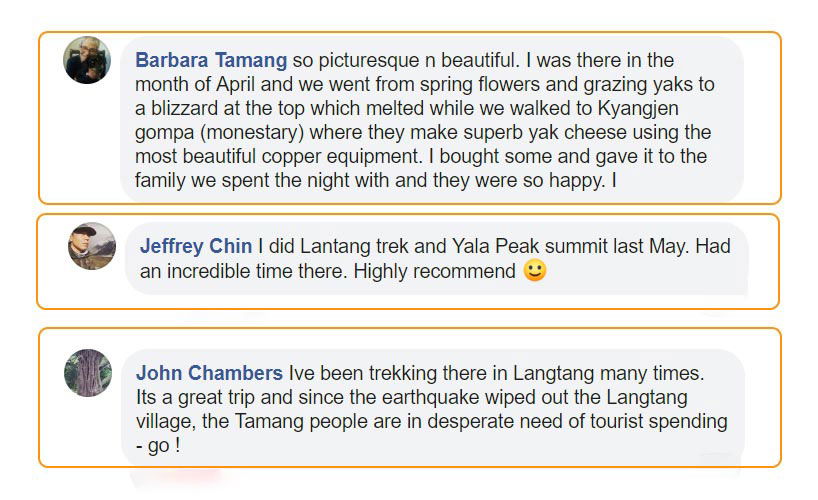
The popular international news website The New York Times has listed Langtang Valley as the top 52 places to visit in the year 2017. I have snapped some Langtang Valley trek reviews from New York Times Travel Facebook Page.
Getting To Langtang Valley
The trek begins from Kathmandu to Syabru Besi. The distance between the capital city and Syabrubesi is roughly 122 km. It takes around 9-10 hours by Public bus and 8-9 hours by Jeep.
It’s not recommended to trek from Kathmandu to Langtang Valley on foot as it’s a long distance and not a safe option. Instead, the trek usually starts from either Syabrubesi or Dhunche, which can be reached by road transport.
2) By Private Jeep
Hiring a private jeep for transportation to Syabrubesi or Dhunche is more expensive than taking a public vehicle. However, if you’re traveling to Nepal through a travel agency, they can arrange private transportation for you, so you don’t have to worry about it.
If you want faster and more comfortable service, you can opt for a private jeep instead of a public bus. A 6-7 seater private jeep service usually costs around $150-$200 for a one-way drive to Dhunche, the starting point of the trek to Langtang Valley.
3) By Public Bus
Taking a public bus is a much cheaper option compared to hiring a jeep for transportation to Syabrubesi or Dhunche. The cost of a public bus is around $7 – $8 per person. The bus service is available at Macha Pokhari, Kathmandu.
The road condition of Pasang Lhamo Highway, which leads to the Langtang Valley trek starting point, is generally okay, but there are some areas where the road can be a bit scary.
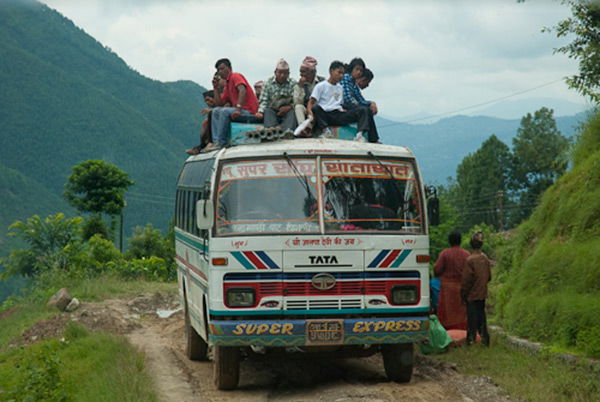
Start Here: Getting Around Nepal
Highlights of Langtang Valley Trek
- Scenic Drive from Kathmandu to Syabrubesi with breathtaking views of the landscapes.
- Explore the unspoiled beauty of Langtang National Park, located between the Nepal-China (Tibet) border.
- Learn more about Tibetan Buddhist culture and their way of life.
- Experience the extended diversity of flora and fauna, including rare species like the red panda and snow leopard.
- Enjoy stunning views of towering peaks like Dorje Lakpa (6,990 m), Langtang-II (7,227 m), Langtang Lirung (7,200 m), Ganesh Himal (7,429 m), and more.
- Immerse in the unique culture and lifestyle of the Tamang community by visiting typical Tamang villages.
- Get the chance to climb Chorko-Ri and witness a panoramic view of the Langtang range.
- Walk through an unimaginable Rhododendron forest, especially during the spring season when the flowers are in full bloom.
Langtang Necessary Permits
Permits are generally required for entry and exit from the Langtang Valley trekking route. Make sure to obtain the necessary permits from the Nepal Tourism Board (NTB) in Kathmandu. You will need to carry your passport and photos for the permit application process.
1) TIMS Card
Trekker’s Information Management System (TIMS) is a card that you get as a permit. These permits must be shown at checkpoints in different places.
The TIMS Card for Langtang Trek is a record that helps trekkers in case of an earthquake, or extreme weather, and for finding lost trekkers.
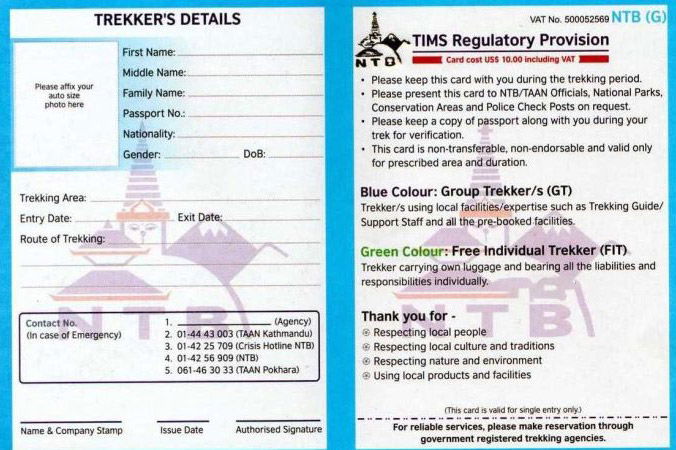
For independent trekkers, it cost around Rs. 2000 ($20), and for group trekkers with a guide, it cost around Rs. 1000 ($10). But if you are traveling through Travel Agency, then they will manage TIMS Cards for you.
2) Langtang National Park Fee
The entrance to Langtang National Park will cost you around Rs 3000 (~$30). You need to ask for this permit at Tourism Board Kathmandu, or you can get it from the Dhunche (Starting point of Langtang Valley Trekking)
Langtang Valley Trekking Itinerary
If you are searching for a good itinerary about Langtang, then this is a new itinerary route after the earthquake in 2015.
This is just an outline itinerary of Langtang. Find the days, hours, heights, and different places in Langtang Valley Trek Itinerary.
The level of the trek starts from easy, and furthermore, you get more challenges, and the journey will reach moderate difficulty as the height rises.
Normally, Pro trekkers want to finish the trek quickly, but novice trekkers need to acclimatize to the surrounding. So, it may take more than a week to complete the full trek.
Langtang Valley Food Guide
For meals, you can get different delicious items. As always you are far away from your home, therefore, don’t expect the food to be of your choice instead adjust with the items in the guesthouse.

1) Breakfast At Langtang Route, you can get tea, juice, toast, pancake, egg, potatoes, mo: mo, etc. for breakfast. The cost of breakfast at this route starts at $2-$3. Higher the elevation the price may increase up to $4-$5.
2) Lunch and Dinner For lunch and dinner, the best food to eat is “ Dal Bhat ” which provides you with lots of calories and proteins. There is a saying about it, “Dal Bhat Power 24 Hours”. You can also find several items beside it like salad, pickles, etc. The price for lunch and dinner is around $4-$5 and may go up at the top.
3) Water Water is yet another most essentials thing to consider while trekking around the Himalayan region. Most trekkers neglect this thing, but it is good to carry an extra bottle with you to avoid spending an additional amount. You can always refill a bottle of water at hotels for free or for a lesser amount.
If you want to buy a bottle of water, then it may cost you from $1.5 at a lower elevation to $3.5 at a higher elevation. And also, don’t forget to drink hot water at the stop to prevent Acute Mountain Sickness (AMS).

Accommodation
Langtang Valley is a much-loved destination, and you can find plenty of tea houses and hotels for accommodation. Don’t expect the guesthouse to be luxurious, but there will be enough clothes to keep you warm.

You can find a clean room, decent beds, and toilets, which will be kind enough to stay at teahouses. In peak season, you may have to adjust the beds and clothes. It is best to contact your travel agency to book excellent accommodation out there.
Langtang Circuit Trekking Route Map
You can find the Langtang Circuit Trekking Route Map that covers the whole valley and basically, the journey starts from Kathmandu. The highest point you will see is Langtang II and Langtang Lirung.
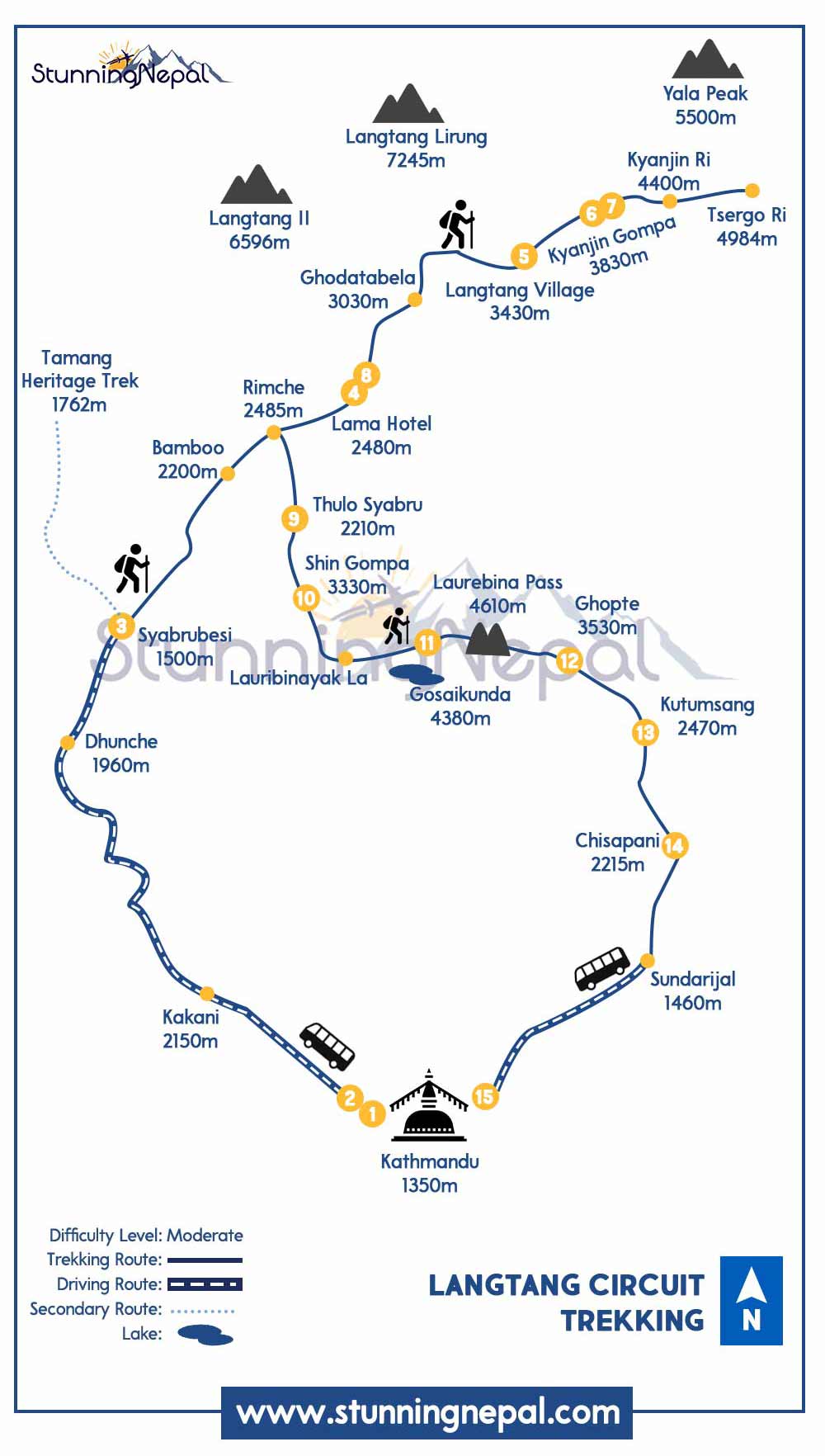
Langtang Trek Altitude Graph Map
There are various itineraries available for the Langtang Valley trek, and each may have a different altitude graph map. However, for the itinerary mentioned above, we will provide the altitude graph map accordingly.

Langtang Trekking Map
If you prefer a hardcopy trekking map of Langtang, you can easily find it in Kathmandu. Numerous shops sell different trekking route maps.
Maps are essential items that you need to carry while trekking. Additionally, you can find the Langtang Geographic map on Amazon.
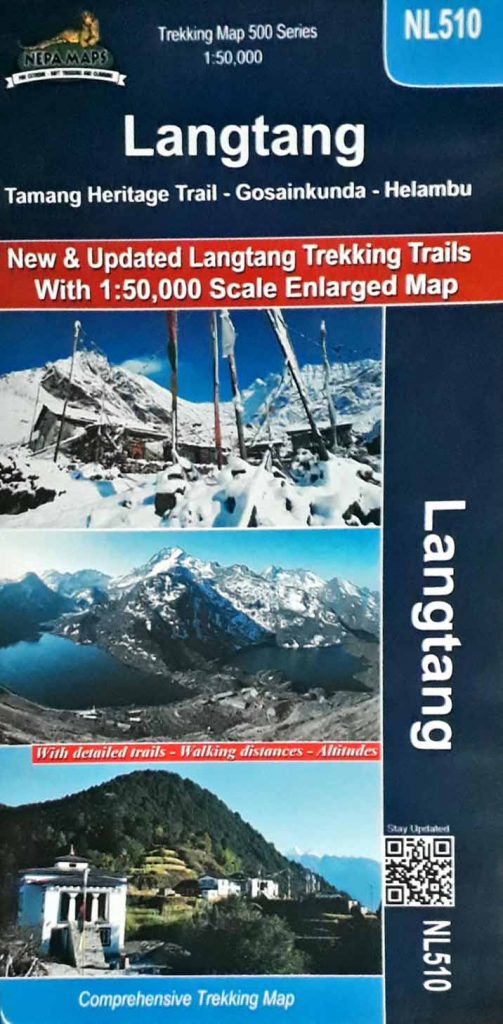
Famous Langtang Trekking Route
Apart from the Langtang Valley trek, there are other famous trekking routes in the Langtang region that you can explore while in Nepal. These include the Helambu Trek, the Gosaikunda Trek, and Tamang Heritage Trail. You can choose to trek to these places individually, or you can opt for a joint Helambu-Gosaikunda-Tamang Heritage trek.
1. Helambu Valley Trekking

Helambu region is a great and nearby place to visit from Kathmandu for a short trek . This place remains unspoiled despite being close to the Capital City. Helambu Trek is a glorious opportunity to explore the culture and tradition of the Sherpa community.
At peak season, you will get to see Rhododendron Forests, Snow-Capped Mountains, Waterfalls, Bamboo Forests, etc. The trek to Helambu starts from Sundarijal located at the eastern end of Kathmandu.
Helambu Trek Highlights
- Explore Buddhist Monastery.
- A glimpse of Snow-capped Mountains.
- Sunrise and Sunset over Mountains.
- Pass through dense rhododendron forest.
- Find unique Sherpa Culture and Lifestyle.
2. Langtang Gosaikunda Trek

Langtang Gosaikunda is an easy trek that is best for a picturesque view of the mountains and is famous for Gosaikunda Lake. Starting from Dhunche to Syabru Besi, Gosaikunda can be reached within 3-4 days.
This sacred lake is one of the holiest lakes famous among Hindus and Buddhists. Thousands of domestic and international travelers visit Gosaikunda Lake every year.
Gosaikunda Trek Highlights
- Beautiful Mountains Ranges.
- Gosaikunda Lake is one of the holiest lakes.
- Astonishing evergreen forests and landscapes.
- Flora and Fauna.
- Explore Lake like Nagkunda, Suryakunda, Saraswatikunda, and, Bhairabkunda.
3. Tamang Heritage Trail
Tamang Heritage Trail is an easily accessible trek from Kathmandu Valley. You will find beautiful Tamang village and tourism in this area has helped to uplift the lifestyle of the people.
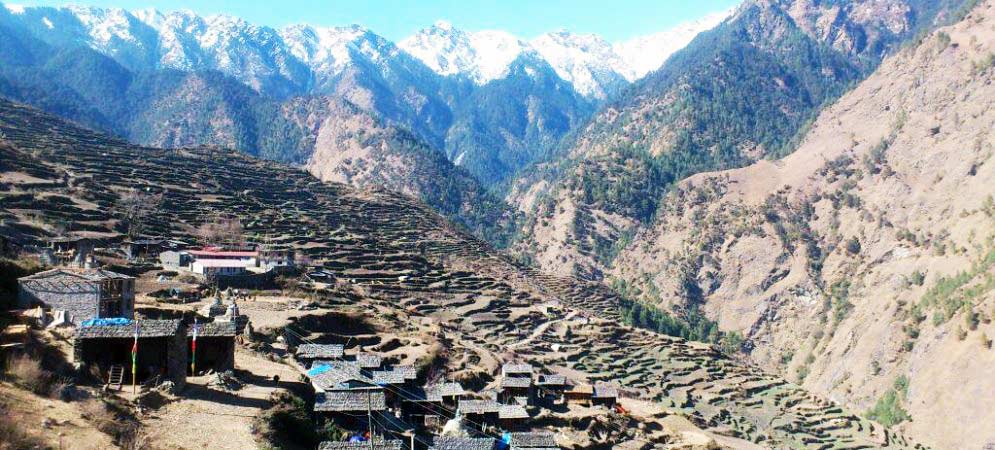
Tamang Heritage is a moderate-difficult trek, and after the earthquake, the route was closed. But now, the route is re-opened, and also hire a local guide to explore more about this heritage trail.
Tamang Heritage Trail Highlights
- Explore traditional houses.
- Culture and Lifestyle of Tamang and Sherpas Community.
- View the highest point Nagthali Pass (3,165 meters).
- View snow-capped mountains Ganesh Himal (7,429 meters), and Langtang Lirung (7,245 meters).
Trekking Gear
This is the most crucial section of this guide. Gears are vital aspects if you are going for short or long trekking. Sometimes backpacking is difficult if you are unfamiliar with the weather condition of a particular place.
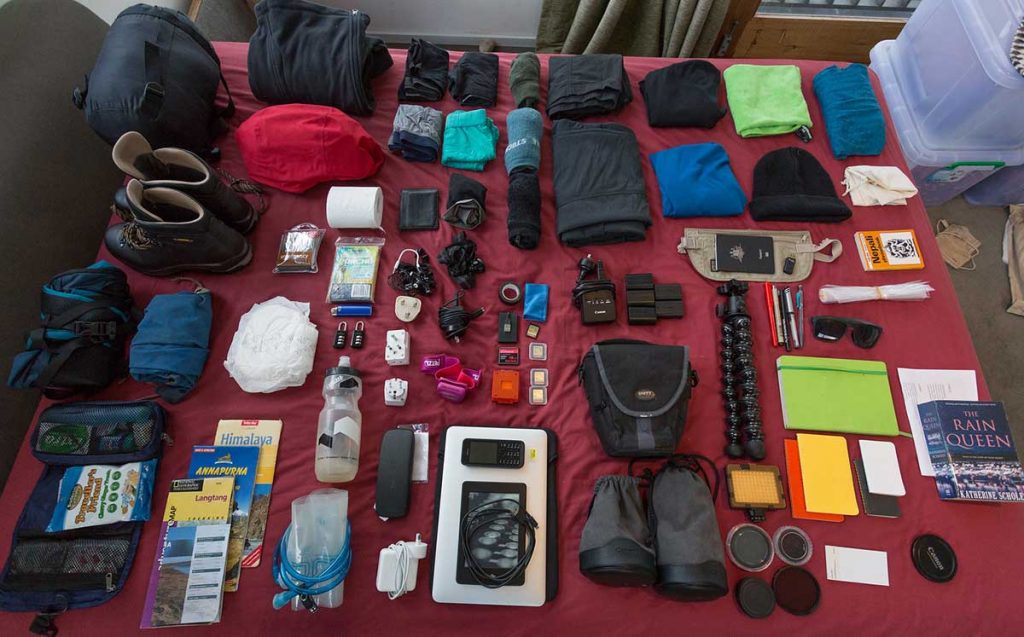
Actually, You don’t have to carry all the trekking gear from your hometown. You can find hundreds of trekking shops in Kathmandu. The shop generally sells or rents the gear items at a low price.
But bring the basic stuff like a hiking boot, Trekking Bag, etc. from your country. Trekking Shop in Kathmandu commonly rents gloves, jackets, Sleeping Bags, etc.
Hiring a Guide and a Porter
Most people love to go hiking or trekking with a guide and a porter. A porter helps to carry your goods so that it will be easier for longer hiking at a higher altitude. Generally, a guide helps to make you more comfortable in a newer place.

Make sure that your travel agency is registered with the Nepal Tourism Board (NTB) and Trekking Agencies Association of Nepal (TAAN). Besides that, you also need to make sure that your agency has a certified guide.
Langtang Trekking for Female Travelers

Nepal is safe for both male and female travelers. For female trekkers, you need to be extra careful while exploring different places.
Sometimes, it will be different situations as every country has its own culture, languages, and lifestyle. So always respect it and be sure you follow them.
Always be careful about the dress code while in Nepal. Also, don’t forget to hire a guide and never go outside alone in the evening time.
Additionally, if you feel uncomfortable with a male guide, then you can hire a female guide too in Nepal and also read our guide for Female Travelers .
Langtang Valley Trek Without Guide
It is always true that you need to hire a guide and porter to be safe while trekking the Langtang region.
Moreover, if you don’t have any prior experience with solo trekking, then this trek might be much more challenging.
Actually, Solo traveling means gaining more experience and knowing the place better. Although, It is best to hire a guide with a porter so that they can carry your luggage and make trekking much more fun.
But, if you are thinking of trekking Langtang without a guide, then be sure about everything, including routes, weather, hotels, and other things.
Then, it is good to explore the Langtang Trek independently starting from the capital city, Kathmandu.
Moreover, most travelers don’t know the Nepali language, but if you have a little bit of experience with it, then it will be much easier. Though, most of the people here at hotels can understand the standard English Language.
Langtang after Earthquake
In the year 2015, Nepal was hit by a devasting 7.8 Magnitude earthquake. Among various affected areas, Langtang was one of them, and her home and the lives of people were deeply affected.
The earthquake hit some parts of this trekking route and moreover, teahouses and guesthouses were destroyed. The avalanche buried the entire village. Therefore, the trekking route was closed for a long time.
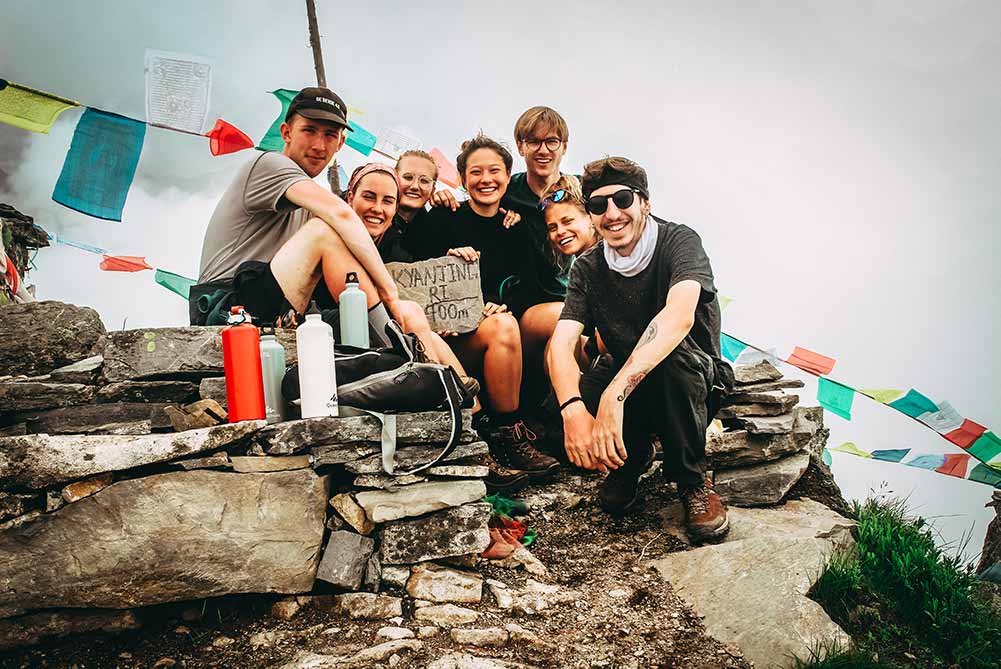
But, now the Nepal Government has reopened this route for trekking. Presently, the Lives of People at Langtang have recovered from the earthquake. The route is good, and you don’t have to worry about it. Also, you can contribute economically to revive the life of the local people.
Nepal Trekking Insurance
While traveling in any part of the world, insurance is a must because no one knows the future. It is essential to have insurance while trekking and traveling to Nepal. Most insurance is necessary when you are going hiking, trekking, climbing, or on an expedition.
Is it necessary to have trekking insurance while visiting Nepal?
Trekking insurance is one of the crucial things while traveling. Nepal is best for hiking and trekking as you can find various routes with easy to hard difficulty levels. So, if you are unfamiliar with hiking and trekking, then we advise going for insurance.
There are different types of insurance policies, and you can take benefits from them. So if you are a solo traveler, then you can go for personal insurance. Also, if you are a group of travelers, then you can also go in bulk too.
Langtang Valley Trek Cost for Nepali
If you want to know the price for the Langtang Valley trek then the cost of the trek ranges from Rs. 15,000 – 20,000. But the cost may vary depending upon the group size, food, and accommodation you take during the trek. Be sure to carry extra money, it will be helpful in case of emergencies and other stuff.
The duration of the trek is 5-7 days that starts from Kathmandu. It is best to manage a group of up to 10 people so that it can be comfortable going for the trek.
So, if you are your friends are looking for a unique trekking experience, be sure to put the Langtang Valley Trek at the top of your list!
Frequently Asked Questions
Which Nepal trek is best?
There are many attractive places in Nepal for trekking. Some of the popular trekking destinations are Everest Base Camp and Annapurna Base Camp . Besides, this Langtang Valley Trek is another popular trekking destination in Nepal. It is the magical and unspoiled trek of Nepal.
How long is Langtang Trek?
Normally, if you have less time, then you can go for 7 days trekking, but if you are searching for an extended version, then you can go for 20-22 days trekking.
Can you trek without a guide?
Basically yes, you can go Langtang trekking without a guide. As said by a local guide, the level of this route starts from Easy to Moderate. So, it is possible without any guide. But we recommend you hire a guide for safekeeping.
How safe is Langtang Trek?
After the devasting earthquake in 2015, the route was closed by Nepal Government, but now the route has been completely changed and re-opened for trekking moreover, it is much safer for trekking.
How much does it cost to trek to Langtang Valley?
It depends upon the trekking days and the travel agency itself. There are lots of factors behind the cost. The estimated cost for the Langtang Valley Trek is between $600-$1000.
How difficult is the Trek?
Trekking Levels are generally graded in 4 parts: Easy, Moderate, Difficult, and Strenuous. The Langtang Valley Trek is a moderate difficulty trek. Most trekkers can finish the Langtang route easily.
How many hours a day do I have to walk during the Trek?
The average walk time is around 5-6 hours a day. So, be prepared mentally and make yourself stronger physically to finish the Langtang Trek.
Do I need a permit for the Langtang Trek?
Yes, you need Trekker’s Information Management System (TIMS) card which must be issued by the Tourism Board. TIMS card must be presented at the entry point at Langtang Gateway.
Will I get altitude sickness on the trek to Langtang?
The range of this trek is moderate. So, there is a low chance of getting altitude sickness, but be sure to take precautions while advancing to a higher altitude.
Can I charge my phone and camera battery during Langtang Valley Trekking?
For electricity, solar panel powers the village, and you get an opportunity to charge your camera battery or cellphone, but you have to pay an extra charge of around $1-$3 per hour. But be sure to carry a portable power bank during the trek to charge up small devices like phones. Also, you can use a portable led USB light using a power bank that comes in handy during the journey.
Is there WiFi on Langtang Valley Trek?
There are WiFi services available in different guesthouses/teahouses. There is around 90% of the area where can use WiFi but you have to pay extra money to use it.
Can I use the ATM during Trek?
Usually, in Langtang Areas, it is difficult to find an ATM lounge. You can use an ATM and Credit Card in Capital City, Kathmandu. It is the best idea to take cash with you if you are exploring rural areas.
Can I hire a local guide during Trek?
Basically, the Travel Agency will arrange a local guide and porter for the whole trek to make your trekking fun and colorful.
We almost have mentioned all the details like the best time to visit, routes, itinerary, Price, Altitude Graph, Trekking Map, etc. So I hope you liked our ultimate guide to Langtang Valley Trek .
If you have a long holiday to spend in Nepal, then you can go for an extended Langtang tour but if you have short vacations then keeping the itineraries tight you can go for 7 days trekking.
If you have any questions/feedback regarding this trek, then please feel free to comment or contact us.
Love this post. Pin it for later
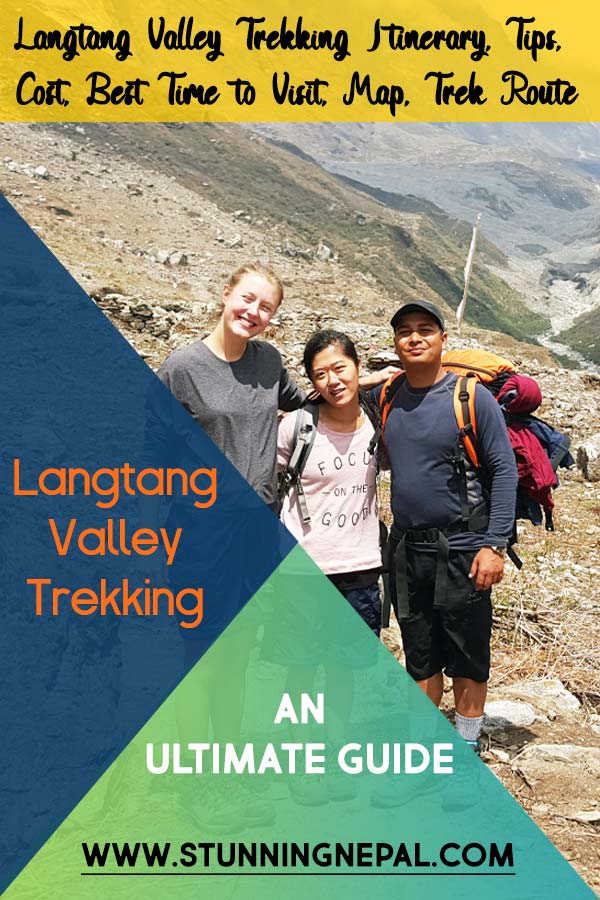
Suraj Katwal
Suraj is a travel enthusiast who believes in finding solace in the heart of nature. He enjoys exploring new destinations, different culture, and encouraging people to travel.
Travel Resources
Hotel & Flight
Searching for the best hotels & flight tickets to visit Nepal? Check out the best deals.
Related Articles...
5 Best One Week Treks in Nepal
Annapurna Base Camp Trek Cost for Nepali
Annapurna Base Camp Trek vs Everest Base Camp Trek
30 Interesting Facts About Mount Everest
Why is Annapurna so Deadly Mountain?
How to Find Travel Agency for Everest Base Camp Trek?
Annapurna Base Camp Trek Weather
Top 5 Family Trek in Nepal
1 thought on “Langtang Valley Trek – Best Time, Cost, Route, Itinerary”
Thanks for sharing very well-written and worth reading this article. Wish to see more in the coming days.
Leave a Comment Cancel reply
About stunning nepal.
Stunning Nepal is a travel blog that intends to provide travel tips, references & guides, things to do & also your guide for hiking & trekking in Nepal.
Travel Guide
Things To Do
Food and Festivals
Privacy Policy
Get in Touch
Stunning Nepal
Address: Dhanawantari Marg, Kathmandu 44600, Nepal
+977-9808211139
© 2024 Stunning Nepal. All Rights Reserved

Permits Required for Langtang Trekking
- Last Updated on Aug 11, 2023
Langtang region has many famous trekking routes like Langtang Valley Trek , Gosaikunda Lake Trek , Tamang heritage trail , Langtang Circuit Trek , etc. And all of them require two trekking permits- a Langtang National Park entry permit and TIMS (Trekkers' Information Management System) card. In the article, you will learn about these two permits, how to obtain them, and how they help the region to grow.
Even though there are multiple trekking options available in the Langtang region, you will only need the above two permits to do any trek. However, if your itinerary includes the Helambu region , you will also have to get the Shivapuri National Park entry permit.
Notes: Permits are non-negotiable, and if found trekking without them, the government authorities will take legal action and in the worst case, ban you from entering the country.
If you are trekking with us at Outfitter Himalaya, all the permits will be included in our package cost, and our team will obtain them on your behalf. The Langtang trek permits are available at Nepal Tourism Board in Kathmandu and at the starting point of the trek, which is usually Sybrubesi or Dhunche. During the trek, you have to show permits at different checkpoints, so make sure to keep them easily accessible.

Langtang Valley Trek

Langtang Circuit Trek

Gosaikunda Langtang Trek
Table of contents, permits required for the langtang trek.
Below are the permits and the costs required for trekking in the Langtang region. Do note that these permits are not mere formalities. They hold significant importance for both trekkers and the region's conservation efforts.
TIMS (Trekkers' Information Management System) Card
The TIMS (Trekkers' Information Management System) Card is an essential document required for trekking in the Langtang region. Introduced in 2008, the TIMS card serves as a database for trekkers, providing crucial information for safety and regulatory purposes.
Note: As per April 1st, 2023 policy amendment, you can no longer obtain a TIMS card on your own. This means you have to trek with a local company like us to get a TIMS card.
There are different TIMS cards with different costs. The TIMS card cost for citizens of SAARC countries is about USD 10. Likewise, for other foreign trekkers, it costs around USD 20. You have to give a copy of your passport and two passport-sized photographs to get your TIMS card.
The Kyanjing Village in Langtang, Region, Nepal

You will not need a TIMS card to trek in the Langtang region in the following cases:
- If you have a permit from the Department of Immigration.
- If you are a foreign guest invited by the Government of Nepal.
- If you are a foreign national with a residential visa in Nepal.
- If you have visited Nepal on a diplomatic mission or have an official letter.
- If you are an expedition member and have a permit to climb mountains.
- If you are on a mission directed by any government department.
Langtang National Park Entry Permit
The second important trekking permit for any trek in the Langtang region is the Langtang National Park entry permit. This permit is not only a legal requirement but also a vital contribution to the preservation and sustainable management of the region's unique ecosystem.
Below is the cost of the Langtang National Park entry permit:
- For Nepali citizens: Nepali rupees 100 (Around USD 1) per person per entry
- For SAARC nationals: Nepali rupees 1,500 (Around USD 15) per person per entry
- For other Foreign nationals: Nepali rupees 3,000 (About USD 30) per person per entry
- Child Discount: Below 10 years old free of cost
Shivapuri National Park Entry Permit
You will only need this permit if you are doing the Langtang Gosaikunda Helambu trek or any trek that connects the Langtang region with the Helmabu region. The Shivapuri National Park permit cost is about USD 5 per person per entry.
How do these permits help the Langtang region?
The Langtang region is home to a fragile ecosystem that needs protection from the adverse impacts of tourism. By requiring permits, authorities can regulate the number of trekkers entering the area, ensuring that the delicate balance of nature is preserved. This measure helps minimize human-induced environmental degradation and allows future generations to experience the same breathtaking landscapes.
The Gosaikunda Lake in Langtang Region, Nepal

The funds generated from trekking permits contribute to the sustainable management of the Langtang area. These funds are used for various conservation projects, trail maintenance, waste management, and infrastructure development. By obtaining permits, trekkers actively contribute to the region's upkeep, ensuring that its natural beauty remains intact for years to come.
Trekking permits are not only about paperwork; they play a crucial role in ensuring your safety during the journey. The information provided during the permit application process helps authorities keep track of trekkers on the trail. In case of emergencies, search and rescue operations can be conducted more efficiently, potentially saving lives.
Trekking without the necessary permits is not only illegal but can also lead to hefty fines and legal complications. The authorities enforce permit requirements to ensure that all trekkers follow ethical and legal practices. By obtaining permits, you respect the local laws and regulations, contributing to responsible and sustainable tourism.
Langtang Trekking Permits FAQs
Why do i need a langtang national park entry permit.
The Langtang National Park entry permit is a bureaucratic formality that you have to do. The money collected by the permit helps to maintain the region's natural diversity and trail conditions. The money generated by this permit also supports the community.
What is the purpose of the TIMS card?
The TIMS card has several functions that contribute to a safe and well-organized trekking experience:
- Emergency Contact: The TIMS card includes your personal and emergency contact details. In case of any unforeseen circumstances or emergencies, this information can be used to initiate search and rescue operations promptly.
- Data Collection: The card helps authorities collect data on trekkers' demographics, trekking routes, and duration of stay. This information aids in understanding trekking patterns, allocating resources, and managing potential environmental impacts.
- Regulation : The TIMS card helps regulate trekking activities by differentiating between individual trekkers and group trekkers. This ensures that trekkers follow proper channels and guidelines while exploring the Langtang region.
The Trekking Trails in Langtang Region, Nepal

How can I obtain a TIMS card, and what are the fees?
You can only obtain a TIMS card with a help of a trekking company like us. The TIMS cost is USD about 10 for SAARC nationals and about USD 20 for travelers from other countries.
Are there any specific areas along the Langtang trek that require a Restricted Area Permit?
No, you will not need a restricted area permit during the Langtang trek.
Can I obtain permits directly in Langtang, or should I get them beforehand?
While trekking with us, we will obtain the permits in advance on your behalf. As there are no restricted area permits needed for trekking in the Langtang region, you do not have to be present to get the permit.
Are permits available year-round, and are there any seasonal considerations?
Yes, the TIMS card and Langtang National Park entry permit both are available year-old. No, there is no discount on permit costs during the off-seasons (summer, monsoon & winter).
What documents are required to obtain these permits?
To obtain the permits, you will need to provide a valid copy of your passport and two passport-size photos.
Can I obtain permits individually, or do I need to go through a trekking agency?
As per a recent update, you cannot obtain a TIMS card individually, and you have to go through a local trekking agency like us.
Are there any environmental or conservation fees included in the permits?
Yes, the Langtang National Park entry permit money is used to protect and preserve the fragile environment and ecosystem of the Langtang region.

Arjun Rijal
Hello, Hi & Namaste from the Himalayas !!!
I am Arjun Rijal, Founder Director of the Outfitter Himalaya Holidays P. Ltd & working as a travel planner/consultant for Nepal, Bhutan, and Tibet Travel. I love hiking, trekking, and traveling.
I have been in most of the trekking regions in Nepal, that include Everest Base Camp , Annapurna Base camp , Annapurna Circuit , Manaslu , and Langtang . I also have travelled to Bhutan , India & planning further travel to many other countries in the world.
Find my writing on traveling, trekking, tours, travel news, and updates about the tourism activities of Nepal, Tibet & Bhutan.
You can also follow me on social media to receive regular news and updates.
- Trip Advisor
Drop us a message
Recent posts.
- Annapurna Circuit Trek Weather and Temperature
- Deluxe Hotels in Chitwan
- Standard Hotels in Chitwan
- Deluxe Hotels in Pokhara
- Standard Hotels in Pokhara
- Deluxe Hotels in Kathmandu
Related Posts
- Annapurna Travel Guide
- Bhutan Travel Guide
- Everest Travel Guide
- Kathmandu Travel Guide
- Langtang Travel Guide
- Manaslu Travel Guide
- Nepal Travel Guide
- News and Updates
- Places to Stay in Nepal
- Pokhara Travel Guide
- Tibet Travel Guide
We use cookies to ensure that we give you the best experience on our website.
- Travel Guides
Required Langtang Trek Permit
Travel guide.
Table of Contents
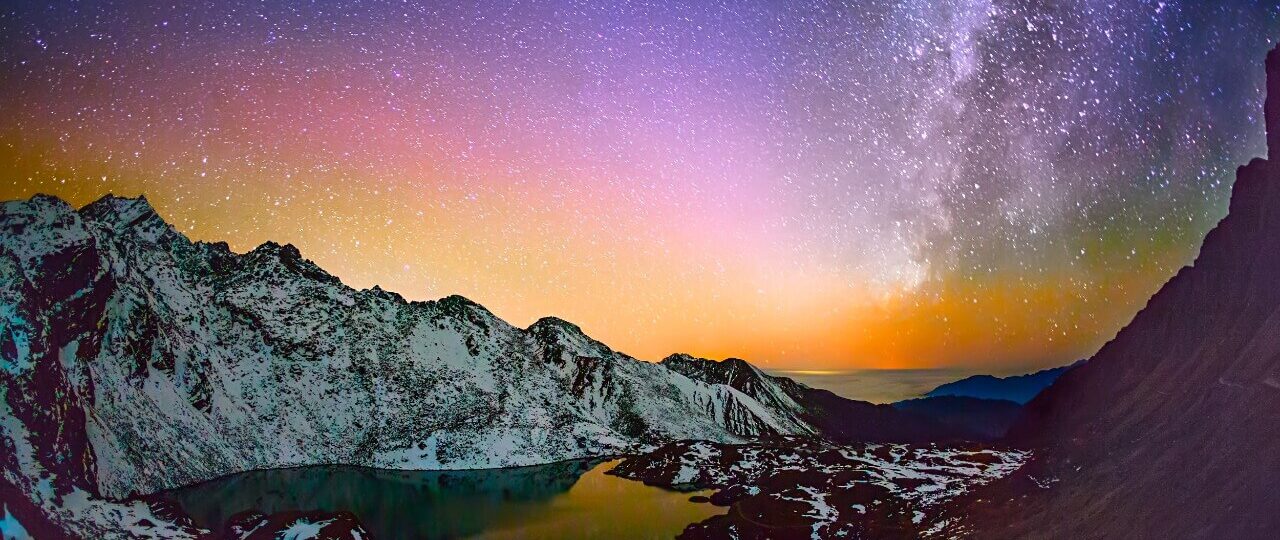
Since April 1st, two different types of permits have been required for anyone planning to hike in the Langtang Valley or anywhere else in the Langtang region. You are not allowed to enter Langtang National Park without a guide, so you must have a Langtang National Park permit and a Trekkers Information Management System Card (TIMS).
The cost of the TIMS card is NPR 2000, while the price of the Langtang National Park Entry Permit is NRP 3,000, including VAT (about USD 26) for foreigners and NPR 1500, including VAT (around USD 12) for residents of SAARC nations. Young children under the age of ten do not require a permit. The price for the Nepalese was NPR 100. A Langtang National Park entry permit is required for all trekkers to enter the grounds.
Visiting the wonderland of Langtang might be the best holiday you have ever had. The breathtaking beauty of the Himalayas, the unique landscape, the rich biodiversity within Langtang National Park, and the century-old culture of Langtang Valley are things you get to explore in a single visit. However, the trek to the remote land of Langtang Valley also needs a lot of preparation. As a foreigner, one of the most hectic things you must do is collect the Langtang trek permits. So, our team at Himalayan Masters is here to make this process easier.
Here, we write about where and how to get a Langtang trek permit. This permit is compulsory for all foreigners (including people of the SAARC country). You will be asked to get the license at many checkpoints throughout the trekking route. The Langtang Valley Trek permit , Tamang Heritage Trek permit, Gosaikunda Trek permit, Helambu Trek permit, and Helambu-Langtang Trek permit are listed here.
Nepalese Visa
Should we write that you need a Nepalese visa before getting these Langtang trek permits? Isn’t that obvious?
All foreigners (other than Indians) need to obtain Nepalese travel visas. Most countries (with some exceptions) can issue Nepal visas on arrival by filling out two forms. It would be best to have a passport with six-month validity and a passport-size photo (bring many) to give the visa. A Nepalese visa costs $30, $50, and $125 for 15, 30, and 90 days, respectively. It’s free for children under ten years and people of SAARC countries. You can learn more about the Nepalese visa here. Besides the Nepal Travel Visa, you need two other permits for the Langtang trek.
Read the full article about the Langtang Trek Cost
Langtang National Park Entry Permit
During the trek, we will be strolling in many areas of Langtang National Park. Langtang National Park was established in 1976 and covers an area of 1710 mt. The team has been conserving wildlife like musk deer, Himalayan tahr (black bear), red panda, snow leopard, sea lion, and over 250 bird species. This is among the most diverse national parks in Nepal.
Note: The permit is the same for the Langtang Gosaikunda Trek.
Where Can I Get This Permit?
If you will stay in Kathmandu for a long time, you can get this Langtang trek permit from the Nepal Tourism Board in Kathmandu. The easiest option is to get it at the entry point at Dhunche or contact Himalayan Masters; they will help you get the permits. You can email [email protected] .
Where did the money go?
The Langtang Trek Permit for National Park has two purposes: to keep track of tourist movement in the national park and to maintain the park. This permit will ensure your safety during emergencies such as earthquakes, landslides, etc. It maintains the rules and regulations as you are in the national park. Your Langtang permit price goes for a good cause.
Shivapuri-Nagarjun National Park Entry Permit
The classic Langtang Valley trek commences in Syabrubesi, 122 km from Kathmandu. Trekking from Syabrubesi doesn’t require this permit. However, some trekkers take an alternative path via the Gosaikunda-Helambu route. If you are discussing this route, you also need a Shivapuri National Park entry permit. This permit costs NPR 1,000 for foreigners, NRP 600 for SAARC citizens, and NPR 50 for locals.
It’s free for children under ten years of age. Like the Langtang National Park permit, you can either get this permit from the Tourism Board at Kathmandu or at the entry point in Shivapuri.
Want to know how challenging the Langtang Valley Trek is?
Langtang Local Area Permit
This Langtang Trekking Permit for the local area was introduced as a replacement for the TIMS card. It was supposed to be issued by the local government of Langtang. However, our guide informed us that the Langtang local area permit is unnecessary. Even if you need the permit, it will be issued at the check post at Langtang and might cost $10 to $20. So, don’t worry about this permit right now. We will keep you posted if we get any new information about this Langtang Trek permit.
Documents required for Langtang Trek Permit
When you get to the respective department for the permit, you will need an original passport, a photocopy, and two passport-sized photos for each license. You will need 6–8 pictures and 4-5 photocopies of the passport. It’s easier if you get these from your home country. Also, do carry your visa while you go to issue the permit. Once you pay the bill and fill out the form, the Langtang Trekking Permit license will be issued within a few minutes.
Read for food and accommodation in Langtang Trek.
Other information you might need
- Starting and ending points and dates of the trek
- Trekking routes and itineraries
- Emergency contact in Nepal (might be your agency or your hotel)
- Emergency contact in the home country
- Your insurance policy details
When to Issue Langtang Trek Permit?
Issuing all these permits in Kathmandu takes a few hours. So, if you stay in Kathmandu for an extra day, you can issue the license quickly. The office is open from 10 a.m. to 4 p.m. Also, look out for public holidays and Saturdays; the office remains closed for the Langtang Trekking Permit.
Any more queries?
Leave a comment below.
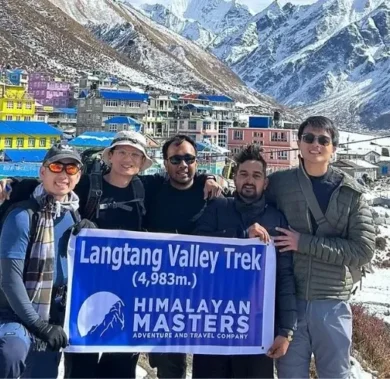
Langtang Trek distance
Langtang trek difficulty and tips to overcome them.
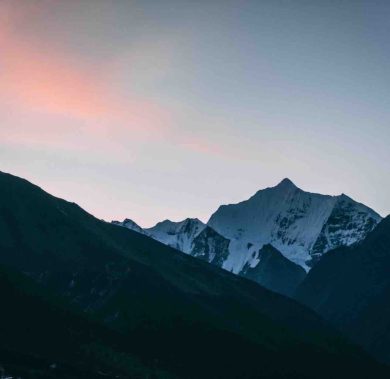
related blog post
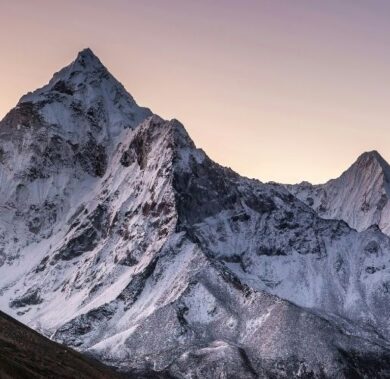
The Height of Mount Everest Base Camp
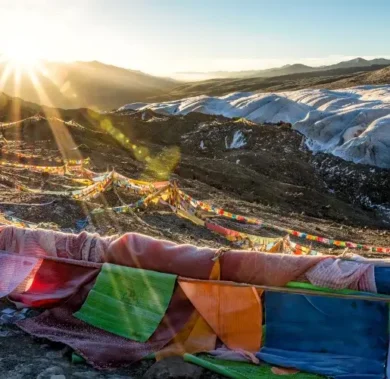
Trekking in Nepal in October, weather, and best places

Langtang Valley before and after
Unsure where to go we can help.

LATEST BLOG POST
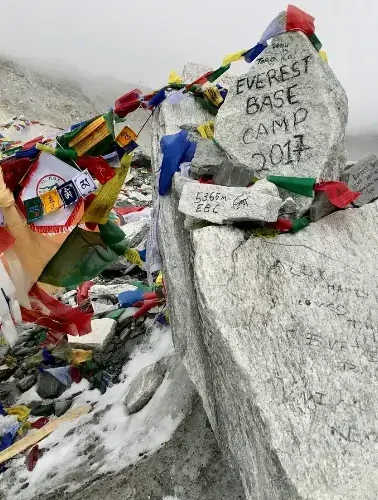
View of Everest from Kathmandu

13 Things before booking treks in Nepal in 2024
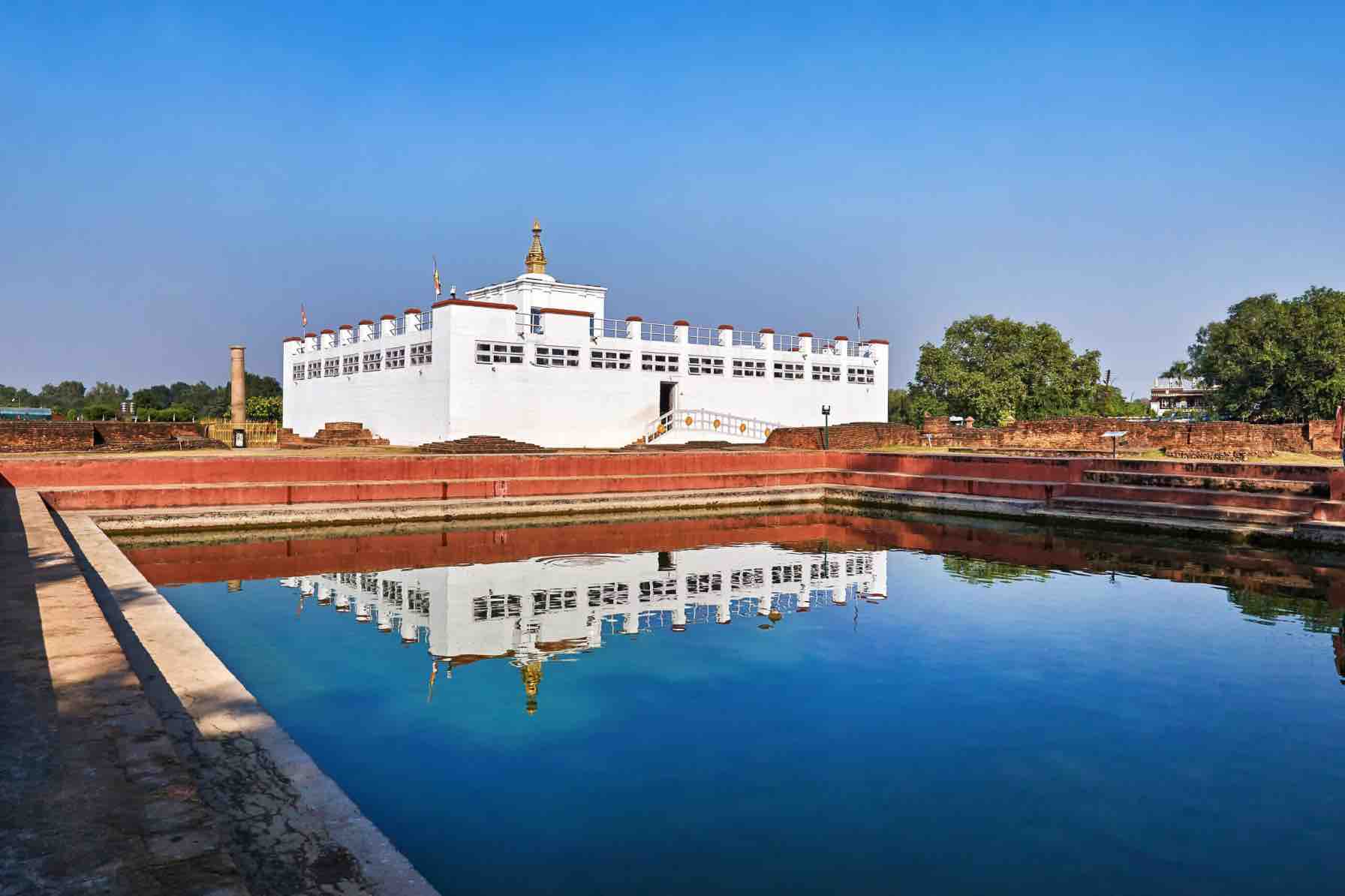
Places to Visit At Lumbini, Things to do
Get Instant Response:
- Hillary Classical Trek – 17 Days
- Everest Base Camp Trek – 14 Days
- Everest Three High Passes Trek – 18 Days
- Everest Base Camp Trek Via Gokyo Lake – 15 Days
- Everest View Trek – 5 Days
- Gokyo Renjo La Pass Trek – 13 Days
- Everest Base Camp Trek Heli Return – 10 Days
- Everest Base Camp with Island Peak Climbing – 16 Days
- Everest Base Camp with Lobuche Peak Climbing – 16 Days
- Everest Panorama Trek – 7 Days
- Luxury Everest Base Camp Trek – 12 Days
- Ama Dablam Base Camp Trek – 8 Days
- Short Everest Base Camp Trek – 10 Days
- Gokyo Ri Trek – 10 Days
- Annapurna Base Camp Trek – 7 Days
- Annapurna Circuit Trek – 14 Days
- Annapurna Base Camp Trek via Poon Hill – 13 Days
- Annapurna Circuit Trek with Annapurna Base Camp – 20 Days
- Annapurna Circuit Trek with Tilicho Lake – 15 Days
- Nar Phu Valley Trek – 14 Days
- Poon Hill Trek – 7 Days
- Upper Mustang Trek – 15 Days
- Mardi Himal Trek – 5 Days
- Khopra Danda Trek – 8 Days
- Annapurna Base Camp Trek with Helicopter Return – 8 Days
- Annapurna Sanctuary Trek – 10 Days
- Short Annapurna Circuit Trek – 10 Days
- Manaslu Circuit Trek – 13 Days
- Manaslu Tsum Valley Trek – 20 Days
- Tsum Valley Trek – 16 Days
- Langtang Valley Trek – 8 Days
- Langtang Gosaikunda Trek – 13Days
- Gosaikunda Trek – 5 Days
- Tamang Heritage Trail – 7 Days
- Kanchenjunga Trek – 22 Days
- Pikey Peak Trek – 6 Days
- Mera Peak Climbing – 13 Days
- Lower Dolpo Trek – 15 Days
- Island Peak Expedition – 15 Days
- Mera Peak Climbing – 15 Days
- Legal Documents
- Terms & Condition

Langtang Valley Trek - 8 days
Starting from
Starting Price USD 690
Group Size 1+
Trip Grade Modarate
Best Season March - May, October - December
Accommodation Hotel/Tea House
Max Elevation 4984 m
Meals Full Board
Transportation Private Vehicle
Trek Route Syabrubensi-Langtang Village- Kyanjin Gompa
Trip Highlights
- Witness magnificent views of sky-touching mountains including the beautiful peaks of Dorje Lakpa, Langtang Lirung, and Langtang Ri.
- Enjoy trekking on well-established and less crowded trails in the Himalayas of Nepal for a peaceful trekking adventure.
- Walk through Langtang National Park while exploring incredible flora and fauna in nature.
- Immerse yourself in the traditional art, culture, and lifestyle of the local people in the Langtang region.
- Witness sublime views of the landscape and surrounding nature from either Tserku Ri, Langshisa Kharka, or Kyanjin Ri.
Trip Overview
The Langtang Valley Trek offers a beautiful blend of nature, culture, and adventure, making it a perfect choice for trekkers of all kinds. Hillary Step Treks presents Langtang Valley Trek 8 days package for trek enthusiasts to explore the magical Langtang Valley, a hidden gem that comes to life with vibrant sights and sounds. Nestled in the heart of Nepal, this trek is perfect for all kinds of trekkers and provides a remarkable experience for travelers with different levels of trekking expertise.
As you embark on this unforgettable journey, the valley has breathtaking views at every turn, surrounded by majestic snow-capped mountains. The towering peaks, such as Langtang Lirung , Dorje Lakpa, and Langshisa Ri, create a stunning backdrop against the clear blue sky. However, it is not just the mountain vistas that will leave you in awe during our Langtang Valley Trek 8 days trip. The pleasing landscape of Langtang Valley also features lush forests, cascading waterfalls, and meandering rivers. Moreover, the serene and pristine environment offers a peaceful respite from bustling city life, allowing you to reconnect with nature and rejuvenate your senses.
One of the other excellent features of the Langtang Valley Trek is the warm and welcoming atmosphere of Langtang National Park. As you traverse through the park, you’ll encounter a rich diversity of flora and fauna, including rhododendron forests, bamboo groves, and rare wildlife such as red pandas and Himalayan black bears.
In addition to breathtaking scenery and natural wonders, the Langtang Valley Trek 8 days trip also provides an opportunity to immerse yourself in the local culture. Along the trail, you’ll encounter traditional Tamang and Sherpa villages, where you can interact with friendly locals and learn about their way of life. Experience their warm hospitality and witness cultural traditions that have been passed down through generations. Additionally, the walking days are also well balanced in our Langtang Valley Trek 8 Days and you will find something special for each day as you explore Langtang.
Just so you are aware, the Langtang Valley trek distance covers 70 km/43 miles from Syabrubensi to Kyanjin Gompa and back upon completion of the trek with HST. To represent the cost, the Langtang Valley trek cost may vary depending on numerous factors including season of travel and group size. On average, our Langtang Valley trek cost ranges from USD 449 to USD 690. If you have more time, you can continue 13 Days Langtang Gossainkunda Trek
More Travel Blogs/Guides for Langtang Valley Trek
A complete guide for Langtang Valley Trek
Best Side Trips Around Langtang Valley
Day to Day Itinerary
Drive from kathmandu(1,359m/4,429ft) to syabrubensi (1,460m/4790 ft) by bus.
On your first day of the Langtang Valley trek itinerary, you will embark on the scenic drive to Syabrubensi from Kathmandu.
In the early morning, our representative will pick you up from your hotel and escort you to the bus station. From here, the scenic drive takes you through the rough high hills of Nepal to arrive at the rural hills of the Rasuwa district . In the midway settlements, we will take a break for lunch. Then, the further drive will take you through scenic landscape and scenery before reaching Syabru in the afternoon.
Upon arriving at Syabrubensi , you will check in to the hotel and the balance day is for rest and refreshment. Stay overnight in Syabrubensi
Trek from Syabrubensi (1,460m/4,790ft) to Lama Hotel (2,470m/8,103ft))
The second day of the Langtang Valley Trek veins with a sense of excitement and anticipation. Leaving behind the cozy village of Syabrubesi, you will embark on a journey that will lead you to the enchanting Lama Hotel.
Crossing the bridge nearby, you will begin by following a ride-side path on the trekking trails toward the Lama Hotel. The trail is comfortable and the astonishing surrounding views introduce you to the beautiful Langtang region.
During the journey, we will take a break at the picturesque Riverside teahouse to enjoy lunch. Afterward, you will continue walking on a gradually ascending trail to arrive at Rimche. From here, it takes a further 25 minutes on an easy trail to reach Lama Hotel. Stay overnight at a teahouse in the Lama Hotel.
Trek from Lama Hotel(2,470n/8,103ft) to Ghodatabela to Langtang Village (3,430m/11,253ft))
On the third day of the Langtang Valley Trek itinerary, the trail takes you deeper into the heart of the Langtang Valley, promising breathtaking vistas and cultural encounters that would leave a lasting impression.
From the beginning of the day, you will witness the change in the landscape and trail as you begin to feel the majestic snow-capped peaks getting nearer and nearer. Admiring the natural beauty, you will pass through a steep jungle trail alongside a wide and open terrain to arrive at Ghodatabela. Here, you will take a break to catch your breath, soaking in the panoramic views of the surrounding mountains and the tranquil beauty of the valley. The break is also for relishing the lunch.
Leaving Ghodatabela after lunch, the trail passes through the landslide-engulfed Langtang Village and takes you to the newly reconstructed village on the other side. Stay overnight in a teahouse/lodge in Langtang Village.
Trek from Langtang Village(3,430m/11,253ft) to Kyanjin Gompa (3,900m/12,795ft)
Today, the short trekking trail weaves its way through rugged terrain and captivating landscapes, as you make your way towards the enchanting destination of Kyanjin Gompa. Before leaving the Langtang village, you will have time to explore the village with an opportunity to interact with the locals. Draw upon the opportunity to hear their stories and learn about their unique culture, tradition, and way of life.
After a late breakfast, you will continue the trek ascending steadily, each step bringing you closer to the sky-piercing heights of the Langtang region. The path unveils breathtaking panoramas at every turn, offering glimpses of majestic peaks on your way to Kyanjo Gompa.
Kyanjin Gompa is a fantastic example of traditional Himalayan settlements in Nepal. Upon arriving at Kyanjin, you will visit the historic Kyanji Gompa monastery and join the monks for their evening prayer. Stay overnight at a teahouse in Kyanjin.
Excursion day (Kyanjin Ri, Tserku Ri, or Langshisa Kharka)
Kyanjin Gompa includes some amazing trails that lead the trekkers to the surrounding natural viewpoints and peaks. On this day of the captivating Langtang Valley Trek, you can choose one from the three of the popular day hike options in the region – Tserku Ri (4983 m), Kyanjin Ri (4773 m), and Langshisha Kharka (4325 m). All of this hiking can be completed in around 5 hours and amazes you with fantastic views of the astonishing Langtang range. Plus, you will also have to go over the 15000 ft mark which itself is an amazing milestone to achieve.
After accomplishing the hike, take a rest for the remaining day in a teahouse. Stay overnight at Kyanjin Gompa.
Trek from Kyanjin Gompa(3900m/12,795ft) to Rimche (2,400m/7,874ft)
On the sixth day of our Langtang Valley Trek itinerary, you will bid a fond farewell to the enchanting Kyanjin Gompa with memories of the towering peaks and the warm hospitality of the locals etched in your hearts. Today, you will embark on descending trails that retrace your footsteps back toward Rimche. As you drop further, the trail and landscape change from barren lands to lush hills.
Once again, the beautiful scenic trail passes through Langtang, Ghodatabela, and Lama Hotel before you arrive at Riche. You will reach Riche in the late afternoon. We will have lunch here and then, you can explore the place and interact with the locals. In the evening, you will enjoy a beautiful sunset from Rimche before spending a night at a local teahouse.
Trek from Rimche(2,400m/7,874ft) to Syabrubensi (1,460m/4,790ft))
Today marks the last day for trekking on foot on our Langtang Valley Trek 8 days trip. The hike back to Syabrubensi is a short and relaxed one. Before starting the trek, you can visit the farms and spend some time interacting with the locals to learn about their life under the shadows of the Himalayas. You will arrive at Syabrubensi in the late afternoon, taking a rest at the riverside for lunch on your way.
Upon arriving at Syabrubensi, the remaining day is for rest at the hotel. Stay overnight in Syabrubensi.
Drive from Syabrubensi(1,469m4,790ft) to Kathmandu(1,350m/4,429ft) by bus
On the final day of the remarkable Langtang Valley Trek, you will start the day with relishing breakfast before you bid farewell to the scenic town of Syabrubensi. You will embark on the scenic drive to return to Kathmandu. The beautiful hills on rivers on the roadside will keep you entertained throughout the journey.
Upon arriving in Kathmandu, our representative will transfer you to your hotel in Thamel. You can spend the remaining day exploring the Thamel Market and buy souvenirs and gifts to take back home. Stay overnight at a hotel.
Cost Inclusion
Accommodation.
- 7 Nights Accommodation During the trek, Five nights Attached bath room with hot shower. Syabrubensi two nights, Langtang Village, Kyanjin Gompa for two night. Two nights Standard common accommodation at Lama Hotel & Rimche Village.
- All Standard meals (7 Dinner, 8 lunch & 7 Breakfast /the main course) while on the trek
Transportation
- Both Way Kathmandu to Syabrubesi & Syabrubensi to kathmandu by Public Transportation ( If you ask we can arrange private vehicle on extra cost)
- Langtang Nationalpark permit fees
- Trekker’s information management system (TIMS) cards fees
- Professional & government licensed holder English Speaking Trekking Guide
- Porter (2 trekkers: 1 porter)
- Staff costs including their salary, insurance, equipment, food and accommodation etc
- Sleeping bag
- Trekking Map
- First aid kit
- Cookies & Seasonal fruits everyday
- All government and Local Taxes
Not Included
- International Airfare
- Nepal Visa fees at Tribhuwan International Airport ( 15 Days- $30, 30 Days – $50, 90 Days – $125
- All accommodation & Meals in Kathmandu
- Extra nights accommodation in Kathmandu due to early return from the trek
- Travel & Health Insurance
- Emergency Helicopter Rescue Insurance
- All hard and soft table drinks such as Tea/Coffee, Coke, Fanta, Beer, Water and deserts in trek
- International call/WIFI & Internet on trek
- Your trekking gear
- Tips for guides and porters
Trekking Information
Benefits of choosing hillary step treks(hst).
Our experienced team of over one decade has accomplished treks in Langtang Valley Treks and other treks too.
Our guides are fluent in English, and Nepali dialects. They are familiar with the terrain, culture, and people in the Langtang region to the core.
HST provides you with the best value services for your money. No hidden cost, every step with HST is transparent and clear. We value our clients over profit any day.
Your safety is the top priority while trekking with the HST team. Thus, in case of an emergency, a first-aid kit or provision of rescue teams are always in place.
We are a government-registered company providing you with real care services at the best reasonable rate.
Our company also has 70% repetitive clients over the years which shows their trust in us.
We go the extra mile to assure you of a complete trekking experience in Nepal. HST certainly is your ideal choice for trekking in Nepal.
Accommodation of Langtang Valley Trek
You will be staying in Tea Houses or local lodges for the whole duration of the Langtang Valley Trek. As soon as you leave Kathmandu, you will be traveling to the rural parts of the country where tea houses are more of a standard accommodation for trekkers. Your rooms are simple and you can expect sufficient basic services and facilities in these establishments. The teahouses will also provide you with food and shared dining rooms.
As for hot water and WI-FI availability, it is best to ask about them before choosing the teahouse. Also, inquire about the additional cost for the use of these services.
Meals & Drinking water
Meals in the Langtang trek are simple and prepared making the best use of the local organic ingredients. You can expect Dal Bhat and tea served at almost all the teahouses and hotels during the trek. A few other items that make it to the menu include popular snacks like bread, momos, chow mein, and so on. You can also find bakeries operating in major settlements like Langtang, Syabru, and Kyanjin here.
For drinking water, there are taps as well as freshwater streams straight from the mountain. We do suggest you ask for water refills at the teahouses and lunch stops just to be safe. Also, it is ideal to carry water purification tablets with you just to take additional precautions.
Langtang Valley Trek Packing List
Creating a packing list can be overwhelming when traveling to unfamiliar regions. Where do I start the packing checklist? What are the essentials that I can’t miss? And many such queries may arise. Don’t worry; we’ve got you covered on that one. Here is your packing guide to the Langtang Valley trek.
Upper Body: –
- A long-sleeve thermal base layer
- Trekking shirt
- Insulation layer
- fleece jacket
- Warm Down Jacket
- waterproof jacket
- T-Shirt lightweight
- Beanies and ear warmers
- Sunhat & Scarf
- Headlights with extra batteries
- Sunglasses with UV protection
- Face /Body wipe
legs & Boots:-
- Trekking Pants two pairs
- Trekking boots
- Sport Shoes
- Crampons (If snow or Ice)
- Thermal Leggins
- Underwear & thick Socks
List Of Clothing
Hiking Shorts
Comfortable Hiking Trousers
Wind Stopper Jackets
Non-cotton innerwear
Water-Proof Fabric Jackets, Pants
Light-Weight Thermal Tops & Bottoms
Woolen Trousers
Waterproof GoreTex Jackets
List Of Footwears
Light Weight Socks
Comfortable Hiking Shoes And Extra Shoelaces
Heavy Woolen Socks
Training Or Running Shoes
Cotton Socks Gaiters
List Of HeadWears
Sunglasses With UV Protection
Woollen Caps
Prescribed Sunglasses (if any)
Woolen Scarf
Headlamp Along With Extra Batteries And Bulbs
Personal Medical Kit
Simple And Light Medical Kit
Pain Killers
Skin-Blister Repair Kit
Anti-Diarrhoea Pills
Anti-Altitude Sickness Pills
Cough And Cold Medicines
Water Purifying Tablets
Stomach Antibiotic
Prescribed Medicines (If Any)
Essential Toiletries
Toothbrush And Toothpaste
Toilet Papers And Wet Wipes
Anti-Bacterial Handwash
Nail Cutter
Essential Documents
Trekking Permits
Travel Insurance
Tech Essentials
Camera, along with extra Batteries
Power Banks
Phone & Chargers
Adapter Plugs
Note: The above list can be customized as per the seasons and necessities of the trekkers .
Entry Permits for Langtang
You need a permit to enter and trek inside the Langtang National Park during the Langtang Valley Trek in Nepal. This permit will cost you around 30 USD per person and will last for the duration of the trek. Similarly, a Trekkers Information Management System (TIMS) card is also required for trekking in the Nepalese Himalayas. It will cost you 20 USD per person when applied in a group. You can get both these from the Nepal Tourism Board head office in Kathmandu.
Total Distance Covered During the Trek
The Langtang Valley trek distance covers 70 km/43 miles from Syabrubensi to Kyanjin Gompa and back upon completion of the trek with HST. The trek starts at an elevation of (1460m/ 4789ft) meters in Syabrubensi and reaches the maximum altitude of (5033m/16509ft) meters in Tserku Ri.
Difficulty Factor Of Langtang Valley Trek
The Langtang Valley trek is an easy to moderate-level trek. This trek does not require prior experience, skills, or knowledge. However, you need to get enough rest if you have any health conditions.
Our Langtang Valley trek 8 days journey starts at an altitude of 1460m. The trail includes; passing through the hill, forests, and rivers. The path through the hills gets narrow. Even so, the path is easy and not rugged. You will have a smooth experience passing through ethnic villages and radiant nature.
People of all age groups can do the Langtang Valley trek. This journey will be a good start if you have yet to gain experience in trekking.
Best time to Visit Langtang Valley Trek
Autumn is the best time for Langtang Valley Trek. During this time, the weather remains warm, pleasant, and stable. Therefore, going to the Langtang region during autumn will be the best decision as you get to see the marvelous blue skies, breathe fresh air, and have a clear view of the majestic mountains. Mornings might get chilly this season, but the temperature becomes more stable and pleasant as the day progresses.
Springs will be the second most preferred time to do the Langtang Valley trek in Nepal. Moderate and pleasant temperatures with the extraordinary sight of Rhododendron blossoms make spring a heavenly time for your trek.
Winter offers a fantastic view of the snow-covered Langtang Valley under deep blue skies. Periodic snowfalls and the chilly weather open another dimension of beauty. However, there are better times for trekking to the mountains than winter. If you want to travel to Langtang during winter, you must be prepared for heavy snowfall, harsh winds, and frosty weather. Trekking to Langtang during the winter is not recommended.
Monsoons follow summer in Nepal, and Rainy weather has its challenges. Rain invites bugs, worms, and leeches, along with slippery roads. So, summer is also not that favorable from a trekking point of view.
Hence, the best time to do the Langtang Valley trek is from September to Mid-December and March to May.
Travel Insurance for the trek
We recommend you get travel and medical insurance for the Langtang Valley trek. The Himalayas can get unpredictable at times and it is always a wise decision to get yourself covered. Make sure your policy also includes emergency helicopter evacuation, just in case. We can suggest some reputed international insurance companies for you while booking the trek with HST.
Electricity & Internet Availability
Electricity and Internet are available throughout the Langtang Valley trek. Both NTC and Ncell sim cards operate for most parts of the trail. Electricity is usually solar-powered and in some places, you might have to pay extra for charging your devices.
Altitude sickness and acclimatization
Altitude sickness is rare but not unheard of during the Langtang trek. Trekkers have to be especially cautious while hiking over Kyanjin Village i.e. during Kyanjin Ri (4773m), Tserku Ri (4983 m), and Langshisa Kharka (4325 m) excursion. Here are some preventive measures for altitude sickness.
– Rehydrate at regular intervals. Drink approx. 1 liter for every hour of walking.
– Avoid alcohol and overly salty food.
– Rest and get the appropriate amount of sleep.
– Do acclimatization hikes and warm-up exercises to prepare your body for high altitude.
– Take medicine if necessary by consulting with your guide.
Reaching Syabrubesi:- the starting point of Langtang Valley Trek
Syabrubesi will be the starting point of the Langtang Valley trek and it is only accessible by road. Local buses operate from the Macchapokhari Bus stand to reach there and the fare is around 10 USD as of date. You’ll have a midway lunch stop and the whole journey will take you around 6-7 hours. For big groups of trekkers, you can hire a tourist bus for slightly more cost to drive you to Syabru.
Your second option to reach Syabru is with a private vehicle i.e., a Jeep or Car. This tends to be much more expensive than taking a local bus. However, you can experience a comfortable ride with the freedom to stop in between while taking a private vehicle to Syabrubesi. Syabru is a small town just beside the Trishuli River and will be an ideal starting point to attempt the Langtang village trek.
Photo Gallery

FAQs of Langtang Valley Trek
Why trek with hillary step treks.
Hillary Step Treks is regarded as one of the best trekking companies in Nepal. We have extremely experienced staff who have viable knowledge of all the treks and tour operations in Nepal. They have a reputation for successfully leading different types of treks and providing you with different types of services to make your stay memorable.
We are also an extremely charitable company that focuses on giving back to the community by getting involved with several cultural, religious, and eco-friendly activities.
Do I need to hire a guide and porters during my trek?
As of April 1, 2023, a new rule requires that visitors to any trekking spots in Nepal must hire at least one guide. This regulation aims to enhance safety and security for tourists, addressing the rising concerns regarding tourists going missing or requiring rescue. Guides help you explain more about the region, help in securing lodges, and hotels, and can even help you get helicopter rescue.
In the case of porters, although hiring them is not compulsory it is recommended. The porters carry heavy loads and have access to yaks, mules, and other animals to carry heavy loads of entire groups. They are also familiar with the local area and will help you in case of any type of emergency.
Can your guides speak English?
Our guides speak English fluently to ensure effective communication throughout your journey. They will share intriguing stories, traditions, and folklore of the mountains, making your experience more enriching. Furthermore, they will help you converse with locals as most shopkeepers and teahouse hosts may not be able to speak English.
Can I get an arrival visa in Nepal?
For any foreign nationals, you must apply for a visa to enter Nepal. Citizens from many countries listed on the Nepal Tourism Board can also get their visas on arrival. You just have to fill up the Nepal Visa application form at the Nepal immigration website.
To get your application verified you must submit certain documents like your original passport and at least one passport-size photo. Now pay the visa charge fee listed below and within a few hours your Nepal visa will be on your hand.
- Visa fee for up to 15 Days: USD 30
- Visa fee for up to 30 Days: USD 50
- Visa fee for up to 90 Days: USD 125
Do I need to add extra days as delays while booking to/from Nepal?
It’s always wise to add a day or two before and after your intended trek to cover the possibility of delays. Sometimes an unforeseen situation arises like flight delays and cancellations so it is wise to cover those days by booking a couple of days early.
The extra days or time will also give you time to purchase any necessary clothing. Gears or equipment if you need it. You must also keep in mind that Hillary Steps Treks is not responsible for missed international flights or delays.
Which is the best season for trekking in Nepal?
The best season for trekking in Nepal is generally a debate between Autumn or Spring. The months of September to November fall under the autumn season and the months between March to May fall under the Spring Season. During these two seasons, the temperature and weather are moderate to trek and there is less chance of rainfall and snowfall.
In certain Himalayan areas, the Winter season is also considered optimal for trekking. During the winter season, the temperature drops considerably below freezing point and there are chances of regular snowfall and snowstorms. Monsoon season is the worst of all the seasons because of continuous rainfall.
Do I need any kind of experience to trek in Nepal?
Trekking in Nepal presents challenges, yet it is not impossible. The difficulty of treks varies based on the region and the type of trekking you choose. While prior experience can enhance your adventure, it is not essential.
In recent times you must hire at least one authorized guide with you. These guides will help you in any kind of emergency or medical help. You can also hire porters from the local area to make your experience even more enjoyable and distribute your burden. With the assistance of guides and porters, completing a trek in Nepal is easily achievable even without prior experience.
Do I need permits for trekking in Nepal?
Yes, You need some important permits for any kind of trekking in Nepal. First of all, you need the TIMS Card which is also known as the Trekkers Information Management System which records all the data of the trekkers and tourists visiting the country. This card is mandatory for any type of trekkers who want to trek in any region of Nepal.
If you’re planning to trek in a conservation area, you’ll need a permit for that area. For example, if you are trekking the Everest region you must issue a Sagarmatha National Park permit and if you are visiting the Annapurna region then you need Annapurna Conservation Area Permit. There are few other trekking permits for other trekking regions in Nepal.
Can I withdraw or exchange money during the Langtang Valley Trek?
You can withdraw money at an ATM in Syabrubensi. However, we suggest you take enough cash from Kathmandu for your extra expenses.
What is the Luggage limit for Porter to carry?
Hillary Step Treks will provide one porter for two trekkers to carry a combined 20 Kg of Luggage (10Kg for each trekker)
Can I take a Private Vehicle to Travel to Syabrubensi instead of riding a public bus?
Yes, you can take Private Vehicles to travel to Syabrubensi at an extra cost. The private vehicle offers more hassle-free travel.
Can I hire or buy a sleeping bag and Down Jacket in Kathmandu?
Yes, you can hire a Sleeping bag and down jacket in Kathmandu. They charge around RS 150-200 per piece per day. And You also can buy it if you need a fresh one.
What permit is required for the Langtang Valley trek?
There are 2 permits required for the Langtang Valley trek. Langtang National Park permits fees and Trekkers Information Management System (TIMS) card.
How long does it take to reach Langtang Valley Trek?
Generally, it takes 8 Days to complete the Langtang Valley trek. However, it depends on which route you choose.
Do guides and Porters have Insurance?
Yes, Hillary Step Treks Guides & Porters are covered by Insurance. We also cover the cost of their salary, meals, accommodation, equipment, etc. during the trek.
What is the Tipping culture like in Nepal?
All our tour operators are a member of the Trekking Agencies Association of Nepal registered under the Nepal Government. You may wish to tip the guides and porters for their service during the trek. Tipping is your personal choice and you may tip about 10% of the trekking cost or more than that.
How many Kilometers do we have to walk on this Langtang Valley Trek?
You have to walk 70.8km on this Langtang Valley Trek.
What documents do I need for the Langtang Valley trek?
You need to submit the following documents by WhatsApp or Email after the advance deposit.
- A Copy of Passport copy
- P.P size Photos
- Flight details (Arriving and Departure date)
- Travel insurance which should include emergency evacuation
Trip Review

Travel Year : 2021 Jen USA
Thoroughly enjoyed the Langtang trek
Review trip, similar trips.

Langtang Gosaikunda Trek
Langtang Gosainkunda Trek 13 Days Program Deep within the majestic Himalayan range lies a hidden gem, the Langtang Gosaikunda Trek, an adventurous journey for the…

Manaslu Circuit Trek
Manaslu Circuit Trek: Unveiling the Untamed Beauty of Nepal Manaslu Circuit Trek is a dream trek for all adventure lovers seeking to trek on the…

Nar Phu Valley Trek
Nar Phu Valley Trek is a popular trek in the Annapurna region for its remoteness and isolated Nar and Phu valleys. The trek offers stunning…
Trip Inquiry

Discover the essential travel requirements for Nepal, including visa procedures, current travel restrictions, and health and safety guidelines. Our travel expert will guide you through the latest entry requirements based on your departure country and passport, ensuring you’re prepared for your Himalayan adventure.
Pristine Nepal Treks
Explore, Trek, and Experience Nepal's Best

A complete guide to Langtang Valley Trek
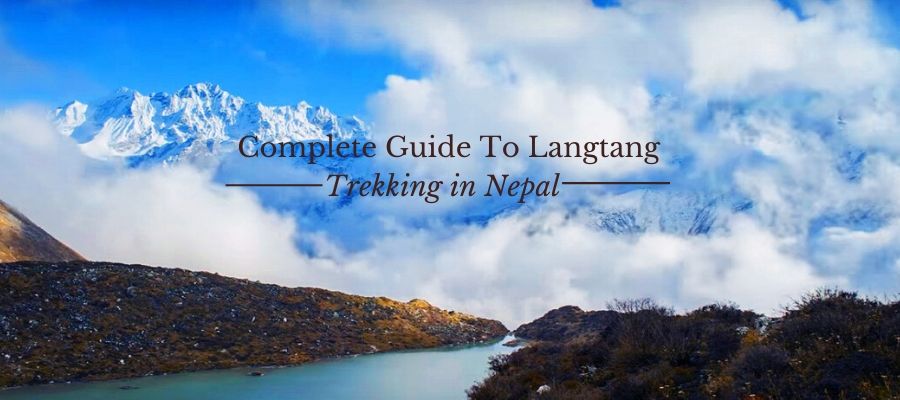
“The greatest legacy we can leave our children is happy memories”-Og Mandino
A complete guide to Langtang valley trek provides you the detailed information regarding the Langtang valley trek route & itinerary, best time to visit Langtang valley, food & accommodation on Langtang valley trek, trek difficulty & some useful tips. Make sure you read out to the end because we are saving best for the last. Langtang trek/Langtang valley trek is one of the most popular & trending off beaten trekking destination in Nepal. This Langtang valley trek walks you through the diverse landscapes, traditional Tamang villages, and the lush forest of bamboo, oaks & rhododendron along with the breathtaking views of snow-capped mountains.
Where is Langtang Valley located?
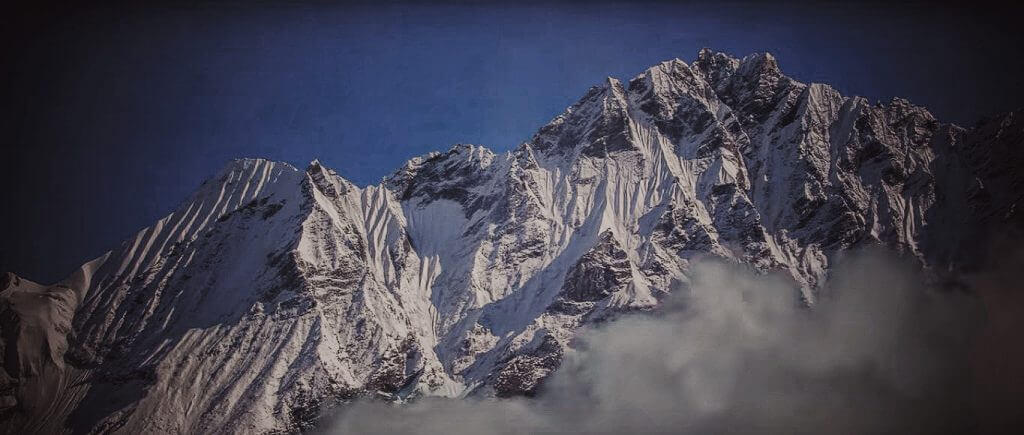
Langtang valley is located on the north of Kathmandu valley bordering with Tibet in the Himalayas of Nepal- exactly 51 km far from Kathmandu. It only takes a few hour short drive to reach the Langtang valley. Likewise, Langtang trek is famous for its low altitude & comparatively short & easy trek for all the beginner hikers . In addition, this trek is a perfect choice to escape from the capital’s busy lifestyle full of crowds & pollutions to enjoy nature.
Here are some Langtang Valley Trip Highlights :
– Spectating the mountains above 7000m like Langtang lirung (7,200m/23,622ft), Ganesh Himal (7,600m/24,934ft), Langtang II (7,227m/23,710ft). – Wander through the lush forests of pines, oaks & rhododendrons . – Experiencing the daily lifestyle of the Tamang community influenced by Tibetan culture & traditions . – Passing through the Langtang National Park (1976) – full of flora & fauna. – Excellent sunrise view over the Langtang range from Kyajin Ri or Tsergo Ri .
Trip Fact of Langtang :
Langtang Valley Trek after 2015 Earthquake in Nepal :
Sadly, Langtang valley was heavily affected by the 2015 earthquake in Nepal wiping out the entire valley completely. The earthquake took the lives of 175 villagers, 27 local tourism staffs and 41 foreign trekkers, summing up 243 in total which was very heart-breaking news. For several years, the trekking trails were still holding the potential threats of landslides which resulted in a decrease in tourists. However, over the years, Langtang valley is once again back-Teahouses and lodges have been once again rebuilt & are opened to fulfill the fooding & lodging for the trekkers. The local people have got supported by many organizations to withstand the losses. As a matter of fact, tourism is also one of them to support their lives in the future. Note: Contribute to the development of Langtang valley by visiting here which can help the local people to earn income.
How do I get from Kathmandu to Langtang Valley?
To reach the Langtang Valley from Kathmandu, your journey starts with a scenic 7-hour drive to Syabrubesi from Kathmandu. From there you will trek inside Langtang valley through high meadows, yak pastures, lush forests following the Langtang river until you get to Kyanjin Gompa. And there you will have the view of Langtang Lirung glacier & icefall. Also, visit the local yak cheese factory. On your 6 th day, hike to Kyanjin Ri or Tsergo Ri to catch a stunning 360° view of snow-capped Himalayan ranges. Be awed with views this trek offers you. Finally, following the same route, you will trek back down to the valley & drive to Kathmandu. Similarly, the Langtang trekking trail also cress-cross with other trekking routes like Tamang Heritage trail, Gosainkunda lake trek & Helambu trek.
How long is the Langtang Valley trek?
Here is the outline itinerary for Langtang Valley Trek :
- DAY 01: RECEIVED BY GUIDE ON ARRIVAL & TRANSFER TO HOTEL.
- DAY 02: DRIVE TO SYABRUBESI 1,460M – 07 HRS.
- DAY 03: TREK TO LAMA HOTEL 2,400M – 07 HRS.
- DAY 04: TREK TO LANGTANG VILLAGE 3,400M – 06 HRS.
- DAY 05: TREK TO KYANJIN GOMPA 3,800M – 04 HRS.
- DAY 06: HIKE TO KYANJIN RI 4,773M OR TSERGO RI 4,984M.
- DAY 07: TREK TO LAMA HOTEL – 07 HRS.
- DAY 08: TREK TO SYABRUBESI 1,460M – 06 HRS.
- DAY 09: DRIVE BACK TO KATHMANDU – 07 HRS.
- DAY 10: DEPARTURE FROM KATHMANDU TO HOME.
For the detailed itinerary, see the “Langtang Valley Trek”
What is the best time to trek in Langtang Valley?
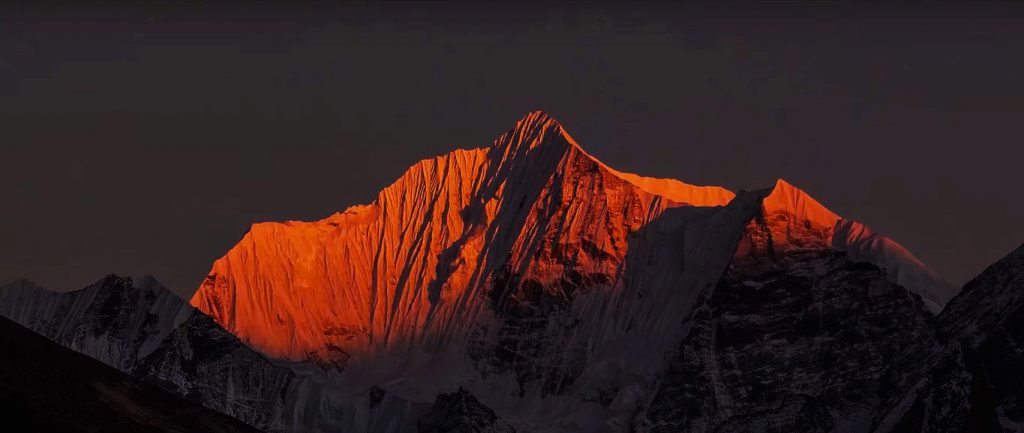
The best time to trek in Langtang Valley is during the Spring or during the Autumn season. This season is also called the peak trekking season in Nepal. Similarly, both of these seasons offers you the best view of Himalayan ranges with lush green vegetation all along the trek. Just get ready to blend with pristine nature & enjoy the jaw-dropping mountain views in this trek.
Below are the four main seasons to do Langtang Valley trek.
1) Langtang Valley Trek in Autumn (September to November)
The autumn season is the best time for experiencing the Langtang trek in Nepal. The autumn season starts soon after the end of monsoon clearing out all the dust & pollutions on the air. The temperature remains stable with crystal clear skies. Since there are very fewer trekkers in comparison to the Everest region, Annapurna region & Manaslu region, you don’t have to worry about finding accommodations in Langtang. Best Recommend Month: October
2) Langtang Valley Trek in Winter (December to February)
The weather in winter can be very challenging. Daytime is usually fresh and warm but during the night time, the temperature drops down to the freezing point. You will experience the snowfall on most parts of the Langtang region. If you are planning for Langtang trek during winter then make sure you pack your extra warm clothes.
3) Langtang Valley Trek in Spring (March to May)
Spring is another big trekking season in Nepal. The trail is exceptionally beautiful as the wildflowers start to bloom everywhere & the temperature remains stable i.e neither cold nor hot. The days are warm and long with the clear blue sky which makes it perfect to take stunning landscape photos. Recommend Month: April
5) Langtang Valley Trek in Summer (June to August)
Summer is the hottest as well as the monsoon season in Nepal. Rainfall usually happens on a daily basis. The trekking trails are all muddy and you will find leeches and bugs everywhere all along the trek. However, the most beautiful part during Summer/Monsoon is that you can enjoy the farming and planting along with the locals in Langtang valley.
“Join the Langtang Trek in best season”
Permits for Langtang Valley trek :
It is no surprise that every trekking region in Nepal requires permits. And depending upon the trekking region the permits are different. With that being said, you need two different permits for Langtang valley trek: TIMS & Langtang National Park entry permit.
Here are the permits name and cost of those permits required for Langtang valley trek:
TIMS Card (Trekkers Information Management System) :
- Individual Trekker : NRS. 2000 / $20
- Organized group/TIMS : NRS. 1000 / $10
- SAARC Nationals : NRS. 600 / $6
Langtang National Park Entry Permit :
For any treks within the Langtang regions, you trek via Langtang National Park. Hence you require a special National Park entry permit too.
- For foreigners: 3,000 NPR
- For SAARC Nationals: 1500 NPR
- Free for children less than 10 years of age.
Accommodation during Langtang Valley trek:
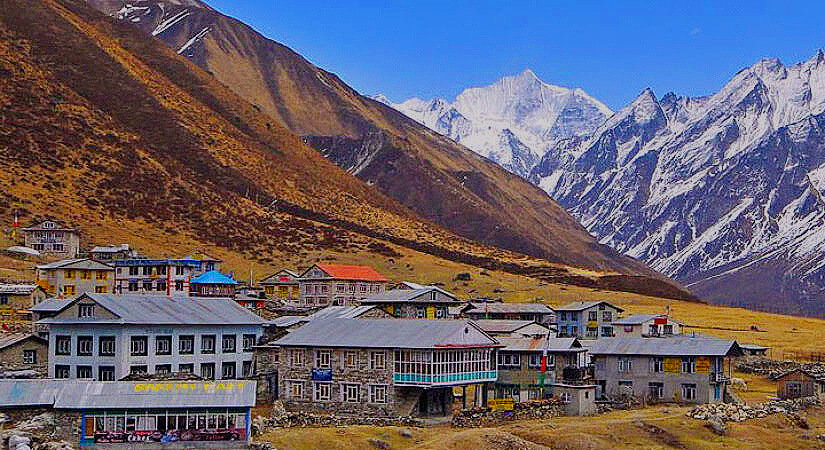
The Langtang valley trek has a good quality of tea houses and trekkers won’t have any difficulties to find a comfortable place to sleep and have a good meal. As other treks, Langtang trek accommodation also changes according to the altitude level. The details of the different types of accommodation that can be found in the Langtang trek are given below;
Accommodation in Syabru Besi :
After a drive from Kathmandu, Syabru Besi is the starting point of this Langtang trek. Accommodation available in Syabru Besi is basic to a standard that costs from $3-$30. And of course, the choice of hotels is always according to your budget.
Some of the guest houses found in Syabru Besi is;
- Yala Peak Guest House
Accommodation in Lama Hotel:
Lama Hotel has very few and satisfying guest houses which are the basic guesthouses. Basically, rooms are available on a twin basis with no attached bathroom. In addition, toilets are normally outside the guest houses which are for all the trekkers. As a matter of fact, all the guesthouses provide a hot shower facility.
The name of the guest houses found in Lama Hotel are;
- Sherpa Hotel and Lodge
- Friendly Guest House
- Lama Guesthouse
Accommodation in Langtang Village:
Before the earthquake 2015, Langtang village was always trekker favorite station. This beautiful village used to have lots of accommodation facilities from basic to standard and also trekker could get a chance to enjoy the culture and the natural beauty at the same time. However, after earthquake locals have succeeded to build new guest houses for trekkers with basic services which are very comfortable.
Guesthouses at the Langtang Villages are as follow;
- Everest Guest House
- Hotel Moonlight
- Buddha Guest House
- Village View Hotel
- Shangri La Hotel
- Lucky Guest House
- Peaceful Guest House
- Hotel Red Panda
- Himalayan Guest House
- Sunrise Guest House
- Eco Guest House
- Tashi Delek Guest House
- Tibetan Guest House
Accommodation in Kang Jin Gompa:
The highest point (3900m) of this Langtang trek is Kang Jin Gompa. Here, trekkers can find a very basic type of accommodation. Also, the rooms are twin basis and trekkers have to use a common toilet outside the guest house in a separate hut.
The name of guest houses in Kang Jin Gompa are listed below;
- Yeti Guest House
- Hotel Sherpa
- Nurling Kyangjin
- Hotel View Point
Trekkers will find the rooms clean and comfortable in each and every guest house of Langtang valley. In the peak season, trekkers may not get the room. So, if you’re trekking in the peak season then don’t forget to pre-book the rooms. Whereas, the local and authorities from Langtang National Park have fixed the price for accommodation from Syabru Besi to Kang Jin Gompa i.e $5-$10. In addition, the price of the accommodation may get expensive in peak season in comparison to offseason. Guesthouses even may give trekkers a discount in off-seasons.
Foods in Langtang Valley Trekking Trails:
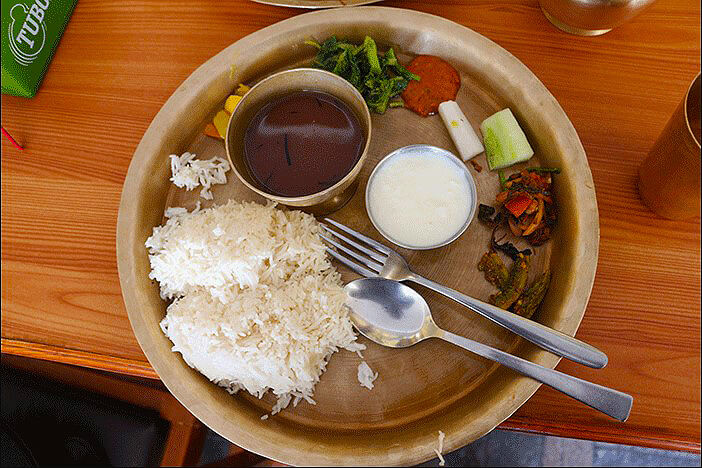
After accommodation, the most asked questions before this Langtang trek is about the food.
Here, we will discuss the various foods and drinks available in this trekking trail.
Along with good accommodation, Langtang trekking trail provides trekkers a healthy breakfast, lunch, and dinner. Foods are suitable for a vegetarian with both alcoholic and non-alcoholic options.
Breakfast in Langtang Valley:
Here, in Langtang trek, the menu for the breakfast is similar in all the guest houses. Basically, breakfast is served from 7 am-9 am which might be the perfect timing for having breakfast and start the trek. Trekkers can also find organic food items and veggies.
The list of the food for breakfast found in Langtang is listed below;
- Bread and Chapati
- Porridge and Puddings
Lunch in Langtang Valley:
The national food of Nepal Dal Bhat and Tarkari is very popular as a lunch set among the trekkers and is very cheap in comparison to other lunch options. Whereas, trekkers also can find lots of western food items as lunch options. Most of the lunch station prepares carbohydrate-rich foods so that trekkers can get enough calories which are very necessary during trekking.
Here are the food items found as a lunch option in Langtang region;
- Pasta and Macaroni
- Momos/Dumplings
- Potato items
Dinner in Langtang Valley:
All the guesthouses offer you a hot and freshly cooked dinner which keeps you warm near the mountains. Normally, guest houses serve dinner at 9 pm. In addition, options for the dinner are similar to the lunch menu. We personally refer you to choose Nepali Dal Bhat and Tarkari as it is healthy. If you don’t like Nepali food than you can find lots of other options which are suitable for both vegetarian and non-vegetarian.
Drinks in Langtang Valley:
Along with food guest houses provides lots of drinking options. Even though the alcoholic drink is also found, it is better to avoid those drinks because it decreases the water level of the body resulting in dehydration.
The list of drinks is listed below;
- Honey Lemon/Ginger Honey Lemon
- Coco-Cola/Fanta/Sprite
- Mineral water
- Different fruit juice
The price of food keeps increasing as you ascend higher and higher. If you paid $2-$3 for food in Syabrubesi you might have to pay $6-$7 at Kyanjin Gompa for the same food. Similarly, trekkers also should take good care of their health by keeping healthy habits like; washing hands or using hand sanitizers. Trekkers should always use a water purification system while drinking the water from the tap too.
Langtang Valley Trek Difficulty :

According to the difficulty level, Langtang valley is a moderate trek and requires no previous trekking experiences, age limitation or physical requirements. Basically, the Langtang trail is a combo of uphill and downhill routes along with the steep path. And, most part of the trek will be done at a lower altitude. With a basic fitness level, anyone can overcome the Langtang trek difficulty & accomplish the trek. However, the difficulty of trekking in Nepal is determined by various factors that apply to the Langtang trek as well.
Langtang Valley Trek Difficulty by Weather :
Weather plays a major role in determining the difficulty of Langtang trek. As mentioned above, the different season offers you their own- distinct charm & beauty. Choosing a wrong month (August-rainy & January-coldest) can simply ruin your Langtang trek experience. So decide what time of the year you want to go for Langtang trek & prepare accordingly. Whereas, Autumn and the spring season is the very best time where you can easily and fully experience the Langtang trek. “Trek underneath the crystal clear blue skies while enjoying the panoramic mountain scene to the fullest.” And as for Monsoon and Autumn season, you need to have extra preparation. Don’t forget to pack a raincoat or waterproof clothing set to tackle monsoon downpour and extra warm clothes to stay away from the winter cold.
Langtang Valley Trek Difficulty by Cost:
Not only a short trek but at the same time Langtang valley is considered the low price trek also. We are offering you 10 days Langtang trek at just USD 590 per person with full board meals included. The Langtang trek cost depends upon the modes of transportation used, duration of the trek, services you want to include and exclude in addition to the extension of trekking days along with other optional hikes.
Langtang Valley Trek Difficulty by Physical Fitness :
Being one of the short and moderate level treks, it does not require trekking skills and high physical training. However, if you are a beginner, you should be always prepared for any circumstances that can happen during the trek. You have to walk 5-6 hours on a daily basis via uphill and downhill, rocky paths, jungles, and rivers. Hence before hitting the trail strengthens your legs since trekking is all done by walking.
Tips to reduce the difficulty of Langtang trek :
- Choose the best weather
- Pack proper gears and clothing
- Make sure your shoes are comfortable
- Eat properly and stay hydrated
- Follow your trekking guide
Altitude Sickness during Langtang trek :
When trekking in Langtang valley, the max altitude you will gain is 3,800m (Kyanjin Gompa) excluding short optional hike to Kyanjin Ri (4,773m) or Tsergo Ri (4,984m). Hence, the chance of getting altitude sickness is very low during the trek. However you should not take altitude sickness lightly. In a worst-case scenario, altitude sickness can cost your life too.
Here are the symptoms of Altitude sickness:
- Headache followed by dizziness
- Nausea & Vomiting
- Weakness or muscle fatigue
- Irritability
- Difficult to breath
- Insomnia (difficulty in sleeping)
- Loss of appetite
- Read full article on altitude sickness.
If you find any of the above signs and symptoms quickly descend down at lower altitude or notify your guide.
Things to pack for Langtang Valley Trek:
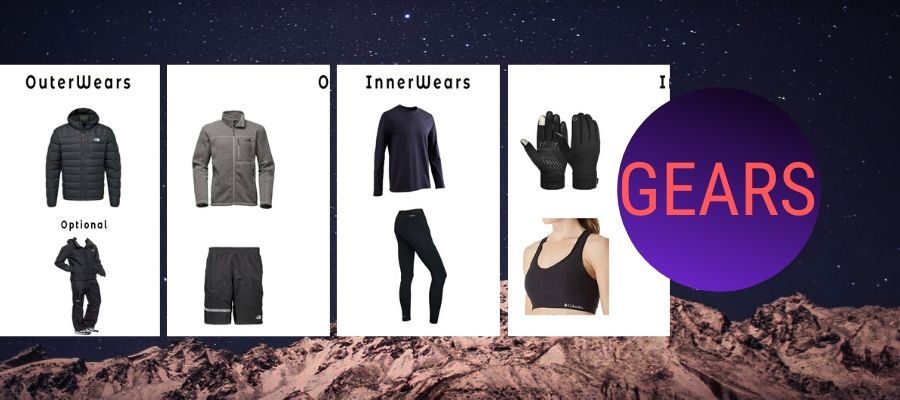
The packing list depends on the time of the year you are doing Langtang trek. Generally, no specialized trekking gear and equipment is needed for this trek.
Below is the essential packing list for Langtang trek:
Duffel bags – 50-60 Ltrs Daypack – 20-25 Ltrs
-Cap or Hat -Neckband or Buff -Sunglasses
-Wicking long-sleeve T-shirts / 2 pairs -Quick-dry T-shirts / 2 pairs -Bra / 3 Pairs (sports bra recommended) -Thermal underwear / 2 pairs -Underwear / 4 pairs -Fleece Jackets / 2 pairs -Insulated Jacket or Down Jacket / 1 pair (Can be rented ) -Insulated trekking pants / 2 pairs -1 pair of waterproof jackets & pants on your bag.
-Hiking boots / 1 pair -Spare shoe / 1 pair -Camp shoe or sandal / 1 pair -Woolen hiking socks / 4 pairs -Shorts (optional) -Gaiters (optional)
-Inner gloves -Outer gloves
Sleeping Bags:
-Four-season sleeping bag rated to -15°C. (can be rented)
Important Accessories:
-Trekking Poles -Water Bottle -Basic Medical Kits -UV Protection Sunglasses -Headlamp -Hand Sanitizers -Sunscreen/Lip Balm -Trekking Towels -Portable Chargers
Our guides will always carry basic first aid kit with some other essential medical kit & basic toiletries
-Diamox (for altitude sickness) -Advil (pain-killer) -Aspirin (to reduce fever, headache, etc) -Pulse Oximeters -Antibiotics (for diarrhea) -Lung inhaler -Water Purifier -Hand Sanitizer -Deodorant -Wet Wipes -Soap -Body lotion -Nostril openers -Bandages
Frequently Asked Questions :
Is Langtang valley trek safe for solo/individual trekkers?
Being a short and moderate trek, Langtang valley trek is possible and safe for solo/individual trekkers. The trail is not confusing and on top of that, there are several signposts along the trail. But there are many cases of missing too.
Do I need travel insurance for Langtang valley trek?
Not necessarily but it is always best to have one especially while you are trekking in Nepal. High altitude trek revolves around risk and other dangers, therefore, recommended having travel insurance.
What about drinking water during Langtang valley trek?
Since the bottled water is expensive on the trail, we suggest you carry your bottle and fill the water in teahouses. Please avoid drinking water directly from taps and streams until and unless you treat with water purifier or steripen.
About Author
As the head of Pristine Nepal Treks and Expedition, he is the inspiration for all the young generation who wants to work in the trekking field. As he is working in the tourism/trekking field from a young age he is always interested to learn and exploring more about the Himalayas, Culture, History, and politics too.
With a very friendly nature, smart personality, and kindness he is an expert in the tourism sector and has already organized countless trekking trips and going on.
(1) Comment
thanks for the great article, keep up the good work
Leave a Reply Cancel reply
You must be logged in to post a comment.

Langtang Valley Trek
Langtang valley trek overview.
While there are plenty of places to visit in Nepal, we want to tell you that only a few of them will provide you with a truly fulfilling adventure experience in a short amount of time. Among those few, we have to say that the Langtang Valley trek is one of them. As this destination is near and dear to the capital city Kathmandu, it has been able to gather the attention and interests of both international and local tourists. Due to its exceptionally beautiful scenes and landscapes, there is no doubt that this trek gets high appreciation from all of the trekkers.
To be specific, this journey will be highly enjoyed by those who want to explore the rough and off-the-beaten path that goes through the mesmerizing forest routes finally leading to the beautiful mountains. Especially, we highly recommend this trek for those who are coming to this country for the first time.
Introduction
Known as the “Valley of Glaciers,” the Langtang Valley is a fantastic place that features tall snow-capped peaks, lush alpine meadows, and thick rhododendron woods. This trek is more than simply a physical adventure, it’s an adventure through the magnificent Langtang National Park , where rivers sparkle, waterfalls plummet, and the aroma of Himalayan flora penetrates the air.
You will learn more about the ancient Tamang and Tibetan villages’ rich cultural artwork as you continue on the path. While visiting these villages, you will find that each village is a unique chapter, which reveals the customs, traditions, and warm hospitality of the locals. From ancient monasteries echoing with spirituality to the vibrant celebrations of traditional festivals, Langtang Valley undoubtedly has a dynamic display of Himalayan culture.
Wildlife enthusiasts can also try to glimpse the elusive red panda, the Himalayan tahr, and a variety of bird species by trekking the special trail in Langtang National Park. In addition to being physically tiring, the trek strengthens one’s bond with the natural environment and incorporates wildlife observation into the experience.
Meanwhile, these are the additional features of the trek, specifically you have to be prepared yourself to be mesmerized by the panoramic views that will greet you at every turn. As guardians, peaks such as Langtang Lirung, Ganesh Himal, and Dorje Lakpa spread their shadows across the wild terrain of the Langtang region. Along with this beautiful background, the trek offers the opportunity to see the breathtaking panorama from Kyanjin Ri, which changes the Himalayan landscape into everchanging colors.
Therefore, the trek goes over 8 days, covering 65-75 kilometers within 6 days. While adventuring throughout these days, you will be guided through picturesque villages such as Langtang and Kyanjin Gompa. Passing through these trails will offer you a balanced challenge, with gradual ascents and descents that serve well for both experienced trekkers and those seeking a thrilling introduction to the Himalayan trails. So as we have introduced our trek, it’s time to deep dive into the further specifics of the trek. So without wasting any time, let’s get started-
Trip Highlights:
- See the beautiful Langtang Valley, a picturesque Tibetan-influenced village.
- Immerse yourself in the culture by staying in homestays, offering an authentic experience with Tamang and Sherpa families.
- Keep an eye out for diverse flora and fauna in Langtang National Park, including red pandas, Himalayan tahr, and various bird species.
- Encounter Buddhist stupas and prayer flags, adding a spiritual and visual dimension to the trek.
- Ascend to Tserko Ri or Kyanjing Ri for the Amazing views of the nearby mountains.
- Explore the local cheese factory in the village.
- Peaceful trails throughout the route.
- Spend the night in the local teahouses interacting with amazing locals.
Is the Langtang Valley trek really difficult?
The difficulty of the Langtang Valley Trek can vary depending on individual fitness levels, experience in trekking, and the specific route taken. Generally, the Langtang Valley Trek is considered to be of moderate difficulty, making it accessible to a wide range of trekkers, including those with some trekking experience and even to people with no experience at all.
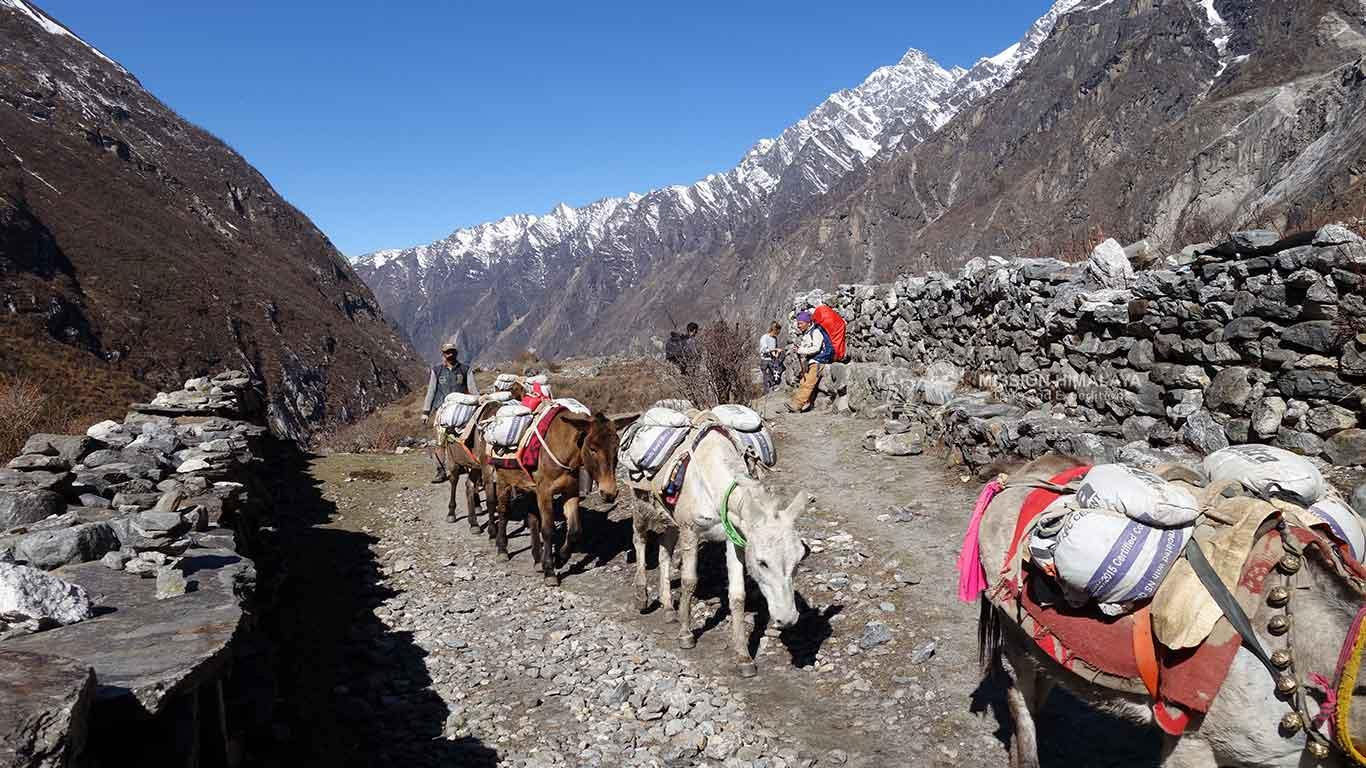
The trek takes you through a variety of landscapes, including lush forests, terraced fields, and high-altitude alpine meadows. While it doesn’t involve technical climbing, there are steep ascents and descents, and the altitude can be a factor of difficulty for some people. Remember that the highest point on this Langtang Valley Trek is Kyanjin Ri (4,773 meters or 15,655 feet), which is considered a high-altitude spot. From here, you can capture the stunning panoramic views of the surrounding peaks.
From where does the trek to Langtang Valley begin?
The trek to Langtang Valley typically begins in Syabrubesi, which is a scenic village located in the Rasuwa District of Nepal. Syabrubesi serves as the starting point for the Langtang Valley trek and is accessible by road from Kathmandu. Trekkers often take a bus or private transport from Kathmandu to Syabrubesi, and from there, they commence their trek towards the Langtang Valley. Therefore, in the same way, we will be taking a drive to Syabrubesi from Kathmandu. The trail passes through picturesque landscapes, charming villages, and diverse terrain as it gradually ascends toward the heart of the Langtang region.
Is Langtang Valley worth it?
Langtang Valley is worth a visit for those seeking a breathtaking blend of natural beauty and cultural richness. It offers a combination of stunning natural beauty, diverse landscapes, and rich cultural experiences. The panoramic views of snow-capped Himalayan peaks, interactions with local communities, and the trek’s varied terrain make it a rewarding adventure.

Additionally, Langtang Valley is less crowded than some other trekking destinations in Nepal. So, surely, it provides a more intimate and authentic experience. Therefore, we ensure that whether you’re a nature enthusiast, cultural explorer, or adventure seeker, the Langtang Valley trek will offer you a well-rounded and memorable journey.
When you should do the Langtang Valley trek for the best experience?
For the most rewarding experience, doing the Langtang Valley trek is highly recommended during the spring (March to May) and autumn (September to November) seasons.
Spring (March to May)
This season brings a delightful transformation to the Langtang Valley. The trail appears alive and well with rhododendron blossoms in bloom, which create a vibrant mosaic against a background of rich greenery of the region. Also, the weather remains mild and stable, with daytime temperatures ranging from 10 to 20 degrees Celsius (50 to 68 degrees Fahrenheit). Furthermore, in this season, clear skies will also provide crystal-clear views of the snow-capped peaks, making it an optimal time for trekkers who appreciate both vibrant landscapes and panoramic mountain vistas.
Autumn (September to November)
As the monsoon retreats, autumn shows a period of stable and dry weather. Like in the spring, the skies are clear in the autumn, offering unparalleled visibility of the Himalayan range. Particularly in this season, the daytime temperatures in this season hover between 10 to 15 degrees Celsius (50 to 59 degrees Fahrenheit) in higher altitudes. Further, the trekking trails are at their busiest during this season as they provide an ideal combination of pleasant weather and breathtaking scenery.
If we talk about the monsoon, then we advise you to avoid the monsoon season (June to August) due to heavy rainfall. Heavy rainfall in this season can lead to muddy and slippery trails, landslides, and limited visibility. Furthermore, winter (December to February) brings colder temperatures and occasional snowfall. So it makes the trek more challenging and requires proper cold-weather gear. Therefore, choosing the right season ensures that trekkers can fully enjoy the natural beauty and cultural richness of the Langtang Valley.
Langtang Valley Trek Itinerary
Day 1: kathmandu to syabrubesi.
Walking Hours: 8 Hours Driving
Meals Included: Breakfast, Lunch And Dinner
Accommodation: Tea House/ Lodge
On this first day of the trek, we leave bustling Kathmandu early in the morning and move to the starting point of our trek – Syabrubesi.
On this trip, you will enjoy seven hours of scenic driving along the Trishuli highway, driving through beautiful small villages, river valleys, and mountains. After passing the entrance gate to the Langtang National Park, the road then changes to offroad. We will arrive at the Syabrubesi village crossing the Dhunche headquarters of the Rasuwa. After journeying for about 7 hours, and then we will rest and prepare for tomorrow’s trek.
Day 2: Trek to Lama Hotel
Walking Hours: 5 To 6 Hour Trekking
Our journey today will begin with a slight three-hour ascent through a subtropical, deciduous, slightly higher-than pine and rhododendron forest upstream to the village of Bambus, where we will stop for lunch. If we’re lucky, we may come across Langur monkeys along the way. From here we will again climb steeply through the bamboo forest to our destination the Lama Hotel. Overnight at the Lama Hotel.
Day 3: Lama Hotel to Langtang Village
Walking Hours: 6 Hour Trekking
After having breakfast here at lama hotel, we will have a slight ascent through rhododendrons and pine forests upstream taking us around small villages, to the village of Ghoda Tabela, where we stop for lunch.
Then the landscape turns into a U-shaped glacial valley here. After lunch, we will continue along a scenic trail that includes a tree line and the magical views of the Langtang Lirung Peak. After passing through these, the route will then take us to the Langtang Valley. The Tibetan-style village of Langtang was destroyed by a massive catastrophe caused by an earthquake in April 2015. Overnight at the Langtang Village.
Day 4: Lama Hotel to Kyanjin Gompa
Walking Hours: 7 Hours Trek
Today will be a less demanding trek and at a calmer pace. Especially through the picturesque villages and herds of yaks, we reach the Kyangjin Gomba. If the weather permits us, we will have wonderful views of Ganchempo Mountain and Langtang Lirung. We will have time to relax, walk to the glacier, or visit the Yak cheese Factory, Kyanjin Monastery, or local houses. This will be the highest point of the trek so you will have plenty of opportunities to witness the scenery nearby. Overnight at the lodge in Kyanjing Gompa.
Day 5: Kyanjin Gompa
Today we have to climb the ridge of the mountain Kyanjin Ri 4300 m. After climbing the summit, we will witness the amazing view of the Langtang Mountains, including Langtang Lirung (7227 m), and Dorje Lhakpa (6966 m). Along with these peaks, you will also be able to see the beautiful Langsisa Ri Mountain (6560 m), Ganjala Peak, Yala Peak, and many other peaks.
If possible, we will continue to the top of Tsherko Ri 4986 m, where you will get an even better view of the Langtang Mountains, from which you will have a 360-degree view of the surrounding mountains and the top of Mount Yala. After climbing to any of these points, you will descend to Kyanjin Gompa and rest. Furthermore, while climbing to the top is voluntary, you can also spend the day walking with amazing views around Kyanjin Gompa and enjoying the snow-capped mountains and the warm sun. Overnight again in Kyanjing Gompa.
Day 6: Descend Lama Hotel
On this sixth day of the trek, we will return to the Lama Hotel. After breakfast, we will descend from Kyanjin Gompa through the Langtang Valley to Ghoda Tabela, where we will have lunch. From here, we will have another two hours of descent through the Langtang Khola River valley to the Lama Hotel. Along the way, the view of the 7,000-meter Langtang Mountain will accompany us. Overnight at the Lama Hotel.
Trek extension – Gosaikunda Lake. The trek continues through Thulo Shyaphru and will take you to the sacred lakes of Gosaikunda. If you choose to do the Gosaikunda Lake trek , the trek will be extended for about 7 days. We recommend extending the route, especially in spring, when you will be attracted by birds and flowers, blooming rhododendrons with a lush and green landscape.
Day 7: Syabrubesi
Today is the last day of our journey together. Half an hour after leaving the Lama Hotel, we will disconnect from the village of Rimche and head up the beautiful rhododendron forests to the typical Sherpa village of Syabrubesi. While descending, we will see snowy peaks in Tibet. Finally, after we descend to our destination Syabrubesi, we will celebrate our successful journey. Overnight at the lodge in Syabrubesi.
Day 8: Transfer to Kathmandu
Meals Included: Breakfast And Lunch
Accommodation: 3 Star Category Hotel
Today we will return to the capital by local bus. After having a continuous 8-hour drive, we will arrive in Kathmandu in the late afternoon.
Langtang Valley Trek Cost
- One strong porter with pay for food, lodging, insurance, and transportation.
- Pickups and drop-offs from airports and hotels.
- Accommodations: Twin-share teahouses on the trek and a 3-star hotel stay while in Kathmandu.
- Full-time meals along the trek and breakfast in Kathmandu.
- Welcome and farewell dinners.
- Down jacket, and a four-season sleeping bag (the down jacket and sleeping bag must be returned when the trip is over).
- A comprehensive medical kit.
- All necessary paperwork and permits.
- All relevant fees, including taxes and service costs.
- Private transportation in a welcoming car.
- English-speaking, professionally qualified, and experienced guide giving pay, lodging, food, and insurance.
- If your group consists of six or more people, an additional assistant trekking guide will be assigned.
- Nepal Entry Visa Fees.
- Other meals and beverages rather than compared to an itinerary.
- International travel to and from Nepal.
- Excess baggage charges.
- Evening and lunch meals in Kathmandu.
- Extra night(s) of lodging.
- Travel Insurance.
- Personal expenses (phone calls, laundry, bar bills, battery recharge, extra porters, bottle or boiled water, hot shower, heater charge, etc.).
- Tips for guides and porters.
- The services that are not included under "Cost Included".
Langtang Valley Trek Map

Langtang Valley Trek Support
How to prepare for the langtang valley trek.
Doing the Langtang Valley trek in Nepal promises an unforgettable journey through spectacular trails. However, the trek’s challenges, including varying altitudes and unpredictable weather, necessitate thorough preparation. So for that reason in this section, we’ll explore essential steps to ensure a safe and enjoyable trek. From physical fitness training to obtaining permits, packing smartly, and understanding local customs we will explore through all of it. So, now let’s delve into the details of this trip so that you get fully excited for the adventure of a lifetime.
Physical Fitness Training
Initiate a fitness training routine well in advance. Focus on cardiovascular exercises, strength training, and endurance activities to prepare your body for the physical demands of trekking in varied terrains and altitudes.
Trekking Gear Checklist
Create a comprehensive checklist of necessary trekking gear. Ensure your equipment is in good condition, including well-fitted trekking boots, layered clothing suitable for diverse weather conditions, a comfortable backpack, and a cold-weather sleeping bag.
Permits and Documentation
Prepare all of the necessary documents required to obtain the required permits for the Langtang Valley trek. As we are gonna manage everything for you, make sure that you make photocopies of the documents and keep them in a secure place.
Health Check-up
Schedule a pre-trek health check-up with a healthcare professional. Discuss your travel plans, and ensure you are physically fit for high-altitude trekking. Obtain any necessary vaccinations and medications.
Travel Insurance
Secure comprehensive travel insurance that covers trekking activities at high altitudes. Confirm that the policy includes emergency evacuation coverage in case of unforeseen circumstances.
Opt for lightweight and compact gear to reduce the weight of your backpack. Prioritize essential items, and avoid unnecessary belongings. Pack smartly to ensure comfort during the trek.
Money and Currency
Carry enough local currency for expenses along the way, as there might be limited access to ATMs in remote areas. Inform your bank about your travel dates to prevent any issues with card transactions.
Language and Cultural Preparation
Learn basic Nepali phrases to facilitate communication with locals. Acquaint yourself with the local customs and cultural norms to show respect and understanding during your trek.
Emergency Contacts
Compile a list of emergency contacts, including the contact information of local authorities, your embassy, and someone back home. Share your itinerary with a trusted friend or family member.
Therefore, by diligently preparing for the Langtang Valley trek, you increase your chances of having a safe, enjoyable, and fulfilling trekking experience amidst the breathtaking landscapes of the Himalayas.
Accommodation Facilities in Langtang Valley Trek
The Langtang Valley trek offers a range of accommodation options, primarily in the form of teahouses or lodges along the trail. These facilities provide trekkers with essential amenities for a comfortable stay amidst the stunning Himalayan landscapes.
1. Teahouses/Lodges:
Teahouses are simple lodgings equipped with basic amenities. These establishments often have communal dining areas where trekkers can socialize, share stories, and enjoy warm meals. So, expect clean beds, blankets, and shared bathrooms with cold water on this trek.
2. Room Options:
Teahouses typically offer single and double rooms. Double rooms may have twin beds or a double bed, with shared or attached bathrooms. Every bed will include a pillow, mattress, and blankets, as these are necessities for a bedroom.
3. Common Areas:
Generally, teahouses often have common rooms with heating, providing a cozy space for trekkers to relax and relax. Outdoor spaces with panoramic views allow travelers to enjoy the natural beauty of the Langtang Valley.
4. Hot Showers and Charging Facilities:
While hot showers may not be available at all teahouses, some do offer them for an additional fee. Charging facilities for electronic devices are available in Syaprubesi and Langtang Valley. This allows trekkers to stay connected during the trek.
5. Blankets and Sleeping Bags:
Accommodation along the Langtang Valley trek provides a unique opportunity to experience the warmth of Nepali hospitality while immersing yourself in the natural beauty of the Himalayas. Trekkers are encouraged to be flexible and embrace the simplicity of teahouse living for a truly authentic trekking experience. Teahouses typically provide blankets, but it’s advisable to bring your sleeping bag for added warmth, especially at higher elevations.
Food and drinks in Langtang Valley trek
Keep in mind that the food menu becomes simpler the more difficult it is to get to. Anywhere throughout the trek, tea houses have one thing in common: their menus are all identical, with dishes like Dal Bhat, noodles, potatoes, and soups. These products are available throughout the trek.
- Tea or Coffee: Most teahouses and lodges will offer tea or coffee to kickstart your day.
- Porridge: A warm and hearty bowl of oat or rice porridge might be available, providing energy for the day ahead.
- Eggs: You may have egg options in the lower altitudes.
- Bread and Jam: Simple options like toast with jam or honey are common in the teahouses.
- Pancakes or Chapati: Mainly in the teahouses, you will find pancakes or chapati (flatbread).
- Dal Bhat: A traditional Nepali meal consisting of lentil soup (dal), rice, and side dishes like vegetables (radish curry), pickles, and meat in lower altitudes.
- Noodles: Many teahouses serve a variety of noodles.
- Soups: Warm soups, especially vegetable or noodle soup, are commonly available.
- Momos: These delicious Nepali dumplings, filled with vegetables, are a popular lunchtime snack.
- Rice and Curry: Similar to lunch, you might have rice with a variety of curries, including vegetables, chicken, or yak.
- Local Specialties: Teahouses often showcase local specialties, allowing you to try different regional dishes.
- Quinoa or Buckwheat: At higher altitudes, you might find alternatives to rice and wheat, such as quinoa or buckwheat.
- Hot Drinks: Wrap up your day with a warm beverage like herbal tea or coffee.
Remember that the availability of specific dishes can vary, and the altitude and remoteness of the trekking route may influence menus. Further, it is also crucial to stay hydrated, so make sure to drink plenty of water or other hydrating beverages such as tea, coffee, and hot lemon, throughout the day. A few of your favorite snacks and energy bars are a great option to pack for your hike to provide you with extra energy and quick snacking.
Permits required for Langtang Valley Trek
To preserve the natural environment and cultural heritage, the Langtang Valley Trek in Nepal requires several permissions. Ensuring you comply with local legislation is also a formality. The primary permits that you’ll need are as follows:
- Langtang National Park Entry Permit: The entry permit for Langtang National Park is a requirement to access the park. This permit can be obtained in Kathmandu or at Syabru Besi’s park gate. Furthermore, this permit is valid for the whole length of your trek and contributes to the region’s conservation work.
- TIMS (Trekkers’ Information Management System) Card: Many treks in Nepal no longer require the TIMS card. In its place, more specialized national park permits are now required. But in the case of the Langtang Valley trek, it requires a TIMS Card.
You don’t need to stress about the procedure for obtaining these permits while engaging us. Still, to secure the required permits, you must give us the specifics and photocopies of the necessary documents. Therefore, know that these permits guarantee that you adhere to regional laws while also helping to protect the Langtang region’s natural and cultural assets.
Information on the medical facilities available along the Trek
There aren’t as many medical facilities here as in more developed locations. However, the following basic medical services and amenities are accessible throughout the trail:
- Local Health Posts and Clinics: You’ll find neighborhood health posts or limited clinics in a number of the settlements along the journey. These can provide you with basic first aid along with common medicines. Medical professionals typically run these clinics in the region.
- Emergency Services: If there are any problems and you need to arrange for an evacuation, we will aid you with the support of the locals and our staff. In more extreme situations, helicopter evacuations are an option, although they can be costly and weather-dependent.
- Kathmandu: If you have any issues, it is recommended that you see your doctor and have a comprehensive physical examination before starting the Langtang Valley Trek. If you want, you can use medical services in Kathmandu’s modern hospitals and medical institutions.
The Langtang region is a safe escape for those who love the outdoors as well as a location to experience the friendliness and customs of the surrounding people. Further, we want to tell that those who want to experience the surroundings of hills to mountains will find this journey as a go-to journey. Later, on the trip with the soaring snowy peaks around you, will find this journey to be more exciting and curious.
Along with overcoming difficult terrain, finishing this trek allows you to establish a spiritual connection with the Himalayas. We assure you that you will always cherish the memories and experiences you had on this journey. With us, you can rest assured, as we always offer our best to the clients we work with. Therefore, we would like to take this opportunity to offer you this amazing excursion through the Langtang region’s alpine adventure. Whether you are an experienced adventurer or planning your first adventure trip, never forget that we are here to assist you.
Langtang Valley Trek FAQ'S
Why not. Our itinerary tailor expert from Mission Himalayan Treks and Expedition will modify the itinerary. Please feel free to contact us if you’d like to personalize your Langtang Valley Trek schedule.
Buses and microbuses are available every morning in Machhapokhari, Kathmandu. It will be comfortable in buses rather than small microbus.
Without any doubt, you can proceed to explore the Langtang region. Since the region of Langtang is not a part of Nepal’s restricted area, most of the trekkers grasp this destination in their solo trekking spot. However, it will be better if you trek with a guide.
Finding the right track might be difficult, and you may become disoriented. The trails are extremely perplexing, with several paths leading through impenetrable woodlands. As a result, you must exercise extreme caution while taking a step to a new trail.
Allocate a budget up to USD $550 to $600 per individual. The prices for permits, public vehicle transportation tickets, and payment for hotels are included. However, you must pay an additional charge for a personal vehicle ride, charging electrons, wifi, hot shower, and hot drinking water.
Yes, you need to apply for two permits i.e Trekkers Information Management System (TIMS) and Langtang National Park entrance permit which can be applied from a trusted trekking company.
Due to the snowstorm and 2015’s earthquake, the Langtang village has been devastated, where 310 dead bodies were found and more than 100 are still missing.
You can get SIMs in Kathmandu so that you can get engaged with your loved one. In Addition, most of the hotels provide wifi facilities to the guest with extra charge.
Some of the prior trekkers have shared their experience as they got caught by altitude sickness. That’s why we recommend you to know about altitude symptoms and its quick prevention. Don’t neglect your health if you suffer from altitude sickness.
It is not compulsory to have travel insurance but you might get encountered by unforeseen incidents. Such as heavy snowstorm, landslides, diarrhea, altitude sickness, and many other physical weaknesses and natural disasters. So, it will be your profit if you obtain travel insurance.
There is no ATM facility in Langtang. You must carry the needed funds in cash before proceeding with this trek.
Langtang Valley Trek Reviews

Wonderful Trekking Experience
I was very very happy to do Langtang and Everest Trek with Raj and his friends. Even the trekking was a little difficult for me the most experienced guide Raj Take care us very well no word to explain him simple thanks not enough. In the alternative, he explained the trekking routes, the culture of people and history always simply language and respectful. It was the amazing moment of my lifetime trip. I congrats all of Mission Himalaya Treks And Expeditions Teams. Wish you all the best and keep it up continuation. Faithful Rani, Indonesia
Best Experience of trekking in my life
Our guide Birendra Duwadi was amazing. He had lots of knowledge to share and helps us along our trek, Shyam was a reliable porter as well and together the 2 of them gave us the best trek whatever they can. At night Shyam prepares our fruits for deserts and guide Birendra explained to us about our next day plan of trekking fluently. Great Job Birendra And Shyam, would highly recommend this company Mission Himalaya.
Overall the trip was amazing
Langtang Trek-I really loved this Langtang trek with Mission Himalaya. I and my friend chose a group tour to Langtang, so we were a little team with guide Bam Gurung and two porters and we all had a really nice time together with them. In the daytime, we trekked in the beautiful nature, and in the afternoons and evenings we played card games called less than 5 or Nepali Name “Dhummal”. Read books and drank ginger lemon honey tea in the clean tea houses. We had a great trek in Nepal. Overall the trip was amazing.
My Happy trek to Langtang
I went trekking in Langtang in October 2018. Everything was perfect, stunning mountains, spectacular glaciers, beautiful rhododendrons the national flower of Nepal which has 32 different colors of red white and pink. I made a good choice of picking Birendra Duwadi as my trekking guide and tour guide. He is experienced, sincere and honest that gives me confidence and makes me enjoy during my stay in Nepal. Thank you Mission Himalaya treks and the whole team.
beauty Langtang trekking
Mission Himalaya Treks and Expeditions helped with a great professional tool for us and which we were well taken care of and got to see Nepal and all its beauty. We liked this Langtang trekking so much, that we will be returning them for another trek soon may be Manaslu or Everest. I do recommend very strongly for this trekking company who have the plan to go to Nepal.
coaches are comfortable and the prices totally reasonable
I am always traveling with this company in Nepal. The coaches are comfortable and the prices totally reasonable. The guides and porter are very helpful. This time I traveled Langtang Valley trekking.
Had a great experience in Nepal Langtang
I had a great experience in Nepal Langtang. A private car for us is in perfect condition. The driver is nice and polite. The guide was very helpful in answering all my questions. I will definitely use this company again and highly recommended it. Thank you a lot.
Thanks for everybody for your work day by day
you and your very good company and your guide and porters are professional. Thanks, everybody for your workday by day. We are a really good experience in Langtang Nepal.
polite good English Spoken guide
Scorpio the vehicle we used was on time and very comfortable, had air-conditioned for each seat as well as a charging point in driver place. The driver was friendly. Guide and porter we used for this Langtang valley treks are so polite good spoken of English, Kind, helpful and so respectful. 100% recommended this company from Heart.
Fantastic journey
Fantastic journey if you traveling with Mission Himalaya and booking early that’s when you get the best deals on prices, Best Guides. I visit my wife Langtang valley in October. Best view.Perfect traveling.
- No Hidden Cost
- Customer Care And Safety
- Trustworthy Team
- Financially Secure
- Repeated Guests
- Flexible Departure Dates
- Different Group Sizes.
- High Successful Rate/Safety
- Stress & Worry Free Travel
- Staffs Welfare

Annapurna Base Camp Trek

Everest View Trek 2024

Helambu Trek

Langtang Gosaikunda Helambu Trek


Journey to the Himalayas - Exploring Nepal and its Trekking Destination
O ur Planet hides countless treasures ready to be discovered. One such treasure is the breathtaking beauty of Mountains, the rich life energy of lush green forests lining long trails, and the ever-changing vibrant hues of the sky with seasons in Nepal.
If you have the adventurous spirit to unveil the charm of such treasures, Welcome to the club!
Nepal: A Heaven on Earth
Located in the heart of the Himalayas, Nepal allows its visitors to create unforgettable memories of a journey through stunning landscapes, diverse cultures, and thrilling adventures.
The Himalayan mountain range provides the most exhilaration and life-long experiences. Nestling the soaring peaks of the world’s highest mountains makes this country a popular attraction for people worldwide.
But is that all to Nepal? Well, No!
This country appeals to every appreciative eye, from the highest peaks to tranquil valleys and spiritual ancient temples. It beckons visitors to immerse themselves in Nepal's unparalleled beauty and rich heritage.
Introduction to Trekking in Nepal
The diversity of trekking trails in Nepal is unmatched. The Himalayan mountain range offers a wealth of beautiful peaks and trails that can’t be spotted anywhere else in the world. In fact, even the minimum altitude of peaks in Nepal is 59 m above sea level. Not to mention the presence of Mt. Everest in this range. Everest stands tall around 8,848 m above sea level, making it the highest and coldest peak in the world.
Contrary to popular belief, trekking in Nepal has a relatively recent history. Even though that is true, it has evolved into a major industry and a famous to-go place for adventure seekers.
Tracing the history of trekking in Nepal, we see a sudden rise in the mid-20th century. Until 1949, Nepal was isolated and only accessible up to Kathmandu from India. By the beginning of 1962, tourism to this heavenly place started developing. To this year 2024, several thousand people have booked their treks to this country in every season.
Popular Trekking Destinations
Before we dive into the most popular trekking destination, there is something that you need to know. Although the treks are enthralling, there are several challenges that need to be considered before dialing into your trekking escapade in Nepal.
To begin with, you need to acclimate yourself, get into your best health and then get the necessary permits and other documentation required to be done.
A reliable trekking guide can help you in this regard and plan the complete itinerary to maximize your adventure. Mosaic Adventure is a famous name in this vertical. As a premier tour operator based in Nepal, Mosaic Adventure offers you the highest quality trekking experiences and commitment to responsible tourism. Their teams are expert in arranging treks for hundreds of groups throughout the year, you can also be one of them.
Here are the most popular trekking destinations that are go-to places for adventurers in cohorts with Mosaic Adventure:
Everest Base Circuit
Annapurna Circuit
Manaslu circuit.
- Langtang Valley
- Kanchenjunga Circuit
And more.
Unique Appeal of Nepal & Himalayas
Stunning landscapes.
Whether you are looking for snow-covered peaks, peaceful plains, still waters, vibrant forests, or jaw-dropping landscapes, Nepal offers a complete package. Stand at the edge of any trail of Manaslu or Everest base, and you are bound to be stunned by the captivating beauty of landscapes. These landscapes provide spiritual healing to calm your soul and open your mind.
Spiritual Retreats
Nepal offers a breath of fresh air amidst the chaos of modern life. If you are sick of your tiresome routines, make a sweet escape to this tranquil place and refresh your soul. The foothills of the Himalayas are perfect for meditation and yoga, where you can seek inner peace and self-reflection.
Rich and Diverse Culture
While the landscapes and peaks in Nepal are serene and tranquil, the air is thick with rich culture and lively spirits. Nepalese culture has been passed from generation to generation, making it richer down the line. The bright blend of ethnicity and religion of every culture makes Nepal a more exciting place to visit. This is even more true when you visit in the season of festivals. Each village exudes its unique charm.
World’s tallest mountain - Mt Everest
Besides everything, the most appealing aspect of Nepal is none other than Mount Everest and its legendary peaks that stay white throughout the year. Although the trekking to Everest base camp is arduous, it is safe for regular adventure seekers.
However, hiking enthusiasts and mountaineers wanting to conquer the mountain have challenged themselves to reach the peak, which is insane but not unbelievable altogether. After all, being able to conquer the world’s highest peak sparks an unimaginable spirit in mountaineers.
Most Popular Trekking Circuits to Explore
The Himalayan mountain range hides countless adventures, the most popular of which we will discuss today.
Everest Circuit
Without a doubt, Everest Base Circuit is the most sought-after trek for hikers and trekkers alike. The trek can take as much as 17 days and includes sections of Everest Base Camp Trek and stunning views of the giants in the center of the Himalayas as soon as you cross the Renjo la Pass, Cho La Pass, and Kongma La Pass.
The maximum elevation you will cover in this trek is 5545 m at Kala Pathar. The base camp has several lodges and tea houses to rest and revive your energy for the trek.
The itinerary begins with Kathmandu and proceeds as follows:
Kathmandu > Lukla > Phakding > Nance Bazaar > Thyangboche > Dingboche > Chhukung > Kongma La Pass > Lobuche > Gorak Shep > Everest Base Camp > Kalapathar > Gorakshep > Dzongla > Gokyo Lake > Renjo La > Lungden > Thame > Phakding > Lukla > Kathmandu
As much as Everest attracts trekkers, Annapurna doesn’t fall behind. The enchanting and exotic beauty of the Annapurna circuit is one to admire truly. The magical views of Annapurna, Dhaulagiri, Gangapurna, and other nearby mountains will turn your journey into an unforgettable adventure.
With the highest point reaching up to 4300 m, the trip to Annapurna trek only stretches to 8 days. Here’s what your journey will look like:
Kathmandu > Jagat > Dharapani > Chame > Pisang > Manang > Yak Kharka > Thorung Phedi > Muktinath > Marpha > Kalopani > Pokhara > Kathmandu
The eighth highest peak in the world, Manaslu, is surrounded by the charming Manaslu Conservation area . The trek to Manaslu is widely popular after the Everest Trek and offers a memorable journey to visitors.
Although it is not as high as the Annapurna Mount, It still provides stunning night views of the sky and jaw dropping landscapes in the day.
The trek spans over 13 days, Beginning from Soti Khola and strides as follows:
Sot Khola > Machhakhola > Jagat > Deng > Namrung > Samagaun > Samdo > Dharamsala > Larkya - la Pass > Bhimtang > Tilije > Dharapani > Tal > Syange > Besishahar > Dumre > Kathmandu
Langtang Trek
Another lively trek to breathtaking views is the Langtang Trek. This moderate-level trek travels you through the beautiful Langtang Valley. It rounds up in 11 days while offering you a thrilling experience through stunning landscapes of Langtang and Ganesh Himal.
The maximum trek height is 3870m, and it begins from Syabrubesi. The journey flows through surreal views of glaciers, mountains, forests, and rivers. Tropical lowland jungles, lush green forests, and high-altitude glaciers loop through the whole trek. If you are lucky, you can even come across some wildlife, such as red pandas or musk bears roaming the forests. Let’s say you have an encounter. Don’t forget to say hi.
So, Crank Up Your Adventurous Fun-o-Meter!
Nepal offers a plethora of stunning views for which words fall short. As an adventurous soul, Exploring Nepal and its magical peaks can be a lifetime experience to commemorate and relish in joy. So, take some days off your busy schedule and unwind amidst the pure air and breathtaking views.


- Mount Kilimanjaro
- Mount Kenya
- Mount Toubkal
- Mount Aconcagua
- Mount Everest
- Mera Peak and Island Peak
- Mount Kinabalu
- Himalayan Mountains
- Borneo treks
- Nepal treks
- Moroccan Atlas treks
- Treks in East Africa
- Trek in Europe
- Wildlife Safaris
- School Expeditions
- Family Holidays
- Medical Electives
- Volunteering
- Private Expeditions
- Indonesia and Papua
- Experiences
- Trip Finder
- Trip Leaders
- Sustainable Tourism
- Adventure blog
- Add a review
- Trip reviews
Ask Us A Question...

Preparing for Mount Elbrus
- Preparing for Elbrus
Where is Mount Elbrus?
Mount Elbrus is situated in the Western Caucasus Mountain Range near the border of Georgia with the south side in the Russian republic of Kabardino-Balkyrie and the north side in the republic of Karachay-Cherkessia.
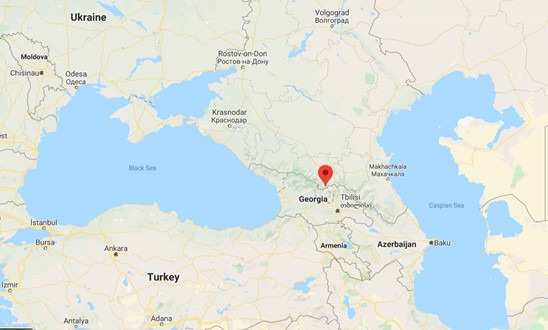
The small republic of Kabardino Balkaria is just 12,500 sq kms in the north Caucasus with a population of just under one million, made up of Kabardanians in the lowlands and Balkarians in the mountainous area. Karachay -Cherkessia has an area of 14,100 sq kms and a population of just around half a million. The Karachay and Cherkess are two separate Muslim peoples.
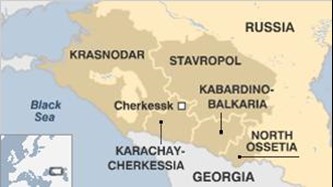
How do I get to Elbrus?
Whether you want to climb Elbrus by the south or north routes, the first step is to get to Mineralnye Vody airport and in almost every case this means flying initially to Moscow and then taking the four hour flight directly south on either Aeroflot or S7 airlines.
From the UK or Ireland or indeed most places in Europe the best timing is to take an overnight flight to Moscow and then a morning flight to Mineralynye Vody, aiming to arriving late morning.
For people on the Elbrus South trip, you then take road transport to the Baksan Valley and the village of Terskol where there are plenty of hotels and restaurants. The journey takes about four hours and arriving early evening leaves plenty of time for settling in, having a meal and an early night.
For people on the Elbrus North or Traverse trips , the minibus takes you to the nearby town of Pyatigorsk about an hour from the airport. We overnight in a hotel and the next morning a more robust minibus will drive the four or five hours to the mountain, half of which is off road.
On the return, it's a good idea to take an early afternoon flight out of Mineralnye Vody. and then the evening flight out of Moscow. This means departing Terskol village or the north side base camp after breakfast at around 8.00am. For the North siders we often leave the campsite the day before, depending on the height of the river which needs to be crossed in the vehicles.
Travel insurance for Mount Elbrus
It's important that everyone gets travel insurance as soon after booking the trip as possible, but many UK insurance companies don't offer policies to this mountain because of the UK Government FCO advisories against travel for all but essential travel. However some specialist companies do offer policies and we recommend Campbell Irvine who we have used for many years.
Getting the Visa for Elbrus
The process is not difficult but it is a bit time consuming, and it begins about six weeks prior to the trip when we ask for your passport information so that we can process an invitation letter for you. The visa is quite specific with dates and places to be visited so if you plan to stay in Moscow or travel longer in Russia then we need to know the dates.
There is more information on our Practical Information page regarding the process itself. Be aware though that some nationalities require original visa invitations to be posted to them rather than soft copies which adds to the cost, and some nationalities require a more stringent process. In the UK now for example, every applicant must go in person to the nearest Russian visa office to submit their biometrics, and the three offices are in London, Edinburgh and Manchester. This means an additional cost to factor this visit in.
Moscow visit
A lot of people choose to visit Moscow and we can assist with your travel and accommodation needs. Please contact us for more information about airport transfers, recommended hotels and hiring our city guide. We can also pre-book tickets to events and to visit the Kremlin.
What is the weather like on Elbrus?
Elbrus is at a latitude of 42 degrees North, similar to that of Rome. However, due to its altitude and its surrounding mountain range, it can produce some extreme weather conditions and very low temperatures. You can see 6-day weather forecasts and temperatures for the mountain at different altitudes on Mountain Forecast .
During the climbing season from June to August expect warm sunny days with little precipitation in the valleys and progressively colder days and nights as you go higher on the mountain, with lows of minus 20 Celsius on the summit with windchill. Prepare for a wide diurnal temperature range which is tiring, and rapid change in weather conditions and especially visibility on the mountain.
Read more about the climate in this part of Russia on our General Information section.
What kit do I need for Elbrus?
Treat the Elbrus expedition as a winter climb, even if you are going in the stable months of July and August. The variation in weather is one of the main objective dangers on this mountain and it's important to be prepared for a wide range of weather and extreme windchill on the summit.
You can buy or rent the cold weather gear and the climbing equipment, but what you buy depends a lot on what other climbing you intend to do in the future. You can discuss with us any time about specific brands or models but the general requirements are below.
Boots - this climb requires plastic mountaineering boots but a high quality hybrid boot will be adequate. Take normal hiking boots for the acclimatisation treks but once on snow you will need to have good quality warm 'double' mountain boots. Also take hut shoes or sandals. Heavy wool socks for the days on snow and trekking socks for lower sections.
Hands - a good pair of waterproof, lined mountain mitts, fleece gloves and liner gloves.
Head and face - warm hat with ear covers if possible, and a sunhat. A buff or balaclava, high quality mountain sunglasses or glacier glasses, and goggles. Body - You need good quality waterproofs, and a good quality down jacket with a hood and preferably long enough to cover the backside. Layering with several fleece layers and normally a single thermal layer is enough for summit day. Please note that the lightweight down jackets are not enough for the cold on Elbrus, they have to mountain quality down jackets which you can rent in the village if needs be.
Legs - trekking trousers and shorts and leggings for the valley walks, lined trousers or soft shell for up high with shell or over trousers against the wind and snow. Take a pair of thermal bottoms for summit day. Rucksack - on the north route and traverse you will be doing carries of kit from base camp to high camp so a 75 litre sack is necessary plus you will need to use the larger rucksack to carry gear up like tents, food and stoves. On the south route a 40 litre day pack for the summit day is all you need, since your main kit will go up to the hut in the cable car. You also need a good duffle bag, especially the north siders, and a travel bag for leaving in the hotel. Sleeping bag - on the north route it's best to opt for a four season bag since there is much more camping, whereas the warmer huts on the south side mean a 3 season bag will probably be enough.
Climbing equipment - for both routes on Elbrus you will need a pair of crampons, a walking axe, harness, slings and karabiners, trekking poles and a climbing helmet. All these can be rented from us.
Miscellaneous - water bottle, thermos flask, wash kit, personal first aid kit, trekking poles, plenty of sun cream and lip salve and moisturising cream, travel clothes and bag for leaving in the hotel, power bank and charging items for phone, tablet etc.
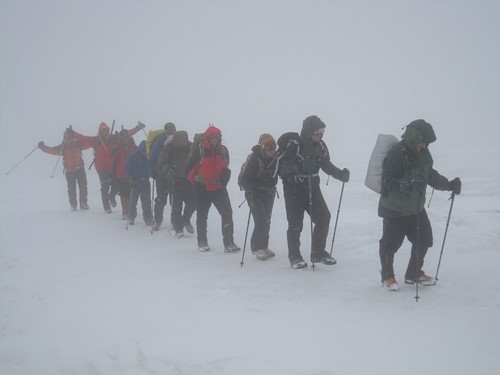
Accommodation on Elbrus
For a full description of all the huts and accommodation on this trip, covering both north and south sides of the mountain, please have a look at the blog piece Huts on Elbrus .
The new National Park huts on the south side are heated and comfortable with bunks and mattresses in small dormitories. There is wi-fi and phone signal. A communal area for eating and relaxing is next to the kitchen. We would recommend a 3 season sleeping bag. We have an expedition cook who will prepare all the food for everyone throughout the trip but do bring some snacks and sweets from home.
On the north side the accommodation is in tents at base camp and in a fairly rudimentary hut at the snowline. Sometimes the team camp at the high Lenz Rocks before summit day, but only if the weather allows it. We would recommend 4 season sleeping bags and you will need a good quality sleeping mat.
Food preferences on Elbrus
The food in the restaurants in the Baksan valley restaurants is lovely and there's quite a range, but there's no doubt that they do not cater very well for vegetarian or vegan diets. There are plenty of soups and salads and breads though, but not many vegetarian recipes. Russians are meat lovers and the local dish of shashlyk - a lamb kebab roasted over an apple wood barbecue - is the national dish.
On the mountain we have a cook who prepares all the meals which again are quite limited in the range of ingredients, because the shops in the valley don't have a great stock. Plenty of soups and stews, potatoes and vegetables with some meat (tinned mostly, but sometimes chicken), sweets and snacks. Breakfast is mostly porridge, eggs and bread with cheese and sometimes muesli.
We won't be able to cater very well for some specific dietary requirements, for example celiacs. Gluten free food is not possible to buy. We would also advise you bring your own summit day snacks and foods, the shops locally don't sell any specialty energy bars or drinks. We will provide things like glucose biscuits and orange juice.
What to expect on an Elbrus summit day
Leaving the hut in the dark on summit morning you are likely to be in mountain boots and crampons, soft-shell or mountain trousers with base-layer tights, probably over-trousers, a base-layer and fleece mid-layers plus a down jacket. You'll also have a balaclava or buff, warm hat, liner gloves and thick windproof insulated gloves.You'll be carrying a pole and a walking axe and most likely have headtorch on.
In your day pack bag carry goggles, sunglasses, flask of hot drink, water bottle, snacks and harness/sling/karabiners/helmet which you will use for tying into the fixed line or into a man rope. For groups on the traverse you will have a bigger pack and include a sleeping bag and travel clothes for going over to the south side.
Leaving the hut at around 4am, most climbers on the south side opt for taking a ratrack to Pastukhov Rocks to start the day, while on the north side the hike begins from the tent at Lenz Rocks. Depending on weather the route could be icy and hard or soft with deep snow.
The day will be long on either route, estimate a twelve hour day and plan in terms of snacks and drinks. It's almost impossible to avoid getting dehydrated on a day like this and inevitably with such a big height gain you will feel the effects of altitude . Try to leave the hut as hydrated and well rested as possible and take plenty of snacks for the day.
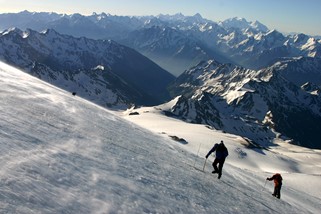
Hygiene on Mount Elbrus
All the huts and the campsite on the north side have outside latrines which are wooden huts with a floor and a long drop. Some latrines are worse than others, and it is not the job of the Rangers to clean them. Company staff can do this job, but under duress, since many of the problems are caused by people who miss the hole and don’t clean up afterwards.
Sometimes a visit to a latrine can be a dispiriting experience. It is important to take a torch with you at night and take a responsibility to keep the huts clean. Going to the toilet behind a rock is strictly forbidden and the authorities have the power to send people off the mountain if they are caught, and fine the company. We will provide toilet paper but by all means bring your own.
Rubbish Disposal
All rubbish is collected by the staff and carried down the mountain. Do not throw rubbish down the long drop (toilet paper is fine) and make a habit of picking up litter that you see on the trail. The responsibility for keeping the mountain clean is on the shoulders of every visitor.
We do not bring bottled water on the mountain; we boil all water which comes from the rivers and glacial streams. The staff will fill your water bottles every evening. Do bring some water purification tablets for yourself if you would like the extra reassurance or something like a steripen.
- Elected Officials
- Auditor/Clerk/Recorder
- Broadband Coalition
- Commissioners
- Court Assistance
- Disaster Services
- District Court
- Driver Licensing
- Fair Grounds
- Historical Society
- Noxious Weed Control
- Parks & Recreation
- Planning & Building
- Prosecuting Attorney
- Social Services
- Solid Waste
- Veteran's Services
- Youth Services
- Commissions

Latah County, Idaho
Planning, building and gis.
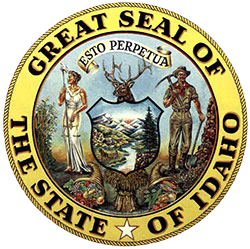
The County Planning and Building Department administers the county's land use and development ordinances and reviews applications for conditional use permits, subdivisions and zone changes for presentation to the Planning Commission, Zoning Commission and the Board of County Commissioners. The department provides assistance with various land use issues and ensures compliance with existing regulations. This department also conducts the Geographic Information Systems (computer mapping) activity for the County. Other functions of this department include the enforcement of adopted building code regulations, and providing assistance with community development projects.
Public Notices
- Current Public Notices and Applications
- Staff Reports for Zoning Commission (typically posted on the Friday before the hearing)
Department Contact Information
Additional information, codes & applications & handouts.
- Agendas and Minutes
- Building Applications
- Building Handouts
- Fee Schedules
- Frequently Asked Questions
- Land Use Applications
- Public Hearing Information - Archived
- ZC PC Current Agenda
Upcoming Events
Meeting notification subscription.
Please enter you email address in the box below, select subscribe or unsubscribe and then select the Send Request button.
Thank you for your submission.

- Best Hikes In The World
- Appalachian Trail
- European Hikes
- Nepal Hikes
- Patagonia Hikes
- See All Hikes
- Mount Kenya
- Mount Kilimanjaro
- Mount Toubkal
- See All Mountains
- South Africa
- New Zealand
- Switzerland
- United Kingdom
- Packing Lists
Mount Elbrus Climb – Complete Guide To Europe’s Highest Summit
Climbs & Mountaineering , Europe , Mountains , Seven Summits
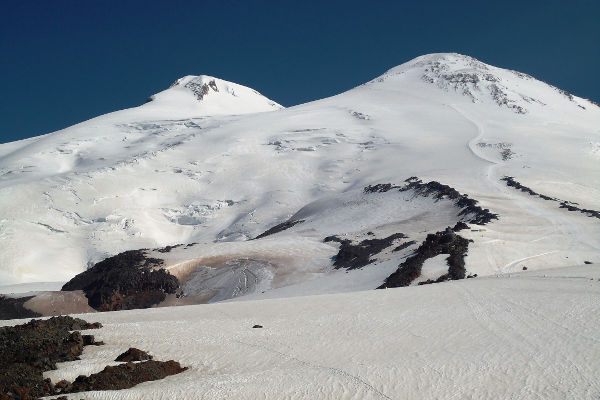
The Mount Elbrus climb is a fantastic mountain challenge and an incredibly rewarding experience. But like any serious mountain climb, Elbrus can be dangerous. This inactive volcano is one of the seven volcanic summits .
Below we have provided a summary of useful information that you will want to read before you go. This guide is particularly useful for Elbrus climbs from the south side (i.e. less technical side of the mountain), but also covers information on the North-side approach.
Mount Elbrus Climb Overview
Mount Elbrus is considered the highest mountain on the European continent . The mountain is part of the Caucasus range and is situated on the southwestern side of Russia.
Elbrus consists of two summits, both of which are dormant volcanoes. At 5,642 metres (18,510 ft), the West Summit is the highest, whilst the East Summit stands at 5,621 meters (18,442 ft).
Elbrus was successfully summited via the East summit in 1829, by Khillar Khachirov. In 1874 an English expedition led by F. Crauford Grove reached the West summit. Since then Elbrus has been climbed by 1000s of mountaineers, including some of the world’s best climbers who bag the mountain as part of their Seven Summits bid.
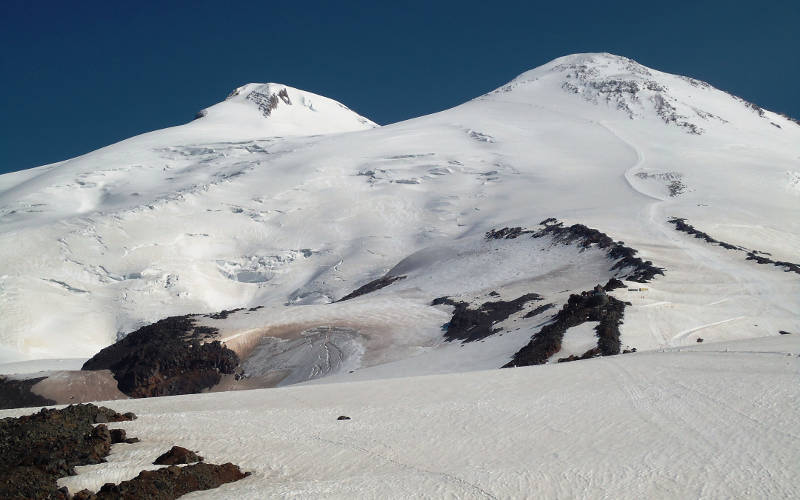
View of Mount Elbrus and it's East (5,621m) and West (5,642m) Summits.
There are two main approaches to Mount Elbrus - the south side approach and the north side approach. The South side is significantly easier than the north side. We estimate su mmit success rates from the south side of Elbrus at about 80-90%.
In contrast, summit success rates on the North side could be as low as 50%. There are also route options from the Eastern and Western flank of the mountain, but these are very rarely used.
Although Mt Elbrus is not a technical climb, it should not be underestimated. The cold weather and altitude can make the climb pretty challenging and dangerous. Both the south side and north side approach involves basic technical skills, like rope travel, crampons , glacier crossings (North side only) and the use of ice axes on some steep snow slopes.
Due to the number of people who climb Elbrus every year, there are unfortunately a number of deaths on the mountain. We estimate the death rate at Mount Elbrus could be as high as 25 people a year . We don't have statistics on the split between North and South side deaths, but most deaths occur due to bad weather and/or altitude sickness issues.
Climbing Mount Elbrus is a 5-6 day expedition from the South side, and a 6-7 day journey from the North side. Here is a brief summary on the popular routes.
Mount Elbrus VS Mont Blanc
Many people think Mont Blanc is the highest mountain in Europe, but Elbrus is in fact the highest mountain on the European continent. It is part of the Caucasus main range that is considered the border between Europe and Asia.
In terms of difficulty, both mountains are graded PD and are about the same difficulty. In the words of mountaineer, Alan Arnette: "Mount Elbrus is kind of like an extra high Rainier or Mont Blanc".
The main difference is the altitude (4,810m vs 5,642m) making acclimatisation more important on Elbrus. Also, Elbrus is much colder than Mont Blanc and requires more organisation.
Popular Elbrus Routes
There are two main approaches to climb Elbrus - the South and North side routes. Elbrus has several other routes, but these only get a few ascents every year.
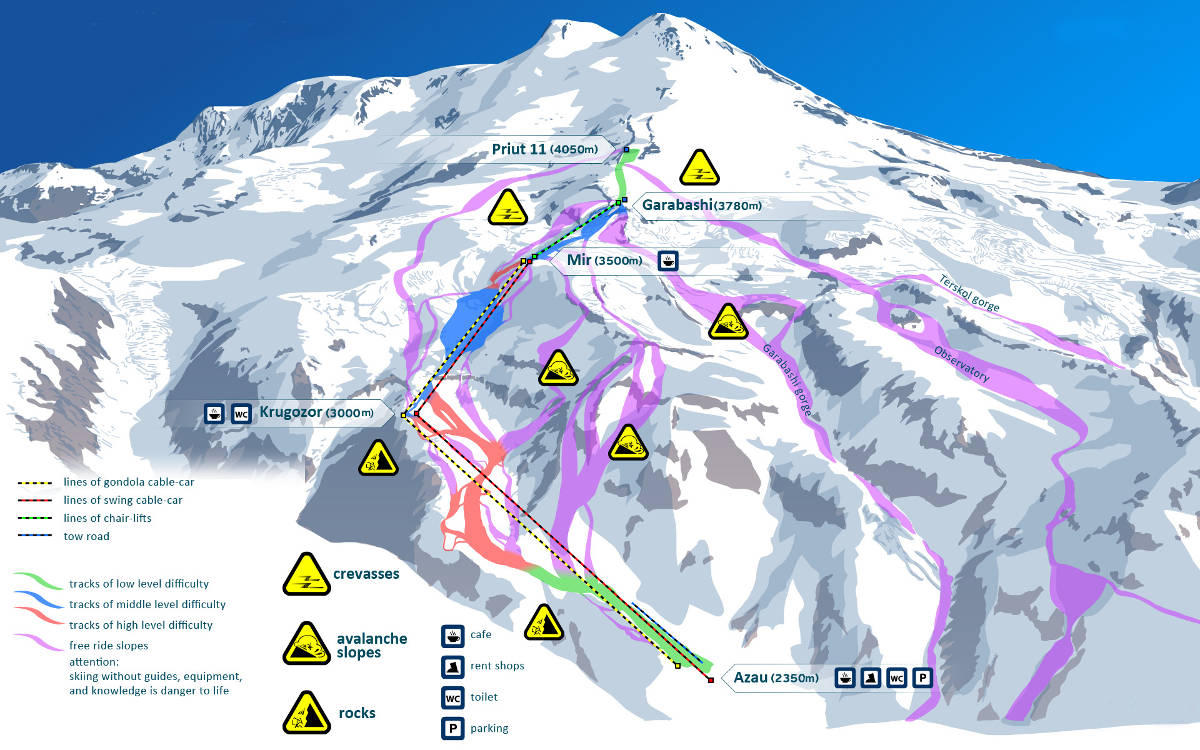
Map of the south side routes to the summit. Image credit: Kavkaz Ski Tur
South Side Via The Cable Car
The most popular route on Mount Elbrus is via the south side. If you have limited high altitude mountaineering experience, then this route is for you!
It is the easiest, safest and fastest way to climb Elbrus.
The south side approach from the Azau village uses a unique cable car system to ferry climbers up to 12,500 feet (3,658 m).
From here, you will see the Barrels (bochki). These are steel containers where you will sleep and cook meals. There are three barrel sections on the south side of Elbrus
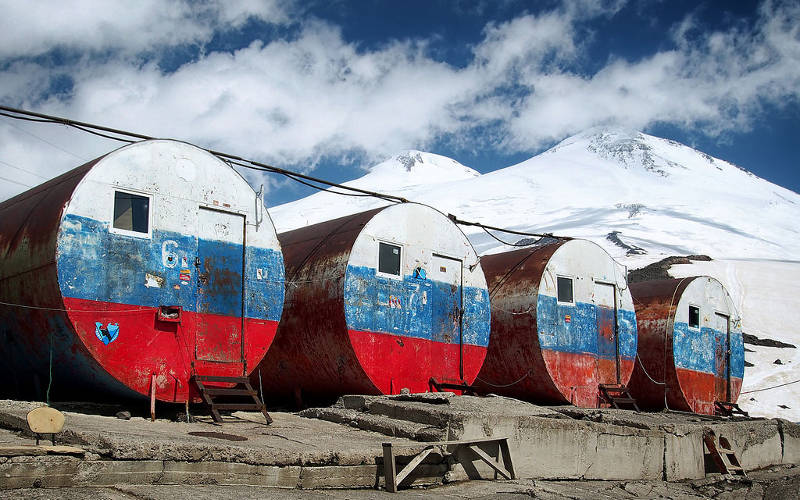
The Elbrus barrels with the twin summit peak of Mount Elbrus in the background. Image credit: Matteo Leoni
Mir Station (3,500m)
This station is used by day visitors and skiers on Elbrus. At the Mir Station there is a coffee shop and a few souvenir shops. This station is busy and is not a great place to stop unless you are feeling the altitude! Generally climbers continue on a chairlift to Garabashi Station (3,800m).
Garabashi Station (3,800m)
At Garabashi you will find several barrel hut containers. The first few are near the chairlift and are generally quite busy. We recommend walking further up to the top barrel huts as these are quieter, and by staying further up you will shorten your summit push. At Garabashi you will find a few coffee shops (one of which stays open 24 hours). You can charge your phone in these coffee shops, as well as buy food and water.
Shelter Maria (4,100m)
At Shelter Maria you will find large containers, each with a kitchen and gas stove. Shelter Maria's electricity supply stays on until 19:00 each night and the toilet is outside. You will find no drinking water here and no coffee shops. You will need to either melt snow for water or collect water from the streams near by (make sure to bring purification tablets to purify your water). Shelter Maria is a great option to stay at if you are well acclimatised as it shortens the summit push.
Most climbers start their summit climb at the second "Barrels" stop - Garabahsi. The summit climb takes about 8-9 hours of ascent and 3-5 hours to descend. Summit bids start early at around 12am, allowing climbers to have just enough time to get back down to the chairlift, which closes at 16:00pm.
Using Snowcats: From Garabashi it is possible to get a Snowcat or Snowmobile to Shelter Maria and onto Pastukhov Rocks (4700m). This shortens the summit push by a good few hours but is of course cheating and will set you back about $90 pp.
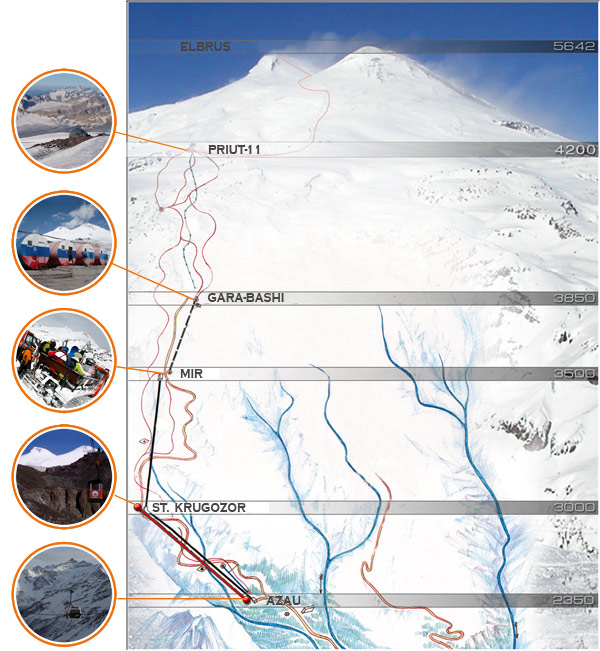
A schematic of the Southern route profile from Azau to Mir, up to Image credit: Kavkaz Ski Tur
North Side Approach to Mt Elbrus
The North side approach to Mount Elbrus is significantly more challenging and, therefore, gets only a few climbers each year.
Unlike the south side, there are no cable cars or chairlifts on the North side. You will therefore need to carry all your gear from base camp, which is situated at about 8,200 feet.
The route includes a glacier crossing where crevasses are a risk. If you decide to do this route option it is important that you and your group have some experience with crevasse rescue and are comfortable using short-rope techniques.
The route is particularly challenging as it includes lots of elevation gain - from ~8,200 feet at base camp to ~18,500 feet, with a 6,000 foot summit push. It also has relatively steeper exposures on snow slopes than the Southern route.
The Northern route is however increasing in popularity due to the high number of climbers on the south side.
Register With The Rescue Centre
Whether you decide to do the south or north route, we recommend registering with the Rescue Centre in Terskol (MCHS) before you set out. They will take your name, surname, passport number, contact phone number and return date. After the climb, you should sign out with them in person or by phone. If you do not sign out they will call you to make sure you made it off the mountain safely. Their contact number is: +7 928 694 51 19 or +7 866 387 14 89.
Before Your Climb
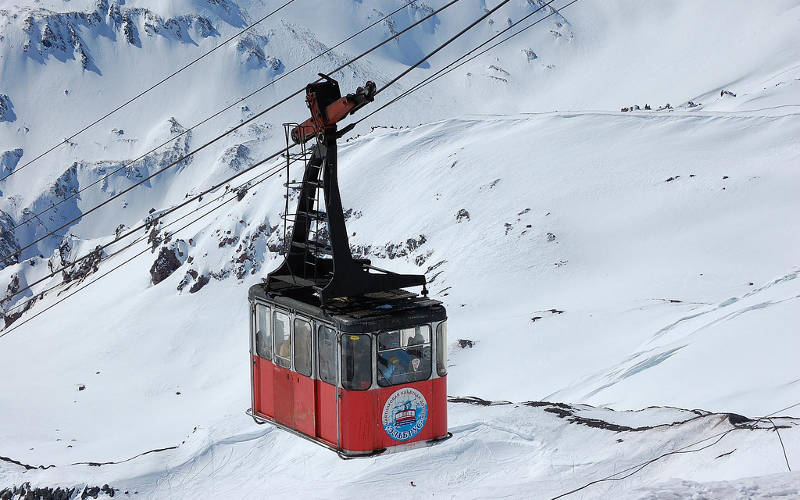
The red cable car that takes climbers from Azau to Mir Station. Image credit: Lev Yakupov
Getting To Mount Elbrus
To get to Mount Elbrus you will need to first fly into Moscow. You will need to get a visa to enter Russia; this can be a lengthy process so please make sure you apply early.
From Moscow you will need to catch an internal flight to Mineralnye Vody Airport or Nalchik Airport. There are also flights from Istanbul to Nalchik. If you are joining an organised tour it is likely that all transport and accommodation before and after the climb will be arranged for you.
If you are planning to climb Elbrus independently or join a group once at the base of the mountain then the information below will be helpful.
There are three towns near Mount Elbrus:
- Terskol : This is the largest town near the mountain, and the best spot to stay in our opinion. The town has a number of accommodation options, including hotels, hostels. homestays and camping facilities (if you are on a tight budget). We recommend the Hotel Elbrusia. You can leave some of your valuables / non-climbing gear at your hotel in safe lock-up for collection when you return from your climb.
- Cheget : This town is furthest from Elbrus but closest to Cheget mountain (3,601m), which most climbers use for an acclimatisation hike before Elbrus.
- Azau : This is the closest town to Elbrus and the location of the cable car that will take you up to Mir Station. Azau is about a 5 min drive from Terskol
From Mineralnye Vody Airport or Nalchik you will need to get a minibus to one of the small towns near Elbrus - Terskol, Cheget or Azau. The journey from Nalchick to Terskol takes about 1.5 hours and costs about $5 in a minibus or $10 in a taxi. The journey from Mineralnye Vody Airport to Terskol takes about 3 hours and costs more.
Please note: It is best to bring Russian rubles in cash with you to Elbrus. There is only one ATM in Terskol and it is often out of cash. Some hotels will exchange US dollars or Euros, but they will not give a favourable rate. When you arrive in Terskol your hotel or hostel will require you to complete registration papers and pay a small registration fee ~$5 - this is a government requirement for all foreigners.
Acclimatisation
Before you climb Mount Elbrus it is imperative that you spend a few days acclimatising. You can do some of this acclimatisation on Mount Elbrus itself, but we recommend undertaking a hike or two before getting the cable car up to Mir Station.
The most popular acclimatisation hikes are on Cheget Mountain and to the Observatory / Terskol Peak (3127m). Both have well marked walking paths and are relatively easy hikes. Just make sure you don't push yourself too hard! These hikes are meant to help you acclimatise to the altitude, so slowly does it!
The views of Elbrus from both peaks is very impressive!
Once on the mountain itself, there are few options for acclimatisation. One of them is a hike to and back from the Pastokov Rocks (4680m) from the barrels - this adds a day to the climb but is well worth it! A conservative approach to climbing Mount Elbrus takes fives days of acclimatisation before attempting a summit bid.
Read our guide to altitude sickness and acclimatisation .
Getting To The Barrels
From Terskol we recommend getting a taxi to Azau where you can get the cable car to Mir Station. There are two cable car options - the old red option (this takes you direct to Mir and is cheaper) or the white option (this is a newer car and more expensive. It also goes via Krugozor station where you have to change cars to get to Mir).
The cars run from 09:00am to 16:00pm (16:30 is the last car down). This is important to remember as missing the last car after descending from the summit will mean staying another night at the barrels.
From Mir you take a one-person chairlift to Garabashi. Please note that you cannot take a pack that is heavier than 10kg on the chairlift! It is possible to walk from Mir to Garabashi (it's about 300m and takes an hour), but most people don't as it can tire one out. It is also possible to walk from Azau to Garabashi, but this will take around 4-6 hours and is pretty tiring!
Pro tip: Make sure that you keep your ticket safe as you will need it to descend. We also recommend leaving Terskol early so you can get on one of the first cable cars up the mountain. This will ensure that you get the best picks of accommodation further up the mountain.
Best Time To Climb Elbrus
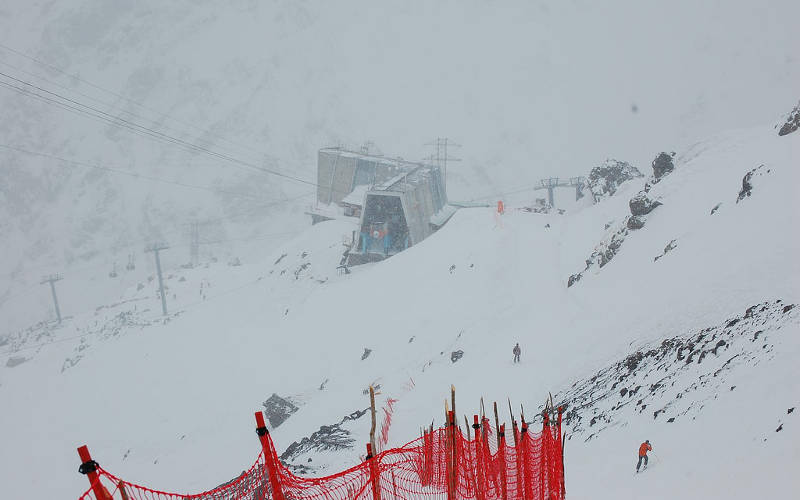
A particularly bad day of weather at Krugozor Station (2,900m). Image credit: Lev Yakupov
The main climbing season is from June through early September , with July being the busiest month.
The permanent snow line is around 3350m with temperatures rarely rising above freezing at night.
The best time to ski Mount Elbrus is in June, when there is more snow. This however makes climbing more challenging!
Afternoon clouds and thunderstorms are common during summer season.
Due to its hight, Mount Elbrus has dynamic weather, making it hard to predict weather conditions. Prepare for very cold temperatures and high winds above 4,000 meters.
How Difficult Is The Elbrus Climb?
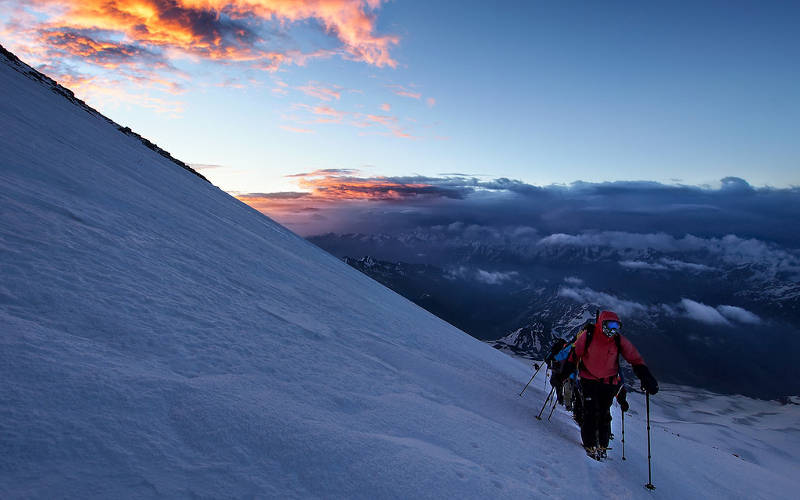
High on Mount Elbrus. Image credit: Matteo Leoni
From the south side, the ascent of Mount Elbrus is not technically difficult. Climbers only need basic experience in using crampons and ice axes to be well-prepared.
However, in serious weather the climb can be quite hazardous.
Also, despite being technically easy, the lack of high mountain camps on Elbrus (all of them are quite close to each other) causes the elevation gain to be one of the most demanding of the seven summits. Climbers need to ascent as much as 1,900 meters of altitude for the summit push.
The most technically challenging part of the climb is just above the Pastukhov rocks and the saddle between the two summits. The slopes in both these spots are relatively steep and clipping into a fixed rope is highly recommend.
The north side is more challenging as the elevation gain is greater (base camp on the north side sits at around 8,200 meters) and snow slopes are steeper, which means rope work and experience with crampons and ice axes are required.
There are no cable cars, chairlifts or Snowcats on the North side. So one needs to carry all their gear up the mountain.
Besides the technical challenge of climbing Elbrus, the logistics of the climb, if you are not using a tour operator, can be challenging. The visa process via Russian authorities can be lengthy. Also the ethnic conflicts in the area can cause problems.
Training To Climb Mount Elbrus
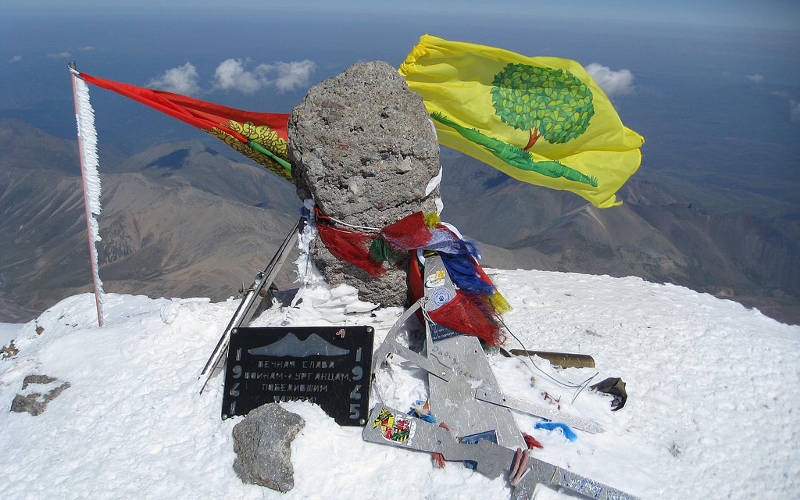
The West summit of Mount Elbrus (5,642m). Image credit: Jason Blue-Smith
To successfully climb mount Elbrus a good level of aerobic fitness and leg strength is required.
Climbing Elbrus takes roughly a week, including acclimatisation hikes. Summit day is a lengthy one with over 1,900 meters of altitude to be gained, taking about 12-14 hours (descent included).
The climb is also cold, meaning you will lose energy quickly. It is advised to set yourself a training schedule that includes aerobic exercise and long hikes.
Even someone in very good physical shape can fail to summit Mount Elbrus.
You should not be overconfident in your own abilities, because there is the factor of dealing with the altitude that will determine whether you summit or not.
Climbers who are overconfident tend to rush up the mountain and as a result they fail in their attempt to summit.
Here are a few things to implement in your training schedule.
Develop your endurance and stamina
The first thing to do is to make sure you have built enough endurance and stamina before traveling to Russia. Undertaking practice climbs and hikes are the best options, but if you don’t have hills or mountains to climb in your home country, running is a decent alternative. Build a routine, but don’t push yourself over the limit as you will want to avoid injuries.
Get comfortable carrying weight
The ideal way to train is carrying a pack and going uphill and downhill, since this simulates what you will be doing on Mount Elbrus. Start with a light pack and gradually increase the weight as you get closer to the climb. Never run with a pack on and use hiking boots if you can.
Prepare yourself mentally
At some point in your Mount Elbrus climb you will likely find yourself in a difficult situation that is way out of your comfort zone. Cold weather, strong winds and a long summit day will not only be a physical challenge. Make sure that you prepare yourself mentally as well.
What you eat during your training weeks and climb should not be underestimated. A diet rich of carbs is as important as your training. It might even be a good idea to consult a professional nutritionist.
Strength training
Training with weights is an important part of your training routine as this improves anaerobic metabolism and feeds much of muscular work you will do on Elbrus. Developing your back and shoulder muscles are necessary to comfortably carry your backpack during the climb, while calve muscles and hamstrings are needed to climb uphill and descend the snowy slopes.
Consume lots of water during your training sessions. Not only does your body need fluids, but it is the best way to get used to hydrating a lot. When you climb in cold conditions, you might not feel thirsty, but it is vital to drink lots of water. Drinking a lot of water helps in getting acclimatised to the high altitude and avoiding dehydration.
Specific skills
Mount Elbrus may well be a basic alpine climb, but it still requires some specific skills including using an ice axe and crampons. Since the slopes are quite steep on Mount Elbrus, being familiar with the ice axe arrest technique is recommended. You can learn these skills on smaller snow-covered peaks in your region or during a winter mountaineering course where you develop / fine tune your skills.
Mount Elbrus Gear List
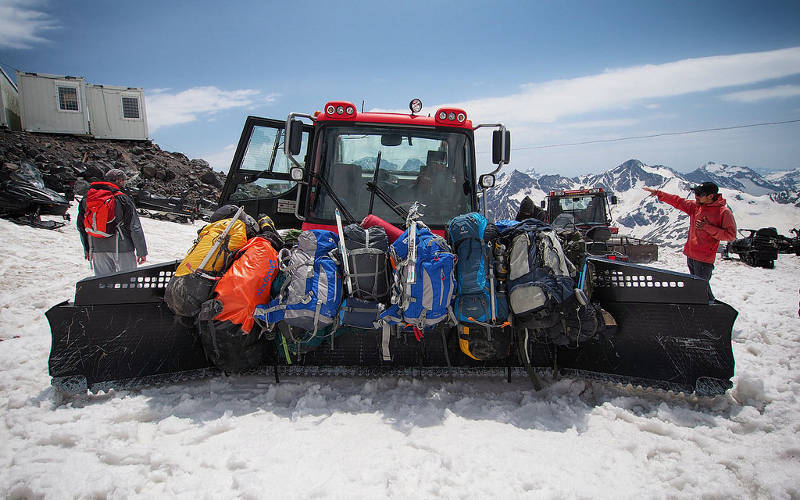
A Elbrus Snowcat with a number of climber's rucksacks on the front plough. Image credit: Matteo Leoni
An expedition like Elbrus requires some specific gear.
To make sure you don’t forget to bring anything, this is a recommended list of gear to pack, based on our own experience.
Travel Gear
- Passport with valid visa: Entering Russia requires an international passport and visa. Be sure to start your application early as this might well be a time-consuming process.
- 90-120L Duffel Bag : This will be used to carry all your gear to the "barrels". You definitely want the duffel to be waterproof, have back straps and have a capacity of at least 90L. We recommend the Patagonia Duffel (with back-straps) or the Yeti Panga 100 Dry Duffel (this bad boy is the ultimate duffel / dry bag!)
- Daypack: Lightweight 25-30L daypack that will be used as your carry-on luggage for flights, and as your pack for acclimatisation hikes and the summit push on Elbrus. We recommend the Osprey Talon 33L (Unisex).
Climbing Gear
Despite being a relatively straightforward alpine climb, Elbrus requires some mountaineering gear.
- Alpine Ice Axe: Go for a straight shaft ice axe. Choose the right size according to your height; under 5'2'' use a 50 cm axe, 5'3'' to 5'5'' use a 55 cm axe, 5'6'' to 5'9'' use a 60 cm axe, 5'10'' to 6'0'' use a 65 cm axe, above 6'0'' use a 70 cm axe. We recommend Petzl Glacier Ice Axe .
- 12 Point Crampons : Make sure you go for adjustable 12-point crampons. 10-point crampons offer less traction. Avoid single-piece rigid crampons or aluminium frames. We recommend the Black Diamond Sabertooth Crampons .
- 2 Locking Carabiners: Auto-locking carabiners are best. Petzl AM'D Triact Carabiners are good.
- 2 Non-Locking Carabiners: Wiregate carabiners are stronger and better than round-gate carabiners. Go for the Black Diamond Neutrino Wiregate Carabiners .
- Climbing Harness and Accessory Cor d: Make sure you go for a newer model of harness, one that has gear loops, adjustable leg loops and a waist belt. Also make sure you bring an 5 foot (6mm) accessory cord . Our recommended harness is the Black Diamond Couloir Harness .
Clothing & Accessories
Elbrus is a cold weather climb, despite being summer season. Freezing temperatures on the mountain are normal. During your summit attempt you will start off in the middle of the night well before sunrise; temperatures as low as -30 degree Celsius are common . Wearing sufficient layers and high quality clothing is important for your own comfort.
- Double climbing boots - plastic-shelled models are fine, but modern non-plastic boots are better. We recommend the LA Sportiva Spantik or the Scarpa Phantom 6000 .
- Mid-weight hiking boots . We recommend the Salamon Quest ( Men's ) or ( Women's ).
- 3 pairs of climbing socks. Smartwool or Bridgedale socks are good.
- Full-sized gaiters . See Outdoor Research Crocodiles .
Lower Body Layers
- 2-3 pairs synthetic underwear.
- Bottom synthetic base under layer. We recommend Smartwool Base Layers .
- Lightweight synthetic hiking trousers. We recommend The North Face L4 Soft Pants .
- Hard shell trousers. These need to be able to fit over your base layer and soft shell pants. Full-length side-zippers are best so you can take on or offer without removing your boots.
Upper Body Layers
- Top synthetic base under layer. We recommend Smartwool Base Layers .
- Lightweight climbing shirt
- Medium weight climbing parka / fleece with hood. We recommend Rab Baseline Jacket .
- Soft shell jacket. Wind and water resistant. Should be able to fit over your fleece. The Arc'Teryx Gamma Jacket is brilliant.
- Hard shell jacket. Must be able to fit over your fleece, an soft shell jacket. The Arc'Teryx Alpha SL is our recommend option.
- Soft shell down winter jacket. The North Face L3 Down Hoodie is excellent.
Headgear and Handwear
- Warm ski hat / beanie
- Buff / Balaclava
- Ski goggles. We recommend Zeal Optics Goggles .
- Sunglasses - We recommend the Julbo Glacier Explorer Sunglasses .
- Head lamp with extra batteries. Go for the Black Diamond Storm Headlamp .
- Inner gloves - Go for Outdoor Research Base Gloves .
- Insulated climbing gloves. Go for Rab Baltoro Gloves .
- Insulated and waterproof mittens. Go for Outdoor Research Highcamp Mitts .
Other Essentials
- 4-season sleeping bag rated to 0F (-18C). We recommend Mountain Hardwear Lamina or Mountain Hardwear Phantom sleeping bags.
- Inflatable sleeping pad. The Therm-a-rest sleeping pads are great.
- Ski / trek poles. These are highly recommend on Elbrus. Our preferred poles are adjustable and lightweight, like the Black Diamond Trail Trekking Poles .
- 2 wide mouth 1 litre water bottles. Avoid hydration bladders or metal bottles as these freeze. Go for a co-polyester (BPA plastic free) bottle like the Nalgene Titan .
- Insulated bottle covers. Go for the Outdoor Research Water Bottle Parka .
Accessories
- Personal Medications - standard painkillers, personal prescriptions. diamond for altitude and meds for nausea and vomiting. Also bring a small personal first aid kit .
- Water purification tablets
- Lip scream and sunscreen
- Toiletries and toilet paper
- Hand sanitiser
- Pee funnel (women) / bottle (men)
- Snacks and drinks, for example energy gels and instant coffee packs and energy bars.
- Toe-warmers
- Altimeter watch. The Suunto Ambit 3 Peak watch is amazing!
- Camera and Book
Typical Itinerary For The Elbrus Climb
The itinerary below is for the most popular south side route:
Depending on where you live, you might be heading for a long flight towards Moscow.
Most climbers spend a day in Moscow before traveling further to the Elbrus region. With highlights like the Red Square and the Kremlin, it is one of world’s most impressive metropoles.
From Moscow, you can fly to Mineralnye Vody or Nalchik Airport, the closest airports to the Caucasus and Elbrus Region. Drive to Terskol from Mineralnye Vody Airport is about 3 hours. It's about an 1.5 hour drive from Nalchik airport.
After having settled in Terskol, the next thing you will probably do is an acclimatisation hike. Terskol Peak (3900m) and Mount Cheget (3404m) are popular options. Both offer great views of Mount Elbrus. If you have an extra day for acclimatisation, a 4 hour walk from the Terskol Valley to the Observatory provides a great first acclimatisation hike.
The next day you move from the Terskol Valley to Barrels (3800m). The easiest approach is to take the cable car system from Azau to Mir Station. From there you can either walk for 1 hour, or take a 1 person chairlift to Garabashi - "The Barrels". It is about a 50 meter walk from the top of the chairlift.
After having settled, it is best to do an acclimatisation hike up to 4,100 meter in the afternoon. ‘Climb high, sleep low’, accelerates adjusting to the altitude.
To complete your acclimatisation process, a hike to Pastukhova Rocks (4700m) is recommended. It takes about 3 hours from the Barrels.
A short night of sleep since you will start your summit bid at 2am or 3am. You will be climbing about 1,900 meters of altitude making for a long summit day (12 hours up and down). Most climbing operators make use of snowcats to start their bid at Pastukhova Rocks (4800m) making their summit day significantly shorter, but true mountaineers don’t use the aid of snowcats.
In case you had bad weather the day before, the summit bid is today. This means that you will not only be summiting today, but will also descend to Terskol Valley. Starting early is recommended to catch the last cable car to the valley (otherwise there is very long descent waiting for you).
After having had a good nights sleep in your hotel in Terskol, you will drive back to Nalchik Mineralnye Vody airport to catch your flight home.
Costs And Permits
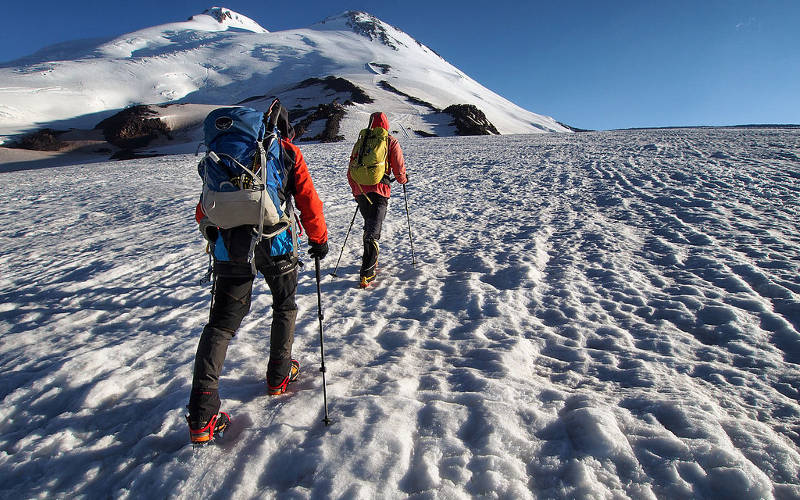
Epic picture of climbers pushing up past the Pastukhova Rocks. Image credit: Matteo Leoni
The cost to climb Mount Elbrus ranges depending on how you tackle the mountain. Here are three rough estimates:
Budget Independent Climb
It is possible to climb Mount Elbrus independently. The cost (excl. international and domestic flights) could be as low as $500 pp, but this would be super budget. You will need to budget for your transfers to and from Nalchik, accommodation in Terskol pre and post the climb, cable car journeys, food and water on the mountain and accommodation stays on the mountain.
Climbing with a Local Guide
Their are a number of good Russian guiding organisations who charge about $1000 pp for an Elbrus climb. This often covers accomodation pre and post your climb, all logistics and expenses on the mountain, and a professional guide. Quality can however vary.
Climbing with a Western Operator
There are a number of Western operators who offer Mount Elbrus. Prices range from $2000 to $5000 pp. The service quality tends to be excellent, with professional guides on the expedition. The cost generally includes everything from Moscow and back.
Like on most mountains, you need a permit to climb Elbrus. But unlike the high cost of a climbing permit on Aconcagua (~$1000) or Kilimanjaro (~$1000), Elbrus only costs $25.
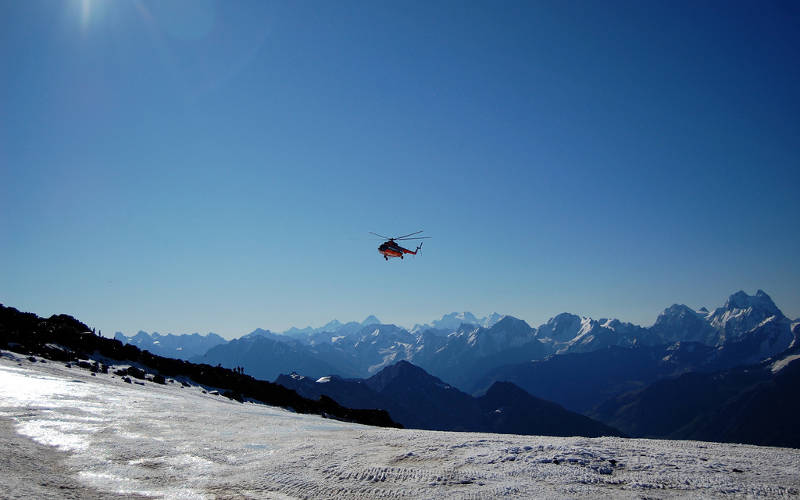
Helicopter rescue on Mount Elbrus. Image credit: Ilya Bogin
Travel insurance is important when climbing a mountain like Elbrus. If you climb with an guided organisation, you will likely need adequate climbing insurance before joining their tour.
Most general travel insurance providers will not cover Mount Elbrus as the activities of the climb involve high altitude and mountaineering with fixed ropes. You will need to source specialist insurance that covers you for high altitude mountaineering.
We recommend contacting the BMC in the UK or the American Alpine Club in the US .
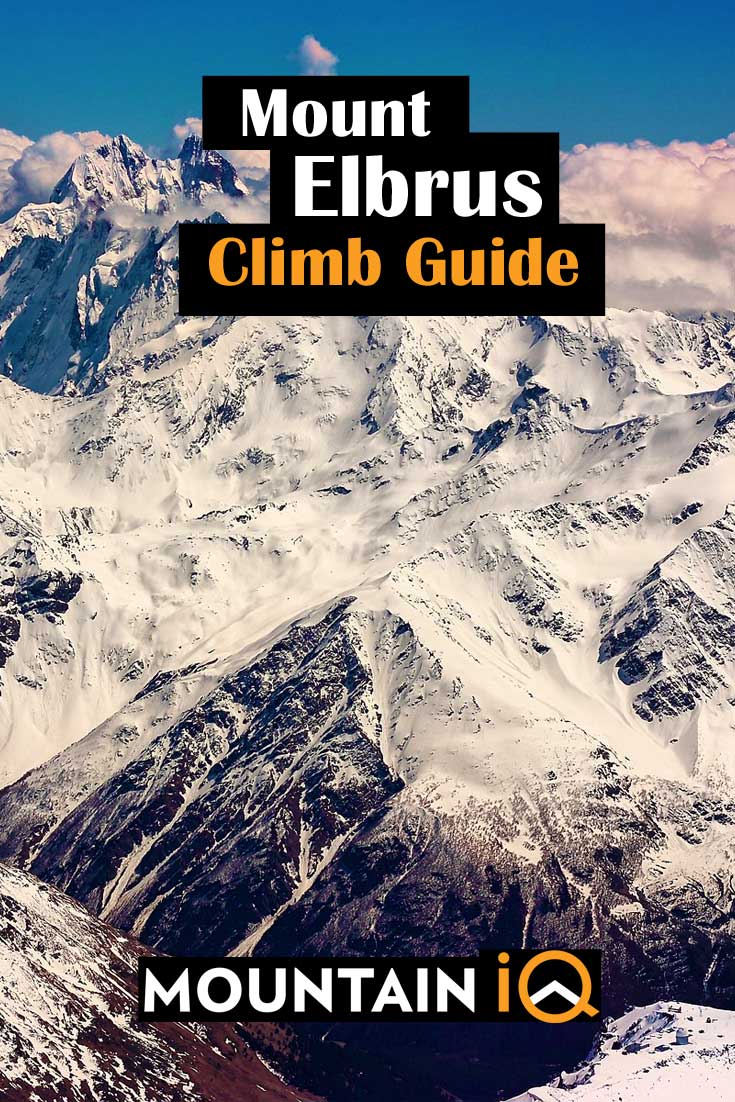
About the author
Mark Whitman
Mark has trekked extensively in Asia, Europe, South America and Africa. He founded Mountain IQ in 2014 with the sole aim to be the best online information portal to some of the most popular mountain destinations around the world. When not writing for Mountain IQ, Mark is out exploring the outdoors with his wife!
Leave a Reply
Your email address will not be published. Required fields are marked
i am flying out to Terskol on 9th october,HOW CAN I GET A MOUNT ELBRUS CLIMBING PERMIT QUICK ?
Hi Michael, Elbrus climbing permits currently cost €25 and can be bought in Elbrus town or from the rangers at the ski lifts.
Hello, Thank you very much for this detailed report. We are happy to hear that we can climb mount Elbrus independently. We are now looking forward to do the climb this year. Best regards, Doreen and Jean-Christophe
Hi, I’m planning an alpine attempt of Elbrus, starting the trek from Azau (no cheating), both summits in 3 days, tentative 7~9 July 2019; looking for like-minded mountaineers
I have an interview for a school project and I want to ask some questions.
1. What measures can you take if someone has a medical emergency during a climb?
2. What type of clothing do you recommend for protection from the cold or to deal with the climate?
3. What happened on your most dangerous Elbrus expedition?
Hello Mr. Whitman, I think my earlier comment wasn't posted. My name is Juliana J, and I'm doing a research paper on climbing Mount Elbrus. I'd like to ask you (as an expert) what measures can be taken if someone has a medical emergency during a climb? Also, what type of clothing do you recomend for protection from the cold to deal with the harsh climate, and what happened on your most dangerous Elbrus expedition? Thanks for your time in answering these questions for me.
Hello Mr. Whitman, I think my earlier comment wasn't posted. My name is Juliana J, and I'm doing a research paper on climbing Mount Elbrus. I'd like to ask you (as an expert) what measures can be taken if someone has a medical emergency during a climb? Also, what type of clothing do you recomend for protection from the cold to deal with the harsh climate, and what happened on your most dangerous Elbrus expedition? Thanks for your time in answering these questions for me.
Hi Juliana, I’m not too sure of the answers. I recommend contacting Vitaly at Russian Mountain Holidays (if you Google them, you will find their site). He is an experience Elbrus guide and should be able to help.
We work with local guides to offer great value adventures at unbeatable prices

IMAGES
VIDEO
COMMENTS
On average, the total cost of 8-day Langtang Valley Trek can be around US$ 300-400. You'll require TIMS Card and Langtang National Park Entry Permits to trek to Langtang Valley. For individual trekkers, the cost of the TIMS Card is US$ 18 while for group trekkers, it is US$ 9 her head.
Cost & Date. Reviews. Langtang Valley trek is the most delightful Trekking in Nepal with rich culture, traditions, and riches. It is the perfect trek for those who want to trek this off-the-beaten-track. The trek offers excellent adjustment and a diverse range of landscapes during the trek. This zone is renowned for its beautiful forest with ...
It was a wonderful Langtang valley trek-short-easy and best view holiday, people and lodges were rebuilding well after the 2015 earthquake, still, they need more tourists for local life, the landscape was spectacular, rich flora- fauna, I found similar culture traditional like Tibet, I had best trek guide and porter bus journey was long but had ...
Discovering the Langtang Valley: A Guide to Trek Permit Costs The Langtang Valley Trek, a journey into the heart of the Himalayas, offe
Langtang Valley Trek Permit. A TIMS card (US$10) and a Langtang National Park pass (US$34) are required. At Rolwaling Trek, our team will plan for these beforehand. You must obtain your TIMS permission in Kathmandu and your Langtang National Park permit in Dunche if you are organizing the trek on your own.
Langtang Valley Trek Permits. Introduction Obtaining the necessary permits for the Langtang Valley Trek is a crucial step in your preparation. Permits ensure the safety and management of trekkers and contribute to the conservation of the region. This article provides a comprehensive guide to the permits required for the Langtang Valley Trek and ...
Syabrubesi is the trailhead for the Langtang Valley trek, a small town approximately 115 km north of Kathmandu. You can get there by public bus or private jeep and the journey takes around 5.5 - 9 hours depending on your mode of transport. The road is narrow and twisting at points with occasional steep drop-offs, and includes some bumpy ...
Langtang Valley Trek Cost for Nepali. If you want to know the price for the Langtang Valley trek then the cost of the trek ranges from Rs. 15,000 - 20,000. But the cost may vary depending upon the group size, food, and accommodation you take during the trek. Be sure to carry extra money, it will be helpful in case of emergencies and other stuff.
The famed British mountaineer and travel writer, Bill Tilman (1898-1977), called this "one of the world's most beautiful valleys.". The local people in the Langtang Valley are mostly of Tibetan origin and, according to legend, the valley was first discovered by a lama - a teacher of Tibetan Buddhism - who was pursuing a runaway yak.
Route: Langtang village (3430m) to Kyanjin Gompa (3870m) to Kyanjin Ri (4773) Trekking time: 6 hours, and then to reach Kyanjin Ri from Kyanjin Gompa 2 hours up, 1-1.5 hours down. Distance: 5.7km / 3.5 miles, and then around 4km / 2.5 miles from the Kyanjin Gompa village to Kyanjin Ri.
Documents and Other Paperwork Required For Trekking. Langtang Valley Trek offers amazing adventure and thrills, but you need certain permits and documents to trek. TIMS Card. The Trekking Agencies Association of Nepal (TAAN) and the Nepal Tourism Board (NTB) keep a database called Trekkers' Information Management Systems (TIMS) card.
Last Updated on Aug 11, 2023; Permits Required for Langtang Trekking. Langtang region has many famous trekking routes like Langtang Valley Trek, Gosaikunda Lake Trek, Tamang heritage trail, Langtang Circuit Trek, etc.And all of them require two trekking permits- a Langtang National Park entry permit and TIMS (Trekkers' Information Management System) card.
Shivapuri-Nagarjun National Park Entry Permit. The classic Langtang Valley trek commences in Syabrubesi, 122 km from Kathmandu. Trekking from Syabrubesi doesn't require this permit. However, some trekkers take an alternative path via the Gosaikunda-Helambu route. If you are discussing this route, you also need a Shivapuri National Park entry ...
You need a permit to enter and trek inside the Langtang National Park during the Langtang Valley Trek in Nepal. This permit will cost you around 30 USD per person and will last for the duration of the trek. Similarly, a Trekkers Information Management System (TIMS) card is also required for trekking in the Nepalese Himalayas. ...
Here are some Langtang Valley Trip Highlights: - Spectating the mountains above 7000m like Langtang lirung (7,200m/23,622ft), Ganesh Himal (7,600m/24,934ft), Langtang II (7,227m/23,710ft). ...
Hiking the Langtang trek will cost you around US$25 per person per day including permits, transportation, accommodation, and food. Permits. As I already mentioned above for the Langtang trek you'll need the TIMS card and the Park entrance permit. The TIMS card - NPR 2000/US$15; The park entrance permit - NPR 3000/US$23.
For any of the trekking routes in the Langtang region, you trek via Langtang National Park. And to trek in this region , you need to get a special permit- the Langtang National Park Permit. It costs $30 excluding 13% VAT (Value Added Tax). Whereas, any citizen of the SAARC countries can get the permit for $15 excluding VAT.
Permits required for Langtang Valley Trek. To preserve the natural environment and cultural heritage, the Langtang Valley Trek in Nepal requires several permissions. Ensuring you comply with local legislation is also a formality. The primary permits that you'll need are as follows:
Thursday June 4, 2020. 0. Regarding trekking in Nepal, trekking permits are the most crucial document you require. Langtang trek is no exception. You will need two Langtang trek permits to trek in the Langtang region. The two required permits for the Langtang trek are the TIMS card and the Langtang National Park Entry permit.
Langtang Valley (Nepali: ... entering the Langtang Valley requires everyone except locals to have the TIMS permit and the Langtang National Park entry permit. Tourism. The Langtang Valley trek, from Syaphrubesi to Kyanjin Gompa and back, is known to be the third most popular trek in Nepal, after the Annapurna Circuit and Everest Base Camp ...
Purchase Online. IDPR Online Shop: All Products. Direct link to purchase Recreation Permits online. Stickers will be mailed to you, and your email receipt is your temporary permit. If you have previously purchased online, find your account here. If you need help, please call 1-888-922-6743.
This moderate-level trek travels you through the beautiful Langtang Valley. It rounds up in 11 days while offering you a thrilling experience through stunning landscapes of Langtang and Ganesh Himal.
Also take hut shoes or sandals. Heavy wool socks for the days on snow and trekking socks for lower sections. Hands - a good pair of waterproof, lined mountain mitts, fleece gloves and liner gloves. Head and face - warm hat with ear covers if possible, and a sunhat. A buff or balaclava, high quality mountain sunglasses or glacier glasses, and ...
Planning, Building and GIS. The County Planning and Building Department administers the county's land use and development ordinances and reviews applications for conditional use permits, subdivisions and zone changes for presentation to the Planning Commission, Zoning Commission and the Board of County Commissioners. The department provides ...
Mount Elbrus Climb Overview. Mount Elbrus is considered the highest mountain on the European continent. The mountain is part of the Caucasus range and is situated on the southwestern side of Russia. Elbrus consists of two summits, both of which are dormant volcanoes. At 5,642 metres (18,510 ft), the West Summit is the highest, whilst the East ...